Session 2008/2009
First Report
Committee for Employment and Learning
Report on the Review
of Teacher Education
TOGETHER WITH THE MINUTES OF PROCEEDINGS OF THE COMMITTEE
RELATING TO THE REPORT, WRITTEN SUBMISIONS,
MEMORANDA AND THE MINUTES OF EVIDENCE
Ordered by The Committee for Employment and Learning to be printed 21 January 2009
Report: 28/08/09R Committee for Employment and Learning
PUBLISHED BY AUTHORITY OF THE NORTHERN IRELAND ASSEMBLY
BELFAST: THE STATIONERY OFFICE
£38.00
This document is available in a range of alternative formats.
For more information please contact the
Northern Ireland Assembly, Printed Paper Office,
Parliament Buildings, Stormont, Belfast, BT4 3XX
Tel: 028 9052 1078
Membership and Powers
The Committee for Employment and Learning is a Statutory Departmental Committee of the Northern Ireland Assembly established in accordance with paragraphs 8 and 9 of Strand One of the Belfast Agreement and under Standing Order 46 of the Northern Ireland Assembly. The Committee has a scrutiny, policy development and consultation role with respect to the Department for Employment and Learning and has a role in the initiation of legislation.
The Committee has power to:
- consider and advise on Departmental budgets and annual plans in the context of the overall budget allocation;
- approve relevant secondary legislation and take the Committee stage of relevant primary legislation;
- call for persons and papers;
- initiate inquiries and make reports; and
- consider and advise on matters brought to the Committee by the Minister for Employment and Learning.
The Committee is appointed at the start of every Assembly, and has power to send for persons and papers and records that are relevant to its inquiries.
The Committee has 11 members, including a Chairperson and Deputy Chairperson, and a quorum of 5. The membership of the Committee since 9 May 2007 has been as follows:
Ms Sue Ramsey (Chairperson)
Mr Robin Newton *(Deputy Chairperson)
Mr Alex Attwood Mr Paul Butler
Rev Dr Robert Coulter ** Mr Alex Easton ***
Mr David Hilditch *** Mr William Irwin ***
Ms Anna Lo Mr David McClarty
Mrs Claire McGill
* Mr Alastair Ross replaced Mr Jim Wells on 29 May 2007
* Mr Robin Newton replaced Mr Jimmy Spratt as Deputy Chairperson on 10th June 2008
** Rev Dr Robert Coulter replaced Mr Basil McCrea on 15 September 2008
*** Mr Alex Easton, Mr David Hilditch and Mr William Irwin replaced Mr Nelson McCausland, Mr Alastair Ross and Mr Jimmy Spratt on 15 September 2008
Table of Contents
List of abbreviations used in the report
Report
Key Conclusions and Recommendations
Appendix 1:
Minutes of Proceedings relating to the report
Appendix 2:
Appendix 3:
Written Evidence Submitted by Witnesses
Appendix 4:
Appendix 5:
Appendix 6:
Appendix 7:
Press ReleasesList of Abbreviations used in the Report
BSL |
British Sign Language |
CACDP |
Council for the Advancement of Communication with Deaf People |
CASS |
Curriculum and Advisory Support Services |
CPD |
Continuing Professional Development |
CSR |
Comprehensive Spending Review |
DE |
Department of Education |
DEL |
Department for Employment and Learning |
DETI |
Department of Enterprise, Trade and Investment |
EPD |
Early Professional Development |
ESA |
Education and Skills Authority |
HEFCE |
Higher Education Funding Council for England |
ITE |
Initial Teacher Education |
ISL |
International Sign Language |
MaSN |
Maximum Student Number |
NIAO |
Northern Ireland Audit Office |
NISTR |
Northern Ireland Substitute Teacher Register |
NQT |
Newly Qualified Teachers |
NUS-USI |
The National Union of Students / Union of Students in Ireland |
PIG |
Project Implementation Group |
PGCE |
Postgraduate Certificate in Education |
RDS |
Rewarding and developing staff |
RPA |
Review of Public Administration |
RTU |
Regional Training Unit |
TDA |
Training and Development Agency |
TDM |
Teacher Demand Model |
TRC |
Transferors Representatives’ Council |
TUPE |
The Transfer of Undertakings (Protection of Employment) Regulations |
UU |
University of Ulster |
‘The Minister’ |
Minister for Employment and Learning |
‘The Committee’ |
Committee for Employment and Learning |
‘The Colleges’ |
Stranmillis and St Mary’s University Colleges |
‘Queen’s’ |
The Queen’s University of Belfast |
Executive Summary
On 12th March 2008, the Minister for Employment and Learning (‘the Minister’) briefed the Committee for Employment and Learning (‘the Committee’) on potential changes to funding for teacher education currently delivered by Stranmillis and St. Mary’s University Colleges (‘the colleges’). The Minister advised the Committee that it was his intention to bring forward a revision to the funding model currently applied to the colleges. At this meeting the Minister indicated his wish for Committee involvement in this issue.
The Committee took evidence from the colleges on 16th April 2008 on their particular issues and concerns about the new funding formula. Following on from the briefings, it emerged that Stranmillis was at an advanced stage of negotiation with The Queen’s University of Belfast (‘Queen’s’) with respect to a potential merger. The Committee undertook to conduct a ‘stakeholder review’ to allow a full range of opinions on the issues surrounding changes in teacher education to be fully articulated. The objective of the review was therefore:
“To collate and consider the opinions and views of those involved in, and affected by, proposed changes to teacher education and to produce a report of recommendations to the Minister for Employment and Learning”.
A methodology based on evidence gathering (oral and written) was used as the basis for the Committee’s review programme.
In April 2003, the Department of Education (DE) and the Department for Employment and Learning (DEL) jointly commissioned a review of teacher education. This review is intended to encompass a number of issues that will impact on the future of teacher education, some of which are:
- The mapping of the teaching profession: from Initial Teacher Education (ITE), through induction, Early Professional Development (EPD), and on to Continuing Professional Development (CPD) throughout the teacher’s career;
- The Review of Public Administration (RPA);
- The outworkings of the Bain Review;
- The roles that the two departments (DE and DEL) will have in ITE; and
- The changing demography of the pupil population and the subsequent impact on teacher numbers.
While the Northern Ireland Substitute Teacher Register (NISTR) and the funding mechanism are mentioned in the departments’ review, they are not dealt with in particular detail.
The Committee is conscious that decisions currently being made with regard to teacher education are impacting on this extremely important area of public policy without the context of an agreed overarching strategy having been established. It became obvious during evidence sessions taken by the Committee as part of its review that there is a strong desire for such a debate to take place on the issues surrounding teacher education. The primary purpose of the Committee’s review is to seek the views of all those involved in teacher education and allow these to be aired, so providing a forum for debate on the issue. The Committee wanted to hear the varied opinions of the providers and stakeholders so that Members might be able to make some useful recommendations and conclusions to the Minister and, in a number of cases, the Education Minister.
Two of the key issues on which the DE/DEL review of teacher education must provide answers are the reported oversupply of teachers and the changing demographic of school-age children. These issues are linked and while the Committee understands that they must be addressed, it must be acknowledged that there is not consensus on all these issues. However, it is the Committee’s view that these issues are best examined as part of an agreed overall strategy. The Committee acknowledges that change is needed in teacher education, but it must be well considered and flow from consensus. In deciding future policy, a synergy must be found between the need for a professionally equipped teacher supply and the need to address the scale and cost of future teacher provision, as is the Assembly’s duty to the taxpayer. This will involve a demand-led strategy, but one that is intelligent and flexible and that recognises that teacher education does not end after initial training.
The Committee’s concerns about the reform of teacher education at this time centre on whether or not there is a process that has been followed to date. Change has appeared piecemeal and without the direction of that agreed overarching strategy. The Committee has concerns about the funding formula - this became more apparent as evidence was gathered – and how the funding formula has influenced the thinking of the respective institutions. The Committee is not suggesting that the high demand for ITE places in Northern Ireland should justify a disproportionately high number of places being made available. The Committee does have concerns as to the way that the number of ITE places is calculated using the Teacher Demand Model (TDM), combined with other statistical data and DE policy imperatives. The Committee has also highlighted a number of issues around the Northern Ireland Substitute Teacher Register (NISTR), such as early retirees being listed and employed and the impact of teachers who have trained in Great Britain and return (“GB Returners”) in relatively large numbers to seek teaching posts here.
Departmental officials over the years have suggested to a number of stakeholders that they would consider moving away from the historical funding model for Stranmillis and St. Mary’s to one more closely based on the Higher Education Funding Council for England (HEFCE) model. It has also been suggested that the expectation of a new funding model was one of the reasons why the Northern Ireland Audit Office’s (NIAO) suggestion to allow the colleges to begin diversification of their courses in the 1990s was taken up by the department. However, the colleges had expected that any change in their funding mechanism would be in the context of a new agreed strategy for teacher education that might also encompass funded extra work for them, such as Induction, EPD and CPD for teachers. This could be used to offset any financial loss from a change in the funding mechanism. The Committee is also concerned that the department’s policy of allowing the colleges to increase the number of students on their diversified courses to offset falls in ITE places has been capped.
There has been general agreement from those who have given evidence to the Committee that a structured and funded system of Induction, EPD and CPD would be of considerable benefit to the teaching profession here. Both Stranmillis and St. Mary’s have indicated that they would see such a system as being a potential source of income that might contribute to the creation of a more sustainable future for both of them. In his report for Stranmillis in July 2007, David Taylor advocated the involvement of the teacher education providers in these areas, suggesting that this involvement would make sense and might help with the accreditation of these aspects of teacher development.
As has previously been discussed, the Committee has concerns about the process that led to the proposed merger between Stranmillis and Queen’s, the way that the proposed merger was announced and the feeling of the stakeholders most closely involved in that merger. The staff and students of Stranmillis feel they have not been sufficiently consulted either during the working through of options for Stranmillis, or the subsequent process of creating a merger. The Committee has made strong representations on this issue to both the institutions and the Minister and there is some indication that this has been taken on board by the institutions. The Committee has also highlighted that further work could have been done by Stranmillis and the University of Ulster on the university’s proposal to make it viable. The University of Ulster voiced disappointment that this did not happen.
Queen’s has been made fully aware of the Committee’s interest in the proposed merger and has provided evidence of its stated intention to address the concerns of the Stranmillis authorities with regard to it. The university has made a number of important commitments that the Committee would support and endorse, should the merger go ahead. Queen’s has also indicated that the Stranmillis site will only be used for educational purposes. The Committee would seek clarification on Queen’s plans for the buildings currently housing the university’s School of Education if the merger proceeds and the courses currently occupying these buildings move to the Stranmillis campus. The Committee would also seek clarification from the department about whether this matter has been discussed with Queen’s.
The other providers, St. Mary’s, the University of Ulster and the Open University, have indicated that they respect the right of Stranmillis and Queen’s to examine the option of a merger and proceed to enacting this. However, concerns have been put forward that movement towards an overall strategy for initial teacher education, i.e. the publication of the two departments’ review of teacher education, has been delayed while Stranmillis and Queen’s complete their process. This situation where the future of teacher education has not been mapped out has been highlighted as preventing the other providers from moving ahead and putting their own plans in place. The Committee has some issues surrounding the department proceeding with the introduction of the funding formula and not seeking to persuade the institutions to put the proposed merger to one side while the DE/DEL Review of Teacher Education remained unpublished. The Committee would seek clarification of what Queen’s and Stranmillis knew of the outcome of the Review that might have influenced their decision to move towards a merger.
The Committee has also voiced its concern for the Stranmillis ethos if the merger with Queen’s goes ahead. The Minister has also said that he does not see Northern Ireland becoming an “ethos-free zone”. The Committee believes that the issue of ethos in teacher education is important and should be discussed and not lost in the general debate over the proposed merger. Both institutions also have made strenuous efforts to suggest that the Stranmillis ethos will be respected. From the outset, on hearing via the media that Stranmillis and Queen’s were proposing a merger to be completed by September 2009, the Committee has taken the view that this timescale, like the whole process leading to the proposed merger, is unnecessarily hasty. The Minister has also voiced his belief, on a variety of occasions, and in writing to Stranmillis and Queen’s on the urging of the Committee, that the timescale for the proposed merger would be difficult to achieve, particularly considering the number of processes that must be accomplished first.
The Committee also took evidence about potential long-term equality concerns with regard to the teacher workforce, surrounding the proposed Stranmillis/Queen’s merger. Additionally, evidence about the requirement for lecturer/teacher training to be delivered in British Sign Language was also received by the Committee.
Key Conclusions and Recommendations
1. The Committee strongly recommends that the Education and Employment and Learning Ministers bring forward their review of teacher education to the Assembly at the earliest opportunity; thus providing a context for the debate around teacher education and allowing a consensus on the way forward to be established.
2. The Committee urges the Education and Employment and Learning Ministers to ensure that a long-term view is taken of teacher education provision in terms of flexible capacity and that value for money is pursued in tandem with quality of provision.
3. The Committee urges the Education Minister to protect local ITE viability and maintain sufficient local provision when undertaking the review of the TDM. Furthermore, the Committee would urge the Education Minister to discuss this issue fully with the Employment and Learning Minister to ensure that local ITE provision is set at a level which contributes to the facilitation of greater local institutional viability and flexibility of capacity.
4. The Committee calls on both Ministers to acknowledge that the local economy is in a period of considerable change the result of which, it must be hoped in the long-term, will be a rebalancing of the economy towards private enterprise and away from reliance on the public sector. The Committee would urge the Ministers to sustain ITE locally at viable levels while the economy here readjusts and demand for ITE places falls to a more normal level, with the consequent fall in “GB returners” and other factors which contribute significantly to the reported oversupply of teachers here.
5. The Committee recommends that the Education Minister engages with all relevant stakeholders to discuss the use of the Northern Ireland Substitute Teacher Register (NISTR) and work to remove any flaws in its composition, which might subsequently distort the DE determination of the required number of ITE places.
6. The Committee commends the Minister on his maintenance of diversified student numbers at Stranmillis and St. Mary’s for 2008/09. The Committee recommends that the Minister continues to engage with the colleges on the issue of diversified places and seeks to come to some more long-term arrangement on the number of places and how these are calculated which is satisfactory to all parties, provides value for money and allows for adequate forward planning by the colleges.
7. The Committee would like to highlight its concern to the Minister that the timing of the two presentations on 17th April 2008 - one from the department about where the new funding formula was likely to leave Stranmillis and one from Queen’s University offering potential investment - might not have provided the most objective environment for a decision to be made by the Stranmillis Governing Body on whether or not to merge with Queen’s University.
8. The Committee strongly recommends that the Minister discusses St. Mary’s concerns about the new funding formula with the college’s management, with a view to seeking agreement and an arrangement that best supports the college and helps to secure its future more comfortably.
9. The Committee strongly recommends that the Minister discusses Stranmillis’s concerns about the new funding formula with the college’s management, with a view to providing clarification as to whether incorporating changes to the mechanism might allow Stranmillis to consider that it can explore other realistic options for its future, in addition to the proposed merger with Queen’s University.
10. The Committee commends the Minister on his decision, articulated during the Committee’s debate on the new formula funding on 23rd June 2008 and prompted by the Committee’s and colleges’ concerns, to bring forward conversion arrangements that provide additional funding for the colleges, giving them a period to reflect on their options.
11. The Committee further commends the Minister on his provision of specific funding to St. Mary’s for the consideration of strategic options for the college’s future. Additionally, the Committee is highly supportive of the positive dialogue that is proceeding between the Minister’s department and the management of St. Mary’s.
12. The Committee recommends to the Minister and the Minister of Education, appropriate to their respective remits, and acknowledging the need to apply value for money, that they consider the following in respect of St. Mary’s:
- A sufficient allocation of ITE places from DE’s teacher demand model. A significant fall in numbers of student places entails serious problems for the college. The management has undertaken to maximise student numbers and seek alternative sources of income. Posts have already been suppressed and redundancies made to accommodate the fall in the college’s funding. The college’s management has reported that until alternative sources of income become available to it (such as from CPD work in the future), St. Mary’s requires an annual intake of a minimum of 150 BEd. students and 20 PGCE students to ensure its financial viability;
- Academic diversification in the form of the BA (Hons) degree in Liberal Arts should remain part of the college’s educational provision. However, the college agrees with DEL that provision should fit within an agreed proportion of total student numbers so as not to take away from St. Mary’s primary role as a specialist teacher education institution. A range of 32% to 36%, which is similar to St. Patrick’s College, Dublin and Mary Immaculate College, Limerick, which are both specialist teacher education institutions, would be appropriate;
- A funded role in Induction, EPD and CPD for teachers;
- Continued assistance with regard to funding for the college should be considered until new income streams are in place;
- St. Mary’s model of an autonomous, specialist teacher education provider, with a distinctive ethos, educational vision and mission should be sustained and enabled to co-exist with other models existing in the university sector; and
- Specialist status in Irish Medium teacher education at all levels. The college’s expertise in Irish Medium teaching could be extended to support the Irish Medium sector as a whole, with funding. Irish Medium teaching presents additional challenges, i.e. immersion teaching – principals and teachers need greater guidance - presenting extra costs and that should be recognised.
13. The Committee commends the Minister for writing to the Education Minister to raise the issue of structured provision of Induction, EPD and CPD for teachers and seeking to examine how the colleges might have a funded role in this provision. The Committee urges both Ministers to consider this issue carefully and bring forward plans as part of their review of teacher education that will facilitate the establishment of such a funded, structured provision. The Committee does not prejudge how provision might be allocated across the providers of teacher education, but would encourage both Ministers to look at where the capacity to undertake the provision lies and where it would be most beneficial with regard to greater sustainability for the provider.
14. The Committee further recommends that the Minister and the Education Minister discuss more widely the possibilities around the two colleges providing some sub-degree work - for example, a foundation degree for teaching assistants. In light of the colleges’ expertise and links with schools/employers and the resource capacity they have, they would seem to be ideal to undertake this work. Such a development might then feed into the broader strategy contained in their review of teacher education.
15. The Committee calls on the Minister to, once again, bring all his influence to bear on Stranmillis University College and Queen’s University to ensure that the institutions engage as fully as possible with staff and student representatives; involving them in any and all decision-making processes that are to be undertaken. The Committee commends the Minister for placing an emphasis in correspondence to the two institutions on the importance of consultation with students and staff.
16. The Committee recommends that the Minister works actively with Stranmillis University College and Queen’s University to address any student concerns if, subject to all due process, there is a merger between the institutions.
17. The Committee recommends that the Minister ensures that the views of the students represented by the NUS-USI and the Stranmillis Students’ Union continue to be sought by Stranmillis University College and Queen’s University and are given due consideration throughout any merger process.
18. The Committee recommends that the Minister works actively with Stranmillis University College and Queen’s University to address any staff concerns if, subject to all due process, there is a merger between the institutions. The trade unions must be given their rightful place to represent their members.
19. The Committee strongly urges the Minister to do everything within his power to ensure that the Stranmillis site is used for educational purposes only; and that all existing caveats about the use of the site are re-examined to copper-fasten this exclusive usage.
20. The Committee strongly urges the Minister to ensure that Queen’s University’s promises to Stranmillis with regard to the proposed merger are delivered on if, subject to all due process, the merger proceeds.
21. The Committee recommends that the Minister does everything within his power to ensure that all stated merger principles which relate to protections for staff, the integrity of the Stranmillis site and the preservation of the 4 year BEd., are carried through if, subject to all due process, a merger occurs.
22. The Committee urges the Minister and the Education Minister if, subject to all due process, the proposed merger between Stranmillis and Queen’s University takes place, to do everything reasonably within their power to ameliorate any adverse impact on the other teacher education providers.
23. The Committee urges that the Minister, in the event of the proposed merger taking place, seeks the reassurance of the Queen’s authorities that the satellite Students’ Union at Stranmillis will be preserved and its existing provision be protected and enhanced.
24. The Committee recommends that the Minister takes on board the range of concerns that have been expressed by stakeholders and the Committee regarding the preservation of the Stranmillis University College’s distinct ethos if, subject to due process, a merger with Queen’s University proceeds.
25. The Committee recommends that the Minister again highlights to Stranmillis that there is time for the college to re-examine and reconsider other existing options, as well as new options, and that his department will consider offering support for this to be undertaken, as has been the case with St. Mary’s.
26. The Committee recommends that the Minister and Education Minister note the Transferors Representatives’ Council’s concerns about the possible effect on numbers of teachers from the Protestant tradition entering the teaching workforce, should the proposed merger between Stranmillis and Queen’s University proceed, and that the Education Minister engages with the TRC to explore their concerns surrounding the integrity of the Controlled sector.
27. The Committee commends the Minister for the £1.3m that his department has given to groups working with the deaf and looks forward to discussing the proposals that his officials, in conjunction with groups such as CACDP, are currently preparing, seeking to address some of the issues that have been identified for deaf people.
Introduction
Background
1. On 12th March 2008, the Minister for Employment and Learning (‘the Minister’) briefed the Committee for Employment and Learning (‘the Committee’) on potential changes to funding for teacher education currently delivered by Stranmillis and St. Mary’s University Colleges (‘the colleges’). The Minister advised the Committee that it was his intention to bring forward a revision to the funding model currently applied to the colleges. At this meeting the Minister indicated his wish for Committee involvement in this issue.
2. The Committee took evidence from the colleges on 16th April 2008 on their particular issues and concerns. Following on from the briefings, it emerged that Stranmillis was at an advanced stage of negotiation with Queen’s University with respect to a potential merger. The Committee has expressed a number of concerns with regard to the future of teacher education and at its meeting on 28th May 2008, the Committee agreed to conduct a ‘stakeholder review’ to allow a full range of opinions to be fully articulated.
Objective and Terms of Reference
3. The objective of this stakeholder review is:
“To collate and consider the opinions and views of those involved in, and affected by, proposed changes to teacher education and to produce a report of recommendations to the Minister for Employment and Learning”.
4. In meeting this objective, the Committee received briefings from the Minister and Departmental officials and also took evidence from a range of stakeholders.
The Committee’s Approach
5. A methodology based on evidence gathering (oral and written) was used as the basis for the Committee’s review programme. Written and oral evidence was gathered from:
- the Department;
- the Department of Education;
- Stranmillis University College;
- St. Mary’s University College;
- The Queen’s University of Belfast;
- The University of Ulster;
- The Open University;
- trade unions;
- National Union of Students-Union of Students in Ireland;
- Stranmillis University College Student Union Executive;
- the Council for the Advancement of Communication with Deaf People;
- the Transferors Representatives’ Council;
6. Submissions received and minutes of evidence are annexed to this report.
Consideration of Evidence
Record of the Providers and Provision
7. The Committee received considerable evidence as to the respective records of the institutions providing teacher education in Northern Ireland. All rate very highly on the relevant indices and provide commendable student experiences in their respective contexts. The records of the institutions are not in question and are not the catalyst for the need for change in teacher education. To a great extent change is being forced on teacher education by factors beyond the control of the providers, stakeholders and, to a degree, the government departments involved. Change is required because of new economic realities and new demographic trends. However, it is the Committee’s view that the changes required must be managed in such a way as to allow the providers of teacher education to retain their records on academic achievement, student experience and community links. The providers offer the following teacher education courses:
Stranmillis University College
- A four-year BEd. (Hons) course directed at primary level teaching;
- Four-year BEd. (Hons) courses directed at post-primary level teaching in Business Studies, Religious Education, Technology and Design, Mathematics, Science, Education and Professional Studies – subjects can be studied singly or in combination; and
- One-year courses directed at primary level teaching for university graduates leading to the award of a Postgraduate Certificate in Education (PGCE). The subject specialism on offer is Early Years.
St. Mary’s University College
- A four-year BEd. (Hons) course directed at primary level teaching;
- Four-year BEd. (Hons) courses directed at post-primary teaching in Business Studies, Religious Education, Technology and Design (ICT must be taken as a subsidiary subject), Mathematics (Science must be taken as a subsidiary subject) – subsidiary subjects available are: English, History, Geography, Science and ICT; and
- A one-year course directed at the primary level teaching in Irish Medium Education schools for university graduates leading to the award of a PGCE.
Queen’s University Belfast
- A one-year course directed at post-primary level teaching for university graduates leading to the award of a PGCE. The subject specialisms on offer are English, Mathematics, Computing/IT, Science (Biology, Chemistry, Physics), Modern Languages, Religious Education, Social Sciences (Politics, Sociology), Irish Medium Education.
University of Ulster
- At the Coleraine campus, a one-year course directed at primary level teaching for university graduates leading to the award of a PGCE;
- At Coleraine and Jordanstown campuses, one-year PGCE courses directed at post-primary level teaching for university graduates holding relevant degrees. The subject specialisms on offer are:
- Coleraine campus – Art and Design, English with Drama and Media Studies, Geography, History, Home Economics, Music, Irish Medium Education;
- Jordanstown campus – Physical Education, Technology and Design, Irish Medium Education.
The Open University
- A part-time course directed at post-primary level teaching for university graduates leading to the award of a PGCE. The subject specialisms on offer are Design and Technology, Geography, Mathematics, Modern Languages (French, German, Spanish), Music, Science.
Context
8. In April 2003, the Department of Education (DE) and the Department for Employment and Learning (DEL) jointly commissioned a review of teacher education. This review is intended to encompass a number of issues that will impact on the future of teacher education, some of which are:
- The mapping of the teaching profession: from Initial Teacher Education (ITE), through Induction, Early Professional Development (EPD), and on to Continuing Professional Development (CPD) throughout the teacher’s career;
- The Review of Public Administration (RPA);
- The outworkings of the Bain Review;
- The roles that the two departments (DE and DEL) will have in ITE;
- The changing demography of the pupil population and the subsequent impact on teacher numbers;
While the Northern Ireland Substitute Teacher Register (NISTR) and the funding mechanism for the colleges are mentioned in the departments’ review, they are not dealt with in any particular detail.
9. When it reports early in 2009, this review should go some way towards outlining a context and indicating strategy and policy options for teacher education. It should also promote a debate amongst the providers, other stakeholders, the departments, the Committee and the Assembly at large, which may allow some consensus to be established from which to move forward and allow well informed decisions to be made. The report has been received by the Ministers for consideration and while not yet published, the Committee understands that publication will be soon.
10. In the absence of the report the debate on the future of teacher education has not taken place and any decisions being made now about teacher education are not being made within an agreed overarching strategy. The Committee is alive to the issues within teacher education, such as the reported oversupply of teachers and the need to provide value for money solutions. However, the Committee believes that it is unfair that the teacher education providers have had to wait so long for the DE/DEL report to be published and it has impeded the institutions, particularly Stranmillis and St. Mary’s, from pursuing strategies to ensure greater viability for their teacher education courses. In the case of the colleges, the route of increased numbers of students on diversified courses to offset falls in ITE numbers, designed to provide greater institutional viability, has had a ceiling placed on it and no alternative strategy has been presented to the colleges.
11. The Committee is conscious that decisions currently being made with regard to teacher education are impacting on this extremely important area of public policy without the context of an agreed overarching strategy having been established. It became obvious during evidence sessions taken by the Committee as part of its Review that there is a strong desire for such a debate to take place on the issues surrounding teacher education.
12. The Committee strongly recommends that the Education and Employment and Learning Ministers bring forward their review of teacher education to the Assembly at the earliest opportunity; thus providing a context for the debate around teacher education and allowing a consensus on the way forward to be established.
13. The primary purpose of the Committee’s review is to seek the views of all those involved in teacher education and allow these to be aired, so providing a forum for debate on the issue. The Committee wanted to hear the varied opinions of the providers and stakeholders so that Members might be able to make some useful recommendations and conclusions to the Minister and, in a number of cases, the Education Minister. During the Assembly debate on the Committee’s motion to delay the new funding formula for Stranmillis and St. Mary’s on 23rd June, the Minister asked that the Committee involve itself in the debate on this issue and assist in processing the policy options. The Committee sees this report as a partial fulfilment of that request. The Committee will be an active participant as this debate continues to develop.
14. Committee members have made it clear that they want local proven capacity and capability in teacher education to be protected within a context of the development of a wider teacher education strategy that combines both common sense and value for money. The Committee does not believe that capacity should be reduced in the short term, only for it to be required again at a later date. The Committee is aware of the example of Our Lady of Mercy College, Carysfort, Dublin (known as Carysfort College), which was closed in 1988, only for its capacity to provide teacher training to be required later, but it was no longer available. The Committee does not have hard and fast views on what constitutes the best teacher education model for the future, but it is clear in understanding the importance of value for money to be delivered in this policy area, as with any policy area.
15. The Committee urges the Education and Employment and Learning Ministers to ensure that a long-term view is taken of teacher education provision in terms of flexible capacity and that value for money is pursued in tandem with quality of provision.
16. Two of the key issues on which the DE/DEL review of teacher education must provide answers are the reported oversupply of teachers and the changing demographic of school-age children. These issues are linked and while the Committee understands that they must be addressed, it must be acknowledged that there is not consensus on all these issues. However, it is the Committee’s view that these issues are best examined as part of an agreed overall strategy. The Committee acknowledges that change is needed in teacher education, but it must be well considered and flow from consensus. In deciding future policy, a synergy must be found between the need for a professionally equipped teacher supply and the need to address the scale and cost of future teacher provision, as is the Assembly’s duty to the taxpayer. This will involve a demand-led strategy, but one that is intelligent and flexible and that recognises that teacher education does not end after initial training.
17. The Committee’s concerns about the reform of teacher education at this time centre on the process, or lack thereof, that has been followed to date. Change has appeared piecemeal and without the direction of that agreed overarching strategy. The Committee has concerns about the funding formula - this became more apparent as evidence was gathered – and how the funding formula has influenced the thinking of the respective institutions. The Committee understands that the Minister was as surprised as its members were, when the proposed merger between Stranmillis and Queen’s was announced in the media. This would suggest that the reform process may have moved too quickly and without proper recognition of the role of the Minister and his department, the Committee and the Assembly. The Committee does not argue against reform, but would prefer to see it managed in an open and measured way, with the benefit of debate and the establishment of consensus.
Student numbers: the Teacher Demand Model (TDM) and the provision of ITE places
18. The purpose of the TDM is to allow DE to estimate the number of teachers that will be required in any given academic year. According to DE, the TDM is a statistical model which provides both a projection of teacher vacancies arising in primary and secondary schools in future years and the potential consequent requirements for intakes in ITE. The model takes account of projected pupil enrolments, likely teacher wastage, pupil-teacher ratios and potential wastage rates from ITE courses. The exercise models the primary and secondary sectors separately. Further adjustments are made to account for teachers re-entering the workforce, possible inward migration from Britain and the number of students already in ITE. Much of the data used to generate the TDM figure is estimated and assumptions are made. The TDM does not determine intakes into ITE; rather it informs the decisions on the level of intakes. These decisions also take into account policy considerations and other relevant statistical data that the TDM does not use. These considerations and data can vary from year to year - examples for 2008/09 include: the age composition of the teaching population; the Northern Ireland Substitute Teacher Register (NISTR) data; teacher vacancy return; Department of Enterprise, Trade and Investment (DETI) data; and sector shortages and post-primary subject considerations. The Committee would question whether the complex and variable nature of this process has contributed to the current situation regarding the number of ITE places allocated and the differing views on the appropriateness of these.
19. This process ultimately provides the overall number of ITE places that will be available and these are then allocated to the providers; however, the number generated by the TDM and the actual overall number of ITE places that are allocated can vary considerably. The variance is due to the additional policy considerations and data described above.
20. The Committee has some concerns about the exact nature of these policy imperatives and how they are applied. For example, the Committee has taken evidence from DE officials that the department has been proactive in ensuring the viability of the Primary PGCE at the University of Ulster by boosting places available, while numbers of places for this course at St. Mary’s and Stranmillis have been reduced, as have BEd. places. DE has indicated that it has maintained numbers of the Primary PGCE at the University of Ulster to maintain a route for those studying an initial degree who may decide to go into primary teaching subsequently, or mature graduate students who decide to change career to teaching later in life. They have suggested that the course at the University requires a certain number of places to make it fully viable for the University to run.
21. The TDM exhibits a high level of complexity and the subsequent reworking of TDM numbers to accommodate DE policy etc. makes it even more difficult to follow a logical thread throughout the process of allocating places to the providers.
22. In his June 2005 report on his policy review of teacher education, commissioned by DE and DEL, Douglas Osler suggested that the TDM is flawed in that it is difficult to be precise in predicting the number of specialisms likely to be required. This can only be tackled by retaining a capacity slightly larger than that predicted by the model. A good deal of the evidence that the Committee has heard and received has suggested that the TDM and DE view the teaching workforce in Northern Ireland as a closed unit that can be managed with a certain degree of isolation. The rationale behind cuts in ITE place allocations to the providers has been primarily based on the reported oversupply of teachers; however, the evidence to the Committee of the massive demand for ITE places, shown by the huge numbers of applications received for each place – often more than 5 for each place and sometimes almost 10 – would suggest that those who cannot get a place with one of the local providers will simply train elsewhere and return. Other more creative solutions to the reported oversupply of teachers need to be applied.
23. The Committee is not suggesting that the high demand for ITE in Northern Ireland should justify a disproportionately high number of places being made available. As has been said by DE, there is a level at which numbers of places on a course make the course viable. This logic must be more generally applied. The Committee is aware that DE is in the process of reviewing the TDM and it would ask officials to take on board the arguments around viability of courses and “GB returners”. The Committee believes that the viability argument in the cases of St. Mary’s and Stranmillis extends to the viability of the institution. The Committee understands that viability on this level is beyond the scope of DE alone, but would call on both DE and DEL officials to examine this broader theme of institutional viability.
24. The Committee urges the Education Minister to protect local ITE viability and maintain sufficient local provision when undertaking the review of the TDM. Furthermore, the Committee would urge the Education Minister to discuss this issue fully with the Employment and Learning Minister to ensure that local ITE provision is set at a level which contributes to the facilitation of greater local institutional viability and flexibility of capacity.
25. It has been suggested that the reported oversupply of teachers locally could not only be used to facilitate better pupil-teacher ratios in our primary schools, but could provide the capacity for much more teaching in smaller groups for pupils who need additional help to reach age appropriate standards.
‘GB returners’ and the reported oversupply of teachers
26. The issue of “GB returners”, i.e. local teachers who have trained in Great Britain and have returned to Northern Ireland to teach has been outlined above. It was an issue that has come up in evidence from a number of witnesses. Obviously the numbers of these teachers are taken into account when DE calculates ITE intakes. Anecdotal evidence has suggested that even if there were no local ITE places available there would still be a local oversupply of teachers as students would travel elsewhere to train and then return. The Committee has received evidence suggesting the “GB returner” numbers and the related massive demand for ITE places locally are a function of the structure of the local economy and recent local history. Northern Ireland’s economy tends to be weighted towards the public sector. A combination of factors has reinforced the idea here of teaching as a ‘safe’, reasonably well-paid job, with a level of respect not generally found elsewhere. Part of the process of moving into a new era here involves a restructuring of the local economy to give more prominence to the private sector.
27. The Committee calls on both Ministers to acknowledge that the local economy is in a period of considerable change the result of which, it must be hoped in the long-term, will be a rebalancing of the economy towards private enterprise and away from reliance on the public sector. The Committee would urge the Ministers to sustain ITE locally at viable levels while the economy here readjusts and demand for ITE places falls to a more normal level, with the consequent fall in “GB returners” and other factors which contribute significantly to the reported oversupply of teachers here.
Northern Ireland Substitute Teacher Register (NISTR)
28. The Committee also took evidence on the NISTR. There seems to be a certain amount of concern amongst the teacher education providers that the NISTR, which is one of the factors that helps to determine the number of ITE places, has a level of inaccuracy that is subsequently misinforming that determination. There have been suggestions that there are double entries for particular teachers, although in evidence to the Committee DE officials have indicated that this is unlikely. Other criticisms of the NISTR include a lack of differentiation between the primary and post primary teachers who are listed. The issue of early retirees appearing on the NISTR was also raised. It has been suggested to the Committee that the availability of early retirees to undertake substitute teacher work is distorting the DE calculation of ITE places needed and, for a variety of reasons, these teachers are pushing newly qualified teachers (NQT) out of the substitute market. Substitute teaching work can often be a vital way for NQTs to become known to Principals who may then consider them for longer periods of substitution, or even permanent work. It has also been suggested that listing those on long-term temporary contracts on the NISTR also inflates the figure for unemployed teachers. In other sectors these kinds of temporary contracts are the norm.
29. The Committee recommends that the Education Minister engages with all relevant stakeholders to discuss the use of the Northern Ireland Substitute Teacher Register (NISTR) and works to remove any flaws in its composition, which might subsequently distort the DE determination of the required number of ITE places.
Diversification
30. In the late 1990s the Northern Ireland Audit Office (NIAO) recommended that St. Mary’s and Stranmillis be permitted to diversify and offer other courses which relate to teacher education. The long-term basis for the suggestion being that pupil numbers would fall and an oversupply of teachers might develop and subsequent reductions in ITE places could be compensated for by corresponding rises in the places on the diversified courses. Evidence suggests that such diversification has been undertaken very successfully by other institutions where the main focus is teacher education, such as St. Patrick’s, Maynooth and St. Mary’s, Strawberry Hill, Twickenham.
31. The two University Colleges duly began the provision of diversified courses. St. Mary’s offers a BA Liberal Arts degree and Stranmillis offers a BA in Early Childhood Studies and a BSc. in Health and Leisure Education. These courses are, by all accounts, both well received and of excellent quality. As has been stated, the department has allowed the diversified students numbers to rise at the colleges while ITE places have fallen. However, questions of sustainability arose for both colleges when not only were ITE places further reduced, but a cap was placed on the numbers of students on the diversified courses. The department has suggested that part of the reason for the cap in this case was to prevent mission drift by the colleges; however, both the colleges strongly refute that this is a likely occurrence and the Committee would tend to agree. With their raison d’être as teacher educators so firmly established, it is unlikely that the colleges would suffer any real mission drift. Combined with the introduction of the new funding model, the cap on diversified places has forced both colleges to question their sustainability.
32. However, with the Minister’s establishment of a conversion arrangement offering a breathing space before full effect of the new funding mechanism, things are easier for the colleges. St. Mary’s has also expressed its gratitude to the Minister for holding the cap for its Liberal Arts degree at 286 for 2008/09. The college has indicated to the Committee in its evidence that it would seek a return to the practice whereby reductions in ITE places are offset by increasing Liberal Arts places. In the opinion of one of the other providers of teacher education given to the Committee during an evidence session, Northern Ireland is not like England – if a campus in Northern Ireland closes down it is significant. Unlike in England, there is not necessarily another university that can easily and quickly step in and take up the slack. This is one of the reasons why the Committee is so keen to secure the future of the teacher education providers. In doing this the Committee is not suggesting that issues around the reported oversupply of teachers and value for money and the public purse should be ignored; however, it would be a significant loss to Northern Ireland if the sustainability of these institutions became critical. The Committee believes that sustainability must therefore be established for all the providers, with value for money being the foundation of any solution.
33. The Committee commends the Minister on his maintenance of student numbers on diversified courses at Stranmillis and St. Mary’s for 2008/09. The Committee recommends that the Minister continues to engage with the colleges on the issue of numbers of places on diversified courses and seeks to come to some more long-term arrangement on the number of places and how these are calculated which is satisfactory to all parties, provides value for money and allows for adequate forward planning by the colleges.
New Funding Formula
34. As numbers of students at the colleges have fallen over the last few years, an anomaly has arisen. Falling student numbers have meant that student fee income also falls. As the fee element of the allocation falls, the department’s element of the grant rises to compensate. Thus, a situation arises where the department is paying more, while fewer students are being educated. It is this situation that prompted the department to bring forward the new funding formula.
35. The Minister met the Committee in closed session on 12th March 2008 to explain the basis of the new funding formula that he planned to introduce for Stranmillis and St. Mary’s University Colleges, with effect from the September 2008 intakes. While the precise timing of the Minister’s announcement about the new funding formula and the formula’s exact nature were not known to the colleges, the Committee has received evidence that such a move has been considered over a period of years and has been discussed with providers both formally and informally. However, as has been stated, the colleges’ expectation was that any funding change would be as a result of new, agreed overarching strategies with regard to teacher education.
36. Departmental officials over the years have suggested to a number of stakeholders that they would consider moving away from the historical funding model for Stranmillis and St. Mary’s to one more closely based on the Higher Education Funding Council for England (HEFCE) model. It has also been suggested that the expectation of a new funding model was one of the reasons why the NIAO’s suggestion to allow the colleges to begin diversification of their courses in the 1990s was taken up by the department. However, the colleges had expected that any change in their funding mechanism would be in the context of a new agreed strategy for teacher education that might also encompass funded extra work for them, such as Induction, EPD and CPD for teachers. This could be used to offset any financial loss from a change in the funding mechanism. The Committee is also concerned that the department’s policy of allowing the colleges to increase the number of students on their diversified courses to offset falls in ITE places has been capped. As has already been discussed, the DE/DEL review of teacher education has not yet been published, so the new funding mechanism has been presented to the colleges in isolation, without the expected offset of additional funded work. As a result the colleges have been confronted with a potentially uncertain future and have been forced to seek other options. While the Committee understands that as times change the funding mechanism for the colleges must also evolve, as stated previously, the Committee believes this should have been undertaken as part of an agreed overall strategy to take teacher education forward, which would have avoided the uncertainty presented by piecemeal changes.
37. Both of the colleges expressed genuine fears for their viability in their evidence sessions with the Committee on 16th April 2008, in response to the news of the new funding formula. St. Mary’s suggested that its financial viability and distinctive contribution to teacher education would be seriously threatened by the new funding formula; while Stranmillis indicated that the constraints imposed by the new formula would make it difficult for any small college to propose ideas to raise money.
38. The Committee notes that, while continuing to grapple with the implications of the new funding formula and its weakened financial situation, on 17th April 2008 the Stranmillis Governing Body received a factual presentation from departmental officials which highlighted the significant issues around the college’s future funding. This session was immediately followed by a presentation from Queen’s University on their proposal for a merger with Stranmillis, involving an offer to finance the £2,000,000 deficit in the college’s estate maintenance programme, with a potential further £5,000,000 of investment to follow.
39. The Committee would like to highlight its concern to the Minister that the timing of the two presentations on 17th April 2008 - one from the department about where the new funding formula was likely to leave Stranmillis and one from Queen’s University offering potential investment - might not have provided the most objective environment for a decision to be made by the Stranmillis Governing Body on whether or not to merge with Queen’s University.
40. However, on 16th April 2008, it was made very clear to the Committee that both the colleges feared for their futures. This assessment by the colleges and its own significant concerns, prompted the Committee to put the following motion to the Assembly in a debate on 23rd June, 2008:
“That this Assembly calls on the Minister for Employment and Learning to delay the introduction of a new funding model for Stranmillis and St. Mary’s University Colleges to allow for sufficient time for the consideration of the future funding and educational options for the two institutions, in view of the Committee for Employment and Learning’s Stakeholder Review of teacher education”.
41. By the time the debate on the motion took place, Stranmillis had already signalled its intention to seek a merger with Queen’s University. This meant that, despite the Committee’s concerns with regard to the proposed merger, which were outlined during the debate, the greatest concern was now centred on the survival of St. Mary’s. During the debate, the Minister restated that he has no intention of seeing St. Mary’s being closed. The Minister also took into account the Committee’s view that the colleges needed more time to assess their options before the new funding formula takes full effect. As a result the Minister announced during the debate that he would put in place arrangements that will allow the colleges a transitional period where the full effect of the new funding mechanism would be ameliorated by some conversion funding. This conversion funding has been made available during the academic year 2008/09 and, if required, may be available for 2009/10.
42. The existing funding formula for the colleges, which dates from the 1980s, is based on a recurrent grant allocation. This was calculated by uplifting the previous year’s gross estimated requirement by the same percentage as is used for the local universities. The expected student fee income for the year is then subtracted, leaving the net recurrent grant allocation. The colleges additionally received “initiative” funding for: widening participation, widening access (for students with disabilities), diversity and mutual understanding, Centres of Excellence in Teaching and Learning, international awareness, capital equipment, Irish Medium Education (St. Mary’s only), funding for rates (Stranmillis only) and the Catholic Certificate in Religious Studies (Stranmillis only). The University Colleges did not receive additional funding for their diversified places as part of this mechanism, but were permitted to retain the fees they charged these students.
43. The new funding mechanism is based on the number of students (including non-ITE) that are enrolled in the colleges. It also incorporates additional premia in recognition of the colleges’ small size, their specialist nature as teacher training providers, and additional costs associated with the maintenance of their historic buildings. The department has indicated that the new model is based on, and benchmarked against, existing models and combines elements of the approaches used by the Training and Development Agency (TDA) and HEFCE. A unit of funding for ITE provision and a unit of funding for non-ITE provision are established and then premia applied in recognition of the colleges’ specialist nature. Additionally, the “initiative” funding listed above will be retained, although subject to review with regard to relevance. The Committee notes in the evidence it has received that there is no statutory imperative on the department to use either the TDA or HEFCE funding methodology, it is being used at the department’s own discretion. During evidence sessions for this review, it has been suggested to the Committee that the mechanism is rather ‘one-size-fits-all’ in nature and the colleges have made suggestions with regard to refining the mechanism which are set out below.
44. However, the department has indicated that the funding mechanism needs to be auditable by both the NIAO and the Department of Finance and Personnel. As a result, the department has based the mechanism on something that is established, rather than having a free hand to create a system from scratch. The department has also indicated that this allows greater protection of public funds.
45. The issue of lower numbers of students being admitted to the colleges is dealt with above, and will not be rehearsed again at this point. The Committee understands that there is a problem with the existing mechanism. Below, are a number of areas that the colleges have indicated in their evidence that they would like to address with the Minister and his officials.
St. Mary’s University College
46. The college accepts the logic of a funding mechanism that is linked to numbers; however, St. Mary’s would suggest the introduction of a fixed cost element to the mechanism. St. Mary’s has high fixed costs and does not consider that the new funding formula fully recognises this. The college would suggest it is allocated a fixed premium, which is not dependent on numbers. St. Mary’s would seek an immediate costing exercise to estimate the fixed cost element of its cost structure with a view to establishing an allocation which could be quantified and then increased annually, as appropriate. The college also suggests a maximum percentage reduction to the teaching grant be set in any one year of 2.5%.
47. The college also draws attention to the fact that the funding mechanism would appear to be exclusive of rewarding and developing staff (RDS) funding. Currently the college receives this ring-fenced, and considers it very important that RDS funding should appear in the new model. The college also points out that it does not have the access to funding streams that larger universities have and cannot cross-subsidise teacher education, as would also be the case in larger universities. The college suggests that the percentages suggested by the department for the small and specialist premia are too low and should be reviewed by the Minister. St. Mary’s would further suggest to the Minister that his department’s application of TDA units in the formula funding is flawed. The college believes that the department does not take note of the fact that while English institutions are subject to unit funding they are not subject to the same Maximum Student Number (MaSN) cap, as Northern Ireland institutions. Finally, St. Mary’s has highlighted its consideration that the funding mechanism does not appear to make allowances for courses with higher unit costs, e.g. Technology and Design, and would ask that the Minister review this issue.
48. The Committee strongly recommends that the Minister discusses St. Mary’s concerns about the new funding formula with the college’s management, with a view to seeking agreement and an arrangement that best supports the college and helps to secure its future more comfortably.
Stranmillis University College
49. Prior to its proposal to merge with Queen’s University, Stranmillis highlighted particular issues that it has with the funding formula. The college does not believe that the funding formula refers to the funding of part-time students, thus treating the college differently from the Further Education (FE) sector. Further, Stranmillis states that the new mechanism doesn’t include a capital funding stream and considers that this should be allocated on an annual basis, as is the case for the universities and FE colleges. The college would also seek an Early Years premium on the funding, similar to that used by the TDA. Like St. Mary’s, Stranmillis would seek to have RDS funding ring-fenced. The college would also prefer to see the funding provided to offset the employer’s contribution to teachers’ pensions being retained as a separate funding stream.
50. The Committee strongly recommends that the Minister discusses Stranmillis’s concerns about the new funding formula with the college’s management, with a view to providing clarification as to whether incorporating changes to the mechanism might allow Stranmillis to consider that it can explore other realistic options for its future, in addition to the proposed merger with Queen’s University.
Conversion Arrangements
51. The Committee commends the Minister on his decision, articulated during the Committee’s debate on the new formula funding on 23rd June 2008 and prompted by the Committee’s and colleges’ concerns, to bring forward conversion arrangements that provide additional funding for the colleges, giving them a period to reflect on their options.
52. The Committee further commends the Minister on his provision of specific funding to St. Mary’s for the consideration of strategic options for the college’s future. Additionally, the Committee is highly supportive of the positive dialogue that is proceeding between the Minister’s department and the management of St. Mary’s.
53. For the academic year 2008/09, both the colleges have received £50,000 from the department in conversion funding to offset the differential in their funding allocation moving from the old to the new funding mechanism. St. Mary’s is also in receipt of £30,000 from the department to fund an assessment of strategic options for a viable future. The college indicated to the Committee at its second evidence session in September 2008 that it no longer feels itself to be under imminent threat. Both colleges have expressed their gratitude to the Minister for the conversion funding and for providing higher allocations of diversified places than had previously been announced, and to the Minister of Education for providing a higher than previously indicated allocation of teacher training places.
St. Mary’s University College: Options
54. As has been indicated previously, St. Mary’s University College has an excellent reputation, both for its academic provision and student experience, for its enviable record on social inclusion and for the valuable contribution it makes to many aspects of the life of West Belfast. St. Mary’s is an extremely integrated part of its local community and the Committee has received significant representations during its evidence gathering process for this review to suggest that any diminution of the college would have a negative impact on the West Belfast community.
55. The management of the college has stressed the existence of a number of examples of thriving autonomous institutions whose primary focus is teacher education across Great Britain, the Irish Republic and Europe. Throughout the Committee’s review, the Trustees, Governors, management and students of St. Mary’s have highlighted their resolve to protect and nurture the college’s model of autonomy and the continued good practice of academic integration, but not merger. It has been stressed from the announcement of the new funding model and the Committee’s interest in teacher education, that St. Mary’s will not seek a merger, but will continue to develop the autonomous and specialist model that preserves its distinctive educational vision, mission and ethos.
56. However, the college has been keen to make it clear that it does not regard autonomy as being synonymous with isolation. Both Stranmillis and Queen’s University have indicated that they welcome St. Mary’s offer to continue the positive co-operation that has always characterised their respective relationships. St. Mary’s has stated its aim and is determined to manage any necessary change effectively and to make efficient use of the resources that it can obtain from the government. This can already be seen by the college’s positive engagement with the department.
57. As has already been mentioned above, St. Mary’s will commission a review of strategic options within the existing academic model, with the support of DEL which, it is to be hoped, will indicate clear options to provide financial viability for the future. St. Mary’s articulated a number of suggestions to the Committee that the college believes would greatly assist in its ability to plan ahead.
58. The Committee recommends to the Minister and the Minister of Education, appropriate to their respective remits, and acknowledging the need to apply value for money, that they consider the following in respect of St. Mary’s:
-
A sufficient allocation of ITE places from DE’s teacher demand model. A significant fall in numbers of student places entails serious problems for the college. The management has undertaken to maximise student numbers and seek alternative sources of income. Posts have already been suppressed and redundancies made to accommodate the fall in the college’s funding. The college’s management has reported that until alternative sources of income become available to it (such as from CPD work in the future), St. Mary’s requires an annual intake of a minimum of 150 BEd. students and 20 PGCE students to ensure its financial viability;
-
Academic diversification in the form of the BA (Hons) degree in Liberal Arts should remain part of the college’s educational provision. However, the college agrees with DEL that provision should fit within an agreed proportion of total student numbers so as not to take away from St. Mary’s primary role as a specialist teacher education institution. A range of 32% to 36%, which is similar to St. Patrick’s College, Dublin and Mary Immaculate College, Limerick, which are both specialist teacher education institutions, would be appropriate;
-
A funded role in Induction, EPD and CPD for teachers;
-
Continued assistance with regard to funding for the college should be considered until new income streams are in place;
-
St. Mary’s model of an autonomous, specialist teacher education provider, with a distinctive ethos, educational vision and mission should be sustained and enabled to co-exist with other models existing in the university sector; and
-
Specialist status in Irish Medium teacher education at all levels. The college’s expertise in Irish Medium teaching could be extended to support the Irish Medium sector as a whole, with funding. Irish Medium teaching presents additional challenges, i.e. immersion teaching – principals and teachers need greater guidance - presenting extra costs and that should be recognised.
59. St. Mary’s has already recorded a positive meeting with the Minister in June and is participating in continuing useful dialogue with the department. Again, the college has expressed its gratitude to the Minister for the delay of a reduction in Liberal Arts numbers to give a breathing space and for the funding provided by the department to look specifically at options.
Stranmillis University College: Options
60. The evidence that has been received by the Committee for this review would suggest that the college had been feeling the effects of declining student numbers and finance over a number of years. The management and Governing Body of the college have indicated that concerns over the long-term sustainability of Stranmillis have been ongoing and it was hoped that DE and DEL would provide guidance as to a way forward. Evidence to the Committee has indicated that the Governing Body of the college had great concerns about issues around demography, formula funding and diversification. The Committee was given the impression that the Governing Body believed that Stranmillis was entering a period of rationalisation, which could result in what the Chairman, Steve Costello, described as “death by a thousand cuts”. The Governing Body has stated that its duty was to find a way out of the difficulties and secure the future of the college in the long-term.
61. The Stranmillis campus is unique, yet that very uniqueness imposes enormous financial burdens and the college already has a backlog of £2,000,000 worth of work needed on the estate. The Governing Body and senior management approached the current changes in teacher education with existing financial concerns and a need to seek options to address the issue of the college’s long-term viability. It was within this context that Stranmillis commissioned a report from David Taylor in March 2007, to examine strategic options for the college’s future. The stated drivers for commissioning the report are as follows:
- A reported oversupply of teachers in NI and the apparent decline in new graduates getting jobs;
- Between 2003-07 statistics show that the proportion of teaching graduates getting jobs declined from 23% to 13%;
- Numbers being reduced for courses and the PGCE course in Psychology being ended in 2007;
- DE letter on 8th February 2007 stating that pupils numbers will decline until 2012;
- The impact of the Bain Review and sustainable schools/changes in the NI infrastructure;
- A clear statement from DEL that there could be no further diversification;
- Uncertainty created by delay in the establishment of the Education and Skills Authority (ESA) and the possible role for Stranmillis in the provision of EPD and CPD;
- The current £2,000,000 deficit in estates strategy;
- In 2009-10 it is anticipated that the college would move into a serious and increasing deficit; and
- Continuing staff cuts and a crumbling campus and a fear of the college’s academic integrity being diminished as a result.
62. When Taylor reported in July 2007 he presented the Stranmillis Governing Body with a number of options. These options covered similar ground to those of the Osler Report in 2005 and the Taylor/Usher Report of 2004. The options that Taylor presented for the Stranmillis Governors’ consideration were:
i. The college remains as it is – the status quo option, which Taylor did not recommend pursuing;
ii. The college seeks to stand alone, with an enhanced role in Induction, EPD and CPD for teachers;
iii. Increased collaboration with other institutions – an option with a broad spectrum of permutations, from remaining separate, to detailed collaboration with shared courses etc.;
iv. A merger with one of the other providers: Taylor saw Queen’s University as the natural partner with its proximity, its Russell Group prestige, its complementarity, and its ability to provide much needed finance. Taylor saw a partnership with the University of Ulster as reducing duplication of resources and giving greater access to co-operation with the Irish Republic, amongst other benefits. Taylor did not recommend merger with either St. Mary’s or the Open University; and
v. A federated structure encompassing all the teacher education providers, which Taylor saw as possibly the most worthwhile and best way forward – however, this option was beyond the scope of what Stranmillis could itself achieve, requiring political intervention.
63. The Governing Body unanimously vetoed pursuit of the status quo option at its meeting in September 2007. It was considered that the stand alone option would require further diversification, which it was not believed would be workable within the MaSN cap. At the same time the Governing Body set up an Ad Hoc Committee to examine the remaining Taylor options, concentrating on closer collaboration with St. Mary’s, merger with Queen’s University, or partnership with the University of Ulster (UU). Queen’s and the UU were asked to expand on their evidence to Taylor. St. Mary’s, as has been indicated previously, agreed that collaboration should continue between the two colleges, but it would seek to remain independent to protect its Catholic ethos and role in the cultural and social life of West Belfast.
64. Stranmillis met jointly with DE and DEL on 6th December 2007 to brief officials on the state of the Taylor options and the meetings that had already taken place with the UU and Queen’s. The officials voiced caution about the UU proposals at this time, indicating that the UU suggestion of a partnership where Stranmillis would be an independent University College, while at the same time be a faculty of the UU was not legally possible. Officials also indicated that the UU’s suggestion that it would transfer teacher education students to Stranmillis in return for being allowed to directly replace these with other students would not be possible as the MaSN cap could not be raised to accommodate this. Thus, the UU proposal would require reworking. However, at this stage in December 2007 communication between Stranmillis and the UU appeared to fall away, with Stranmillis continuing to communicate with Queen’s.
65. On 13th December 2007, Stranmillis sought permission from both Queen’s and the UU to undertake due diligence with respect to their proposals. Stranmillis met with Queen’s in January 2008 to seek answers to its concerns about a merger. Ultimately, only Queen’s made a presentation on 17th April. The Committee received no evidence to suggest that any further attempt was made by Stranmillis and the UU to do further work on the UU proposal. Without this work, the Queen’s proposal would measure up best against Taylor’s 10 criteria below.
Provision of Induction, Early Professional Development (EPD) and Continuing Professional Development (CPD) for teachers
66. There has been general agreement from those who have given evidence to the Committee that a structured and funded system of Induction, EPD and CPD would be of considerable benefit to the teaching profession here. Both of the colleges have indicated that they would see such a system as being a potential source of income that might contribute to the creation of a more sustainable future for both of them. This view has been articulated above in the options outlined for both of the colleges. There is also evidence to suggest that these functions are carried out to a significant degree by Higher Education Institutions in Great Britain and the Republic of Ireland. In his report for Stranmillis in July 2007, Taylor advocated the involvement of the teacher education providers in these areas, suggesting that this involvement would make sense and might help with the accreditation of these aspects of teacher development.
67. The Committee commends the Minister for writing to the Education Minister to raise the issue of structured provision of Induction, EPD and CPD for teachers and seeking to examine how the colleges might have a funded role in this provision. The Committee urges both Ministers to consider this issue carefully and bring forward plans as part of their review of teacher education that will facilitate the establishment of such a funded, structured provision. The Committee does not prejudge how provision might be allocated across the providers of teacher education, but would encourage both Ministers to look at where the capacity to undertake the provision lies and where it would be most beneficial with regard to greater sustainability for the provider.
68. The Committee further recommends that the Minister and the Education Minister discuss more widely the possibilities around the two colleges providing some sub-degree work - for example, a foundation degree for teaching assistants. In light of the colleges’ expertise and links with schools/employers and the resource capacity they have, they would seem to be ideal to undertake this work. Such a development might then feed into the broader strategy contained in their review of teacher education.
The proposed merger between Stranmillis University College and The Queen’s University of Belfast
69. As has previously been discussed, the Committee has concerns about the process that led to the proposed merger, the way that the proposed merger was announced and the feeling of the stakeholders most closely involved in that merger. The staff and students of Stranmillis feel they have not been sufficiently consulted either during the working through of options for Stranmillis, or the subsequent process of creating a merger. The Committee has made strong representations on this issue to both the institutions and the Minister and there is some indication that this has been taken on board by the institutions. The Committee has also highlighted that further work could have been done by Stranmillis and the University of Ulster on the university’s proposal to make it viable. The University of Ulster voiced disappointment that this did not happen.
70. In Annex H of his report to Stranmillis, Taylor set out 10 possible criteria against which the college could evaluate and differentiate between any partnership/merger proposals. The criteria are as follows:
i. Which will best contribute towards the objective of the two relevant Departments [DE and DEL] that teacher education in Northern Ireland achieves world class standing and recognition?
ii. Which will respect the rich heritage of the college, and make provision for the retention of teacher education on the Stranmillis site and for the continuation of some form of recognisable identity?
iii. Which will best deliver sustainability in a situation where the DEL Minister has concluded that any further undergraduate diversification away from teacher education will not be permitted, where DE officials have made it clear that further intake reductions are inevitable because of the demographic downturn and school rationalisation and where, in the context of a likely difficult CSR [Comprehensive Spending Review] outcome, a new formula-driven funding mechanism will be introduced?
iv. Which will best deliver access for Stranmillis staff and students to a multi-professional higher education environment?
v. Which will best continue to deliver high quality outcomes in terms of both teaching and research
vi. Which will best enable strong bids to be made to the ESA [Education and Skills Authority] for additional work in relation to the “3Is” [Induction, EPD and CPD] in a context where it is now emerging that the quantum of such work will be limited, because of the retention by the ESA of CASS [Curriculum Advisory Support Services] and RTU [Regional Training Unit] staff, and the external competition for it will therefore be intense;
vii. Which will best deliver a rich student experience and easy access to a wide range of student educational and recreational facilities?
viii. Which will best build on the college’s existing strengths in areas such as early years and international outreach?
ix. Which best takes account of the financial strength of the partner to deliver enhancement of resources, staff development, etc?;
x. Which best takes account of the reputation and standing of the potential partner?
71. These criteria would appear to be both thorough and aspirational. Taylor sets them against a fairly bleak backdrop for the college’s future and this may well have encouraged the management and Governing Body of Stranmillis to seek the most fully formed proposal put before them. The general thrust of Taylor’s report is the need for the college to seek some kind of security. The Committee is concerned that the college may have looked too narrowly for that security. However, the Committee acknowledges that the arrival of the new funding mechanism and the absence of a strategy for teacher education will have added pressures to the college’s decision-making process. What is clear is that the college authorities are convinced that the proposed merger with Queen’s is the best and only option for Stranmillis.
How Taylor presented a proposed merger/partnership with Queen’s University
72. In his report to Stranmillis, Taylor highlighted a number of benefits for both the students and college staff of a deeper association with Queen’s. For Stranmillis students he spells these out, as follows: the attraction of the world class educational environment that Queen’s can provide; the prestige of the university’s Russell Group status; the provision of Early Years to Lifelong Learning within a joint institution; study informed by world class research; the possibilities surrounding inter-professional education; a dynamic, outward looking campus [at Stranmillis], with top class services and an estate enjoying the benefits of sustained investment; and a greater significance to the Stranmillis ‘brand’ within an enlarged school.
73. For Stranmillis staff the benefits are portrayed as: a strengthened position from which to bid for CPD work and research contracts; greater financial strength; new and diverse income streams offering greater protection against fluctuations in student numbers; synergies produced by a merger meaning that the new institution is greater than the sum of its parts. It should be remembered that Taylor’s report is based on discussions with the other providers and it is therefore likely to that the Stranmillis authorities assumed that there was a strong basis to believe that any proposal from Queen’s would be potentially very attractive and measure up well against the 10 criteria above. It is not impossible to understand how Stranmillis, convinced of its decline, would see such a proposition as a potential lifeline and not give sufficient attention to alternative options; remembering too the context of a teacher education strategy vacuum at this time.
74. What should also be remembered is that as late as December 2007, the Stranmillis authorities’ view of a merger with Queen’s, as articulated to senior DE and DEL officials at a meeting to examine the Taylor options and contact with other providers emanating from these, was that the college’s identity would be difficult to sustain and any union of the two institutions would be a “takeover” [by Queen’s] rather than a merger. The college’s chief concerns at that time were for the retention of the Stranmillis name, the retention and promotion of the BEd. and the maintenance of the estate as being for the provision of education.
Stranmillis University College’s process towards the proposed merger
75. At its meeting on 17th April 2008, following a factual briefing from the department on the impact of the new funding formula, the Stranmillis Governing Body received a presentation from Queen’s University with regard to its proposal for a merger with the college. The two institutions had already had communication on issues that existed with regard to the proposal and Queen’s was aware of Taylor’s 10 criteria, against which their proposal would be measured. Evidence given to the Committee highlighted the key issues for Stranmillis as stated previously above: the retention of the Stranmillis name; the protection of the University College’s ethos; and the maintenance of the BEd. These issues were made clear to Queen’s in discussions prior to their presentation on 17th April and each was regarded by Stranmillis as a potential deal-breaker. Subsequent to the presentation the Governing Body unanimously voted to accept the Queen’s proposal and to proceed on that basis.
76. The news of the proposed merger was picked up very quickly by the media and the Committee has made clear its view that this was not the appropriate way for this news to be conveyed to the Stranmillis students and staff, to the Committee, to the Minister and to the Assembly. In his evidence to the Committee, the Chairman of the Governing Body has acknowledged that this method of breaking the news of the proposed merger was unsatisfactory and was not intentional. The previous day the Committee had been told by the college in its evidence that the Governing Body had not yet identified a favoured option and this was one of the Committee’s reasons for considerable surprise and scepticism when the proposed merger was then announced.
77. Justification offered by the Governing Body for the speed of the decision has centred on the fact that only one option, that presented by Queen’s, was before the Body, the UU having indicated that it did not intend to make a presentation on 17th April, but signalling an openness to exploring options with the Stranmillis senior management. The Committee has also been told that there was no question of a “done deal” prior to the presentation and that the proposal put forward by Queen’s exceeded the Governing Body’s expectations in response to the Taylor criteria. Representatives of the Governing Body stated in giving evidence to the Committee that they acted in the best interests of Stranmillis, not out of any self-interest.
78. These representatives expressed the view that the proposed merger is the best way to secure a long-term, sustainable and financially viable future for the college and that it represents the best interests of staff and students, both present and future. Senior management representatives added their view that the proposed merger would also enable the Stranmillis campus to become a more vibrant and dynamic place because there would be a much larger and more diverse population of students, coming from different backgrounds and studying at different levels. They see Stranmillis as being enhanced by hosting an enlarged school of education and consider the proposal from Queen’s would create a richer and more stimulating environment for students, also adding scope and opportunities for staff. They suggested the proposal would also remove the uncertainty of experiencing yearly cuts in student numbers and the resulting impact on finance.
79. The representatives of the Governing Body told the Committee that the process running up to the decision to accept the merger proposal involved a rigorous exploration of the Queen’s University presentation, and that there was lengthy discussion. They acknowledged that any merger will be entirely subject to a suitable business case being presented to the department and receiving approval from the DEL economists and those of DFP. In addition, the Minister’s approval is required, as is consideration by the Committee. Ultimately the appropriate legislative process must be followed by the Minister, which will include a Committee Stage and necessary approval by the Assembly.
Consultation
80. According to evidence given to the Committee, all senior staff, corporate middle managers and union officials were invited to the presentation by Queen’s University on the proposed merger on 17th April. The representatives of the Governing Body and senior management that gave evidence to the Committee stated that they believed there has been sound consultation with staff and students as outlined in the schedule given to the Committee. It has already been stated previously that the Committee has concerns regarding the speed of the process which ended with the acceptance of the proposed merger. As a result of evidence given, the Committee has further concerns about the consultation that Stranmillis undertook with its students and staff with regard to the Taylor options and, ultimately, the decision to accept the proposed merger with Queen’s. As stated previously, the students and staff generally heard about the merger via the media. The announcement also came towards the end of the academic year and students were not on campus a great deal following it. In addition, only a few members of the Student Union Executive were party to the options process and they were leaving their posts soon after the announcement being made. Evidence to the Committee from existing Student Union Executive members suggests that the student body does not feel it has had a role during the process of assessing the Taylor options; indeed it was suggested that coming before the Committee was the first time that the student body’s opinions were reflected. The Committee has received similar evidence from representatives of the staff at the college. The Committee draws a distinction between information and consultation and the weight of evidence suggests that staff and students at the college feel no ownership or involvement in the process that has arrived at a proposed merger with Queen’s. This suggests that the consultation process undertaken by the college has not been sufficient.
81. The Committee has heard the representations from the Governing Body and senior management on this issue and, while the situation with regard to consultation has improved since the Committee corresponded with the college, it is important that an open and broad consultation process is put into play. The Committee has stressed to the Student Union Executive that it is imperative that it undertakes a thorough survey of the proposed merger and the students’ view of the other options.
82. The Committee calls on the Minister to, once again, bring all his influence to bear on Stranmillis University College and Queen’s University to ensure that the institutions engage as fully as possible with staff and student representatives; involving them in any and all decision-making processes that are to be undertaken. The Committee commends the Minister for placing an emphasis in correspondence on the two institutions of the importance of consultation with students and staff.
Student views regarding the proposed merger
Stranmillis University College Students
83. When asked by the Committee whether they would be in favour of the proposed merger, the representatives of the Stranmillis Student Union Executive indicated that they believed that the reduction in places at the college and the new funding formula would appear to make the college financially non-viable and, in this context, they could see a certain inevitability about the merger. They added that, apart from the financial benefits, it was difficult for them to see how Stranmillis would otherwise benefit from the proposed merger: Stranmillis students are already Queen’s students, with access to Queen’s facilities and are subject to Queen’s disciplinary procedures and can appeal to Queen’s with regard to decisions. The representatives voiced their anxiety about losing their “Stran Identity” – they deliberately chose Stranmillis over larger universities. This issue is dealt with more fully under ‘Ethos’.
84. The student representatives indicated that, for them, the ideal outcome of the proposed merger, should it go ahead, would be the creation of a centre of excellence at Stranmillis, with an international reputation. They stressed again that they would not have a preference for a merger, but it is being presented as the only option to save Stranmillis. They added that the Executive of the Student Union has been asked to restrict the information it gives to students and it has been prevented from having an event to give the students information. They indicated that they regard the proposed investment in the Stranmillis estate and facilities by Queen’s to be a short-term gain from the merger, but beyond that cannot see any real positives.
85. The student representatives suggested that, as far as they could see, there seems to have been no real effort by the Board and senior management to look at options beyond the merger. However, they did voice their respect for the Principal for saying that she has a legal responsibility to organise the best contract outcome from the merger and balance this with continuing to provide the best service possible for her students. The student representatives described themselves as “between a rock and hard place”. If the Student Union Executive does not take its seat on the Project Implementation Group the students may get nothing. The representatives again stated that merger seems to be the only viable option for protecting Stranmillis, unless the bigger picture/context is altered by the government. However, as far as they are concerned, a merger is certainly not the most favoured option, if other options are available.
86. The Committee recommends that the Minister works actively with Stranmillis University College and Queen’s University to address any student concerns if, subject to all due process, there is a merger between the institutions.
Queen’s University and St. Mary’s University College Students
87. The representative from the National Union of Students-Union of Students in Ireland (NUS-USI) indicated that the response towards the proposed merger from the Queen’s University students canvassed was positive. The NUS-USI view is that the merged institution should be a centre of excellence at Stranmillis. It is believed that there will be a minimal impact on Queen’s as courses would continue at Stranmillis. This positive view of the proposed merger was echoed by St. Mary’s students, according to the NUS-USI. However, these students again stressed that St. Mary’s, while supportive of the proposed merger between Stranmillis and Queen’s, would not be seeking to pursue such an option. The NUS-USI confirmed that neither student body has voiced serious misgivings about the proposed merger.
88. The Committee recommends that the Minister ensures that the views of the students represented by the NUS-USI and Stranmillis Students’ Union continue to be sought by Stranmillis University College and Queen’s University and are given due consideration throughout any merger process.
Staff views regarding the proposed merger
89. The views of the representatives of staff at the college are similar to those of the students: a lack of consultation during the process of assessing the Taylor options leading to the decision to merge with Queen’s and no feeling of ownership of the practical implementation of a merger, if that becomes an inevitability. The arguments on the issue of whether or not the college authorities undertook meaningful consultation have largely been rehearsed above. Interestingly, the representatives of the college’s staff indicated their view that the proposed merger is more like a “takeover”, similar to the initial view of the college authorities when they met with the departments (DE and DEL) in December 2007. Again, the authorities at Stranmillis and Queen’s must be alive to the fact that the college’s staff feel that they have been sidelined and this situation must be addressed. They have genuine concerns about their professional status in any new institution that must be put to rest. Concerns surrounding representation on the merger sub-groups should also be dealt with. The Committee notes that the two institutions have made efforts to improve consultation with staff subsequent to the Committee making written representations on their behalf and the Minister has also played his part in this. The Consultative Forum, which has representatives from each of the staff unions, must be seen as a key part of the outworking of the proposed merger.
90. The Committee recommends that the Minister works actively with Stranmillis University College and Queen’s University to address any staff concerns if, subject to all due process, there is a merger between the institutions. The trade unions must be given their rightful place to represent their members.
Queen’s University’s view of the merger
91. Queen’s has been made fully aware of the Committee’s interest in the proposed merger and has provided evidence of its stated intention to address the concerns of the Stranmillis authorities with regard to it. The university has made a number of important commitments that the Committee would support and endorse, should the merger go ahead. Queen’s has also indicated that the Stranmillis site will only be used for educational purposes. The Committee would seek clarification on Queen’s plans for the buildings currently housing the university’s School of Education if the merger proceeds and the courses currently occupying these buildings move to the Stranmillis campus. The Committee would also seek clarification from the department about whether this matter has been discussed with Queen’s.
92. The Committee strongly urges the Minister to do everything within his power to ensure that the Stranmillis site is used for educational purposes only; and that all existing caveats about the use of the site are re-examined to copper-fasten this exclusive usage.
93. Queen’s has stated that the proposed merger is one of equals. However, it should be remembered that the Stranmillis School of Education, as a department of the university, would not be independently governed. The Committee understands this to be the case and does not dispute that this is the norm. The university also sees the jobs of Stranmillis staff being protected through the provisions of the Transfer of Undertakings (Protection of Employment) Regulations (TUPE). The university authorities have also stated their view that the development of teacher education is crucial to the growth of human capital here and this, in turn, is pivotal to the long-term development of Northern Ireland. The university also points out the background to Stranmillis’s poor financial prospects and pledges to build on the foundations already laid by the college in the proposed merged institution.
94. The university also highlights the possibilities that it expects will flow from the inter-professional education in a multi-professional environment that the new institution would provide. Queen’s is also emphasising a merger that will centre on complementarity and integration, with wide benefits for all staff and students involved. The university anticipates that the proposed merger will create a fully integrated School of Education which, it is to be hoped, will go on to become the leading teacher training institution in either part of Ireland and on a par with the best in Great Britain.
95. The Committee strongly urges the Minister to ensure that Queen’s University’s promises to Stranmillis with regard to the proposed merger are delivered on if, subject to all due process, the merger proceeds.
Merger principles
96. Stranmillis and Queen’s have set out a number of principles to guide the proposed merger, as follows:
i. Commitment to existing staff and students and those already committed to coming to the two institutions for teacher education;
ii. Full consultation;
iii. The merged institution will be called “Stranmillis School of Education”;
iv. Subject to external policy changes, the 4 year BEd. is safe;
v. All Stranmillis activities will be incorporated into the governance and management structures of Queen’s;
vi. Assets and liabilities of Stranmillis transfer to Queen’s;
vii. CSN and MaSN allocations transfer to Queen’s;
viii. DEL funding for Stranmillis will go to Queen’s;
ix. Stranmillis staff retain their titles on merger and will have access to Queen’s academic titles (subject to meeting criteria), with no limit on numbers;
x. The merger will include existing staff – the Project Implementation Group (PIG) will decide on future changes [to staffing];
xi. The investment at Stranmillis will be integrated into Queen’s estate strategy;
xii. Both institutions will give a full declaration of their business activities; and
xiii. All communications re merger approved by the PIG.
97. The Committee notes the merger principles articulated by the two institutions. The Committee recommends that the Minister does everything within his power to ensure that all stated merger principles which relate to protections for staff, the integrity of the Stranmillis site and the preservation of the 4 year BEd., are carried through if, subject to all due process, a merger occurs.
Views of other stakeholders on the proposed merger
98. The Committee sought evidence on the proposed merger from the Transferors Representatives’ Council (TRC). The TRC sat on the Governing Body of Stranmillis until incorporation in 2005. Subsequent to incorporation, the department received legal advice that there were equality issues surrounding the retention of the TRC representatives on the Board. Unlike St. Mary’s University College, Stranmillis was not established with a specific denominational ethos.
99. The TRC has expressed its concerns at the speed with which Stranmillis and Queen’s arrived at the decision to propose a merger. At the same time, the TRC indicated that it had insufficient information to make judgements about the merger, and how it will work, to come out in favour or be opposed to it. The TRC representatives went on to highlight that the reality of the fall in teacher training places and declining budgets seems to make the merger inevitable. The TRC, like a number of other stakeholders, including the Committee, has not felt it was permitted a contribution to the debate. The significant concern that the representatives from the TRC voiced was that the merged institution is likely to become a centre of excellence, attracting the best students. In the TRC’s view this might create a situation where St. Mary’s is providing teachers for the Maintained sector, who can also teach in the Controlled, Integrated and Voluntary sectors; while the new institution at Stranmillis is likely to attract students from both Roman Catholic and Protestant backgrounds.
100. The TRC believes that Roman Catholic students at the new Stranmillis will continue to undertake the Catholic Certificate of Religious Education, which the college provides, allowing them access to teaching in all the sectors, while their Protestant counterparts will not have access to the Maintained sector and will have to compete for jobs in the other sectors with an increasing number of Roman Catholic graduates. The TRC suggested that the existing statistics gathered on students’ denominational backgrounds might be monitored to assess trends in numbers of Protestants in teacher education and the profession at large. The Committee expressed no view on this matter, but understands that the TRC will be engaging with Queen’s and will be able to discuss their concerns more fully with the University authorities who will provide the governance of the new institution, should the merger proceed. This issue is dealt with further below in both ‘Ethos’ and ‘Equality Issues’.
101. The other providers, St. Mary’s, the University of Ulster and the Open University, have indicated that they respect the right of Stranmillis and Queen’s to examine the option of a merger and proceed to enacting this. However, concerns have been put forward that movement towards an agreed overall strategy for initial teacher education, i.e. the publication of the two departments’ review of teacher education, has been delayed while Stranmillis and Queen’s complete their process. This situation where the future of teacher education has not been mapped out has been highlighted as preventing the other providers from moving ahead and putting their own plans in place. The Committee has some issues surrounding the department proceeding with the introduction of the funding formula and not seeking to persuade the institutions to put the proposed merger to one side while the DE/DEL review of teacher education remained unpublished. The Committee would seek clarification of what Queen’s and Stranmillis knew of the outcome of the review that might have influenced their decision to move towards a merger.
102. The Committee urges the Minister and the Education Minister if, subject to all due process, the proposed merger between Stranmillis and Queen’s University takes place, to do everything reasonably within their power to ameliorate any adverse impact on the other teacher education providers.
Satellite Students’ Union at Stranmillis
103. It has been stressed by both Queen’s students, represented by the NUS-USI, and the Stranmillis students, represented by their Student Union Executive, that in the event of a merger there should be a satellite Students’ Union on the Stranmillis campus. This should include a full-time, paid sabbatical officer and adequate additional support staff. There are already very specific on-site welfare and support services provided at Stranmillis. It is important that these be maintained, recognising the particular needs and concerns of student teachers. It would also be highly desirable for the existing links that the Stranmillis Students’ Union has with the local community and the teaching profession be preserved and protected. Addressing these issues would also go some way towards maintaining part of the Stranmillis ethos. The Committee urges that the Minister, in the event of the proposed merger taking place, seeks the reassurance of the Queen’s authorities that the satellite Students’ Union at Stranmillis will be preserved and its existing provision be protected and enhanced.
Ethos
104. The Committee heard a great deal of evidence about the ethos of Stranmillis. Many of the contributions suggested that the proposed merger with Queen’s might mean that the distinctive ethos at the college might be lost – a fear that had been at the forefront of the minds of the Stranmillis authorities when approaching the merger option. The Committee has also voiced its concern for the Stranmillis ethos if the merger with Queen’s goes ahead. The Minister has also said that he does not see Northern Ireland becoming an “ethos-free zone”. The Committee believes that the issue of ethos in teacher education is important and should be discussed and not lost in the general debate over the merger. Both institutions also have made strenuous efforts to suggest that the Stranmillis ethos will be respected.
105. The NUS-USI has suggested that a merged institution, where all the Queen’s teacher education courses would be moved to a reinvigorated Stranmillis campus, would actually help to preserve Stranmillis’s distinct ethos. This suggestion would seem to be based on the premise that the ethos is largely tied up in the campus and how students and staff there operate and interact and that this would encompass other students and staff coming to the site. There is a certain logic to this suggestion given that the student population, and to a certain extent the staff, of any academic institution is constantly changing and transitory and that any institutional ethos would have to be bound up in the campus itself and the traditions, values and ways of working etc. on that campus. The Stranmillis authorities have suggested that, in essence, ethos is developed and sustained through leadership and through the values at the central working of an organisation.
106. Perhaps this points towards a way of maintaining the Stranmillis ethos, i.e. close attention should be paid to the ways in which the inhabitants of the campus interact with it, the traditions and values and modes of working outlined in its structures should be noted and preserved for the new institution, should it come into being.
107. Students of the college believe that a significant part of its ethos is related to its relatively small student population and the “village” nature of the campus, giving it a “family” feel. St. Mary’s management has indicated that its ethos is strongly maintained by the fact that over 90% of its staff are teacher educators and therefore there is a strong sense of common purpose and a high level of associated camaraderie. Considering Stranmillis and Queen’s authorities have indicated that the campus will host the School of Education, perhaps this common purpose amongst staff and students would go some way to preserving the Stranmillis ethos. However, this could be undermined if the use of the campus is broadened out and the Committee has already recommended that this should not be the case.
108. The TRC indicated to the Committee in its evidence that it wants Stranmillis to be a modern training institution, strengthened by what Queen’s can bring to it with regard to research and practice, assuming the merger proceeds. However, they also suggested a mechanism that ensures the renewal of its core Christian values and a respectful awareness of those values fostered among the teachers who are preparing to work in schools that have that unique ethos, where the majority of pupils are from the Protestant community. Again, this issue is dealt with further in ‘Equality Issues’ below.
109. The Committee recommends that the Minister takes on board the range of concerns that have been expressed by stakeholders and the Committee regarding the preservation of the Stranmillis University College’s distinct ethos if, subject to due process, a merger with Queen’s University proceeds.
Stranmillis University College Business Case
110. From the outset, on hearing via the media that Stranmillis and Queen’s were proposing a merger to be completed by September 2009, the Committee has taken the view that this timescale, like the whole process leading to the proposed merger, is unnecessarily hasty. The Minister has also voiced his belief, on a variety of occasions, and in writing to Stranmillis and Queen’s on the urging of the Committee, that the timescale for the proposal would be difficult to achieve, particularly considering the number of processes that must be accomplished first. The Committee has suggested to the institutions that the Minister’s generous provision of conversion arrangements should be used by Stranmillis to reflect on its options and to engage in debate with interested parties as to whether other viable options exist. This should not be taken to mean that the Committee is against the merger merely that it wants to ensure that Stranmillis makes a decision about its future based on having examined all possible options to their conclusion. Both Stranmillis and Queen’s have indicated that they intend to pursue completion of the merger by September 2009 and, if that proves impossible, seek completion by September 2010.
111. The Committee recommends that the Minister again highlights to Stranmillis that there is time for the college to re-examine and reconsider other existing options, as well as new options, and that his department will consider offering support for this to be undertaken, as has been the case with St. Mary’s.
112. The Committee looks forward to receiving and discussing the Minister’s assessment of the business case.
Equality Issues
113. As has been discussed above, the TRC has expressed concerns about the number of students from a Protestant background that will gain places at any merged institution at Stranmillis. The Queen’s authorities have indicated that access to the Catholic Certificate of Religious Education, which is currently provided by Stranmillis and accredited by the University of Glasgow, or St. Mary’s University College, Strawberry Hill, Twickenham, would continue to be available at the new institution. The new institution would not seek to offer denominational training itself. The TRC has suggested that the merged institution, should it proceed, is likely to be a centre of excellence and will attract students from both traditions here. As the Catholic Certificate will still be accessible, Catholic students will continue to have access to all the educational sectors here, while Protestants will continue to be excluded from the Catholic Maintained sector, while having to compete with their Catholic counterparts in all the other sectors. The TRC’s fear is that this could, over time, erode the numbers of Protestant teachers in the profession and schools generally. The TRC considers that its presence on the Stranmillis Governing Body prior to 2005, allowed it to ensure that there was a Christian ethos at the College.
114. The TRC further considers that Stranmillis prepared teachers would be channelled into the Controlled sector, as St. Mary’s prepares its teachers for the Maintained sector. The TRC does not regard the Controlled sector as secular – there are non-denominational assemblies and Bible-focused religious education sessions. The history of the majority of Controlled schools has been connected to the Protestant Churches. The TRC would seek reassurance that the new merged institution would have a Christian ethos. As has been indicated above, the TRC will meet with Queen’s to discuss this issue. Additionally the TRC suggested that the Controlled and Maintained sectors should be clearly defined and robust so that they can engage and go forward together in co-operation and joint planning. It was suggested that the Controlled sector must be clearly defined as a sector with a Christian ethos with a Protestant tradition. There was also a suggestion that there might be a Protestant equivalent to the Catholic Certificate, to be required for teaching in the Controlled sector.
115. The Committee recommends that the Minister and Education Minister note the Transferors Representatives’ Council’s concerns about the possible effect on numbers of teachers from the Protestant tradition entering the teaching workforce, should the proposed merger between Stranmillis and Queen’s University proceed, and that the Education Minister engages with the TRC to explore their concerns surrounding the integrity of the Controlled sector.
Council for the Advancement of Communication with Deaf People (CACDP)
116. The CACDP contacted the Committee on hearing of its stakeholder review of teacher education. Although the CACDP’s interest in the subject was outside the Committee’s original remit for the review, Members decided that CACDP’s request to give evidence fitted in with the intended thrust of the review to provide a forum for stakeholders to debate the issues currently facing teacher education.
117. CACDP has no remit to undertake teacher education, or the preparation of college lecturers. It is a professional awarding body for qualifications in British Sign Language (BSL) and International Sign Language (ISL) and other qualifications for working with deaf people. It is also the professional registration body for sign-language interpreters. There are 30 Tutors in Northern Ireland and most are deaf and mainly self-employed. The £1,300,000 recently announced by the Minister for the sector will increase the number of interpreters and tutors available to teach interpreters. However, CACDP has suggested to the Committee that tutors need to be given access to a teaching/lecturing qualification in Further Education to build careers as teachers/lecturers and to be treated as professionals in their work environment. They need to be able to access this teaching qualification in BSL, which is often their first and only language. 45% of deaf tutors have some kind of teaching qualification in Great Britain, but none of those based here have such a qualification. As options have opened up for deaf people, more are looking beyond training as BSL tutors and so a professional teaching path is needed to attract more people.
118. CACDP suggested that steps are taken to provide development of tutors who wish to take a formal FE teaching qualification, putting them on an equal footing with lecturers and helping to create a pool of qualified tutors who can teach and develop badly needed interpreters. Deaf students of all ages across the UK achieve a little over half the level of educational achievement of their hearing counterparts. CACDP also indicated that there are too few communication support workers for schools, colleges and universities. There are 11 qualified interpreters in NI to support the 5,000 deaf people using BSL.
119. The Committee commends the Minister for the £1.3m that his department has given to groups working with the deaf and looks forward to discussing the proposals that his officials, in conjunction with groups such as CACDP, are currently preparing, seeking to address some the issues that have been identified for deaf people.
Appendix 1
Minutes of Proceedings
Relating to the Report
Wednesday, 12th March 2008
Room 135, Parliament Buildings
Present:
Ms Sue Ramsey MLA (Chairperson)
Mr Jimmy Spratt MLA (Deputy Chairperson)
Mr Alex Attwood MLA
Mr Paul Butler MLA
Ms Anna Lo MLA
Mr David McClarty MLA
Mrs Claire McGill MLA
Mr Robin Newton MLA
Mr Alastair Ross MLA
In Attendance:
Mr Rab McConaghy (Assembly Clerk)
Mr Trevor Allen (Assistant Assembly Clerk)
Mr Collan Cree (Clerical Supervisor)
Ms Jessica Dougan (Clerical Officer)
Apologies:
Mr Nelson McCausland MLA
Mr Basil McCrea MLA
The meeting opened at 10:31am in closed session.
3. Ministerial Briefing on teacher training / education
The Committee received a briefing from the Minister for Employment and Learning and Fergus Devitt, Director of Higher Education Division, on teacher training and education. The briefing was followed by a question and answer session.
The Chairperson adjourned the meeting at 12:44pm.
[EXTRACT]
Wednesday, 16th April 2008
Room 135, Parliament Buildings
Present:
Ms Sue Ramsey MLA (Chairperson)
Mr Jimmy Spratt MLA (Deputy Chairman)
Mr Alex Attwood MLA
Mr Paul Butler MLA
Ms Anna Lo MLA
Mr David McClarty MLA
Mr Basil McCrea MLA
Mrs Claire McGill MLA
Mr Robin Newton MLA
Mr Alastair Ross MLA
In Attendance:
Mr Rab McConaghy (Assembly Clerk)
Mr Trevor Allen (Assistant Assembly Clerk)
Mr Collan Cree (Clerical Supervisor)
Ms Jessica Dougan (Clerical Officer)
Apologies:
Mr Nelson McCausland MLA
The meeting opened at 10:31am in public session.
2. Briefing from University Colleges
10:35am Mr Newton joined the meeting
The Committee received a briefing from Officials of St Mary’s University College: Mr Peter Finn, Acting Principal, and Mr Brian McFall, Director of Finance and Administration, on imminent changes to the teacher training sector. The briefing was followed by a question and answer session.
11:44am Mr McCrea joined the meeting
The Committee also received a briefing from Officials of Stranmillis University College: Dr Anne Heaslett, Principal, Mr Steve Costello, Chair of the Governing Body, and Dr Clifford Boyd, Vice-Principal, also on imminent changes to the teacher training sector. The briefing was followed by a question and answer session.
Agreed: The Committee would write to the Minister outlining its initial concerns and issues regarding potential change in this sector.
The Deputy Chairman adjourned the meeting at 12:55pm.
[EXTRACT]
Wednesday, 23rd April 2008
Senate Chamber, Parliament Buildings
Present:
Ms Sue Ramsey MLA (Chairperson)
Mr Jimmy Spratt MLA (Deputy Chairman)
Mr Alex Attwood MLA
Ms Anna Lo MLA
Mr David McClarty MLA
Mr Basil McCrea MLA
Mrs Claire McGill MLA
Mr Robin Newton MLA
Mr Alastair Ross MLA
In Attendance:
Mr Rab McConaghy (Assembly Clerk)
Mr Trevor Allen (Assistant Assembly Clerk)
Mr Collan Cree (Clerical Supervisor)
Ms Jessica Dougan (Clerical Officer)
Apologies:
Mr Paul Butler MLA
Mr Nelson McCausland MLA
The meeting opened at 10:34am in public session.
3. Briefing from the University and College Union (UCU)
The Committee received a briefing from representatives of the University and College Union (UCU): David Limb, Regional Secretary, Terry Keenan, Regional Chairperson, Jim McKeown, UCU Regional Official, and Monica Goligher, Chairperson of Belfast Metropolitan College branch, on the ongoing Further Education Lecturers’ pay dispute and the announcement of the possible merger of Stranmillis University College with Queen’s University of Belfast. The briefing was followed by a question and answer session.
11:24am Mr McClarty left the meeting
4. Matters Arising
11:38am Mr McClarty returned
Teacher Education
The Chairperson updated Members on a meeting with the Minister and senior Departmental representatives on the issue of teacher education on 22nd April 2008.
Agreed: Members discussed and agreed, subject to amendment, correspondence to the Minister relating to teacher training at St. Mary’s and Stranmillis University Colleges and the announcement of a possible merger of Stranmillis University College with Queen’s University of Belfast.
Agreed: Teacher education to be the substantive item for the Minister to address at the Committee meeting scheduled for 7th May 2008.
Agreed: Teacher education to remain on the Committee’s agenda and forward work programme for the foreseeable future.
The Chairperson adjourned the meeting at 12:56pm.
[EXTRACT]
Wednesday, 30th April 2008
Room 135, Parliament Buildings
Present:
Ms Sue Ramsey MLA (Chairperson)
Mr Jimmy Spratt MLA (Deputy Chairman)
Mr Alex Attwood MLA
Mr Paul Butler MLA
Ms Anna Lo MLA
Mr David McClarty MLA
Mrs Claire McGill MLA
Mr Robin Newton MLA
Mr Alastair Ross MLA
In Attendance:
Mr Rab McConaghy (Assembly Clerk)
Mr Trevor Allen (Assistant Assembly Clerk)
Mr Collan Cree (Clerical Supervisor)
Ms Jessica Dougan (Clerical Officer)
Apologies:
Mr Nelson McCausland MLA
Mr Basil McCrea MLA
The meeting opened at 10:34am in public session.
4. Teacher Training
Members noted a number of pieces of correspondence in relation to the proposed merger of Stranmillis University College with the Queen’s University of Belfast.
Members also noted a press release from Stranmillis University College and correspondence from the Chairperson to the Minister on the merger.
Agreed: Members discussed and agreed the terms of reference for a specialist adviser to advise and assist the Committee with its scrutiny of proposed policy changes to teacher education.
The Chairperson adjourned the meeting at 12:37pm.
[EXTRACT]
Wednesday, 7th May 2008
Room 135, Parliament Buildings
Present:
Ms Sue Ramsey MLA (Chairperson)
Mr Jimmy Spratt MLA (Deputy Chairman)
Mr Alex Attwood MLA
Mr Paul Butler MLA
Mr Alastair Ross MLA
In Attendance:
Mr Rab McConaghy (Assembly Clerk)
Mr Collan Cree (Clerical Supervisor)
Ms Jessica Dougan (Clerical Officer)
Mr Iain Elliott (Clerical Officer)
Apologies:
Ms Anna Lo MLA
Mr Nelson McCausland MLA
Mr David McClarty MLA
Mr Basil McCrea MLA
Mrs Claire McGill MLA
Mr Robin Newton MLA
The meeting opened at 10:35am in public session.
2. Ministerial briefing on teacher education
The Committee received a briefing from the Minister, Sir Reg Empey, and departmental officials: Dr Aideen McGinley, Permanent Secretary, and Fergus Devitt, Director of Higher Education Division. The briefing focused on recent developments in teacher education. The briefing was followed by a question and answer session.
The Chairperson adjourned the meeting at 11:40pm.
[EXTRACT]
Wednesday, 14th May 2008
Room 135, Parliament Buildings
Present:
Ms Sue Ramsey MLA (Chairperson)
Mr Jimmy Spratt MLA (Deputy Chairman)
Mr Alex Attwood MLA
Ms Anna Lo MLA
Mr David McClarty MLA
Mr Basil McCrea MLA
Mrs Claire McGill MLA
Mr Robin Newton MLA
Mr Alastair Ross MLA
In Attendance:
Mr Rab McConaghy (Assembly Clerk)
Mr Trevor Allen (Assistant Committee Clerk)
Mr Collan Cree (Clerical Supervisor)
Ms Jessica Dougan (Clerical Officer)
Apologies:
Mr Paul Butler MLA
Mr Nelson McCausland MLA
The meeting opened at 10:33am in public session.
5. Matters Arising
Teacher Education
Members noted correspondence from the Department on the Minister’s availability to brief the Committee.
Agreed: Members agreed that the Chairperson write to the Minster on arrange of issues regarding recent developments relating to Stranmillis and St. Mary’s University Colleges.
The Chairperson adjourned the meeting at 12:16pm.
[EXTRACT]
Wednesday, 21st May 2008
Room 135, Parliament Buildings
Present:
Ms Sue Ramsey MLA (Chairperson)
Mr Jimmy Spratt MLA (Deputy Chairman)
Mr Alex Attwood MLA
Mr Paul Butler MLA
Mr David McClarty MLA
Mrs Claire McGill MLA
Mr Robin Newton MLA
Mr Alastair Ross MLA
In Attendance:
Mr Rab McConaghy (Assembly Clerk)
Mr Trevor Allen (Assistant Committee Clerk)
Mr Collan Cree (Clerical Supervisor)
Ms Jessica Dougan (Clerical Officer)
Apologies:
Ms Anna Lo MLA
Mr Nelson McCausland MLA
Mr Basil McCrea MLA
The meeting opened at 10:39am in public session.
3. Matters Arising
Agreed: Members […] noted a departmental update on the review of teacher education and correspondence from the Chairperson to the Minister on the proposed merger of Stranmillis University College with the Queen’s University of Belfast. The Committee agreed proposals to take the issue forward.
The Chairperson adjourned the meeting at 12:45pm.
[EXTRACT]
Wednesday, 28th May 2008
Room 135, Parliament Buildings
Present:
Ms Sue Ramsey MLA (Chairperson)
Mr Jimmy Spratt MLA (Deputy Chairman)
Mr Alex Attwood MLA
Mr Paul Butler MLA
Ms Anna Lo MLA
Mrs Claire McGill MLA
Mr Robin Newton MLA
Mr Alastair Ross MLA
In Attendance:
Mr Rab McConaghy (Assembly Clerk)
Mr Trevor Allen (Assistant Committee Clerk)
Mr Collan Cree (Clerical Supervisor)
Ms Jessica Dougan (Clerical Officer)
Apologies:
Mr Basil McCrea MLA
Mr Nelson McCausland MLA
Mr David McClarty MLA
The meeting opened at 10:37am in public session.
3. Matters Arising
Teacher Education
The Committee noted an update paper from the Minister on the issue of Teacher Education.
Agreed: Members discussed and agreed a proposed review work programme on Teacher Education and that the Minister be informed of the Committee’s approach to this matter.
The Chairperson adjourned the meeting at 11:57am.[EXTRACT]
Wednesday, 4th June 2008
Room 135, Parliament Buildings
Present:
Ms Sue Ramsey MLA (Chairperson)
Mr Jimmy Spratt MLA (Deputy Chairman)
Mr Alex Attwood MLA
Ms Anna Lo MLA
Mr David McClarty MLA
Mr Basil McCrea MLA
Mrs Claire McGill MLA
Mr Robin Newton MLA
Mr Alastair Ross MLA
In Attendance:
Mr Rab McConaghy (Assembly Clerk)
Mr Trevor Allen (Assistant Committee Clerk)
Mr Collan Cree (Clerical Supervisor)
Ms Jessica Dougan (Clerical Officer)
Apologies:
Mr Paul Butler MLA
Mr Nelson McCausland MLA
The meeting opened at 9:18am in public session.
2. Ministerial briefing on Teacher Education
9:21am Mr Attwood and Ms Lo joined the meeting
9:39am Mr McCrea joined the meeting
The Committee discussed the future of teacher education and the Committee’s stakeholder review with Sir Reg Empey, Minister for Employment and Learning, and Departmental Officials: Catherine Bell, Deputy Secretary, and Fergus Devitt, Director of Higher Education Division.
10:58am Mr Ross left the meeting
Members discussed a proposal that a Committee Motion be tabled in the Assembly.
Question put:
“That this Assembly calls on the Minister for Employment and Learning to delay the introduction of a new funding model for Stranmillis and St. Mary’s University Colleges to allow sufficient time for the consideration of the future funding and educational options for the two institutions in view of the Committee for Employment and Learning’s stakeholder review of teacher training.”
The Committee divided: Ayes 6; Noes 2.
AYES
Sue Ramsey (Chairperson)
Jimmy Spratt (Deputy Chairperson)
Alex Attwood
Anna Lo
Claire McGill
Robin Newton
NOES
David McClarty
Basil McCrea
The motion was accordingly agreed.
The Chairperson adjourned the meeting at 11:27am.
[EXTRACT]
Wednesday, 11th June 2008
Room 135, Parliament Buildings
Present:
Mr Robin Newton MLA (Deputy Chairperson)
Mr Alex Attwood MLA
Mr Paul Butler MLA
Ms Anna Lo MLA
Mr Alastair Ross MLA
In Attendance:
Mr Rab McConaghy (Assembly Clerk)
Mr Trevor Allen (Assistant Committee Clerk)
Mr Collan Cree (Clerical Supervisor)
Ms Jessica Dougan (Clerical Officer)
Apologies:
Ms Sue Ramsey MLA (Chairperson)
Mr Nelson McCausland MLA
Mr David McClarty MLA
Mr Basil McCrea MLA
Mrs Claire McGill MLA
Mr Jimmy Spratt MLA
The meeting opened at 11:51am in public session.
4. Matters Arising
Agreed: Members agreed that the Deputy Chairperson write to the Minister regarding the proposed paper to the Executive in relation to teacher training.
The Deputy Chairperson adjourned the meeting at 12:06pm.
[EXTRACT]
Wednesday, 25th June 2008
Room 135, Parliament Buildings
Present:
Ms Sue Ramsey MLA (Chairperson)
Mr Robin Newton MLA (Deputy Chairperson)
Mr Alex Attwood MLA
Mr Paul Butler MLA
Ms Anna Lo MLA
Mr David McClarty MLA
Mrs Claire McGill MLA
Mr Alastair Ross MLA
In Attendance:
Mr Rab McConaghy (Assembly Clerk)
Mr Trevor Allen (Assistant Committee Clerk)
Mr Collan Cree (Clerical Supervisor)
Ms Jessica Dougan (Clerical Officer)
Apologies:
Mr Nelson McCausland MLA
Mr Basil McCrea MLA
Mr Jimmy Spratt MLA
The meeting opened at 10:32am in public session.
2. Briefing from the Queens University of Belfast on the Review of Teacher Education
10:39am Ms Lo joined the meeting
The Committee received a briefing from representatives of the Queens University of Belfast: Professor Peter Gregson, Vice-Chancellor, Mr James O’Kane, Registrar & Chief Operating Officer, and Professor John Gardner of the School of Education, on the Review of Teacher Education. The briefing was followed by a question and answer session.
11:52am Mr McClarty left the meeting
3. Matters Arising
Members noted a paper from the Department on the legislative process for the proposed merger on Stranmillis University College with the Queens University of Belfast and statistical information in relation to the proposed new funding model for Initial Teacher Education.
Members noted correspondence from the Minister following a meeting that he held on 18th June with Sir David Fell and Mr Steve Costello on the proposed merger of Stranmillis University College and the Queens University of Belfast.
7. Any Other Business
Members discussed the Committee Motion on Stranmillis and St. Mary’s University Colleges and the Committee review of teacher education.
The Chairperson adjourned the meeting at 12:46pm.
[EXTRACT]
Wednesday, 3rd September 2008
Room 135, Parliament Buildings
Present:
Ms Sue Ramsey MLA (Chairperson)
Mr Robin Newton MLA (Deputy Chairperson)
Mr Paul Butler MLA
Ms Anna Lo MLA
Mr David McClarty MLA
Mrs Claire McGill MLA
In Attendance:
Mr Rab McConaghy (Assembly Clerk)
Mr Peter Hall (Assembly Clerk)
Mr Trevor Allen (Assistant Committee Clerk)
Mr Collan Cree (Clerical Supervisor)
Ms Jessica Dougan (Clerical Officer)
Apologies:
Mr Alex Attwood MLA
Mr Nelson McCausland MLA
Mr Basil McCrea MLA
Mr Alastair Ross MLA
Mr Jimmy Spratt MLA
The meeting opened at 10:32am in public session
2. Briefing from the University of Ulster on the Review of Teacher Education
The Committee received a briefing from representatives of the University of Ulster: Vice Chancellor Professor Richard Barnett, and Professor Anne Moran, Dean of the Faculty of Social Sciences, on the Review of Teacher Education. The briefing was followed by a question and answer session.
The Chairperson adjourned the meeting at 11:58am.
[EXTRACT]
Wednesday, 10th September 2008
Room 135, Parliament Buildings
Present:
Ms Sue Ramsey MLA (Chairperson)
Mr Robin Newton MLA (Deputy Chairperson)
Mr Alex Attwood MLA
Mr Paul Butler MLA
Ms Anna Lo MLA
Mr David McClarty MLA
Mrs Claire McGill MLA
Mr Alastair Ross MLA
Mr Jimmy Spratt MLA
In Attendance:
Mr Rab McConaghy (Assembly Clerk)
Mr Peter Hall (Assembly Clerk)
Mr Trevor Allen (Assistant Committee Clerk)
Mr Collan Cree (Clerical Supervisor)
Ms Jessica Dougan (Clerical Officer)
Apologies:
Mr Nelson McCausland MLA
Mr Basil McCrea MLA
The meeting opened at 10:34am in public session.
2. Briefing from Stranmillis University College on the Review of Teacher Education
The Committee received a briefing from representatives of the Stranmillis University College: Mr Steve Costello, Chairman of the Governing Body, Mrs Doreen Bell, Vice- Chair of the Governing Body, Dr Anne Heaslett, Principal, and Ms Mae Watson, Vice-Principal, on the Review of Teacher Education. The briefing was followed by a question and answer session.
4. Matters Arising
Agreed: The Committee noted a research paper from Assembly Research Services on “Best Practice for Teacher Institutions” and agreed that the paper be included in the Committee’s report on it Review of Teacher Education.
7. Any Other Business
Agreed: Members noted the minutes of a special meeting of the Senate of Queen’s University on 19th May and agreed that the minutes should be included in the Committee’s report on it Review of Teacher Education.
The Chairperson adjourned the meeting at 12:51am.
[EXTRACT]
Wednesday, 24th September 2008
Room 161, St. Mary’s University College
Present:
Ms Sue Ramsey MLA (Chairperson)
Mr Alex Attwood MLA
Mr Paul Butler MLA
Mr Alex Easton MLA
Mr David Hilditch MLA
Mr William Irwin MLA
Ms Anna Lo MLA
In Attendance:
Mrs Nuala Dunwoody (Clerk Assistant)
Mr Peter Hall (Assembly Clerk)
Mr Trevor Allen (Assistant Committee Clerk)
Mr Collan Cree (Clerical Supervisor)
Ms Jessica Dougan (Clerical Officer)
Apologies:
Mr Robin Newton MLA (Deputy Chairperson)
Rev Dr Robert Coulter MLA
Mr David McClarty MLA
Mrs Claire McGill MLA
The meeting opened at 10:33am in public session.
2. Briefing from St. Mary’s University College on the Review of Teacher Education
The Committee received a briefing from representatives of the St. Mary’s University College: Mr Peter Finn, Principal, and Mr Brian McFall, Director of Finance and Administration, on the Review of Teacher Education. The briefing was followed by a question and answer session.
Agreed: Members agreed that the Chairperson write to the Minister to ascertain the current position on this issue.
3. Matters Arising
Members noted that the Minister has agreed to forward to the Committee the business case on the proposed merger of Stranmillis University College with the Queen’s University of Belfast when it is made available.
Agreed: the Committee agreed that the Chairperson should write to Stranmillis University College and the Queen’s University of Belfast to determine if they propose to complete the proposed merger in September 2009, in the light of the questions to the Minister in the Assembly on Monday 22nd September.
The Chairperson adjourned the meeting at 12:02pm.
[EXTRACT]
Wednesday, 1st October 2008
Room 135, Parliament Buildings
Present:
Ms Sue Ramsey MLA (Chairperson)
Mr Robin Newton MLA (Deputy Chairperson)
Mr Alex Attwood MLA
Mr Paul Butler MLA
Mr Alex Easton MLA
Mr David Hilditch MLA
Mr William Irwin MLA
Ms Anna Lo MLA
Mr David McClarty MLA
Mrs Claire McGill MLA
In Attendance:
Mrs Nuala Dunwoody (Clerk Assistant)
Mr Peter Hall (Assembly Clerk)
Mr Trevor Allen (Assistant Committee Clerk)
Ms Jessica Dougan (Clerical Officer)
Mrs Angela Aboagye (Clerical Officer)
Apologies:
Rev Dr Robert Coulter MLA
The meeting opened at 10:33am in public session.
2. Briefing from the National Union of Students / Union of Students in Ireland (NUS-USI) on the Review of Teacher Education
10:38a.m. Mr Attwood joined the meeting
The Committee received a briefing from Katie Morgan, President of the National Union of Students / Union of Students in Ireland (NUS-USI), on the Review of Teacher Education. The briefing was followed by a question and answer session.
10:54a.m. Mr Irwin joined the meeting
3. Briefing from the Stranmillis Students Union on the Review of Teacher Education
The Committee received a briefing from Andrew Currie, Sean McElhinney, and Gillian Chapman, on the Review of Teacher Education. The briefing was followed by a question and answer session.
11:56a.m. Mr Irwin left the meeting
11:57a.m. Mr Butler left the meeting
Agreed: Members agreed that the Chairperson write the Board of Governors of Stranmillis University College in relation to efficiency savings and mechanisms in place in the event of students opposing the proposed merger of Stranmillis University College with the Queen’s University of Belfast.
Agreed: Members also agreed that the Chairperson write to the Education Minister requesting a Committee briefing from Departmental officials on the allocation of student teacher numbers.
8. Any Other Business
Agreed: Members noted a minute of the meeting of officials from the Department for Employment and Learning, the Department of Education and Stranmillis University College on 6th December 2007 and agreed that the minute be included in the Committee report on the Review of Teacher Education.
The Chairperson adjourned the meeting at 12:13pm.
[EXTRACT]
Wednesday, 15th October 2008
Room 135, Parliament Buildings
Present:
Ms Sue Ramsey MLA (Chairperson)
Mr Robin Newton MLA (Deputy Chairperson)
Rev Dr Robert Coulter MLA
Mr Alex Easton MLA
Mr David Hilditch MLA
Mr David McClarty MLA
Mrs Claire McGill MLA
In Attendance:
Mrs Nuala Dunwoody (Clerk Assistant)
Mr Peter Hall (Assembly Clerk)
Mr Trevor Allen (Assistant Committee Clerk)
Mr Collan Cree (Clerical Supervisor)
Ms Jessica Dougan (Clerical Officer)
Apologies:
Mr Alex Attwood MLA
Mr Paul Butler MLA
Mr William Irwin MLA
Ms Anna Lo MLA
The meeting opened at 10:34am in public session.
2. Briefing from the University and College Union (UCU) on the Committee’s Review of Teacher Education
Members noted a number of items of correspondence relating to the revised funding model and the proposed merger of Stranmillis University College with the Queen’s University of Belfast.
The Committee received a briefing from University and College Union (UCU) representatives: Jim McKeown, UCU Regional Official, Deirdre Loughran, UCU Branch Secretary at St. Mary’s University College, Tom Gillan of ICTU, Denise Mitchell, UCU Branch Secretary at Stranmillis University College, and Kevin McAdam of UNITE, on the Committee’s Review of Teacher Education. The briefing was followed by a question and answer session.
11:34am The Chairperson adjourned the meeting
11:38am The meeting resumed in public session
3. Briefing from the Council for the Advancement of Communication with Deaf People (CACDP) on the Committee’s Review of Teacher Education
The Committee received a briefing from representatives of the Council for the Advancement of Communication with Deaf People (CACDP): Pam Tilson, Communications Manager, and Paul Parsons, Director of Communications, on the Committee’s Review of Teacher Education. The briefing was followed by a question and answer session.
The Chairperson adjourned the meeting at 12:13pm.
[EXTRACT]
Wednesday, 22nd October 2008
Room 135, Parliament Buildings
Present:
Ms Sue Ramsey MLA (Chairperson)
Mr Robin Newton MLA (Deputy Chairperson)
Mr Alex Attwood MLA
Mr Paul Butler MLA
Mr Alex Easton MLA
Mr David Hilditch MLA
Mr William Irwin MLA
Ms Anna Lo MLA
Mrs Claire McGill MLA
In Attendance:
Mr Peter Hall (Assembly Clerk)
Mr Trevor Allen (Assistant Committee Clerk)
Mr Collan Cree (Clerical Supervisor)
Ms Jessica Dougan (Clerical Officer)
Apologies:
Rev Dr Robert Coulter MLA
Mr David McClarty MLA
The meeting opened at 10:35am in public session.
Members noted a number of tabled items including:
[…]
- Correspondence from Professor Peter Gregson, President and Vice-Chancellor of the Queen’s University of Belfast, dated 16th October in relation the proposed merger of Stranmillis University College with Queen’s University
2. Briefing from the Transferors Representatives’ Council on the Committee’s Review of Teacher Education
The Committee received a briefing from representatives of the Transferors Representatives’ Council (TRC): Reverend Robert Herron, Chair of the TRC, Miss Rosemary Rainey, Vice-Chair of the TRC, Reverend Ian W Ellis, Secretary of the TRC, and Reverend Dr. Donald Watts, Clerk of the General Assembly of the Presbyterian Church, on the Committee’s Review of Teacher Education. The briefing was followed by a question and answer session.
3. Departmental response to evidence sessions relating to the Committee’s Review of Teacher Education
The Committee received a briefing from Departmental officials: Catherine Bell, Deputy Secretary, and Fergus Devitt, Director of Higher Education Division, providing the Department’s response to the evidence sessions relating to the Committee’s Review of Teacher Education. The briefing was followed by a question and answer session.
12.16pm Ms Ramsey left the meeting, Mr Newton took the Chair
4. Matters Arising
Members noted correspondence from both the University of Ulster and Stranmillis University College relating to the Committee’s Review of Teacher Education.
The Chairperson adjourned the meeting at 12:31pm.
[EXTRACT]
Wednesday, 5th November 2008
Room 135, Parliament Buildings
Present:
Ms Sue Ramsey MLA (Chairperson)
Mr Robin Newton MLA (Deputy Chairperson)
Mr Alex Attwood MLA
Rev Dr Robert Coulter MLA
Mr Alex Easton MLA
Mr David Hilditch MLA
Mr David McClarty MLA
Mrs Claire McGill MLA
In Attendance:
Mr Peter Hall (Assembly Clerk)
Mr Trevor Allen (Assistant Committee Clerk)
Mr Collan Cree (Clerical Supervisor)
Mr Richard Keating (Clerical Supervisor)
Ms Jessica Dougan (Clerical Officer)
Apologies:
Mr Paul Butler MLA
Mr William Irwin MLA
Ms Anna Lo MLA
The meeting opened at 10:29am in public session.
6. Matters Arising
Agreed: The Committee noted a paper from Assembly Research Services “Mergers in Higher Education: Lessons from International Experience” and agreed that further research be carried out and the revised paper be raised at a future meeting.
Agreed: Members noted correspondence from Mr Attwood to the Chairperson in relation to further evidence sessions to the Committee on its Review of Teacher Education and agreed that the issues be deferred until the meeting on 12th November.
The Chairperson adjourned the meeting at 1:05pm.
[EXTRACT]
Wednesday, 12th November 2008
Room 135, Parliament Buildings
Present:
Ms Sue Ramsey MLA (Chairperson)
Mr Robin Newton MLA (Deputy Chairperson)
Mr Alex Attwood MLA
Mr Paul Butler MLA
Rev Dr Robert Coulter MLA
Mr David Hilditch MLA
Mr William Irwin MLA
Ms Anna Lo MLA
Mr David McClarty MLA
Mrs Claire McGill MLA
In Attendance:
Mr Peter Hall (Assembly Clerk)
Mr Trevor Allen (Assistant Committee Clerk)
Mr Collan Cree (Clerical Supervisor)
Mr Richard Keating (Clerical Supervisor)
Ms Jessica Dougan (Clerical Officer)
Apologies:
Mr Alex Easton MLA
The meeting opened at 10:33am in public session.
5. Matters Arising
The Clerk to the Committee appraised Members of an inaccuracy that had been reported to the Committee on 5th November relating to the timescale of the proposed merger of Stranmillis University College with the Queen’s University of Belfast.
Agreed: Members discussed Mr Attwood’s proposals of additional evidence sessions in relation to the Committee’s Review of Teacher Education and agreed that the issue may be discussed further following the Committee’s consideration of its draft report.
8. Any Other Business
Agreed: Members discussed and agreed the paper that should be included in the Committee’s Report on its Review of Teacher Education and that the annexed documents be provided only on CD-ROM.
Members noted and discussed a number of tabled items relating to […] items arising as a result of previous briefings on the Committee’s Review of Teacher Education.
The Chairperson adjourned the meeting at 12:27pm.
[EXTRACT]
Wednesday, 19th November 2008
Room 135, Parliament Buildings
Present:
Ms Sue Ramsey MLA (Chairperson)
Mr Robin Newton MLA (Deputy Chairperson)
Mr Alex Attwood MLA
Mr Paul Butler MLA
Mr Alex Easton MLA
Mr David Hilditch MLA
Ms Anna Lo MLA
Mr David McClarty MLA
In Attendance:
Mr Peter Hall (Assembly Clerk)
Mr Trevor Allen (Assistant Committee Clerk)
Mr Collan Cree (Clerical Supervisor)
Mr Richard Keating (Clerical Supervisor)
Ms Jessica Dougan (Clerical Officer)
Apologies:
Rev Dr Robert Coulter MLA
Mr William Irwin MLA
Mrs Claire McGill MLA
The meeting opened at 10:32am in public session.
5. Matters Arising
Member noted additional information from the Transferors Representatives’ Council following its evidence provided to the Committee on 22nd October.
Members were updated on the schedule of meetings that have taken place between Stranmillis University College and the Queen’s University of Belfast in relation to their proposed merger.
8. Any Other Business
Agreed: Members agreed that consideration of major issues arising from the Review of Teacher Education, on 26th November, be held in closed session.
Member noted correspondence from the Open University and St. Mary’s University College in relation to applications for, and the allocation of, places on their BEd and PGCE courses from September 2004.
The Chairperson adjourned the meeting at 11:55am.
[EXTRACT]
Wednesday, 26th November 2008
Room 135, Parliament Buildings
Present:
Ms Sue Ramsey MLA (Chairperson)
Mr Robin Newton MLA (Deputy Chairperson)
Mr Alex Attwood MLA
Mr Paul Butler MLA
Mr Alex Easton MLA
Mr David Hilditch MLA
Mr William Irwin MLA
Ms Anna Lo MLA
Mr David McClarty MLA
Mrs Claire McGill MLA
In Attendance:
Mr Peter Hall (Assembly Clerk)
Mr Trevor Allen (Assistant Committee Clerk)
Mr Richard Keating (Clerical Supervisor)
Ms Jessica Dougan (Clerical Officer)
Apologies:
Rev Dr Robert Coulter MLA
The meeting opened at 10:39am in public session.
2. Briefing from the Department of Education on the Committee’s Review of Teacher Education
The Committee received a briefing from Officials of the Department of Education: Dr Robson Davison, Deputy Secretary, Mrs Rose Morrow, Head of Teacher Education Branch, Mr Sean Ward of Raising Standards Division, and Mrs Helen McClure of Statistics Branch, on the Committee’s Review of Teacher Education. The briefing was followed by a question and answer session.
Agreed: Members agreed that a further briefing be requested, on the issues raised, at a later date.
12:21pm Mr McClarty left the meeting
9. Closed session on major issues arising from the Committee’s Review of Teacher Education
12:37pm Mr McClarty returned to the meeting
Agreed: Members discussed and agreed, in closed session, the main issues and topics to be included in the report on its Review of Teacher Education.
12:47pm Mr Easton left the meeting
12:48pm Mr Butler left the meeting
12:55pm Mr Attwood, Mr McClarty and Mrs McGill left the meeting
The Chairperson adjourned the meeting at 12:57pm.
[EXTRACT]
Wednesday, 10th December 2008
Employment Services Board,
Millennium Outreach Centre,
Springfield Road, Belfast
Present:
Ms Sue Ramsey MLA (Chairperson)
Mr Robin Newton MLA (Deputy Chairperson)
Mr Alex Attwood MLA
Mr Paul Butler MLA
Rev Dr Robert Coulter MLA
Mr Alex Easton MLA
Mr David Hilditch MLA
Ms Anna Lo MLA
Mr David McClarty MLA
Mrs Claire McGill MLA
In Attendance:
Mr Peter Hall (Assembly Clerk)
Mr Trevor Allen (Assistant Committee Clerk)
Mr John Devlin (Assistant Committee Clerk)
Mr Richard Keating (Clerical Supervisor)
Ms Jessica Dougan (Clerical Officer)
Apologies:
Mr William Irwin MLA
The meeting opened at 10:34am in public session.
11:23am The meeting moved into closed session
3. Consideration of Committee’s Review of Teacher Education report
Agreed: The Committee agreed the Membership and Powers section of the report.
Agreed: The Committee agreed, subject to amendment, the Executive Summary section of the report.
Agreed: The Committee agreed the Introduction section of the report.
Agreed: The Committee agreed, subject to amendment, the “Record of providers and provision” part of the Consideration of Evidence section of the report.
11:44am Mr Hilditch left the meeting
11:45am The meeting moved into public session
8. Any Other Business
Agreed: Members agreed that the Committee should meet at 12:30pm on Tuesday 13th January 2009 to take forward the report on its Review of Teacher Education.
The Chairperson adjourned the meeting at 12:54pm.
[EXTRACT]
Tuesday, 13th January 2009
Room 144, Parliament Buildings
Present:
Ms Sue Ramsey MLA (Chairperson)
Mr Robin Newton MLA (Deputy Chairperson)
Mr Alex Attwood MLA
Mr Paul Butler MLA
Rev Dr Robert Coulter MLA
Mr Alex Easton MLA
Mr David Hilditch MLA
Mr David McClarty MLA
Mrs Claire McGill MLA
In Attendance:
Mr Peter Hall (Assembly Clerk)
Mr Trevor Allen (Assistant Committee Clerk)
Mr John Devlin (Assistant Committee Clerk)
Mr Richard Keating (Clerical Supervisor)
Ms Jessica Dougan (Clerical Officer)
Apologies:
Mr William Irwin MLA
Ms Anna Lo MLA
The meeting opened at 12:31pm in closed session.
1. Key legal restrictions relating to the use of the Stranmillis University College Estate
The Committee noted a Departmental paper outlining the legal restrictions relating to the Stranmillis University College estate.
2. Consideration of Committee’s draft Review of Teacher Education report
12:40pm Mr Attwood joined the meeting
12:46pm Mr Attwood left the meeting
The Committee further considered the Draft of the Report on the Review of Teacher Education.
Agreed: The Committee agreed, subject to further amendments, the Executive Summary section of the report.
Agreed: The Committee agreed the Introduction section, paragraphs 1 to 6, of the report.
Agreed: The Committee agreed the “Record of the Providers and Provision” section, paragraph 7, of the report.
Agreed: The Committee agreed, subject to amendments, the “Context” section, paragraphs 8 to 33, of the report.
Agreed: The Committee agreed, subject to amendments, the “New Funding Formula” section, paragraphs 34 to 53, of the report.
Agreed: The Committee agreed, subject to amendments, the “St. Mary’s University College: Options” section, paragraphs 54 to 59, of the report.
Agreed: The Committee agreed, subject to amendments, the “ Stranmillis University College: Options” section, paragraphs 60 to 65, of the report.
Agreed: The Committee agreed the “Provision of Induction, Early Professional Development (EPD) and Continuing Professional Development (CPD) for teachers” section, paragraphs 66 to 68, of the report.
Agreed: The Committee agreed, subject to amendments, the “proposed merger between Stranmillis University College and The Queen’s University of Belfast” section, paragraphs 69 to 109, of the report.
Agreed: The Committee agreed the “Stranmillis University College Business Case” section, paragraphs 110 to 112, of the report.
Agreed: The Committee agreed the “Equality Issues” section, paragraphs 113 to 115, of the report.
Agreed: The Committee agreed the “Council for the Advancement of Communication with Deaf People (CACDP)” section, paragraphs 116 to 119, of the report.
Agreed: The Committee agreed that the Committee Office takes forward production of the appendices to the report.
Agreed: The Committee agreed that a draft Committee motion on the report be considered at the Committee meeting on 14th January.
Agreed: The Committee agreed the report be added to the agenda for the Committee meeting on 21st January for final approval.
The Chairperson adjourned the meeting at 1:39pm.[EXTRACT]
Wednesday, 14th January 2009
Stranmillis University College,
Stranmillis Road, Belfast
Present:
Ms Sue Ramsey MLA (Chairperson)
Mr Robin Newton MLA (Deputy Chairperson)
Mr Alex Attwood MLA
Mr Paul Butler MLA
Rev Dr Robert Coulter MLA
Mr Alex Easton MLA
Mr David Hilditch MLA
Mr William Irwin MLA
Ms Anna Lo MLA
Mr David McClarty MLA
Mrs Claire McGill MLA
In Attendance:
Mr Peter Hall (Assembly Clerk)
Mr Trevor Allen (Assistant Committee Clerk)
Mr Richard Keating (Clerical Supervisor)
Ms Jessica Dougan (Clerical Officer)
The meeting opened at 10:31am in public session.
8. Any Other Business
[…]
Agreed: Members discussed and agreed, subject to amendment, the Committee’s motion to the Assembly on its Report on the Review of Teacher Education.
The Chairperson adjourned the meeting at 11:59am.
[EXTRACT]
Wednesday, 21st January 2009
Room 135, Parliament Buildings
UNAPPROVED
Present:
Ms Sue Ramsey MLA (Chairperson)
Mr Robin Newton MLA (Deputy Chairperson)
Mr Paul Butler MLA
Rev Dr Robert Coulter MLA
Mr Alex Easton MLA
Mr David Hilditch MLA
Ms Anna Lo MLA
Mr David McClarty MLA
Mrs Claire McGill MLA
In Attendance:
Mr Peter Hall (Assembly Clerk)
Mr Trevor Allen (Assistant Committee Clerk)
Mr John Devlin (Assistant Committee Clerk)
Mr Richard Keating (Clerical Supervisor)
Ms Jessica Dougan (Clerical Officer)
Apologies:
Mr Alex Attwood MLA
Mr William Irwin MLA
The meeting opened at 10:04am in public session.
3. Final Consideration of Committee’s draft Review of Teacher Education report
The Committee considered the final Draft of the Review of Teacher Education Report.
Agreed: The Committee agreed that an extract of today’s Minutes of Proceedings should be included in Appendix 1 as unapproved minutes to allow for inclusion in the printed report.
The Committee ordered the Report on the Review of Teacher Education to be printed.
The Committee noted that the report is scheduled for debate in the Assembly on Tuesday 3rd February.
The Chairperson adjourned the meeting at 11:35am.
[EXTRACT]
Appendix 2
Minutes of Evidence
25 June 2008
Members present for all or part of the proceedings:
Ms Sue Ramsey (Chairperson)
Mr Robin Newton (Deputy Chairperson)
Mr Alex Attwood
Mr Paul Butler
Ms Anna Lo
Mr David McClarty
Mrs Claire McGill
Mr Alastair Ross
Witnesses:
Professor John Gardner |
|
Queen’s University Belfast |
1. The Chairperson (Ms Ramsey): I welcome Professor Peter Gregson, Mr James O’Kane and Professor John Gardner from Queen’s University Belfast. You are aware that this is an important briefing for the Committee on the review of teacher education. I thank you for providing the Committee with copies of your briefing paper.
2. You will also be aware that Committee members have concerns about the proposal to merge Stranmillis University College with Queen’s University Belfast, the pace of movement on the issue and the perceived lack of communication. It is up to you what information you want to provide. The issues are important for our overview of teacher education.
3. I ask members to declare any interests that they might have, although they need not mention degrees or other qualifications from Queen’s, as we could be here for some time. [Laughter.] I will now hand over to the witnesses. I know that you have to leave at approximately 12 noon, and I appreciate your attendance. You can make a presentation, which will be followed by a question-and-answer session.
4. Professor Peter Gregson (Queen’s University Belfast): My colleagues and I are pleased to be here to make a short presentation and then answer your questions. I will talk through the presentation that was provided to the Committee, which is entitled ‘Improving the Quality of Teacher Education in Northern Ireland: Merger of Stranmillis University College with Queen’s University Belfast’. As the title suggests, our goal is to improve the quality of teacher education in Northern Ireland, and I will come to that shortly.
5. I am conscious that we have used our terminology at the ranch, as it were, and referred to you as the “DEL Committee”, which is how you are affectionately referred to at Queen’s. I am conscious, though, that we are addressing the Committee for Employment and Learning.
6. My colleagues probably need no introduction: James O’Kane is the registrar and chief operating officer; and John Gardner is from the School of Education. I hope that we are well equipped to answer the Committee’s questions.
7. On the first slide, “Background”, I put together a few comments on the history of the proposal. In 1998, Stranmillis University College and St Mary’s University College received Privy Council assent to become university colleges of Queen’s. The modus operandi is described in two memoranda of agreement, one dating from 1998 and the other from 2002. As university colleges, Stranmillis and St Mary’s enjoy academic integration with Queen’s and vice versa, but university college status means that we are administratively separate. Over the years, Queen’s has enjoyed successful partnerships with both university colleges, and the proposal to merge with Stranmillis aims at developing that successful and proud heritage.
8. Today’s discussion emanates from the Taylor Report of 2007 that Stranmillis University College commissioned to investigate its strategic options and, for completeness, I copied to the Committee the correspondence that emanated from the report: a request to Queen’s from Stranmillis dated 23 August 2007 and the response from Queen’s. One option that the Taylor Report considered was that Stranmillis merge with Queen’s, and Queen’s was asked to respond to 10 key criteria. Our substantive response to the document is allied to and directly addresses those 10 key criteria and was passed to Stranmillis on 20 September 2007. Following those two pieces of correspondence, Queen’s was invited to present to the governing body of Stranmillis on 17 April 2008.
9. The second slide details the “Current Context”. The demographic of falling pupil numbers is well known to everyone around the table, and the downturn in the number of student teachers is a consequence of that. A table details the intake quotas not only for Queen’s but for all providers in Northern Ireland, as provided in the Department of Education’s annual letter to me. The table illustrates that all providers of teacher education are affected by the downturn in the number of student teachers. I have also highlighted the rapid developments in, and a new context for, teacher education, and those must be taken into account in the vision for future teacher education.
10. The third slide, “Vision for Teacher Education”, contains several bullet points, but the overriding one is the first: “Inspiring future generations of school children”.
11. Queen’s believes that the development of Northern Ireland relies on its talent pool of human resources because, unlike some parts of the globe, it has no mineral resources. The growth of human capital is crucial to the development of Northern Ireland. There is no more influential place to grow that human capital than in the development of teacher education. Our vision for teacher education underpins the proposed merger, and aims at raising the standard of teacher education to inspire future generations of schoolchildren.
12. The remaining five bullet points outline how to achieve that. First, we must build on the successful past of Queen’s and Stranmillis to develop top-class training for new and serving members of the teaching profession.
13. That should be carried out in an environment where we can embrace inter-professional education and ensure that teachers, whether during their initial teacher education or as part of their continuous professional development, are educated in a multi-professional environment.
14. The vision that we are sharing with the Committee ensures that the proposed merger will allow for all sectors and levels of education to be covered in an integrated way from early-years education to post-primary and beyond. High-level teacher education should be informed by top-class research in education. We proposed to Stranmillis the goal of bringing those issues together, and that forms the basis of the proposed merger.
15. Stranmillis and Queen’s University enjoy enormously good connections with schools and with other stakeholders, and I will return to that point in closing because it is an important part of moving forward. Those goals led to the proposal that we put to Stranmillis on 17 April 2008 to develop a Stranmillis school of education, underpinned by a merger between Stranmillis and Queen’s University.
16. I would like to consider three of the bullet points: inter-professional education; the complementarity provision and integrated education; and research. In the proposed merger, students involved in teacher education would be taught in an environment that included other subject specialists.
17. Turning to student numbers, if the complementarity of provision between Queen’s University and Stranmillis is combined, we will be able to provide and develop once more a vibrant campus embracing 2,500 full-time equivalent students on the Stranmillis campus. That is an important part of the proposed merger. However, the sum of the merger must be more than its individual parts.
18. Research is one element of additionality. Queen’s University and Stranmillis are engaged in research that can come together in a complementary fashion and provide a focused, top-class underpinning research base to inform the future of teacher education.
19. There are three elements in delivering that ambition. The first is the proposed merger, and I will talk about aspects relating to staff and students shortly. Secondly, for the goal to be realised we must relocate the Queen’s School of Education to the Stranmillis campus so that we would have one completely integrated school of education on the Stranmillis campus. There would be combined and fully integrated education provision on the Stranmillis campus. The third element of delivery involves investment.
20. There are several generic issues under staff opportunities. In such a merger, the salaries and the terms and conditions of staff are protected under the standard Transfer of Undertakings (Protection of Employment) Regulations (TUPE). With regard to the proposed merger, we would follow all the normal routes for staff in that respect.
21. Queen’s University continues to benchmark its salaries against the sector with regard to its activities as a Russell Group university and its provision in Northern Ireland. Therefore we have competitively benchmarked salaries for all grades of staff.
22. We have opportunities for the promotion, advancement and development of all staff — support staff and academic staff — and it is pleasing to be able to celebrate when staff of any category win achievements. Jean O’Goan, an employee at the university, was named “Cleaner of the Year 2007” by the British Institute of Cleaning Science. We have a substantial investment in rewarding and developing staff, and that is a priority for the university.
23. New opportunities will be available to all academic staff from Queen’s and Stranmillis as a result of their having access to the proposed new school. I have highlighted the inter-professional environment in which staff will work, thereby enabling academic staff to work with colleagues who have expertise in other subjects.
24. I have highlighted recognition and rewarding mechanisms for all staff, particularly for academic staff. In a research-driven university such as Queen’s, high-quality and practice-led teaching is both recognised and rewarded.
25. Queen’s University has many mechanisms to tailor support for academic staff, whether for research or scholarly activities. Those mechanisms would need to be available and developed for the staff of Queen’s University and of Stranmillis University College in the new school.
26. The students strongly support the proposed merger. They see the attractiveness of the overarching goal that the university has set out to them, as does the governing body of Stranmillis University College. Above and beyond that overarching goal, the students will benefit from an education in a more diverse environment that provides them with enhanced access to different aspects of skills and employability tools that they will be able to use in their career.
27. A priority of Queen’s is to put students at the heart of the university, and those of you who are familiar with the campus will see our disproportionate investment in the student experience. We will ensure that all students have access to first-class facilities. The new library will open next summer. The university’s new integrated student guidance centre — a one-stop shop for students to get support for access, disability issues or finance — is a development to which all students should have access.
28. A more diverse student community only enriches the student experience for all of us at Stranmillis University College and at Queen’s University.
29. The most important thing is that students graduate with a good degree from, in the case of Queen’s University, a Russell Group university.
30. The third of the bullet points associated with the proposed merger that I mentioned at the outset is “investment”. The governing board of Stranmillis has already highlighted a backlog of £2 million for maintenance requirements on the campus. If we are to realise our ambition of a top-class education campus at Stranmillis, we must make up for that backlog and, more importantly, make a substantial investment. In our presentation to the governing board of Stranmillis University College, we committed to investing an additional £5 million to help to underpin the development of the campus to the standard that we outlined. That makes a total investment of £7 million.
31. We have to make such a commitment from a basis of security, because Queen’s is recognised, in the Russell Group of UK universities as well as in the wider UK and Irish university sector, as setting the pace for good governance and strong financial management. The financial commitment is made from that base. The vision for the proposed merger is to establish a fully integrated school of education; to create the leading education centre on this island at the Stranmillis campus; and to invest further in a campus with a proud heritage to make it again a vibrant place for students in education.
32. The slide, “The Future — ‘Best in Class’”, returns to our goal and restates that there is no better way of investing in the human capital of Northern Ireland than by ensuring that our student teachers are trained in a top-class, inter-professional environment of the type that we have outlined. I emphasise that the integrated approach to the teacher education that the proposed merger would provide — which covers all sectors and levels — will underpin and promote the efficient and effective delivery of education in Northern Ireland. The proposed merger is about more than the sum of its parts; it is about taking advantage of the new opportunities that will arise from the proposed merger.
33. The final slide, “The way forward”, contains a summary of the resolution that was passed unanimously by the governing board at Stranmillis to agree — in principle — to a merger with Queen’s University Belfast. There are three elements in taking the resolution forward, and they must be undertaken in parallel and address all the practicalities of a proposed merger.
34. The first element is summarised in a document that was agreed by both the governing board at Stranmillis and the senate of Queen’s University, a copy of which has been provided to the Committee. It addresses the governance and management aspects of the proposal.
35. The second part that must be taken forward in parallel is the approval of a full business case — it is the responsibility of Stranmillis to submit that business case to the Department for Employment and Learning.
36. The third element is the fulfilment of the due legislative process, with which there must be full engagement.
37. In summary, I hope that our presentation and the supportive documentation that we have provided gives the Committee a clear view of the substantial benefits of the proposed merger for teacher education in Northern Ireland.
38. The Chairperson: Thank you for your presentation, Peter. Your colleagues can join in the discussion if they wish to contribute.
39. Since the outset of the debate on teacher education, I have told the Minister on several occasions that the Committee has possibly come to the same conclusion as he due to the drop in the number of teachers, and other issues. There is genuine confusion and concern. The Committee facilitated the Department and the Minister by discussing teacher training in a closed meeting. Other matters that have been thrown into the debate have clouded the issue, namely the proposed merger of Stranmillis University College and Queen’s University. Staff are concerned. In your presentation you said that the way forward is subject to the successful outcome of detailed negotiations, among other things. The Committee — in particular, the former Deputy Chairperson, who is not present — has sought information on that matter.
40. I want to pose several questions: first, can you explain the sequence of events that led to the proposal for a merger? Can you explain the timescale for the business case? During the past four or five days — indeed, during an Assembly debate on 23 June — the timescale of the business case has cropped up. Secondly, have staff been involved in negotiations? If so, can you outline their involvement? Thirdly, has there been any discussion with students on the proposed merger? When you have answered those questions, I will open the floor to members.
41. Professor Gregson: You have asked many questions, which I will answer in order, although you must alert me if I skip over any. The first question referred to the timescale and sequence of events. The sequence of events began with the Taylor Report about this time last year. Taylor took evidence from Queen’s University, among other organisations, and submitted his report on the strategic options to Stranmillis University College. We received from Stranmillis University College an extract of the Taylor Report that contains Queen’s University’s evidence, which has a covering letter dated 23 August 2007, and have copied it to the Committee. That evidence was accompanied by annex H — the 10 key criteria — to which we were asked to respond. Queen’s University provided a full response. Although it had an extended background, as you will see, the response was explicitly aligned to the 10 criteria. That full response, of which the Committee has a copy, was submitted by my office on 20 September 2007 with a covering letter from me.
42. After that, there was some dialogue. Stranmillis University College set up an ad hoc committee comprised of the chairperson, the deputy chairperson and the principal. In October 2007 and January 2008, the committee sought clarification on one or two aspects of our response. That led to Stranmillis University College’s formal request, dated 21 February, that Queen’s University make a presentation at its board meeting on 17 April. Of course, we did so. That is the time line to date. I shall open the matter up for discussion by my colleagues.
43. Mr O’Kane: The timeline is approximately a year. The Taylor report was commissioned by Stranmillis on 15 March 2007. I have nothing to add to the timeline that was outlined by Professor Gregson.
44. The Chairperson: Were officials from the Department involved in the process at any point?
45. Professor Gregson: Yes, a meeting was held with the Department between our request to make a presentation to the governing board of Stranmillis being received, and that presentation being made. On 18 March, we met Department officials to inform them of the likely content of our proposal and, of course, the fact that we had been invited to make that proposal.
46. The Chairperson: Who from the Department did you meet?
47. Professor Gregson: We met the permanent secretary.
48. The Chairperson: So, on 18 March you met the permanent secretary to inform her of the nature of the proposal?
49. Professor Gregson: That is correct. The proposal was taking shape at that time. It is centred on the response to the 10-point criteria in the fuller document — it picks out certain aspects of that and develops them into a proposal.
50. The Chairperson: Were any Department officials given a written proposal? Just to confirm — you say that on 18 March you outlined a proposal to the permanent secretary?
51. Professor Gregson: That is correct.
52. The Chairperson: Can you give the Committee any more information on the timescale for the business case?
53. Professor Gregson: Ernst & Young, the firm that is leading on the business case, will conduct a thorough appraisal of that and decide on the timescale. To our best knowledge, the people from Ernst & Young are working with a view to submitting or completing the business case during the summer.
54. The Chairperson: Have there been any negotiations with the staff and students?
55. Professor Gregson: I can talk about the engagement of staff and students at Queen’s University. I will deal with the staff at Queen’s under three categories. The university management board that I chair is responsible for the strategic direction of Queen’s University and for developing the corporate plan and any strategic decisions that result from that, so that board has been involved in this process.
56. The Senate — the governing body of Queen’s — has been involved, as it has a responsibility for governance and for holding management to account for actions taken in developing activities in line with the corporate plan.
57. Two days before the presentation to Stranmillis University College, we held an open afternoon to which all staff of the School of Education were invited. I gave, essentially, the presentation that I was going to give to Stranmillis, and used it as an opportunity to open up the discussion to all staff. On the same day, we met representatives of UCU, the academic union at Queen’s.
58. Students are represented on the Queen’s University Senate; therefore, they have been kept apprised and involved in the governance of the university.
59. Mr O’Kane: The structures that have been established since 17 April were agreed by both governing bodies and are set out in your papers. The two student presidents are members of the project implementation group, have participated fully, and have been strong supporters of the proposed merger.
60. I can speak only about the staff of Queen’s University. We have a joint consultative committee that represents all the trade unions, and the issue of Stranmillis has been a standing item on that committee’s agenda.
61. We have established a joint consultative forum, which provides an opportunity for a representative from each of the recognised trades unions from Stranmillis and Queen’s to meet outside the formal structures. The principal of Stranmillis and I hope to meet them before the summer break.
62. The Chairperson: I want to clarify the sequence of events. A meeting took place on 18 March 2008 to inform the permanent secretary of the proposal. Were there any changes to what you told the permanent secretary, or to the presentation that you made on 17 April?
63. Professor Gregson: My recollection is that we informed the permanent secretary of our thinking as our proposal to Stranmillis University College was shaping up. At that stage, we did not have a presentation; we were building our ideas on the 10-point criteria, which we described earlier. We did not give a document to the permanent secretary at that stage.
64. The Chairperson: Does the Department have that document now?
65. Professor Gregson: Yes, it has a copy of that document now.
66. The Chairperson: When did it receive that?
67. Mr O’Kane: I would have to check, but we did not formally submit any documents to the Department. We were responding to Stranmillis University College. As part of our formal presentation on 17 April, the Department would have received the document as part of the formal submission from Stranmillis University College, as opposed to receiving it from us.
68. The Chairperson: Is it correct that, from 18 March, the Department was well aware that you had put a proposal to Stranmillis?
69. Professor Gregson: The right way to put it is that we were developing a proposal to make on 17 April.
70. Mr Newton: My concerns are similar to those of the Chairperson. Are you aware that the Minister told the Committee that none of his senior staff was involved in the discussions?
71. Professor Gregson: We had one meeting with the permanent secretary. My only other meeting with the Minister at around that time was on the morning of 17 April, because he was opening the new laboratory at Queen’s.
72. The Chairperson: Can you repeat that comment?
73. Professor Gregson: On the morning of 17 April, the Minister for Employment and Learning was with me, because we were opening the Petronas laboratory in Queen’s University Ionic Liquid Laboratories. You asked about the contact between us and the Department for Employment and Learning. We met Department officials on 18 March, and I happened to be with the Minister for a completely different purpose on the morning of 17 April.
74. Mr Newton: This is a major piece of work for education in Northern Ireland, between Queen’s and Stranmillis. Why have members of staff — primarily from Stranmillis — felt sufficiently concerned to seek meetings with their public representatives on the handling of the potential merger and the way in which they have been treated? Why has a senior member of Stranmillis staff told the press that the merger is a done deal? Why, at this advanced stage in the preparation of a business plan, are Queen’s and Stranmillis not standing together in partnership and talking about a potential merger?
75. Although the Committee might eventually agree, do we truly believe this to be the best way forward for education provision in Northern Ireland? Is it too far off the mark to describe the current situation as a shambles?
76. Professor Gregson: Obviously, we are concerned about the Committee’s perception. However, I can speak only from the Queen’s University perspective; some questions should be directed to Stranmillis.
77. Mr Newton: You are in partnership mode.
78. Professor Gregson: As James O’Kane illustrated, we are together progressing the practicalities of the proposed merger through the project implementation group and the joint steering group, on which both institutions are represented. That must be the platform for progressing the discussions. However, until that point, one must respect the fact that we have had to present the proposed merger to two separate governing bodies to comply within our respective institutions’ good governance requirements.
79. The Chairperson hinted at timescales and, perhaps, colleagues at Stranmillis not being kept informed. Although I cannot speak for my colleagues at Stranmillis, I can address timescales, and we have pointed out that, at this time last year, the Taylor Report examined specifically the strategic options for Stranmillis. I have no idea how that process was disseminated in Stranmillis and, therefore, I can comment only on what would be the case at Queen’s under such a development. However, I do not want to do that, because I do not want to speak for Stranmillis. It has been a lengthy process — over a year — and has built on reports on teacher education that date back many years.
80. Mr O’Kane: It is important to differentiate between pre-17 April and post-17 April. Post-17 April, we established the twin tracks of the due process, comprising the business case and the legislative process, and the implementation framework, which was agreed by both governing bodies on 15 May 2008 and 19 May 2008. Communication and consultation are central themes that govern the work of the project implementation group — of which I am chairperson — and the four subgroups.
81. Two of the subgroups specifically target HR and communications, and a consultative forum has been set up. Pre-17 April, we — and I can speak only for Queen’s — were in a process, and we were asked to respond to the Taylor Report, which identified a possible merger with Queen’s University as one of the partnership options. We submitted a response in September 2007, and we next received communication from Stranmillis in February 2008 inviting us to make a presentation on 17 April 2008.
82. We cannot comment on the communication in the college, and you are correct to say that, post-17 April, it is a partnership. We met the Department on 24 April 2008 to progress the due process, and, since that date — a week after the meeting of the Stranmillis governing body — we have been heavily involved in partnership.
83. The Chairperson: Do members want to comment or ask questions?
84. Mr Butler: As you know, the Assembly debated the future of Stranmillis and St Mary’s, which is linked academically to Queen’s. There was a suggestion that Stranmillis would offer a certificate in Catholic education.
85. A merger of Stranmillis and Queen’s will have an impact on St Mary’s. Have you taken into account what that impact might be, given the ethos of St Mary’s University College in delivering Catholic teacher training? St Mary’s appears to have been ignored in this process.
86. Professor Gregson: First, St Mary’s is not ignored. I will return to that part of the question.
87. You commented on denominational training. Neither Stranmillis nor Queen’s offers denominational training.
88. Mr Butler: You do not offer it at present.
89. Professor Gregson: Neither of us offers denominational training in and of ourselves. Access is provided for students at Stranmillis for denominational training accredited by the University of Glasgow; however, that is outside the realms of Queen’s and of today’s Committee discussion. There will be no change in that respect.
90. However, the core of your question is around St Mary’s, which is academically integrated with Queen’s through its university college status. Colleagues from St Mary’s attended the academic council meeting two weeks ago and we enjoy a close collaboration with St Mary’s. We regularly meet the principal and the chairperson of St Mary’s governing body. They have made it clear during discussions, including at recent diploma ceremonies, that, while they are academically integrated with Queen’s, St Mary’s places the utmost importance on maintaining its administrative autonomy as an institution. We work with St Mary’s on the basis that it is an academically integrated, but administratively independent, university college.
91. Mr Butler: Do you have any plans to deliver denominational training after Queen’s and Stranmillis merge?
92. Professor Gardner: None at all; in the 25 years that I have been at Queen’s, we have had different cycles of dipping in and out of involvement in primary level teacher education, because the Department changed factors and quotas.
93. We have never offered denominational training for any group; nor has Stranmillis. However, there is a legal entitlement for primary schools in the Catholic sector to require a certificate in Catholic education. Students at Queen’s — and, I understand, Stranmillis — in the past, have obtained that certificate from the old St Andrew’s College in Glasgow and from St Mary’s University College at Strawberry Hill, in Twickenham, London. We do not plan to change that policy.
94. The Chairperson: Alistair and Alex want to ask questions. I am conscious of the time and the fact that the Committee is scheduled to hear another presentation; if anybody wants to comment, please let me know now.
95. Mr Ross: We are discussing a substantial merger and a significant step that will require legislation. Have you had any discussions with the Department about the legislation that will be needed? It seems odd that there may have been no discussion about that, particularly since the Minister for Employment and Learning must introduce the legislation. Will you indicate whether, and when, you have had, or will have, discussions with anyone in the Department?
96. Secondly, following on from Paul Butler’s comments, it is recognised that Stranmillis has its own ethos, which may be changed by merging with Queen’s. How will that ethos be protected if — as appears likely — the merger goes ahead?
97. Professor Gregson: I suggest that John Gardner address the issue of the ethos from his professional perspective.
98. Mr O’Kane pointed out that it is important that we consider the legislative requirements after 17 April, because that is when we made the proposal. From that date, we have been considering the proposed merger’s practical requirements in parallel with establishing a business case and a due legislative process, both of which we knew would be necessary. There has been no other meeting with the Minister to discuss those requirements, and, post 17 April, they are part of our ongoing activity.
99. Mr O’Kane: After 17 April, 24 April was a key date, when representatives from Queen’s University and Stranmillis University College jointly met the Department, and matters relating to the legislative process were part of the agenda for those discussions.
100. The Chairperson: Who from the Department was at that meeting?
101. Mr O’Kane: Catherine Bell, Fergus Devitt and, possibly, one other.
102. The Chairperson: Did you or the Department request that meeting?
103. Mr O’Kane: I will have to check that.
104. The Chairperson: I would appreciate it if you would.
105. Professor Gregson: That request may have come from DEL, via Stranmillis University College.
106. Mr O’Kane: We will check that and come back to you.
107. Mr Ross: And the ethos?
108. Professor Gardner: I must step back a little from that. As outlined in our presentation, complementarity is the purpose of the merger. Stranmillis University College plays a strong role in Northern Ireland’s primary-sector teacher training, and Queen’s does not. Therefore, that expertise is attractive to us. The proposed merger’s bringing together of Stranmillis’s BEd with our Masters and doctoral programmes will enable that ethos to remain relatively intact. Their provision is backed up by 60, 70 or 80 years’ experience, and, other than what is required in the new teaching competences, we will not be tinkering with that. Complementarity covers all of that.
109. Although a high proportion of the schools served by Stranmillis University College are controlled, it serves all types of schools, as do we. Furthermore, although both Stranmillis University College and Queen’s offer student teachers the option of RE training, based on the Northern Ireland curriculum, which is agreed by all and does not favour any particular Churches, they do not offer denominational teaching. Therefore, in the proposed Stranmillis school of education, I do not foresee any major changes to how primary education has been handled in Stranmillis; it will, broadly, be the same.
110. Mr Attwood: Thank you for attending, and, unlike your partners in this enterprise, Stranmillis University College, at least you came quickly and have been forthcoming in what you have said. Some of your answers have been interesting and require further probing, especially by the Department.
111. Before addressing more substantial matters, I shall ask two simple questions that require simple answers. First, it has been confirmed that your indicative time frame is for the merger to be completed by August 2009. In light of what was said by the Minister in the House this week; in light of everything that has happened since the proposed merger’s announcement; and without prejudicing what may transpire, is Queens’ University prepared to say that that is not an adequate time frame in which to complete the merger?
112. Professor Gregson: We have several times highlighted the requirements for a full business case and business appraisal, and we have as much interest in that as everybody else round the table.
113. We respect all aspects of the due legislative procedure and process, and whatever that process entails.
114. Our proposal to Stranmillis specified August 2009 as the date on which the merger should take place. Everyone present will be aware that there is a desire to keep periods of uncertainty to a sensible minimum, to avoid the anxiety of staff and current and future generations of students. We will balance those types of issues. It makes sense to have the merger in August, because it heralds the change in the academic and financial years, and such a merger should take place at that time. The merger would not happen until August 2010, if a delay occurred.
115. Mr Attwood: You say that, although some degree of certainty has been created by the numbers and funding for St Mary’s and Stranmillis over the next two years, and despite the fall-out from the proposal, Queen’s still aims to complete the merger in August 2009.
116. Professor Gregson: That is the situation at present, but it will be subject to the issues that we have highlighted.
117. Mr Attwood: I urge you to reconsider that — for obvious reasons. Mr Newton suggested that the proposed merger was a shambles, and other people have referred to it as a stitch-up. I urge you not to work to that time frame and to give the issue more time.
118. The Chairperson: A paper in the members’ information pack outlines the legislative process. It will reassure members.
119. Professor Gregson: We have not been privy to that.
120. The Chairperson: We have not been privy to a lot of information, so I agree with you.
121. Mr Attwood: You have, more or less, told the Committee that you intend to proceed at full steam to achieve the merger by August 2009, and that you plan a business case — subject to what your consultants say — in a short time frame. Obviously, you are not picking up the mood and the reality around the issue.
122. A senior civil servant once said that everyone knows that Stranmillis is the land bank for Queen’s. You cannot comment on that, because it is hearsay. However, are there restrictive covenants on all the land at Stranmillis college in respect of its future use? Can some of the land at Stranmillis be sold off for private use?
123. Professor Gregson: I understand that there are restrictive covenants on the use of the Stranmillis land, and we have made clear our intention to invest in the Stranmillis school of education for the purposes of education.
124. Mr Attwood: Let me ask the question again. Are there restrictive covenants in respect of all the land bank at Stranmillis College? Are there some parcels of land at Stranmillis College that can be sold for private use or for some other use?
125. Professor Gregson: I do not know the answer to that question. Mr O’Kane, do you know?
126. Mr O’Kane: That will be part of the due diligence process. We are not in a position to answer that detailed question.
127. Mr Attwood: Mr O’Kane, in your conversations with Stranmillis officials, have you not asked what land at Stranmillis is, or is not, subject to restrictive covenants?
128. Mr O’Kane: At this point, I have not.
129. Mr Attwood: You received a letter from the Chairperson of the Stranmillis board of governors on 10 September 2007 — and it seems that there was a delay in your receipt of it. I find it incongruous that 10 days after you received that letter you submitted to Queen’s what you referred to as a very full response arising from the questions that were asked. I do not doubt the capacity of Queen’s to compile a full response in 10 days; however, it is reasonable to say that, given the quality of this submission, which, surprisingly, did not find its way to DEL — and I will come back to that — 10 days is not a lot of time in which to come up with such a submission.
130. Are you saying that between receiving the letter on 10 September and 20 September you had prepared the submission and that before receiving that letter there was no contact between your university and the authorities at Stranmillis to flag up the proposed merger?
131. Professor Gregson: My colleagues had met David Taylor when he was developing his strategic options for Stranmillis. That process dates back to June 2007, which is when the thinking started.
132. It is correct to say that the letter dated 23 August arrived in my office on 10 September, hence the comment in my letter to the chairperson of the board of governors. My response conveys the sense that we had to work hard to get together a full response. We formed a project team and did exactly that. However, the thinking dates back to the June meeting with David Taylor.
133. Mr Attwood: If you had a meeting with Taylor and Usher and your thinking was developing in June, did that process continue between June and September? In that period did you have any contact with Stranmillis up to receiving the letter?
134. Professor Gregson: We had no contact with Stranmillis over that period.
135. Mr Attwood: It is incongruous that there was no back-channel chat with the Department for Employment and Learning on such an important matter as teacher training in the North, given the political and community sensitivities that surround the subject.
136. It is odd that the left hand of the Department made announcements about student numbers, finance and a general review of teacher training provision, while the right hand of Queen’s and Stranmillis were working towards the proposal. Somehow, in all those months, the left hand did not know what the right hand was doing.
137. I cannot accept that. There must have been conversation between Stranmillis and/or Queen’s and the Department about those matters.
138. Can you reassure me that there was not?
139. Professor Gregson: There are two issues there. The first is about contact. The contact was absolutely as we have described it in —
140. Mr Attwood: Are you saying that there were no phone calls and no conversations with permanent secretaries in all the dealings that your university had with the Department? Surely, there must have been at least a “By the way, there is something developing between ourselves and Stranmillis.”
141. Professor Gregson: Nothing of which I am aware.
142. Mr Attwood: Do you all hold that view?
143. Mr O’Kane: Yes. I return to the point made by the Deputy Chairperson. It is important to separate what happened before and after 17 April. Mr Attwood, you are focusing on events before 17 April.
144. We responded to a process in good faith, but we were not party to developments outside that process. The Taylor Report contained five options; the partnership option involved a separate set of options, of which Queen’s was only one. We put our best foot forward in September 2007, and the next correspondence that we had from Stranmillis University College was in February 2008.
145. You may find that hard to believe, but that is the process in which we were involved — there was no other process outside that.
146. Mr Attwood: It is difficult to conceive that there were no bigger conversations with the Department on such an important matter. It poses questions about the attitude of higher-education colleges in the North to the Department and the Department’s relationship with those colleges.
147. My second question is this: how can you reassure the Committee about the quality of this process if, by your own admission, Stranmillis, which unanimously endorsed the proposal, had virtually no contact with you throughout the process? As you said in your submission, there were two moments of clarification — in October 2007 and January 2008 — and then a formal communication asking you to make a presentation on 21 February.
148. For a proposal of such magnitude, the extent of your contact with Stranmillis, according to your evidence, was a letter requesting you to make a presentation and two moments of clarification after you made your formal presentation on 20 September.
149. If that is the height of your proposal, and the extent of the conversations were as you outlined, it seems as though Stranmillis was not rigorous in probing into what was the best future for teacher training in the North.
150. Professor Gregson: We have no idea about what work was going on in Stranmillis by the management or the governing body between June last year when Taylor was taking evidence and the presentation that we gave to the governing body.
151. Mr Attwood: Were you not surprised that, on a matter of such significance, the entire contact was the proposal on 20 September, two moments of clarification, and then a letter? Was that the entire activity over six months?
152. Professor Gregson: We were following due process, as James pointed out.
153. Mr Attwood: I appreciate that. However, I am led to conclude that Stranmillis, when it was processing this matter, accepted your proposal without further investigation; or, from September to February, there was a back channel between you and Stranmillis with regard to the proposal.
154. Professor Gregson: I cannot comment on the former, but the answer to the latter is that there was no such “back channel”.
155. Mr Attwood: There is little evidence of what Stranmillis was doing over that six-month period with regard to communicating with you about a very important proposal, and that poses questions about what the college was doing. Alternatively, it is reasonable to conclude that it does not seem credible that the extent of the communication between you and Stranmillis during that period was as you have outlined. There must have been other conversations.
156. The Chairperson: I ask you, Alex, to let the witnesses from Queen’s answer for Queen’s; we can ask Stranmillis questions when its witnesses appear before us. I am not pushing you to wind up, but I will give you one last question; I have already given you enough time and the witnesses have to leave at 12.00. Would you like to reply, Peter?
157. Professor Gregson: Are you saying that the timescales seem unrealistic? I do not like to repeat myself, but I can only reiterate the point that both James O’Kane and I made: we were responding to a process. When we received the request on 10 September against the 10-point criteria, we had to work hard and cover a great deal of ground to put that proposal together.
158. I do not know what other proposals Stranmillis University College received or what it did with the proposal with regard to due diligence. There were the two meetings with Stranmillis’s ad hoc committee, to which we have already referred, followed by a request of us to make a presentation, which we did on 17 April. I cannot add anything to that.
159. The Chairperson: And finally …
160. Mr Attwood: And finally. I note what you say. However, there are gaps in credibility with regard to what was going on between you and Stranmillis, between Stranmillis and others, and what was going on in the Department; but the Committee will probe that at a later date.
161. In your entire presentation, Vice-Chancellor, you never mentioned St Mary’s University College. I am surprised at that, partly because it is an accredited college of Queen’s and partly because in any discussion about teacher training you must include St Mary’s.
162. Despite all that has been happening over the past few months, Queen’s University made no comment in its formal presentation and had no comment to make on it until Paul Butler probed you on it. If we are to discuss teacher education, we must cover all bases and be seen to do so. My final comment is this —
163. The Chairperson: Is this your final final comment?
164. Professor Gregson: May I respond to that?
165. The Chairperson: I will let you come back on that, Peter. It is as well that I am in a good mood, Alex.
166. Mr Attwood: A senior person who is heavily involved in this issue said that the Department’s original proposals on funding and student numbers were intended “to provoke a situation”. That is the language that was used. At the same meeting, that person reported that there was a desire not to have a half-baked mini-university on the Falls Road, in reference to St Mary’s. That worries me. We need to have a serious conversation about the future of teacher training and there are merits in your recommendations. However, the matter has been managed badly. That taints the issue, and Queen’s University and Stranmillis University College have an obligation to do something about it, even though they may not have contributed to the situation. One of the ways of rectifying it is for Queen’s to announce that it is slowing the process down.
167. Professor Gregson: I wish to answer the first two questions first. Mr Attwood asked about St Mary’s: we were asked to attend the Committee to talk about the proposed merger with Stranmillis. That is why I did not mention St Mary’s University College in the presentation, but I fully expected to talk about it in the question-and-answer session. I reiterate once more that our position with St Mary’s is exactly as it was: it is academically integrated with the university and it is a university college with which we have a good working relationship and partnership. However, because the chairperson and principal of St Mary’s have made it absolutely clear that autonomy is their ultimate priority, there is no point in discussing further any other option.
168. Mr Attwood hinted at some contrivance on future student numbers. I stress that the numbers that I have used here have nothing to do with future student numbers; we are not privy to any future projections of student numbers. The only numbers to which we are privy are those of the intake quota that the Department of Education provides me with annually, not just for Queen’s but for all providers. Members have a summary of that in the table before them.
169. Mr O’Kane: It is important that we do not lose sight of the vision that we have presented to the Committee and which formed the basis of our presentation to Stranmillis University College. That is about improving the quality of teacher education and making it best in class; the benefits of that will improve the human capital for the future.
170. The Chairperson: No one will dispute that. However, you must also take on board —
[INAUDIBLE DUE TO MOBILE PHONE INTERFERENCE]
171. Because I am in good form, I will let Anna ask a question.
172. Ms Lo: I am glad that you are in good form. I have been helping Queen’s University to launch a report this morning, so I am sorry for interrupting the witnesses by arriving late.
173. The Taylor Report mentioned the possibility of developing a centre of excellence that would bring together all five providers of teacher education. Should we not all work towards that vision?
174. Professor Gregson: There is complementarity in provision. The proposal was intended as a response to the Taylor Report in 2007. Queen’s was asked to make its response to that report, which was commissioned by Stranmillis University College. Other collaborations are important, not least the important relationship between Queen’s and St Mary’s.
175. Professor Gardner: In answer to Mr Attwood’s question, I can assure the Committee that the response of the academic side, which I represent, is very positive. I reiterate James’s point about establishing a world-class centre of education. The academic appetite for that is hard to measure, but the togetherness is superb.
176. I have worked with both colleges for between 20 and 25 years, and we have always discussed how we can work more closely together. I am not sure whether that should be done through the “back channels” to which Mr Attwood referred, but the academics — not the governance or the management side — in those three institutions have always pushed for closer working relationships to improve the education of children through better teacher education. I wanted to mention that from an academic perspective.
177. The Chairperson: From the outset, when we facilitated the Minister and the Department to come here, I said that the Committee had an open mind. The difficulty is that several issues that are of concern to me and other members of the Committee have been thrown into the mix, and we want to tease them out. We have always said that we are open to discussion, and no one is criticising the work of St Mary’s, Stranmillis, Queen’s or the University of Ulster. The Committee is mandated to ensure that things are done correctly, and part of that is to ensure value for money. That is the purpose of our stakeholders’ review.
178. I thank the representatives from Queen’s — you have been open, honest and upfront. The papers that you provided are useful. As you are aware, the Committee is carrying out a review, and I would appreciate it if you worked closely with the Committee if we need clarification on issues.
179. Professor Gregson: This has been a useful exchange of views. We look forward to working with the Committee in developing its views, which build upon many previous reports. We feel comfortable that we can continue to work with you. I am confident that the proposed merger will meet the goals that I set out in the presentation and which James O’Kane also talked about. We want to see that for Northern Ireland, as that must be what is best for teacher education here. That is what we are striving for.
180. The Chairperson: Thank you.
3 September 2008
Members present for all or part of the proceedings:
Ms Sue Ramsey (Chairperson)
Mr Robin Newton (Deputy Chairperson)
Mr Paul Butler
Ms Anna Lo
Mr David McClarty
Mrs Claire McGill
Witnesses:
Professor Richard Barnett |
|
University of Ulster |
DUE TO TECHNICAL DIFFICULTIES, THE START OF THIS EVIDENCE SESSION WAS NOT RECORDED
181. Professor Richard Barnett ( University of Ulster): That is the impact of simple formula funding. I can say, categorically, that we will not be doing that. The Department takes advantage of our commitment by not providing funding. Over the past few years, we have invested substantially in our learning resource centres — our libraries — in Coleraine, Jordanstown, Magee and, now, in Belfast. Had they been in just one place, the process would have been easier and more efficient. There are funding issues, and I appreciate that it is a political decision.
182. Simple formula funding may work in mass higher education systems where you have, say, 120 institutions. It does not matter whether a university in the middle of England closes campuses, because another institution will provide them. However, it does not work here and it raises issues that I hope you will consider. I am sympathetic towards the claim that St Mary’s is a special case but, in that regard, we are also special.
183. I emphasise that we are committed to education. We have excellent provision. If you talk to schools, you will hear that they are pleased with our graduates. I was recently talking to a primary-school teacher who told me that they really want people who have done the primary postgraduate certificate in education (PGCE) with us because they are ready to teach — and ready to teach in the contemporary context of this part of the world.
184. Thank you for your indulgence in my presentation.
185. The Chairperson (Ms S Ramsey): Thank you very much for that presentation, Professor Barnett; it was quite useful. It has opened up a number of issues, some of them around teacher education in general, on which the Committee will focus.
186. The multi-campus approach is an interesting issue, bearing in mind the funding formula. That had not struck me, and I appreciate your commitment that there will not be closures or a move to a single campus. I have taken note of that and dated it.
187. Professor Barnett: It is an issue that we have been raising for some time.
188. The Chairperson: There are other issues around the funding formula. It is easy to put a formula in place, but the question is about the real impact that it will have on the ground and on students. I appreciate that commitment.
189. Mr Newton: I welcome the delegation from the university. I have a simple and straightforward question. You express concerns in your briefing document — if I can interpret it that way — about the ongoing work concerning Stranmillis University College and Queen’s University. What would be the implications if that merger took place?
190. Professor Barnett: I am not sure. That is the business of the two institutions. In our discussions about the direction of that process, it seemed that at Christmas time things changed direction. That is their business; it is for others to say why things went that way. My main concern is that that entity would be one of what would then be four providers. The Open University has a distinct role; St Mary’s University College has a very clear and distinct role. We have outlined what we are doing, but I am concerned that all the discussions that are going on are about this merger and what may or may not happen there. We want to get on with the job that we are doing and push things forward. This review has been going since 2003. If it just has to sit and wait until those two organisations decide how and what they are going to do — because organisational change can take a long while — then that is unfair on us and on St Mary’s.
191. Mr McClarty: Thank you for your presentation this morning. Before the summer break an announcement was made about an extra 29 places for St Mary’s University College and 20 places for Stranmillis, yet it seems that the numbers in real terms for the University of Ulster have been cut. Statistics show, however, that it is cheaper by far to train teachers at the University of Ulster than in the colleges. Would you like to comment on that?
192. Professor Barnett: That is factually correct. Under the funding formula, we get less money. All the providers of initial teacher education have experienced cuts in line with demographics. If I may, I will return to the issue of demographics in a moment. We were subject to cuts, as were others. However — and quite late in the year — I have just received a letter saying that the Department of Education has decided to increase the numbers of places at two of the providers but not the others. I do not know the reason for that, but that is the case. We were not given any extra places when the others were given theirs, and we were subject to cuts.
193. The issue of planning the workforce is complex. The Department of Education plans the workforce as if Northern Ireland was an enclosed unit. Many students who do not get places on our PGCE courses go elsewhere to train, and of course they come back into our system. The only thing we are doing is exporting the income from those training opportunities. I know that it is a complex issue, and that we have trained many people here who could not get jobs. I have also been saying for some time that there is no PGCE provision in business studies in this part of the world. We are very strong in business studies, and we have been saying for some time that we should have that provision. There is a Bachelor of Education qualification in business studies, but no PGCE. Our students have to go to Galway to train.
194. We are part of a wider north, south, east and west. Manpower planning in a region does not, therefore, affect the number of people applying for jobs, because people are applying from the South and from England and Scotland. That is a concern. What you said about what happened, and the relative costs, is correct.
195. The Chairperson: What are the figures for teaching English to speakers of other languages (TESOL) courses, and the future projections?
196. Professor Anne Moran ( University of Ulster): It is a Masters programme onto which we take about 20 students. However, we are, increasingly, offering modules for the programme, not only in Northern Ireland but also in the Republic of Ireland in order to help teachers to deal with the increasing numbers of students from other countries.
197. The Chairperson: You highlighted your disappointment that the collaborative approach to teacher education had come to an abrupt end. What is the current situation with the review that began in 2003, and the document that the providers were pulled together to examine a number of months ago?
198. Professor Moran: The answer is no, and that probably is our concern because, as Professor Barnett said, we are concerned about where we are going. We have a tradition of collaboration across the institutions, and are committed to continuing to collaborate with all institutions, irrespective of what structures emerge. That is what most concerns us, because, as Professor Barnett said, we have a lot of plans for teacher education, not for just initial teacher training but across the whole teacher education continuum. We are, in a sense, being held back because since January 2008, when the consultation document was issued to the vice-chancellors and presidents of colleges, we have not heard another thing. Therefore, we are anxious to achieve an outcome to a process that has been going on for five years, and which would allow us to innovate further and to implement some of those ideas, particularly with regard to the agendas that are developing in the school and further education sectors, and where we have strengths at the University of Ulster.
199. The Chairperson: The emphasis that this Committee is now placing on teacher education will, hopefully, kick-start some people into ensuring that an outcome is achieved. It is not fair that organisations and institutions such as yours do not know what is happening, especially when a review has been ongoing for four or five years.
200. Ms Lo: Should the Committee ask the Minister for a timescale for the review and when a report is likely to be published?
201. The Chairperson: The Committee hopes to conduct a short review of teacher education, and that will probably be one of the issues to come out of that. Departmental officials will be on hand, and the Committee will, if necessary, get that information and incorporate it into its overall report.
202. Thank you all for attending. You have been very helpful to the Committee and its staff in recent months.
203. Professor Barnett: Thank you.
10 September 2008
Members present for all or part of the proceedings:
Ms Sue Ramsey (Chairperson)
Mr Robin Newton (Deputy Chairperson)
Mr Alex Attwood
Mr Paul Butler
Ms Anna Lo
Mr David McClarty
Mrs Claire McGill
Mr Alastair Ross
Mr Jimmy Spratt
Witnesses:
Mrs Doreen Bell |
|
Stranmillis University College |
204. The Chairperson (Ms S Ramsey): The representatives of Stranmillis University College are here to brief the Committee as part of its review of teacher education. I welcome Mr Steve Costello, the chairman of the governing body of Stranmillis University College; Mrs Doreen Bell, the vice-chairman of the college’s governing body and chair of the ad hoc group; Dr Anne Heaslett, the principal of the college; and Ms Mae Watson, the vice-principal.
205. This is the third briefing that the Committee has received from key stakeholders as part of its review of teacher education. As members will know, Mr Costello and Dr Heaslett appeared before the Committee on 16 April to talk about their work and their areas of concern. On the day after that meeting, it was made public that Stranmillis University College and Queen’s University had agreed in principle to merge. That in turn led to several issues being raised in meetings of this Committee, which led us to agree to review teacher education in general. As members are well aware, this evidence session will form part of the Committee’s report, which is why I have asked Hansard to produce a record of the proceedings.
206. Mr Steve Costello ( Stranmillis University College): Thank you, Chairperson. We welcome the opportunity to answer any questions that members of the Committee may have. Mrs Bell has spent her entire career in education, mostly at secondary level as a head of department. Mae Watson has been the vice-principal of the college for some 24 years, and Dr Heaslett has just completed her first year as principal.
207. We are here to represent the board of governors of Stranmillis, which consists of the chairman and the vice-chairman; three members of staff — the principal, a member of the academic staff and a member of the non-academic staff; a student representative; three school principals, all of whom were trained at Stranmillis and have been connected with the college throughout their careers; and three others, including a Church of Ireland minister and a businessperson with long-standing family connections to the college.
208. The board is supported by the college’s senior team, three members of which are here today. Those three members of staff have between them amassed 117 years of service with Stranmillis, and the board has taken their advice throughout this process.
209. From the outset, I wish to point out that this has been a pressurised situation for the board. Stranmillis is in the DNA of the board and, therefore, the emotional impact of the brand and what is happening to the brand has weighed heavily on our minds. However, we fully understand that our statutory duty is to provide strategic leadership for the university college.
210. The members of the board understood the context under which we were working when the Taylor review began in March 2007 — issues such as demography, formula funding and diversification. All of those factors were impinging upon the board, and we felt under pressure that we were entering a period of rationalisation that could perhaps result in a death by a thousand cuts.
211. It was our duty to attempt to find a mechanism to build upon the 85-year history of Stranmillis, while having a vision for the development and growth of the college. This is about students who may not even have been born yet. It is their experience that is really important. It is also about the academic and research careers of our staff. We have a duty to teacher education and to society, while remaining within our budget and providing value for money. The board set out to do the right thing, in the right way.
212. Much has been said about this being a done deal. However, the process from the start was owned by Stranmillis University College. The principles and value systems were ours. We called the shots and made the decisions. In the first instance, the board had a duty of care for our staff during the negotiation, but we also had a responsibility to honour the confidentiality of those who we were negotiating with, and up to 17 April we did that.
213. From the outset, the board understood that the process was simple in that it was for us, as the governing body, to make the decision as to where Stranmillis was going. Following that decision, it would be up to us to put a proposal to the Minister and support that proposal with an economic appraisal — and we are now in the process of doing that. The board understood and fully accepted that accountability for the issue would then switch from the board to the political arena: to the Departments, the Minister, and the Assembly and, if required, to legislation.
214. The board fully accepts that it will not be making the final decision on the matter. That decision will be down to the Assembly. There is no difficulty in that. That is where we started off in March 2007 and we believe that that remains the same today.
215. I do understand that following my evidence to the Committee on 16 April and the board meeting on 17 April, things moved very quickly — some might say, far too quickly. However, I am very willing to give a full account of how we have arrived where we are. I accept and apologise for the fact that my press statement to the BBC was less than wholesome. If I had my time again, I would certainly make some changes and insert a few extra words to keep everyone happy. There was no intent. We were in a difficult situation.
216. Ms Mae Watson ( Stranmillis University College): As Mr Costello has said, Stranmillis University College has over 80 years of proud tradition and is among the foremost providers of teacher education in the United Kingdom. However, that is not what the Committee wants to hear today. We are here today to tell the Committee about the context and the events leading up to the proposed merger with Queen’s University.
217. The future sustainability of Stranmillis has been under consideration for a number of years — since, in fact, the beginning of this decade, when intake numbers for initial teacher education (ITE) began to fall. Since then, we have been seeking guidance and direction from the Department of Education (DE) and the Department for Employment and Learning (DEL). Members will be aware of that background from evidence presented recently by other providers. However, it is important for Stranmillis to present its own case.
218. In June 2003, DE commenced a review of teacher education in Northern Ireland, Teacher Education in a Climate of Change, and that has been ongoing. However, no report has yet been published. In June 2005, DE commissioned a policy review of teacher education in Northern Ireland, known as the Osler report, which covered all aspects of teacher education and drew on six previously commissioned reports. The review focused on, among other things, demographic trends and the cost of the ITE estate. The Osler report claimed that it is hard to argue that an area the size of Northern Ireland requires four traditional institutions, particularly when three of those institutions are in Belfast and the number of school-aged children is in decline. A review of provision was recommended and several options were put forward. Even then, the Osler report stated that the status quo could not be supported.
219. In September 2006, J M Consulting was commissioned to provide a report for DEL on future needs for capital grant funding in higher education in Northern Ireland. It concluded that the two university colleges, St Mary’s and Stranmillis, would benefit from being brought into a more strategic capital planning and funding environment, and recognised that that might raise issues of sustainability.
220. In April 2007, when financial projections became more critical as a result of another decrease of 25 in the primary BEd intake, a detailed and robust case for the virement of places to the Bachelor of Arts in early childhood studies and the BSc in health and leisure studies was made to DEL. We were told that there were no further MaSN (maximum student number) places. The college was again asked to put a case to DEL identifying and charting a vision for its future. It put forward a robust case, but acknowledged that it was subject to an external policy climate which was extremely challenging. The Minister for Employment and Learning visited the college in the autumn of 2007 and repeated that there would be no more full-time undergraduate places.
221. Several policy drivers led to the commissioning of the Taylor report. There was an over-supply of teachers in Northern Ireland and a notable decline in the percentage of beginning teachers who secured posts after completing initial teacher education. Between 2003 and 2007, the proportion of teachers who secured permanent posts declined from 23% to 13%. Almost 7,000 teachers are seeking jobs, and approximately one third are under 30 years of age. Many of the current students at Stranmillis have no real expectation of securing a permanent job. Research shows that it takes, on average, at least three years before a graduate of Stranmillis or St Mary’s achieves a full-time appointment.
222. The intake quota for the BEd at Stranmillis has been reduced significantly over a five-year period. In particular, the quota for primary teachers has been reduced by around 50% from 150 to 70. However, the figure was increased slightly, to 80, by the Minister of Education at the end of June.
223. Due to a change in policy, a postgraduate certificate in education (PGCE) course in educational psychology ended in 2007, and there was a reduction in the number of students permitted on the PGCE early-years course. As a result of the demographic downturn, the Department of Education sent a letter dated 8 February stating that the decline in pupil numbers would continue until 2012.
224. Other policy drivers were the impact of the Bain Report, the issue of sustainable schools, and changes in the infrastructure of schools in Northern Ireland. As I have already said, we have received clear statements from DEL that no further diversification will be permitted. That figure was capped at 260 over a three-year period until June 2008, when there was a slight increase of 17 for the short-term strategy.
225. Uncertainty has been caused by the delay in the establishment of the proposed education and skills authority, and the possible future role of the university college in the provision of early and continuous professional development.
226. The new funding formula limited directly to student numbers has had a financial impact, although we are grateful for the transitional arrangements that DEL has put in place. However, that is significant in the long term. For example, a reduction of 100 in student numbers has the impact of reducing the income of the college by £1 million. Currently, we have a £2 million deficit in our estates strategy. Consequently, financial predictions indicate that while we may get through the 2008-09 financial year, the college will move into a serious and increasing deficit thereafter.
227. The student experience, which depends to a considerable extent on human and physical resources, will suffer. There will be staff cuts, an adverse affect on the widening of access, poor quality indicators and a crumbling campus. Most of all, the college’s academic integrity will be diminished.
228. Therefore, after lengthy discussions with, and debates among, staff and governors — and given the stated positions of both DEL and DE, more recently, when the strategic position of the college became increasingly vulnerable — the governors decided that the college would become proactive in charting its long-term, sustainable future. Thus, the Taylor report was commissioned in March 2007 and published in July the same year.
229. The report’s strategic options were: status quo; stand alone; increased collaboration with other providers; a merger with another provider; and a federation, or Northern Ireland institute, of education.
230. Mrs Doreen Bell ( Stranmillis University College): I welcome the opportunity to be here today and to share with the Committee the process that we have followed during the past year.
231. Following publication of the Taylor report, the board unanimously decided last September that the first option — the status quo — was not right for Stranmillis University College. Given the constraints placed on the college by Government regulation, maintaining the status quo would leave Stranmillis facing continuing decline. Ms Watson warned about reaching critical mass — you can reduce so much, you can reduce staff, until the quality of education and the experience for students becomes absolutely critical, and, ultimately, you may face very serious financial problems.
232. Therefore, for all of those reasons — even though Stranmillis is vastly oversubscribed and can only take in its allocated quota of students — the governors decided to follow through on the other options.
233. At that meeting last September the ad hoc committee was set up. Our submission makes clear the representative, across-the-board nature of that committee. It includes the chairperson of the executive committee, the chairperson of the audit committee, the principal, a primary-school principal and the chairperson of the board of governors.
234. The stand-alone option would require the college to diversify in order to enrol a high percentage of students and to become a degree-awarding body. That is unlikely to happen without a change in Government policy. The governing body and senior staff discussed diversification with Sir Reg Empey, the Minister for Employment and Learning, when he visited the college on 27 September 2007. The Minister made it plain that further diversification would not be permitted and that the MaSN cap for Northern Ireland would be maintained. Therefore, it was clear that the second option was not feasible for Stranmillis University College.
235. The ad hoc committee’s role then became to explore the remaining three options — increased collaboration with St Mary’s University College, merger with Queen’s University Belfast, or merger or partnership with the University of Ulster. The idea of a federation was a political issue and, as such, outside our scope. The ad hoc committee has focused on those three options over the past year. I will describe the process, before returning to the communication that we have had with staff and other stakeholders.
236. As a first step, the chairperson of the board wrote to both the University of Ulster and Queen’s University to invite their vice chancellors to confirm the accuracy of, and respond further to, what was stated in the Taylor report. I believe that you have copies of the Taylor report, the Queen’s University proposals and the letter from the University of Ulster.
237. In the autumn term, representatives of the ad hoc committee visited the three prospective partners. The first meeting with Queen’s University took place on Tuesday 23 October. Mr Costello, Dr Heaslett and I met the vice chancellor and Mr James O’Kane, chief operations manager. At the start of the meeting, we explained that our approach was exploratory. We wanted to discuss in detail the university’s proposals and to air our concerns about a merger with any institution. The concerns focused on governance, staffing and the Stranmillis brand, sense of identity and ethos. Those issues were explored at that meeting.
238. Then, on Tuesday 6 November, we had a meeting with St Mary’s University College. There has always been a good relationship between the two university colleges. The principals meet fairly frequently, and the two institutions have been involved in collaborative work for a long time. Of course, the two colleges share the same concerns about numbers, finance and survival. At that meeting, the principal of St Mary’s expressed the desire that the two colleges would maintain their current good relationship. He said that it was very important for St Mary’s to maintain its independence. St Mary’s feels that it has a particular mission to protect the Catholic ethos in education, and a significant role in the cultural life of west Belfast. There was not the opportunity for amalgamation or closer links between the two colleges than those that already exist. However, we are, of course, very happy to continue with the collaborative arrangement that has existed to date.
239. On Wednesday 7 November, we met the vice chancellor of the University of Ulster to discuss his proposal. The proposal was not detailed, but the main idea was that the University of Ulster would transfer its entire education department to the Stranmillis campus. Stranmillis would retain its independence as a university college but would also become the education faculty of the University of Ulster. The proposal was predicated on the University of Ulster being able to replace its ITE students with other students.
240. We then had a discussion of the vice chancellor’s ideas about a professional school of education, and, again, we raised our concerns about any merger with another institution. We had a follow-up meeting that November to tease out further the vice chancellor’s ideas and some concerns about the financial effects of such a merger. There was a full report to the board after each of those preliminary meetings, and we then met representatives from DEL and DE on 6 December. The full ad hoc committee met the permanent secretaries and deputy permanent secretaries of both Departments to seek further clarification of their policies and to be absolutely sure that there was no change in those policies. We again discussed the possibility of increasing the quota or the MaSN and of further diversification. The answer to all those questions was that current policy had to be maintained. We also gave a verbal briefing on the Taylor options and outlined the proposals that we had received from Queen’s University and the University of Ulster.
241. The officials had some concerns about the proposals. For example, it is legally not possible to be an independent university college and a faculty of a university at the same time. That was one of the problems with the University of Ulster proposal. We were also told that it would not be possible for the MaSN cap in Northern Ireland to be raised — it would be maintained — so there would be problems with the proposal if it was predicated on replacing the teaching students with other students.
242. We were advised to go back to the universities to discuss these issues with them and to seek further discussion and clarification. On 13 December 2007, the reports of all those meetings were given to the board. A full discussion of the proposals took place, and it was decided that we would seek permission from both universities to carry out due diligence. DE and DEL had advised us to seek the permission of the universities and carry out due diligence on both proposals.
243. Having made that decision, we sought further interviews with the universities. We had a further interview with Queen’s University on 8 January, but we had great difficulty in getting a further meeting with the University of Ulster. Eventually, we learned that the University of Ulster might not be going ahead with its proposal. As the Committee is aware, invitations were sent to both universities to give a presentation to the board on 17 April. Queen’s University accepted that proposal, but the University of Ulster declined our invitation by a fax which we received on 15 April.
244. At the meeting of the ad hoc committee on 8 January, the principal — who was in her first year at the college — asked for further time to go through all of the areas again, with the senior staff, to find out whether there was any possibility that a Stranmillis option could be viable. The ad hoc committee was happy to agree to that. That was when the decision was taken that all three options would be presented on 17 April. Those three months were to give our own senior staff and the principal the opportunity to put forward a Stranmillis option, if that were possible given the constraints on the college. Both the universities were informed of that. The idea was that all three options would be presented on 17 April and that, after that meeting, due diligence would be carried out on all of those options. From January until April, we were of course exploring those proposals through our own committee and consulting with staff, which I will deal with in a moment.
245. Our submission includes brief notes on the second meeting with Queen’s University on 8 January, at which we raised the issues that were concerning us. One of the issues discussed that day was our identity. We were concerned that the Stranmillis brand and name should be retained in any merger. We also discussed our ethos and values, including our strong commitment to the BEd degree. We are very keen that, in any merger, the BEd degree should remain as it is. Issues about staffing and the estate were also discussed. It was a detailed discussion.
246. Once we heard from the University of Ulster that it was not putting forward a presentation, we received the presentation from Queen’s University. Despite their best endeavours, the principal and the senior staff were unable to put forward a model that would ensure the long-term sustainability of Stranmillis University College. During that interim period, in February, the new quotas for the following year were announced, which were more severe than we had expected.
247. Formula funding was also introduced, and, although we are grateful for the transition period, it will have a serious impact, because it is solely based on the student numbers in a college. Those constraints make it very difficult for any small college to propose ideas to raise money. Nowadays, every university is asked to generate some extra income. However, that is meant to be extra funding, it is not for survival. It is very difficult for a college to survive on such income and run courses for a full-cost return.
248. Despite the endeavours of the principal and senior staff, they were unable to produce a model for the sustainability of the college. However, it was a valuable exercise, because it involved all staff in strategic thinking. It also articulated clearly the values and ethos of Stranmillis University College and the type of principles that we want embedded in any merger. Those were the ideas that were clear in our minds when we received the presentation from Queen’s University on 17 April 2008.
249. Before I talk about that presentation, I draw the attention of Committee members to the series of meetings and consultations between the ad hoc committee and staff. There has been discussion in the media suggesting that there was no consultation. In June and July, meetings were held with David Taylor, in which he met the principal, the chairperson of the board, senior staff, and representatives from the students union. He also held meetings with Queen’s University, the University of Ulster, St Mary’s University College, and representatives from the Department for Employment and Learning (DEL) and the Department of Education (DE). Those were the first consultations. Everyone within Stranmillis University College knew from the beginning that the strategic options of the college were being explored in depth.
250. From our submission, Committee members will see that, on 15 November 2007, the ad hoc committee met with senior management, who were all given copies of the Taylor Report. The ad hoc committee then held meetings with the heads of the academic departments and representatives from the students union. There were opportunities to ask questions at all of those meetings except one, the reasons for which I will explain later.
251. On 6 December 2007, the ad hoc committee held a meeting with the permanent secretary of the Department for Employment and Learning and the permanent secretary and officials from the Department of Education in Adelaide Street. On 21 February 2008, we met with all the union representatives in the college, and on 28 February 2008 we held meetings with senior managers, heads of departments and corporate middle managers. On 2 April 2008, there was a meeting with the full staff council, in which a full briefing was given on the proposals and the work of the ad hoc committee.
252. Since December, the conclusions and recommendations of the Taylor Report have been put on the college intranet so that every member of staff has the opportunity to read them. All senior and middle managers were given full copies of that report, and there were regular briefings throughout.
253. At the presentation on 17 April 2008, all senior staff, corporate middle managers and union officials were invited by the board to hear the presentation. They were all present, and we were glad to have them at the meeting. As there was only one presentation, and therefore one option put before us, we were able to make our declaration of intent much quicker than we had anticipated. Although Queen’s University has delivered its presentation to the Committee in detail, I will explain our decision. The board felt that the Queen’s University proposal met the general principles that we were concerned about. In making that decision, we looked for a recognition of the Stranmillis brand, such as the name and identity; a recognition of the significance of the BEd degree; assurance that the estates would be preserved, which is something that we value very much; and assurance that there would be job security for staff. Those were some of the general principles that we applied, and which had been highlighted in staff consultations and in the work carried out by the principal and senior staff in those three months.
254. In addition, we applied criteria from Annex H of the Taylor Report, which is included in our submission. Our submission also includes the questions that were prepared by the committee, from which the board selected several to ask.
255. Hence, the process involved a rigorous exploration of the Queen’s University presentation, and that was followed by a lengthy discussion — the meeting continued all day — about the presentation and the issues that it raised. At the end of the meeting, the board decided unanimously to issue a declaration of intent to merge with Queen’s University, subject to legal approval and the approval of the Minister and the Committee for Employment and Learning. The minute of that decision is in our submission.
256. Dr Anne Heaslett ( Stranmillis University College): Chairperson, in the final part of the presentation, I shall briefly outline the vision for the future. My colleagues described the proposal’s context, particularly in Ms Watson’s introductory remarks about the policy context, which, given the ongoing, intractable teacher-education debate over recent years, has been especially difficult.
257. The vision for the future is not about articulating goals for one or two years, but, rather, for the long term, and that is an important point to make. We recognise that, as professionals, teacher education is critically important and lies at the heart of our society’s social, economic and community-development strategy. Therefore, the vision is to create the Stranmillis school of education of Queen’s University. Importantly, in the long term, the school will be located on the present Stranmillis University College campus. From the word go, that goal was articulated in the principles, and it means that the name and location will be preserved as the vision is realised.
258. Obviously, there will be benefits for our students. It is important that members of the Committee remember that the college is already academically integrated with Queen’s University. Our students hold Queen’s University student cards, and they receive all the benefits that derive from that. Furthermore, the quality of regulation and the degree qualifications that students eventually receive are all from Queen’s University, and that has been a long-established and proud tradition. It is important to our students, and they are conscious of the fact that their degree is awarded by a university which has a world-class reputation and which is now part of the Russell Group.
259. The vision for the future provides us with an opportunity to surpass current provision. We have not just considered individual undergraduate qualifications, but the full range, and the vision will allow us to offer postgraduate and doctoral qualifications and to introduce the important life-long learning element. The vision provides an opportunity to create a leading-edge centre that will achieve distinctive status not only in Ireland but worldwide.
260. As a result of the merger, the college’s research component could be substantially enhanced and strengthened, and we could also create a multi-professional environment, in which teaching professionals and others could consider all aspects of learning and child development.
261. The vision would also enable us to make the Stranmillis campus a vibrant and dynamic place because we would be dealing with a much larger and more diverse population of students coming from different backgrounds and studying at different levels.
262. We see the Stranmillis brand being enhanced through that enlarged school of education. In that vision, we seek a school of education that has a very high calibre of research — as defined by the research assessment exercise — and a very distinctive quality of practice-led research, which is very much the strength of the Stranmillis side of the partnership.
263. In that respect, we also see benefits to staff. That was already mentioned in the presentation this morning, so I will not go into that in detail. However, if we face a situation of declining numbers and finance, that is not a good environment in which to encourage staff to build capacity and develop their careers. It was very clearly articulated in the merger principles that there will be no redundancies, rather we want to try to enhance career prospects by helping to develop staff. That will enable them to develop research interests as well as teaching and practice-led research.
264. In going forward with the principles, we sought very clear protection for our staff in relation to current terms and conditions. We see staff development as an important feature in any transition from where we are to where we want to be, not just as being an important feature in the future.
265. The proposal would create a richer and more stimulating environment for our students, and it would also add scope and opportunities for our staff. In that respect, an enlarged, enhanced school of education would have the capacity to engage with the wider community and deliver on those important agendas that are set by Government, such as the skills agenda.
266. In going forward, that vision also provides a very significant lead with regard to being positioned to deliver the important area of continuous professional development. The strength and scale of the school would allow that capacity to exist. It would also allow the school to bid for significant research contracts. Limited capacity obviously limits one’s ability to do that.
267. The vision would also remove the uncertainty that comes from experiencing yearly cuts in numbers and their impact on finance. In other words, it would build a financially strong school of education, which would not have financial uncertainty hanging over it and limiting its vision of the future. As in all cases, when that capacity is developed, there will be capacity for exploring new sources of income, creating new synergies and building up international contacts, etc.
268. For myself, my colleagues and the senior management team, the vision moves beyond the present uncertainty and flux that compromises our ability to lead and go forward. We therefore present that vision of the future as the way forward and the way in which we would like to see developments being taken.
269. The Chairperson: Thank you for your presentation. It is useful to have a copy of the time line of events. We have a packed agenda today, so I ask members to indicate now whether they wish to speak or ask a question. After that, further questions will depend on the mood that I am in.
270. Mr Newton: I have a simple question. Why has the University of Ulster not pursued its relationship with you more vigorously? What is your understanding of the University of Ulster’s potential relationship with the college?
271. Mr Costello: We were expecting the University of Ulster to make a presentation to us on 17 April 2008. I was concerned that there was no contact with the university between January and April 2008, nor was there any confirmation that anyone was going to turn up on 17 April. I phoned the vice chancellor of the university to ask whether he was going to make a presentation, but he was fairly non-committal. I told him that it was in the interests of our board of governors that he should make a presentation, because we had choices to make. The University of Ulster has not shared with us why it has not pursued the option. It would have difficulties concerning staffing and sites, and we do not have much of an idea of the university’s financial sustainability. We cannot answer for the University of Ulster.
272. Mrs Bell: We did not get any concrete information. There were rumours and hearsay, but no factual evidence.
273. Mr Costello: We were fairly excited by the University of Ulster’s proposal.
274. Ms Watson: In his presentation of evidence to this Committee last week, the vice chancellor of the University of Ulster said that he had explored the possibility of a merger with Stranmillis University College, but that, after full consideration, he had decided that it was not an option.
275. Mrs Bell: There was a problem with the initial option because an institution cannot be an independent college and a faculty. The proposal seemed to be predicated on the university’s numbers being made up by other students.
276. The Chairperson: Just for the record, that is why we have asked Hansard to produce a record of these presentations. We want to be able to compare what has been said.
277. Mr Spratt: Further to my colleague’s question, could it have been that the representatives of the University of Ulster decided not to make a presentation because they knew that a deal had been done prior to —
278. Mrs Bell: They could not have known that a deal —
279. Mr Spratt: Sorry, hold on a minute; just let me finish. It was quite apparent from the presentation that was made to the Committee on the day before the meeting on 17 April, and from the attitude that was projected to the Committee, that a deal had certainly been done. That was not just my view; it was the view of every single person in this room. I rather suspect that the University of Ulster was five or six steps ahead; it knew that a deal had been done and that it would be wasting its time going near you on the date that Queen’s University made its presentation.
280. There are one or two other matters. On the morning of the meeting, Mr Costello denied that any deal had been done, but he later confirmed that a deal had been done when he appeared on live television at 6.00 pm. However, the world and its granny already knew about it the day before.
281. We have heard glossy presentations about consultations and all the rest of it, but I want to ask some questions about how staff jobs will be protected. Why were staff not allowed to ask questions — or were told that they could not ask questions — at the meeting that was held on 18 April? Why were they told that they could not take notes at that meeting? I would have thought that any — [Interruption.] There is evidence to that effect, so do not deny it.
282. Mr Costello: Do you have that evidence?283. Mr Spratt: There is clear evidence to that effect. Furthermore, there is evidence that, for a number of weeks beforehand, senior members of staff were frightened to approach politicians and talk to people.
284. What deals have been done under the provisions of The Transfer of Undertakings (Protection of Employment) Regulations 2006 (TUPE)? Your presentation outlines that one of the benefits to staff will be:
“Salary protection under TUPE rules, but better”
285. Will you clarify how TUPE will be bettered?
286. I understand that staff have been told that their jobs are protected; have you been assured by Queen’s that all jobs — from the senior positions down to those who conduct the mundane tasks in the university — are protected? Can you, today, reassure staff on that matter?
287. Mr Costello said that the land around the college is protected and, therefore, can never be redeveloped. In other words, Queen’s University cannot siphon off some of Northern Ireland’s most valuable land to the private sector. Can you assure the Committee that that protection is included in the deal? I might have supplementary questions when I hear the answers.
288. Mrs Bell: To suggest that a deal was done is to impugn the integrity of the governing body at Stranmillis University College. As chairperson of the ad hoc committee, I can categorically say that I conducted my duties faithfully and diligently. In the committee’s consultations, and its consultations with staff, there is absolutely no evidence to support accusations of a done deal. Until the end of the meeting on 17 April, I did not know that the board would reach an agreement to proceed — never mind a unanimous agreement — because we did not know what Queen’s University’s presentation would be until 17 April.
289. The Chairperson: To refresh people’s memories, at the Committee meeting, several members — including myself and Jimmy Spratt, who was Deputy Chairperson at the time — requested a copy of the proposal, which was to be presented at the next day’s meeting, for examination. However, the interview in the media that evening indicated that a deal had been done. Therefore, the confusion arose from Mr Costello’s media interview, for which he has apologised to the Committee. Therefore, you can understand the confusion and the feeling that it was a done deal.
290. Mrs Bell: I can assure the Committee that it was not.
291. Mr Costello: I will answer, as I am the person who has been put on the spot. On 17 April, we did not anticipate being in the media spotlight. It could be described as a media circus, and the interest resulted from my evidence to the Committee.
292. I will describe the events of 17 April from my point of view. To be honest, I am an experienced chairperson; I chaired the Post-Primary Review Working Group, and I am chairperson of the Consumer Council for Northern Ireland — we have all heard the hype about energy prices this morning. However, the review of teacher education was the most difficult I have chaired, because of the emotional aspect. Two members were in tears when they made their decision — it was that difficult.
293. Before that day, I knew that board members had different views, and few members knew which way to vote. First, on the day, we received a presentation from Fergus Devitt on the formula funding. That was the first time that some members of the board had heard about the formula funding. At that meeting, board members had to make a judgement on whether there was much hope. Fergus made it clear that, although some shaping of that formula funding might take place, it was, by and large, set and that we would have to live with it and manage within its confines.
294. Secondly, board members did not know the context of the Stranmillis proposal or option. We had given permission to the principal to make a presentation and allowed her three months to prepare it. In fairness to the principal, she said that it was not an option, but a set of principles. No one who attended the meeting that day had heard the Stranmillis option.
295. Thirdly, the board had decided on the key red circles that QUB’s presentation would have to meet. None of us had heard, or knew, the content of that presentation. I will give the Committee one simple fact: I — and, I think, the entire ad hoc committee — would have voted down the proposal if, as in the last format in which it was presented to us, QUB intended to call the new institution the Queen’s University college of education at Stranmillis. I knew that the board would not accept that. In that meeting, QUB proposed, for the first time, that the name would be the Stranmillis school of education of Queen’s University. If that means that it was a done deal, I do not know what to say.
296. As a board, we had identified eight criteria, or red circles, that QUB had to meet, and it considerably exceeded our expectations. We felt that we could buy into what QUB said.
297. After Queen’s University’s presentation, we discussed the red circles and tried to match them to the presentation. Board members were asked whether they had any concerns, but they had few, and those were a matter of fine-tuning. As the chairperson, I realised that I had a heavy responsibility, because any decision will affect Stranmillis for possibly the next 20, 30, 40 or 50 years. When the questions dried up, I asked whether anyone sought any further information, and the answer was no. I said that it was such an important issue that even if we believed we could take a vote, I would not ask for a show of hands, because I wanted to go round the table to ask every member to articulate his or her position at that time and whether they required additional help from their colleagues. I said that if those members of staff who were involved wanted to abstain from the vote, that was OK.
298. When I went round the table and asked members, one by one, to articulate how they had come to their decision and whether they were happy to vote, they answered, “Yes.” There is a vast gap between what has been said about a done deal and what actually happened. I will never forget some of the comments that were made by board members. One member said that he had given his entire life to Stranmillis and could not bring himself to say that there should be a merger. However, he felt able to say that the alternative was much worse.
299. The Chairperson: With all due respect, even the Minister read the situation as being a done deal from the way in which it was presented in the media, and he had to write to remind you of —
300. Mr Costello: It was not a done deal — that is all that I can say.
301. The Chairperson: Earlier, you apologised for the way that your interview came across. You can understand, therefore, why the Committee has got its back up: the day before watching the merger with QUB being represented in the evening news as a done deal, the Committee had received a presentation from you, as a representative of the board of Stranmillis College. You can appreciate why the Committee is concerned.
302. Mr Costello: I appreciate that, and I have no difficulty in apologising for my wording, because it could have been better. All that I have to add is that it is now a decision for the Minister. However, may I just say —
303. The Chairperson: However, perhaps that was positive, because the Committee is now focused on teacher education and on examining all the related issues.
304. Rather than continue this thread of discussion, Jimmy Spratt has several further questions.
305. Mr Costello: On the radio that morning, Mr Spratt commented that it was a done deal. Therefore, the talk about a done deal started before my media interview.
306. Mr Spratt: It was apparent from your presentation to the Committee the day before that it was a done deal, because your attitude was, to say the least, more than perfect.
307. Mr Costello: I do not know how good you are at perception and body language.
308. Mrs Bell: The college staff would like to deal with internal communication at the college —
309. Mr Spratt: You can shake your head if you like.
310. Mr McClarty: Chairperson, it would be helpful if all comments were made through you and not directly to individuals. That is not helpful at all.
311. The Chairperson: I was led to believe that that was what was happening.
312. Mrs Bell: Chairperson, we never received a satisfactory answer from the University of Ulster as to why it did not move forward with its proposal. We were genuinely interested, and we have never heard exactly why it decided not to go forward. There were rumours; this is a small community. The university had the option, from July right through to April, to make a detailed presentation, if it so wished. Look at the letter from the university; it states that the proposal was predicated on the university being able to fill the empty places with other students, and that Stranmillis would be both independent and a faculty of the university. There were reasons for that because of the position of the university’s own staff.
313. All we have heard were rumours — and I must repeat that this is hearsay — that the university’s staff were unwilling to move. However, that is only hearsay; we have no facts to support that. Another reason for the university’s decision could be the fact that it already has four campuses — at York Street, Coleraine, Jordanstown and Derry — as well as the site of the former catering college. It would have to have considered whether it would have been possible for it to acquire a fifth campus, and that might have had a bearing on its decision.
314. Ms Watson: Mr Spratt asked about the morning of 18 April, the day following the decision by the governing body. The chairman of the governing body, Mr Costello, gave a full and comprehensive report to all the staff that morning. He did not take questions, but people were not told that they could not take notes. In fact, it did not occur to me to bring my handwritten notes of that meeting to the Committee today, but I can provide them. Therefore, I can assure the Committee on that point. Mr Costello might want to explain why he did not wish to take questions, but he did not tell people not to take notes.
315. The Chairperson: There was also the TUPE issue.
316. Ms Watson: I am project manager for the merger on the Stranmillis side, so I am covering all the working groups and the project implementation group — Queen’s is a much larger organisation and Stranmillis is smaller, with less capacity. To date, each group has met only twice. This was not a done deal. Nothing happened — there were no meetings with the university — until after the decision was taken in principle. We were then moving into the beginning of the summer period.
317. The project implementation group met once because the merger principles were agreed and drawn up — we have given you a copy of those. Those principles refer to TUPE. It was only at a meeting last week that the college and the university, in partnership, started to examine those details. The merger principles — which were agreed by both the principal of Stranmillis and the vice chancellor of Queen’s University — clearly stated that there would be:
“full consultation with… Trade Unions. Staff will transfer under TUPE with their terms and conditions protected and will remain in their current pension schemes. No compulsory redundancies will arise as a direct result of this merger.”
318. Stranmillis is working hard and diligently to ensure the best — and better — for its staff under TUPE. We cannot tell you anything more than that because further decisions have not been made.
319. Dr Heaslett: Another important principle is outlined in the merger document — complementarity. Principles are about keeping focus and getting back to fundamentals, and we recognise that Stranmillis brings a lot to this situation. We recognise the legal protection of TUPE. However, when we move beyond the high-level vision that is worked out for the new school of education and consider what it would actually mean for staff, we expect not only to observe the principle that there would be no redundancy, but the principle of complementarity. There will be an awareness of what our staff bring to the situation. Therefore, we recognise TUPE, but we are also trying to move beyond mere legal protection to recognise what staff bring to the organisation, and use that to help to shape the new vision for the future. I want to put on record the fact that, as part of the merger document, Stranmillis required that a trade union consultative forum be set up. That forum will facilitate a flow of communication and is in addition to any negotiating framework that may be set up.
320. The board and I, as principal, fully recognise the duty of care to staff. That duty of care involves supporting those staff members in every way possible. That is an important point. We are not talking solely about the minimum legal standard, but we are trying to go beyond that.
321. Ms Watson: In response to Mr Spratt’s other question about the protection of all staff, from senior staff right through to those performing the most mundane jobs, Queen’s University is a growing university. Stranmillis school of education will be on the Stranmillis site. Therefore, all jobs, at whatever level, will be protected under the TUPE rules.
322. The final question was about land protection and the future use of the land. There is a commitment from the university that the land will only be used for education purposes. There is also legislation —
323. The Chairperson: Sorry. Can you repeat that?
324. Ms Watson: The university has clearly indicated that the land will be used for education purposes. There are planning rules and legislation in place to ensure that the land is not used for other purposes.
325. The Chairperson: OK. That means that you can let some go on the other side as long as that side is OK.
326. I remind members that the union will be coming before the Committee at a later date. It was due to visit this afternoon, but I have postponed that as the Department are coming to speak to the Committee on this issue. The Committee can probe further on staffing issues when the union is present.
327. Mr Attwood: I have three or four questions. My first question concludes Mr Spratt’s and Mr Newton’s questions about the view of the University of Ulster. Last week, Professor Barnett, the vice chancellor of the University of Ulster, told the Committee:
“In our discussions about the direction of that process, it seemed that at Christmas time things changed direction. That is their business; it is for others to say why things went that way.”
328. Mrs Bell: We would like clarification of that, because his attitude to us had changed. We could not contact him.
329. Mr Attwood: I think that I had the floor, Mrs Bell.
330. Mrs Bell: Sorry?
331. Mr Attwood: I had the floor —
332. Mrs Bell: I thought you had asked a question —
333. Mr Attwood: Did you hear any question from me?
334. The point is that the view of the vice chancellor of the biggest university in Northern Ireland was that in December, it seemed that “things changed direction.” It seems to me that there is a responsibility on all partners and interests to demonstrate categorically that all options have been properly explored with respect to the future of Stranmillis, and the future of teacher training in Northern Ireland. Yet the vice-chancellor of a university says to an Assembly Committee that:
“it seemed that at Christmas time things changed direction.”
335. With the exception of Mrs Bell’s detailed hearsay of what may or may not have happened, it does not seem that you can throw much light on what actually happened. That, and the fact that the vice chancellor of the University of Ulster has put on record a statement pregnant with all sorts of implications, implies to me that there is a solemn duty on you to find out what the true circumstances are. That would help to satisfy the Assembly — not the Minister and Mr Costello, but the Assembly, which will make the decision on the future of Stranmillis, that all options have been properly satisfied.
336. Given what Professor Barnett has said, will you give a commitment that you will now go and speak to the University of Ulster about what he meant and what the current situation is?
337. The Chairperson: I remind members and witnesses to direct all questions through the Chair. We do make comments before asking questions, and space must be allowed for that. That is one thing that I have instilled in the Committee; I allow a free flow of information, but everyone should do that through the Chair.
338. Mr Costello: You asked whether we will go back to the University of Ulster. The answer is no, and I will explain the reason for that. In mid-February, I phoned the University of Ulster to say that I wanted to book an appointment with Richard Barnett to discuss its proposal. I was told that the first time that he could speak to me would be on 6 March. In fact, he booked a phone call with me for 6 March at 1.00 pm.
339. During our conversation, I asked whether the University of Ulster intended to make a presentation, as we had not heard from him. He said that he did not think so. I told Richard that it was in the interests of our board for him to make a presentation. Therefore, I challenge the accuracy of what the vice chancellor said to the Committee last week. I made a phone call and spoke to him, and he said that he would come back to me by 17 April. On 15 April, he sent me a fax at the Consumer Council to say that he did not wish to make a presentation on Stranmillis.
340. Mr Attwood: That does not take away from the point that there is clearly some tension due to the view of the University of Ulster about what did or did not happen in December 2007 that coloured its view in respect of the discussions on Stranmillis. You have referred to due diligence on several occasions today. Given the view of the University of Ulster and the nature of the comments that were made last week, as well as the fact that this is a small place and that you should satisfy the Committee that all options have been properly explored, it is appropriate that those matters be probed further.
341. I presume that you read the speech that was made by the Minister for Employment and Learning in the Assembly on 23 June. The Minister said that the interim funding arrangements will give the colleges:
“extra time and space to enable them to work with the Department over the next year to settle the matter and find a clear way forward.” — [Official Report, Vol 32, No 1, p15, col 2].
342. He also said that:
“the colleges should be given the breathing space that the Committee members are keen to provide and for which I accept that there is a requirement.” — [Official Report, Vol 32, No 1, p16, col 1].
343. On four separate occasions, the Minister invited all concerned to consider the matter over the next two years in order to determine the way forward, given the fallout that exists around the issue. Is it your view, as it was the view of the vice chancellor of Queen’s University when he came here in July, that it is full steam ahead for merger in August 2009, or are you prepared to take up the Minister’s offer that interim funding would allow two years to create the space to see how the matter should mature?
344. Mr Costello: We certainly welcome the funding extension, because it gives people more time. The other side of that is that each member of our staff is in a state of uncertainty. It is our job — and the job of the Assembly — to try to bring certainty to that as quickly as possible. However, the right decision must be made. We will produce an economic appraisal that will articulate all the possible options, not only those that we have considered. That will be in the public domain and open to scrutiny, and it will allow everyone in the Assembly to make up their opinion. We recognise that the final decision will not be ours, but that it will be made by the Assembly.
345. It must also be considered that we bring in students on a four-year cycle. We are currently receiving certainty about our budget for the next two years. It is difficult to have a four-year cycle and a two-year budget. Next year, we will have to take the rationalisation route, with whatever uncertainties that brings to the college. With a budget similar to that of this year, our best estimate is that there will be a slight surplus of £104,000. Next year, we will have a deficit of £211,000.
346. Mr Attwood: You are moving to another issue. There is uncertainty for a lot of people in teacher training; it is not only your staff. Therefore, you have to think about all staff and all future students. The Minister said:
“I believe that it is more appropriate to extend that into 2009-2010, in order to provide a two-year period for the colleges to work with us and the Minister of Education, and to deal with the options that are open to them.” — [Official Report, Vol 32, No 1, p15, col 1]
347. Are you saying — less than 11 months before August 2009 — that you still plan to proceed with the merger if you can get approval, even though the Assembly has given all of you the space to consider the best way forward? Are you telling the Minister and the Assembly that, despite the space that was created for you and the two-year funding and the guarantees that were provided, you want to proceed with the merger in August 2009? Is that not a high-handed way of responding to the Minister and the Assembly’s generous offer?
348. Mrs Bell: Although we are grateful for the transition funding for the next two years, which provides breathing space, that still only keeps the college at survival level. The staff know that if there is not a sustainable future at the end of it, they are facing redundancies; that is demoralising. The students get concerned, and they want to know what the college’s future is. The Assembly is not offering a permanent solution. It is providing a two-year accommodation to allow the college to survive.
349. The board was willing to explore the options that were on the table, and it discussed them at its meeting in December. I do not know what the vice chancellor was referring to. We had two meetings with him in November. He knew that we were going to see DE and DEL on 6 December. Thereafter, I do not know what happened. We had no meeting with him in December. I do not know what happened after that. However, when we endeavoured to set up a meeting with the vice chancellor in early January, as we did with Queen’s, he was not able to take the call.
350. Mr Attwood: I appreciate that. I have outlined a way forward, but it seems that your college does not want to take it.
351. Given the transparent fallout from this issue, the significance of what we are talking about — teacher training — and the number of staff and students involved, I do not understand why Stranmillis and Queen’s are not grabbing with both hands the generous offer from the Assembly and the Minister.
352. Your evidence to the Committee this morning demonstrates the unravelling of the process in respect of the merger. I say that because of the language and the words that you have put on record to the Committee. Mr Costello said that he did not know what Queen’s was going to present to the board of governors on the day that it made its decision.
353. Mr Costello: That is spot on.
354. Mr Attwood: However, on 16 April — the day before the meeting — you said:
“I think merger is the way to go … I cannot see any other way around the problem.”
355. On the day before the meeting of the board of governors you said that Stranmillis must go with the merger with Queen’s, and now you say that you did not know what its presentation would contain.
356. Mr Costello: May I say —
357. Mr Attwood: I will let you come back in a second. Mrs Bell’s comments are more curious. She is the chairperson of the ad hoc committee and, therefore, knew what Queen’s was proposing, because they sent her a document in September. Mrs Bell, you said that you did not know what the presentation was going to be on 17 April.
358. Ms Bell: That is correct.
359. Mr Attwood: The point is that you told this Committee that all due diligence was exercised in the run-up to the meeting of the governing body, yet now you say that you did not know what would be presented.
360. This is my final point, and it is crucial — Mr Costello made a glaring admission in his evidence to this Committee. On the morning when the decision was made to go with the merger in principle, a member of DEL staff came to your governing body to provide advice about the financial situation. I remind Mr Costello that he said that the members of the governing body did not know what that briefing would be like.
361. Mr Costello: Yes.
362. Mr Attwood: The governing body did not know about what was proposed in respect of student numbers and student finance, yet you brought a senior DEL official in to tell people about a serious financial situation that they had not known about previously. That created a pressure cooker that brought about what you wanted that afternoon, which was the agreement in principle.
363. If people are making a proper decision about the future of Stranmillis, whether it is your governing body or others, they deserve better treatment than being bounced about the financial situation on the morning of the decision. They had a right to be given time, opportunity and space to consider those matters in order for them to decide how best to go forward.
364. I am using that as an example, which arose during this meeting, of how your process must be challenged. I therefore invite you to take up the opportunity provided by the Minister and the Assembly to consider the matter over two years.
365. The Chairperson: I will allow you to respond, and then we will move on, because a number of members have still to contribute.
366. Mrs Bell: We received the proposal from Queen’s University in September 2007. That proposal was studied in depth by the committee. We had concerns about it, and that was what was discussed with Queen’s in the January 2008 meeting. When I say that we did not know what Queen’s would present, we did not know whether the same proposals would be made, or whether they would be changed or added to. There were differences between the presentation that was given on 17 April 2008 and the proposals that were made in September 2007, which had been discussed in great depth by the committee. Had there not been changes, we may not have been able to come to any agreement at all. That is what I meant when I said that we did not know what the quality of that presentation would be like, whether Queen’s had addressed the issues that we raised with them in our meeting in January 2008.
367. On the second issue —
368. Mr Attwood: That was the bouncing of the governing body about the finances.
369. Mrs Bell: The board was fully aware of the figures that were sent by the Department of Education in February. That had been discussed; we all had the numbers at that time. We knew that the cuts were much more severe. That was discussed with the entire staff at the council meeting on 2 April 2008, and we provided them with what we thought was the funding formula. However, there was a certain ambiguity about the funding formula, so we asked Fergus Devitt to clarify any issues that the board members had. That is what we mean when we said that we did not know what exactly would be spelt out that day.
370. Of course we knew that there were severe cuts. We knew that formula funding was coming, but there was some ambiguity about how that would operate. To clarify that for everyone — the board was aware of that information as soon as it came to the principal.
371. Mr Costello: As chairman, my motivation was to be totally open and transparent. Finance was a difficult issue — I could not buy into what Mr Attwood said, which is far from the truth.
372. If we merge with Queen’s, the board of Stranmillis disappears. We have no self-interest in the merger. I have spent 11 years on the board of Stranmillis; I only do what is in the best interests of Stranmillis. It would be good if people recognised the fact that we have no self-interest in this as a board other than doing what is right for Stranmillis.
373. Mr McClarty: In the past, it has been perceived that Stranmillis has its own distinctive ethos, just as St Mary’s has. In the case of Stranmillis, that relates back to the role of the transferors and the arrangements that the former Stormont Government made with those transferors in the 1930s. In institutional terms, Queen’s is a very different animal to Stranmillis. If the merger occurs — and it is a big if — how can we ensure that the ethos of Stranmillis is preserved?
374. Dr Heaslett: Ethos is a complex subject. Our consultations and negotiations all come back to the important principle of complementarity, which we have set down in our submission to the Committee. Ultimately, ethos is developed and sustained through leadership and through the values at the central working of an organisation. As members of staff, we are aware of that. We must highlight and clarify the things that are important and put those at the centre of our discussions. That will ensure that we are dealing with the complementarity of bringing two strong traditions together and preserving what is best.
375. The Chairperson: Thank you for your submission and presentation. The discussion has been robust at times, but we have tried to tease out information and timelines. The meeting has produced some useful information.
376. Mr Costello: I wish to thank the Committee. You have put us under hard scrutiny, but we believe the principles that we operate to are correct. We invite Committee members to visit the Stranmillis campus. Going there — seeing the state of the buildings and the size of the land — may help you to understand the decisions that we, as a governing body, have to make to keep the place alive. We will write to all Committee members to invite you to visit the campus. If you wish to have further meetings, we are more than happy to co-operate.
377. The Chairperson: We will try to fit that in. Thanks again.
24 September 2008
Members present for all or part of the proceedings:
Ms Sue Ramsey (Chairperson)
Mr Alex Attwood
Mr Paul Butler
Mr Alex Easton
Mr David Hilditch
Mr Willian Irwin
Ms Anna Lo
Witnesses:
Mr Peter Finn |
|
St Mary’s University College |
378. The Chairperson (Ms S Ramsey): Members will be interested to hear the updated briefing from St Mary’s University College, because the proposed merger between Stranmillis University College and Queen’s University was announced after today’s witnesses appeared before the Committee a few months ago.
379. Professor Peter Finn (St Mary’s University College): Good morning. I am Professor Peter Finn, principal of St Mary’s University College, and my colleague is Brian McFall, director of finance. We will make two short presentations. As with any good teacher, some handouts are required in order to focus the mind, so I have circulated two handouts. If time permits, I will be pleased to take members on a short guided tour of the campus after the meeting.
380. The trustees, governors and staff of St Mary’s University College wish to thank the Committee for agreeing to have this meeting at our campus. The matter under consideration is the future of teacher education. To set the proceedings in somewhat of an historical context, St Mary’s is this week enrolling student teachers for the one hundred and ninth year in succession. Members may wish to look at the first enrolment book, from 1900, and the first cash book, because the first entry is student fees of £500. We have come full circle to the situation in which we find ourselves today.
381. Teacher education is at the heart of this college’s work. It always has been, and it always will be. For that reason, we are pleased — indeed, reassured — that the elected Members of the Assembly are showing such an interest in the future of teacher training, and in the important issues that are influencing the pattern of its provision.
382. Teacher education at St Mary’s is based on a particular model of provision, one which, we believe, delivers best practice. It is defined by the college’s status as an autonomous and specialist institution of higher education with a distinctive vision, mission and ethos. The college promotes a tradition of education that emphasises a person-centred approach, is inclusive and is rooted in the gospel values of respect for life, love, solidarity, truth and justice.
383. At the same time, we are committed to working in partnership with the other providers of teacher education. The model is not, of course, unique to St Mary’s. Our college shares its academic characteristics with similar colleges in Dublin, Limerick, London and Birmingham, as well as in other parts of Europe — Belgium being a good example.
384. At a time of great change in education generally, we recognise and respect the decision which has been made by the governors of our sister college at Stranmillis to seek a merger with Queen’s University. We recognise that such a merger follows the practice that occurred in Scotland in the 1990s.
385. The trustees and governors of St Mary’s are, however, resolved to protect and nurture the model of autonomy and the continued good practice of academic integration — but not merger — with Queen’s University. In that way, the college is assured that there will be no academic isolation, just as is the case, for example, at St Patrick’s College, Dublin, through its relationship with Dublin City University, and the Church of Ireland College of Education in Dublin through its relationship with the University of Dublin.
386. We briefed the Committee on 16 April, when we provided an overview of the issues affecting teacher education generally, and St Mary’s in particular. In submitting our opinions and views to your review, I suggest that elements of our presentation of 16 April be included in the evidence to be considered as you work to produce a report and recommendations to the Minister for Employment and Learning (DEL).
387. The elements to which I specifically refer are the key institutional characteristics of St Mary’s, our performance indicators, our views on the cost of teacher education, and our concluding comment — with the notable exception of the final sentence, as we now believe that, following significant developments in June 2008, the new funding model does not threaten our very existence. That is a substantial change.
388. On 16 April, we raised concerns about the viability of St Mary’s. Those concerns arose from a decision by the Minister to restrict total student numbers on the diversified or liberal arts degree to 260 at the same time as introducing a new funding model when student teacher numbers were falling. Following the briefing on 16 April, there was a considerable amount of discussion, dialogue, questioning and meetings around those and allied issues. All that activity was very necessary.
389. I commend those from various political parties and backgrounds who helped St Mary’s to communicate its case. I am happy to report that Sir Reg Empey, Minister for Employment and Learning, and his officials listened to our concerns and took them on board. During an Assembly debate about Stranmillis and St Mary’s University College on 23 June, he said:
“the colleges should be given the breathing space that the Committee members are keen to provide and for which I accept that there is a requirement.” — [Official Report, Vol 32, No 1, p16, col 1].
390. St Mary’s supports the Minister’s position unequivocally and commends him and his officials for facilitating that breathing space.
391. What significant developments after 16 April enabled us to view the new funding model with less concern? The key feature of the new funding model is that it is responsive to student numbers. Student numbers are, therefore, critical to the effective financial management of the college’s business. On 23 June, Sir Reg Empey announced several changes, which he said provided:
“a stable platform to work out a way forward.” — [Official Report, Vol 32, No 1, p15, col 1].
392. For the academic year 2008-09, he decided that the college could enrol its current number of diversified students, which is 286. He reached an agreement with the Minister of Education, Caitríona Ruane, on a revised number of student teachers for entry in September 2008, and, in recognition of a period of change, he agreed to a conversion arrangement in which resources are made available to the college to help it bridge the funding gap.
393. We agree with the Minister that the college and the Department now have a clear vision of the way forward — to concentrate on teacher education. On 23 June, the Minister said:
“we have a solution that will provide stability for the period ahead and still meet the Department’s ambitions to move to a new funding model.” — [Official Report, Vol 32, No 1, p15, col 1].
394. He was correct, and within that period of stability — or breathing space — the long-term sustainability of the college must be secured.
395. What is the way forward for the college? As I said earlier, St Mary’s will not seek a merger but will continue to develop the autonomous and specialist model that preserves its distinctive educational vision, mission and ethos. I stress, however, that autonomy is not synonymous with academic isolation. In many ways, St Mary’s is interconnected with the wider family of higher education — and teacher education in particular — locally, nationally and internationally. For example, St Mary’s is an active member of the Higher Education Academy and the Universities’ Council for the Education of Teachers. We are a learning organisation, committed to rigorous quality assurance and ongoing enhancement of provision.
396. We recognise that these are testing times for small, specialist teacher-education institutions in Ireland, the United Kingdom and further afield. However, St Mary’s is determined to manage any necessary change effectively and to make the most efficient use of the resources that we obtain from the Government. St Mary’s has already paid a heavy price for the conversion from historical to unit-based funding, and has significantly reduced pay and non-pay costs in 2008. However, we are fortunate to have a skilled and committed workforce, a student body that is loyal to the institution and a range of influential external stakeholders who support the college.
397. The fundamental priority is to ensure that initial teacher education continues to be of the highest quality. We can hold our head high and state, without fear of contradiction, that we pass that test. I have produced a table that signposts the institution’s high quality, including its core business of teacher education. I have circulated that table, and I will highlight some of its features.
398. First we have the hard performance indicators, which are the published indicators that are measured by external organisations — including Queen’s University, the Quality Assurance Agency for Higher Education (QAA), the Higher Education Statistics Agency (HESA), the Higher Education Funding Council for England (HEFCE), and so on. Those indicators are in the public domain and are a record of our performance. Then there are the equally important but softer performance indicators — things that are difficult to measure but are clear indicators of quality — and some examples of community usage, because we believe that a publicly funded organisation should be open to the citizens of the country.
399. St Mary’s University College is a very high-performing institution in the following: student satisfaction levels; participation rates; ranking in the ‘Guardian’ higher education league tables for our core area of education; quality of entry as expressed in tariff points; employment record; the extent to which our students are open to studying abroad in America and Europe; the QAA score for the Masters degree, and the percentage of students that we retain. The hard performance indicators are available for anyone to check.
400. The softer performance indicators are also important, because a quality institution does not just perform against the stated performance indicators; it has quality built into what it does. For example, we enjoy excellent relationships with over 300 partner schools, and there is much innovation in the curriculum and the interface between teacher education and school education. We are involved in two projects in particular; one with Queen’s University on primary science, and the other funded by the National Endowment for Science, Technology and the Arts. Those are excellent examples of good practice whereby teacher educators work with schools to develop children’s education.
401. We have a specialist interest in the global dimension of education, which has social justice at its core. We are working with the University of Wisconsin-Madison and the University of Notre Dame on a forgiveness education programme that is particularly relevant to this society. The college has a strong international dimension.
402. Irish-medium education in the college is of the highest level, as is the framework for literacy, numeracy and special educational needs in our bachelor of education programme. The college has a royal literary fellow who works with our students on site and at Queen’s University. We recently submitted a bid to the PSNI to train its officers in citizenship and safety education for Irish-medium schools. The college has an outstanding centre for excellence in teaching and learning analytical writing.
403. In terms of outreach to the community, members may be aware of the outstanding school for GCSE mathematics that is held in the college at Easter under the auspices of the West Belfast Partnership Board, and we also facilitate the Clonard/Fitzroy fellowship, which is critical to interdenominational dialogue. We liaise with organisations on health screening, tourism, the West Belfast Festival, alternative education and outreach to schools, and in many other areas.
404. That was a brief overview of the quality of the college. If a quality institution and quality provision of teacher education are the college’s number one priority, the quality is clear to see.405. The second priority is to ensure that the college is financially sustainable. We have decided to commission a review of our strategic options within the existing academic model. With the support of DEL, that will set our road map for viability. That road map is likely to include several elements. The college must receive a sufficient allocation of initial-teacher-education places from the Department of Education’s teacher demand model. Academic diversification must continue, and in our case that means liberal arts. However, importantly — and based on the views of the Department and the Minister — the proportion of diversified students must reflect our concentration on teacher education and our specialist status as primarily an initial-teacher-education institution. For the Committee’s information, we currently operate at a diversification level of just over 30%, which is similar to those at St Patrick’s College in Dublin and Mary Immaculate College in Limerick.
406. Additional work is required on induction and on teachers’ early and continuous professional development. I suggest that the college might seek specialist status in Irish-medium teacher education at all levels. I should bring to the Committee’s attention the fact that St Mary’s presented the Department with a strategic report on its future in June 2007, and the forthcoming review will draw heavily on that.
407. Mr Brian McFall (St Mary’s University College): My main objective, as director of finance, is to ensure that the college remains financially viable. It is in that context that I will make a number of points that will reinforce a lot of what Professor Finn said.
408. During our visit to the Committee in April, we said that the introduction of the proposed new funding model would have the potential to make the college financially unviable, and that was our main problem. That mechanism has now been introduced. All things being equal, the new mechanism could result in annual losses of over £1 million in the next three years.
409. The college is almost entirely dependent on student numbers. Some of those numbers are allocated by the Department of Education, and some — the liberal arts numbers — are allocated by DEL. If the numbers were to be reduced significantly, St Mary’s could become unviable. In that respect alone, little has changed since April. However, the Committee took a close interest in the issue, and progress has been made.
410. As Professor Finn said, we had a positive meeting with the Minister on 19 June. It was accepted by St Mary’s that teacher education would continue to be the primary function of the college. We are not seeking to become a mini university, and we believe that financial stability can be achieved without going down that route.
411. As Professor Finn said, the Minister decided to delay the proposed reduction in the number of liberal arts places by one year. That provided us with some additional short-term funds. He also confirmed that conversion funding would be provided for the next two years, so that we would not be financially stressed by the introduction of the new funding mechanism. Furthermore, he confirmed that funding would be made available to us to investigate our options and to look particularly at how we could have a role in the continuing professional development of teachers (CPD). The Minister also promised that he would speak to the Minister of Education on that issue and look into how we could get involved in CPD in the short term.
412. The meeting with the Minister was positive. We feel that there is a common understanding of the future direction of St Mary’s. We are also reassured that the Minister sees a continuing role for St Mary’s in the future of teacher education, because, as he said in the Assembly on 23 June, he has no intention of closing St Mary’s. From a financial point of view, that means that a certain amount of stability has been introduced. The Minister was able to give us some breathing space, and that has been useful.
413. However, a fundamental problem remains. If the number of students allocated to St Mary’s is reduced significantly, we will have serious problems. The challenge facing St Mary’s is to maximise student numbers and to seek alternative sources of income to provide financial stability, which is essential for the continued existence of the college.
414. The new funding model has been introduced; it is based on the English funding council’s model. Our teaching grant is now dependent on the number of students that we enrol. For each student that we enrol, we receive a unit of funding — around £6,600 for teacher education students, and slightly less than £4,000 for each liberal arts student. Those amounts are broadly in line with the units of funding used in England. Following the English approach, the units of funding also include a premium to take account of our small and specialist nature.
415. The Minister promised that the college would receive conversion funding this year and next year, and, consequently, we have been allocated £50,000 to alleviate the impact of the change in the funding arrangements. There has been a shortfall in funds between where we would have been and where we are now, so we have reduced our staff costs substantially by not replacing a number of posts and by making two permanent staff redundant. We accept that we are not immune to the economic realities, and we will continue to make efficiency savings as best we can.
416. The key to financial stability for St Mary’s is student numbers. We need a minimum of 150 BEd students per year to ensure our financial stability. Our information is that the teacher demand model used by the Department of Education suggests that that figure is realistic. We are not seeking to artificially inflate the number of student teachers being trained in Northern Ireland. We want simply to recruit the numbers predicted by the teacher demand model. It would not, by any stretch of the imagination, be in our interests to create an oversupply of teachers.
417. If the merger goes ahead between Stranmillis and Queen’s, the number of providers will be reduced from four to three. That might provide some room for manoeuvre for the Department of Education, but that is for it to decide when the time comes. If St Mary’s is to remain largely a provider of teacher education, then expansion into the CPD market — as Professor Finn said — is an obvious means of securing financial stability. A guaranteed role, with funding attached, would give St Mary’s that element of stability.
418. St Mary’s provides the primary Irish-medium sector with teachers, and it appears that there is some scope for expansion in that area. We also believe that there might be some scope for additional funding to be allocated to St Mary’s to take account of the fact that there are additional costs in respect of training teachers through the medium of Irish.
419. At the risk of repeating what we said to the Committee in April, and what Professor Finn has just said, I want to draw the Committee’s attention to some specific performance indicators. The performance indicators are published every year by HESA. Most of the data that we provide can be found on the Unistats website, which is owned by HEFCE.
420. The participation rate of lower-income families at St Mary’s is 52·4%, which is one of the best in the UK and easily the best in Northern Ireland. The overall dropout rate for the college stands at 12·1%, which is lower than the Northern Ireland average, the UK average and the figures for our two universities. The average A-level entry points for St Mary’s stands at 320, compared to the Queen’s average of 360, and the University of Ulster’s average at 280.
421. The Unistats website also shows the percentage figure for leavers with graduate jobs. The percentage of our leavers who gain graduate jobs is 90%, compared to 81% for Queen’s and 70 % for the University of Ulster. Professor Finn referred to the national student survey, which records the figures for student satisfaction. This year, St Mary’s achieved an overall satisfaction rate of 89%, compared to 86% for Queen’s and 81% for the University of Ulster. St Mary’s can demonstrate that it compares favourably to any other higher education institution.
422. According to the statistics published by HESA, our unit costs are lower than the UK average for teacher education, and we provided the Committee with the actual figures in April. Looking at academic, administrative and premises costs per student, our students cost less than those of other institutions, and less than the average. St Mary’s offers value for money. It delivers high quality at a relatively low cost.
423. St Mary’s has a distinctive ethos that is worth preserving: its role is to provide teachers for the Catholic sector. The quality of the academic provision at St Mary’s is not questioned, and the performance data is there for all to see. Professor Finn has referred to it and I have referred to it, and the Committee can go and look at it.
424. As regards attracting students from lower-income families, the college’s participation rates are outstanding. In addition, it contributes to the economy and to the infrastructure of west Belfast. It would be unthinkable to allow a college such as St Mary’s to close.
425. The Committee will be making recommendations as a result of its review, of which this presentation is a part, and we are asking you to consider our case. We are seeking your support for the continued existence of a viable and autonomous St Mary’s; we are asking for your support in pursuing funding for CPD; we are asking you to recommend continued conversion funding until new income streams are found; and we are asking you to consider recommending additional financial support for Irish-medium education. The Committee can also support the college by recommending that the number of liberal arts students not be cut from the present level of 286.
426. Professor Finn: We will conclude by recognising the considerable progress that has been made on teacher education issues since we first briefed the Committee on 16 April 2008. That is to the credit of the scrutiny role that members of this Committee perform, and we have also made it clear that the Minister and his officials have been responsive to the concerns that were raised.
427. In collating and considering the opinions of those who are involved in, and affected by, changes in teacher education, St Mary’s requests that the Committee supports several propositions when making its recommendations. First, that the St Mary’s model of a specialist and autonomous provider of teacher education with a distinctive educational vision, mission and ethos will be sustained and enabled to co-exist and co-operate with the other models that exist in the university sector.
428. Secondly, the sustainability of St Mary’s will require continued support for academic diversification — operating at around the existing levels — as well as constructive engagement with the Minister of Education on facilitating new, funded work for the college in the induction of teachers and their early and continuous professional development. Thirdly, the expertise and experience of Irish-medium teacher education at St Mary’s will be extended to support the Irish-medium sector as a whole and will be resourced appropriately.
429. Brian and I have made the propositions clear. Were the Committee to endorse them, it would be endorsing a successful model of teacher education that has stood the test of time — 108 years at this site. It is a model that has applicability in other parts of Ireland, in England and in places such as Belgium, and it recognises the diversity of our shared society.
430. Secondly, the Committee would also be supporting the high-quality provision of teacher education in the English and Irish languages. Thirdly, the Committee would be recognising the benefits of a liberal arts degree for hundreds of students, many of whom come from low-income backgrounds, who are choosing the university college environment of St Mary’s as their preferred place of study.
431. Finally, the Committee would be protecting the interests of the local community in west Belfast, which places a high value on the college as an educational and cultural resource. I thank the Committee very much for listening to our views. I sincerely hope that our recommendations meet with the Committee’s support.
432. The Chairperson: Thank you. For the information of members, we are taking a holistic approach to the teacher education review. We have been contacted by an organisation that promotes sign language, and we will be facilitating it to give a presentation about the shortage of sign-language teachers. As the Committee considers teacher education, members will be able to see that it is not simply a choice between one education provider and another — the issue affects other areas also.
433. Considering that St Mary’s was at a crisis point when you met the Committee in April 2008, there has been a significant change. The Committee supported the motion that was debated in the Assembly. In fairness to the Minister, he allowed that debate to take place, as you correctly highlighted. He has given the Committee space and the opportunity to undertake this review of teacher education.
434. I took the liberty of downloading the Minister’s speech to the Assembly on 23 June. In fairness, he was open and honest about what he was doing to progress the issue and give the Committee space. Are officials implementing the Minister’s wishes, so that Committee members are afforded that space?
435. I want you to talk about conversion funding. Brian said that money was given to the college over a two-year period to provide that space. There still seem to be difficulties with the conversion funding. The Minister’s address led me to believe that the conversion funding would be provided to alleviate difficulties and provide the space for everybody to reach some type of agreement or resolution on the issue of teacher education.
436. Professor Finn: I will give a general answer to the question, and I will ask Brian to give details about the conversion funding, because he recently had a meeting with the higher-education branch in the Department.
437. From the Chairperson’s question, I am picking up a different understanding of “conversion”: not conversion funding, but the conversion of a speech made in the Assembly to outcomes being achieved — that is absolutely critical. We have examined the speech. We listened to it carefully and understood it, and we have had two subsequent meetings with Department officials. We must agree that, on the whole, there has been a conversion from what the Minister said in June to the outcomes that are now emerging.
438. The funding model was introduced, and Brian has indicated what that is about. A payment was made to the college under the term of “conversion” for the two-year period. We differ on the definition of “conversion”, but, ultimately, the Minister put in place a conversion arrangement. We have enrolled 286 students in liberal arts, as agreed by the Minister, so that part of the agreement is in place.
439. In his speech, the Minister stated that, this year, we would be able to work with the Department to settle the number of liberal arts students for next year — that was an important point and one that we take very seriously. I understand that to mean that there will be dialogue on the matter and have signalled that to the officials, who have not led me to believe any differently. Last year, our difficulty was that we were presented with a number, and there was no discussion on it. We thought that we would get a very different number. I have spoken to the official concerned, and he has said that there will be a dialogue in January or February 2009. I accept, and am pleased with, that.
440. We indicated that research would be carried out to determine how to introduce continuing professional development and, with DEL’s support, we are now preparing to commission a review of how, in our present context, we will get involved in funded CPD work. Across the board, the conversion of the Minister’s speech to outcomes is sound, as far as I am concerned. There are some small issues relating to conversion, but those are the realities that we must deal with — perhaps Brian will explain more about that.
441. Mr McFall: My original understanding of conversion funding was that, under the old funding model, we would have received about £5·6 million for this year, but we are receiving about £5·2 million under the new model. Under the new model, there is a difference between what we would have received and what we currently receive. On the other hand, DEL had a different view of what conversion funding was — their view was that, if our actual amount of grant was significantly reduced, they would attempt to bridge that gap.
442. The amount of actual grant received by us was not significantly reduced, but there is a big difference between what we would have received under the old mechanism and what we receive now. Of course I would prefer us to receive the amount we would have got under the old funding model, as that would have been another £400,000. After some discussion with us, the Department has decided to offer us £50,000.
443. I recognise the financial constraints under which the Department operates. One could take the view that the Department is being generous in giving us £50,000, because we did not suffer an actual reduction in grant. On the other hand, it could be argued that the Department is not being generous, because we are considerably less well off than we would have been under the old model, and that has led to real difficulties for us. For example, we have had to reduce staff costs by not replacing staff who have left and through several redundancies.
444. Professor Finn: I want to make it clear, however, that we have had discussions with the officials and have come to an understanding with them on the issue, particularly with respect to the future definition of conversion. We are not interested in looking back and debating about definitions; we are concerned with those definitions going forward. We are now aware of the constraints. During the second year, we will be better informed as to how Department officials view the matter.
445. The Chairperson: So you will be smarter than the officials? [Laughter.]
446. I appreciate what you are saying, and it is good that you have a positive attitude. I have looked over the matter, and my reading of the situation was that there would be no shortfall over that two-year period. With member’s agreement, I suggest that the Committee writes to the Minister to ask him for an update on the situation since his speech to the Assembly on 23 June.
447. In the debate that followed that speech, I was led to believe that there would be space to allow St Mary’s, Stranmillis, DEL, the Department of Education and the Committee to reach an outcome on that issue. Indeed, the motion was not pushed on that basis. However, it strikes me that a £400,000 shortfall would suggest that conversion funding was not brought in to alleviate some of those difficulties. Are members agreed?
Members indicated assent.
448. Mr Butler: I thank the witnesses for their presentations today. I would like to ask questions about two points. Firstly, can you expand on the participation of students from disadvantaged backgrounds? What percentage of the students who attend St Mary’s are from such a background, and how does that compare to the other institutions that provide teacher education?
449. Secondly, one of the propositions that you put to the Committee related to the increased provision of teachers for the Irish-medium sector. Can you also expand on that proposition? Is that a growing sector in relation to the provision of initial teacher training?
450. Professor Finn: Your first question relates to the participation of students from low-income backgrounds. In answering that we also must examine the numbers of students who come from low-participation neighbourhoods, as those factors are interrelated. Our figures relate to the total college — that is the BEd and liberal arts students — and the data, produced by HESA, is at a global level. Brian will present the Committee with the exact figures, at a UK-wide level, in a moment.
451. St Mary’s is widening its access policy, as it is required to do. We are very proactive in pursuing that policy, and we work very closely with schools in disadvantaged areas. Our work includes encouraging young people who would not have otherwise have considered coming to St Mary’s to make the decision to come here.
452. St Mary’s figure for attracting students from disadvantaged backgrounds is — I believe — the second highest in the UK, from a total of 180 universities. That figure is evidence of the great deal of work that we have carried out in that area.
453. However, there are two sides to that work. The figure is very high, but a lot of work is also required to assist students from a disadvantaged background when they arrive here. The amount of work that has been undertaken in counselling, student support and in other areas to help those students to get over some of the problems that they bring with them has increased. That brings me back to my previous point on the distinctive vision, ethos and way of doing things at St Mary’s. The entire ethos of the institution is based on social justice, and if we did not attract students from disadvantaged backgrounds, something would be wrong.
454. Mr McFall: ‘The Times Higher Education Supplement’ of 5 June 2008, produced a table setting out participation rates in UK universities. In that research, St Mary’s came second for attracting students from a disadvantaged background, with an intake rate of 52.4%. That figure was only superseded one university — Harper Adams University College, in Shropshire, which achieved a rate of 58.4%
455. We achieved a considerably higher figure than any other institution in Northern Ireland. The University of Ulster performed very well — again, that was due to their distinctive mission — while Stranmillis scored 33·5% and Queen’s University scored 35·2%. The Northern Ireland average was 41·7% and the UK average was 29·8%. We are very proud of our figures in that area, and — as Peter said — it goes to the core of our mission. Additionally, the reason that St Mary’s exists and its location have a role to play.
456. Professor Finn: I will answer your second question in a moment. However, before I do, I want to reinforce my point. Recruiting students from a disadvantaged background is one thing: it is quite another thing to retain and assist them. We must take into account the added value of a student coming here, graduating from Queen’s University, getting a good job and moving on in life. That cycle is critical for the economic and social regeneration of areas.
457. Your second question was about the Irish-medium sector. That sector has been subject to a substantial review, although its findings have not yet been officially published. We are aware that one aspect of Irish-medium development involves a degree of rationalisation: taking a look at where matters stand and then embedding quality. It is clear that there are real needs in the Irish-medium sector, such as the need for better quality training for principals and guidance on leadership issues that cover the entire array of major challenges that teachers face in an immersion-teaching context. It is an extremely difficult area. A recently published book on good practice in primary education in Belfast clearly indicated that teachers in the Irish-medium sector face challenges beyond those faced by teachers in English-medium schools.
458. St Mary’s has an excellent framework for provision. Several staff are highly experienced and qualified in that area and have taught in Irish-medium schools. We also have the benefit of the Áisaonad Lán-Ghaeilge, an Irish-medium resource centre that is funded by Foras na Gaeilge. It provides Irish-medium learning materials, IT resources and books. We also have specialists in Irish language and literature. Pooling those three areas together could have a huge impact on the Irish-medium sector, providing it with high-quality support.
459. At present, like many other aspects of provision, Irish-medium provision is a little disparate. We feel that, if the resources were brought together and targeted, there would be substantial and positive outcomes. Yes, the sector is developing, but in a different way; it is developing in quality, and it is developing better training provision. St Mary’s feels that it has the potential to make a substantial contribution to that provision.
460. Mr Easton: I thank the witnesses for the presentation, and I have three questions for them. First, what other areas of funding are currently being considered? Secondly, there was a £350,000 shortfall. I know that two teachers have been made redundant and that some contracts have not been renewed, but is there still a shortfall? Finally, I notice that a course is being offered on PSNI citizenship and safety education. Can you perhaps tell me a little more about that — is there much uptake of it?
461. Professor Finn: The other areas of funding will be dealt with in the context of the review that we will commission. The current arrangement is that, for a two-year period, we will receive conversion funding and make efficiencies while we await the introduction of another funding stream — which should happen about two years down the line. When we start our review and the board of governors sets out the consultants’ remit, the clear target will be the area of CPD. As the Minister said in his June statement, there is a great need in the system at a time of enormous change for an enhancement of CPD right across the board. I am not talking about additional funding being available today; rather, I am talking about St Mary’s carrying out the investigations, analysis and research to enable that new funding stream to kick in two years from now.
462. To turn to your second question, efficiencies have been made in two ways. Firstly, as Brian said, some staff have left and have not been replaced, and other staff have been made redundant. Efficiencies have also been made in non-pay costs, and we have been very strict in that regard. The Department froze our grant in June 2007, so we had to make efficiencies in non-pay costs at that time. We have dug deeper into non-pay costs; the finance director and I have rigorously examined them and have cut them down as far as possible.
463. You may have picked up incorrectly my comments on the PSNI programme. We have submitted a bid to the PSNI to provide the training for the officers. The PSNI has identified a need for safety and citizenship education in Irish-medium schools.
464. The PSNI has officers with an acceptable level of Irish who are willing and able to undertake that form of training. We submitted a bid to the PSNI to provide training in pedagogic techniques around citizenship and safety education, so that officers will be apprised of the environment in which Irish-medium or immersion education takes place. I hope that we will be successful in that bid. That is an indication that we are willing to think outside the box and to actively seek out opportunities to do other work that is very strictly related to our main business, which is the training of teachers.
465. The Chairperson: I hope that no one in the public gallery heard that.
466. Ms Lo: I have been here on various occasions, but thank you for having us here today. You said that 90% of your graduates got jobs in the past few years, yet we hear that many graduate teachers cannot get work. How is that figure arrived at? Are many of those people graduates of liberal arts?
467. Mr McFall: HESA published that figure, and it is comparable to other institutions. The figure is based on an annual survey of graduates from all institutions in the UK. Of the graduates who replied to the survey that was carried out by HESA, 90% stated that they were in further study or employment. When you break down that figure, 90% of them are in graduate employment, which is a substantial difference between St Mary’s College and many other institutions.
468. You asked how that figure squares with the evidence that there are many unemployed teachers. However, that is merely anecdotal evidence. We have little tangible evidence that there are large numbers of unemployed teachers. A teacher might leave St Mary’s College this year and not get a full-time permanent job in his or her first year, but that situation has not changed in the previous 10 years or more. The figures that were produced by HESA, which carried out a long-term survey on graduate employment, suggest that, in about four years’ time, the vast majority of our teachers have full-time permanent, or long-term temporary, employment. However, we have yet to see tangible evidence that there are huge numbers of unemployed teachers.
469. When we ask about evidence, we are referred to the Northern Ireland substitute teacher register. However, we would not use that register as reliable evidence, as it contains double entries. The register is in the process of being cleaned up, but, at the moment, we do not accept it as evidence. We have yet to see reliable tangible evidence that there are huge numbers of unemployed teachers, and our students are not telling us that they are finding it impossible to get jobs.
470. Professor Finn: If graduate teachers were unemployed, unemployable or in dire straits, I would expect, as principal of the college, to be inundated with letters of complaint. However, I have received only one such letter in the past two years.
471. Teaching is a profession, and, like all other professions, there is no direct entry from completing professional training to getting a job. All professionals know that there is a time lag. The time lag in Northern Ireland is no different from that in other parts of Europe or North America. There is a global context. In response to an article in ‘The Irish News’, I asked people to plan for the longer term, because the HESA study, which provides the definitive line on figures for graduate teachers, shows that, within four years of graduating, most St Mary’s students obtain permanent posts, with only 15% still in temporary employment.
472. It is worth considering the issue of what are called “GB returnees”. We can speak for only ourselves. We educate and train teachers to a very high level, and they seek jobs in the employment market. However, we turn down many students. St Mary’s interviews up to 1,200 students a year, which is an horrendous job one week a year. Many students who do not get into St Mary’s choose to do their teacher training elsewhere, mainly in England.
473. That means that, in a sense, a type of closed system operates in Northern Ireland, which uses the teacher demand model, defines how many teachers the system needs, and makes allocations. The reality, however, is that we do not live in a closed world — we live in an open world, and literally hundreds of people leave here to go to England and, to a lesser extent, to Scotland and Wales to study, and they come back. That scenario demonstrates that Northern Ireland is part of the United Kingdom, and that, in many respects, there is little that policy-makers can do about the individual choices that were made by a person who, at 18 or 19 years of age, did not get into St Mary’s or Stranmillis — because, for the most part, they did not reach the very high standards set by those institutions — or who was unsuccessful in obtaining a place on a PGCE course at Queen’s University or the University of Ulster (UU), where the standard is equally high, and went to England to train to be a teacher.
474. There is an issue there. However, the question related to St Mary’s — and, obviously, we are here to present our situation. All the data show that our students are not struggling to find jobs in the medium to long term.
475. Ms Lo: That is good to know. Your review is an important step. Will that review include the Taylor Report recommendations for collaboration and co-operation with the other colleges involved in teacher education training here?
476. Professor Finn: As I made clear, our model is an autonomous model, but it is autonomy with academic integration with Queen’s University. St Mary’s has no intention of trying to corner some aspect of the CPD market on its own and somehow seek to do its own thing. We work with the other providers under the auspices of the Universities’ Council for the Education of Teachers (UCET).
477. My hope is that, at that level, the providers will look collectively at the needs of the system, and that we can work with them. That, of course, requires the others to co-operate with us. However, I am making it abundantly clear to the Committee that the best way forward is a collaborative model, but collaborative within the context of recognising and respecting St Mary’s particular ethos, mission and autonomy.
478. In my presentation, I spoke of recognising, at all times, that we live in an interdependent world, and, as an interdependent entity, of course we would wish to work with the other providers in looking at the needs of the system. We do that in meeting the Department of Education to discuss areas of research.
479. UCET is a very good body for bringing together the perspectives of the university-level providers of teacher education to examine those issues. I think that I have said enough. I have indicated the college’s intention.
480. Mr Attwood: Thank you for the presentation, which, on the one hand, I find very convincing, but on the other hand, I find somewhat curious.
481. In general, as I said, I found the proposals that you outlined convincing, and it is unfortunate that Stranmillis seemed not to grasp the potential development that you outline. I find it curious, however, because, as I understand it, St Mary’s is looking for 150 BEd students a year and the Stranmillis/Queen’s merger may create some room for manoeuvre.
482. You are seeking a guaranteed role, including funding and the expansion of CPD and Irish language — everything that you outlined, all of which seem to be worthy objectives. They are proper and significant objectives, but there is a tension between your seeking such outcomes and how DEL has conducted itself recently in the area of teacher training. As you said, DEL instructed you — without dialogue — on your numbers for next year. You are aware of the fallout from the proposed merger, and you know why we have undertaken the stakeholder review. However, we still do not have a grip on DEL’s role in that. Consequently, you can understand why I think there is tension between what I consider to be proper objectives and how DEL has conducted itself in relation to your institution, and teacher training generally, over recent years. How do you respond to that?
483. Professor Finn: First and foremost, I recognise that tension. Everything that you have said squares up. You accept that the way forward that we presented is a convincing argument; however, you used the word “curious”. Looking to the future, particularly concerning the matter that relates to DEL — student numbers for the diversified degree, which is bringing in large numbers of students from disadvantaged backgrounds — we have been promised dialogue. I now use “conversion” to refer to converting the Minister’s words into outcomes. I fully expect, and I am betting on, dialogue.
484. Two other elements come into play. The first is what you would expect us to say — hard work. Achieving our aims will not be easy. These are testing times. It will be necessary for the college’s management team to undertake a lot of hard work to deliver those outcomes, and we are under no illusions about that.
485. The second element is support, and I have already referred to that. In a democratic society, there are checks and balances, and one of the great beauties of democracy is that the civil service — in its broadest sense — does not have the final say. That rests with politicians. Final decisions are made by the elected members of a society’s assembly. Therefore, we are putting our faith and trust in the hope that civil servants will work with us. However, we are also well aware that we now have an elected Assembly, with Members who are responsible to the citizens, and that genuine checks and balances are now in place. We will attempt to work those checks and balances, and we will seek this Committee’s support and that of political parties from both sides of the Floor. For example, in the breathing space that we have had, we had an interesting and valuable meeting with a member of the Ulster Unionist Party, and that reassured me that our message is not falling on deaf ears. I have no doubt that, if we went down that road, the same would happen with the Democratic Unionist Party, because we have a case.
486. In broad terms, achieving our objectives will involve hard work, trust and utilising the checks and balances that exist in the democratic society that we now have.
487. Mr Attwood: I hope that the vision that you have outlined matures into reality. However, I wish to probe you on two further matters. In the Minister’s speech to the Assembly in June, many assurances were secured. He also made — I am using that word again — a curious comment. The Minister said that, in his opinion, St Mary’s would be at “great risk” from an expanded York Street campus — a York Street campus that was unplanned, unannounced, and unfunded. The Minister said to the Assembly — for some reason — that this institution would be at “great risk” from the expansion of the University of Ulster because it only has one liberal arts course. He made that statement in June in the context of giving other reassurances. You are seeking guarantees in respect of diversified student numbers. You said that you wanted us to help you — and I hope that we will — in securing places for 286 liberal arts students in the college at any one time.
488. It seems to me that the Minister flagged up an even longer-term question about the viability of this college in a way that ignored all of the good evidence that you have given about why this institution is so successful in terms of socioeconomic background, etc. Does that cause you any concern?
489. Professor Finn: Once again you have identified what you describe as a “curious issue” made in the broader context of a reassuring tone. The Minister mentioned this to us at our meeting in June. We also found it curious, and it got very little comment from us because I did not know too much — in fact, little or nothing — about the proposed development at York Street.
490. On a more positive line, I took the view that, if the Department sticks to its agreement to provide us with a number of diversified students more or less commensurate with where we are today, we will be very confident of our ability to recruit those students in competition with any university, not just the University of Ulster. There is a world of difference for students between an autonomous place like St Mary’s which has a certain ethos of care and one thing or another, and a large university. Students make choices; they know what they are getting into. Some choose big universities and some choose small colleges. We are confident that we have a model that will be able to recruit students who want to come to a place like this.
491. You could look at this in another way and in a benign way. The Minister said that such a development would put a college depending on one humanities degree at great risk. That is true — if we were depending on one humanities degree it could be a risk, but we have no intention of allowing ourselves to get into that situation. That is what today’s presentation has been about: diversification in the broadest possible sense. Any business which is challenged — and, in that sense, this is a business — can do a number of things. It can choose to merge and disappear, or it can downsize, or it can seek to diversify. We are seeking to downsize through the efficiencies, and to diversify even more broadly. We do not want to put ourselves in a situation where, if the University of Ulster builds a complex at York Street, we will be somehow dependent solely on our liberal arts degree. I am aware of the remark, and I did find it a bit curious. In the broadest sense, however, we are not going to get ourselves into that situation.
492. Mr Attwood: I agree — I think that the officials who put that comment into the Minister’s speech do not get it when it comes to the history, nature and appeal of this institution. That is why I thought that that comment was improper, irregular and far from what the Minister should be saying in respect of this issue.
493. The Minister and his officials maintain that you cannot successfully keep the ethos of St Mary’s as a primary teacher-training institution with the number of diversified liberal arts students that you have. That is another example of the fundamental misunderstanding of why Stranmillis and St Mary’s are bigger institutions than that silly argument suggests. You have said that St Mary’s wants 150 teacher-training places every year and 286 guaranteed places for diversified students. How do you nail the Minister’s argument that, if the number of diversified students gets too big, it will change the ethos of the place? That is a claim that, unfortunately, Stranmillis did not try seriously to rebut. In my view, it had a hell of a good argument for doing so.
494. Mr McFall: It must be understood that at present, around 30% of St Mary’s students are diversified. If we achieve the number of students that we have suggested for the BEd and the Irish-medium degree, we will not go beyond that 30% figure. There are other institutions throughout the UK and Ireland, and further afield in Europe, where an ethos such as ours is quite clearly maintained under those circumstances. Therefore, the proportion of students that we have suggested for the diversified degree will not increase.
495. Professor Finn: In addition, 92% of academic staff at St Mary’s are teacher educators. The Minister’s argument does not bear thinking about. Ninety-two per cent of the people whom the college employs to be academic staff and lecturers are teacher educators: that is what they do. This raises questions about people’s understanding of what “ethos” actually means; where it comes from, how it is managed, and how it is developed and moulded over time.
496. That does not only relate to the ethos of St Mary’s. For example, I have taken a great interest — because there are various ideas on the subject — in the maintenance of the ethos of the Royal School Dungannon. I did teaching practice there for eight weeks, so I know and like the school. It has a distinctive ethos. You can feel it when you go into the school; you are aware of it. I am interested in the principal of the Royal School explaining how its tradition has been maintained throughout many years. Ethos is ethos. That school’s ethos is different to that of St Mary’s, but nevertheless the issues are the same.
497. Therefore, 92% of teachers at St Mary’s are teacher educators. If certain people have doubts about the matter, they should come to St Mary’s. It would be a good educational experience for people who have those concerns to come to St Mary’s, spend a day or two with us, work their way around the student union and the dining area, see the social and academic activities that go on, and test the temperature as to whether the place is a teacher-training institution or not. My advice to them is that, rather than standing back and, perhaps, intellectualising the matter with regard to proportions, come and taste, see and feel, because that is what ethos is all about.
498. Afterwards, they should get into a car, drive to Dublin and go to St Patrick’s College in Drumcondra which, like St Mary’s, is recognised as a high-quality teacher-education institution. They will find that 32% of its students are doing humanities degrees. After that, they should get the train to Limerick and visit Mary Immaculate College, which, by the way, was established under the same order as this institution in the late 1890s. They will find that 36% of its students do degrees other than teacher education, but they will find a place where teacher education is at the core of activity.
499. I just do not accept the argument, because it is not based on evidence. The evidence is at St Mary’s. If the doubters want to check it somewhere else, they can go to Dublin or Limerick and find the same evidence. From my point of view, that argument is simply a non-starter. It does not stand up.
500. Mr McFall: Since our diversified degree was introduced, the evidence of our performance indicators shows that there has been no detrimental impact on teacher education from the liberal arts degree. If anyone suggests that there is, we would like to see their evidence, because we can produce evidence that shows that, in fact, the opposite is the case.
501. Mr Irwin: OK. I am one of the new members of this Committee, so I am not aware of the full history of the issue. You said earlier that maintaining the numbers of students in the coming years would be vital to the viability of the college. Are you confident that you can maintain the numbers of students in the college?
502. Professor Finn: The number of students is an important part of the equation. It is not the whole of the equation; we have made it clear that we are seeking other forms of funding through teacher induction and CPD.
503. There are two groups of students; the diversified students are the responsibility of DEL, and are dealt with directly between the college and the Minister for Employment and Learning. I am confident that the understanding that we have arrived at with the Minister and his officials is such that there will not be a dramatic development in that area. I have provided figures that show where we presently stand. I would be very surprised and, in fact, let down, if there were a significant change away from that position. No evidence, and nothing that I have heard from the officials, indicates to me that that is going to happen. I am reassured by the agreement that I had, no later than last Friday, that there would be dialogue about that.
504. The big issue — and you are right to hit it straight on — is the number of student teachers. The decision on the number of students entering teacher education rests with the Department of Education. The hard work that we have to do is to engage with the Department. We have already arranged a meeting with the teacher education branch. We have, in very fine detail, worked out the detailed outworkings of the teacher demand model. Our confidence comes from the fact that the teacher demand model projects certain numbers. We have the evidence; they gave us the evidence. We are satisfied with the numbers that have been projected. Unless someone in the Department of Education severely reduces the numbers that the teacher demand model has arrived at, we take confidence from that.
505. As I said, this is about hard work. It is about having a solid argument and doing the research. It is about bringing the evidence to the Department of Education. We want to have the same form of dialogue with the Department of Education that has been offered to us by the Department for Employment and Learning. The days of people from both Departments telling us, “that is the number; get on with it” must be over. That is no way to do business, if people are genuine about saying that they wish to sustain us.
506. The way of doing business in the modern world is to sit down, consider the situation and listen to each other’s perspectives. We have a vested interest in teacher education, as does the teacher education branch. We are both looking for the best result, which is the right number of teachers of the right type to do the right job. Let us have a dialogue about it. I am confident, after my recent discussions with the senior official in that branch, that the Department’s door is open to us. They have invited us out to Rathgael, and we will go there with a delegation of people who have done their work, and we will engage with the Department.
507. The Chairperson: OK. All that is left to do is to thank you for your presentation and for hosting the Committee meeting today. It has been useful, given that the last meeting we had was in a crisis situation, and it seems that some space has been created. We will follow up on the Minister’s contribution to the June debate on this issue. If you have any other information that the Committee needs, or should be looking at, feel free to pass it on. Today’s event has been useful for many of us, particularly for the new members of the Committee, as it has brought matters up to date. Thank you very much.
508. Professor Finn: Thank you very much for the manner in which we have been received here this morning.1 October 2008
Members present for all or part of the proceedings:
Ms Sue Ramsey (Chairperson)
Mr Robin Newton (Deputy Chairperson)
Mr Alex Attwood
Mr Paul Butler
Mr Alex Easton
Mr David Hilditch
Mr William Irwin
Ms Anna Lo
Mr David McClarty
Mrs Claire McGill
Witnesses:
Ms Katie Morgan |
|
National Union of |
Mr Andrew Curry |
|
Stranmillis Student Union |
[The first eight minutes of proceedings were not recorded due to technical difficulties.]
509. Ms Katie Morgan (National Union of Students – Union of Students in Ireland): St Mary’s University College was happy for Stranmillis University College to merge with Queen’s University, Belfast, but it did not want to be part of that merger. That was the long-term viability; St Mary’s was happy to be a stand-alone college. That means that there would be two major universities and a small teacher-training college, so we were worried that St Mary’s would be isolated and left out of discussions about the main issues in higher education. However, a merger is not an option for St Mary’s — it would rather be a stand-alone college.
510. The Chairperson: The Committee has begun its own inquiry into teacher training, and the Minister has indicated that two-years’ conversion funding, space and money for research would be made available. Have those developments provoked discussion? Do any of the students feel that, had a decision on the merger not been made, there were two years in which to examine other options?
511. Ms Morgan: There was no discussion about that. From the National Union of Students - Union of Students in Ireland’s (NUS-USI) viewpoint, the main aim of Queen’s University is to have a world-class centre of education based at Stranmillis. All of the education courses and teacher training for Queen’s University would be done on the Stranmillis campus, so it would have a minimal impact.
512. Mr Newton: Despite the caveats about the business plan and the timescale, which the Chairperson mentioned, there seems to be support for the principles of the strategy among the student bodies. Do you see any downside to the strategy from a student viewpoint?
513. Ms Morgan: We consult our members, and we do not take a stance until they tell us what that stance should be. We immediately asked both student unions for their views. I thought that it would cause controversy between the unions at St Mary’s University College and Queen’s University, with one wanting the merger and the other not supporting it. However, before the summer recess, the unions gained consensus from the students that there was support for the merger, and they were assured that St Mary’s University College would not be involved. In fact, Queen’s University students were concerned about Stranmillis students and how their degrees might be affected after the introduction of the new system. Stranmillis has no serious misgivings about the merger.
514. Mr Butler: Thank you for your presentation, Katie. The satellite site at Stranmillis will be known as Queen’s University Belfast students’ union at Stranmillis. Has that process been concluded, or do you have to work that out with Stranmillis?
515. Ms Morgan: That is up to the unions at Queen’s University and Stranmillis. The unions have a different strategy to ensure that the Stranmillis students’ union does not collapse and become incorporated into Queen’s University students’ union.
516. The University of Ulster is a four-campus site with satellite unions in each campus for councils and general meetings, and the same type of system will operate for Stranmillis. A satellite site will be directly linked to the students’ union, but it will also have a sabbatical officer in full-time paid position as a student representative specifically for Stranmillis students, and there will be additional staff support.
517. Mr Butler: Will that happen?
518. Ms Morgan: Yes.
519. Mr Attwood: Thank you, Katie. I apologise for missing the early part of your presentation, but I got the flavour of it, and I have read the paper that you submitted. Last week, the Minister said that time was running out for him to receive a business case for the merger; yet Queen’s University and Stranmillis want it to come into effect by August 2009, which is only nine months from now.
520. Given that academic terms are short, is Queen’s University students’ union still keen for the merger to happen in the time frame agreed by Queen’s University and Stranmillis? Given the lack of a business case, the fall-out from the proposed merger, the Minister’s statement last week and the fact that the Committee has not completed a stakeholder review, can you see why that time frame is not feasible and should be reworked?
521. Ms Morgan: I am here as a representative from the other unions, and I cannot give a direct answer on behalf of Queen’s University.
522. Mr Attwood: You are the regional head of NUS-USI.
523. Ms Morgan: In my view, nine months is a tight timescale, and it would be difficult to put in place a merger that would work properly. However, as long as student representation exists throughout, and can affect, the process, I support it.
524. Mr Attwood: Given the concerns that you have heard this morning about the time frame, are you prepared to say to the students’ unions at Queen’s University and Stranmillis that that time frame of less than a year might not be very clever?
525. Ms Morgan: I will report back to all the students’ unions to inform them how this meeting has gone, and I will relay members’ opinions directly to them.
526. Mr Attwood: You outlined the view of St Mary’s students’ union in your paper:
“St Mary’s strongly opposes the idea of any merger between St Mary’s and Queen’s, and given the non-denominational charter within Queen’s, such a merger between St Mary’s and Queen’s would not be in keeping with current institutional ethics.”
527. That is a fair comment, but Queen’s University and St Mary’s University College reassured the Committee that the institutional ethic of Stranmillis would be retained in any future merger between it and Queen’s University. How do you reconcile the assertion that there is a non-denominational charter in Queen’s University — and that is true — with that reassurance?
528. I am not convinced by the arguments of Queen’s University and Stranmillis that the distinct institutional ethic can be retained. Senior members of Protestant Churches have been in contact with me, saying that they do not believe that it can be maintained. From what you have been told by the leadership of the unions, can you satisfy us that the institutional ethic of Stranmillis — which is distinct and unique — can be retained given that St Mary’s clearly believes that any merger between it and the University of Ulster would see that institutional ethic vanish?
529. Ms Morgan: That is a major reason why Queen’s University does not want to move the school of education from Stranmillis to any other section of the University or to any other building. It is trying to preserve the ethos at the Stranmillis campus. I cannot go into any more detail: you will have to ask the institution.
530. Mr Attwood: You are a leader of the student movement in the North. Queen’s University has a non-denominational ethic that must inform all aspects of its outworkings, including the school of education, wherever it may be located. How can Stranmillis retain such an ethic while being run by a university that is non-denominational? I do not understand how that can happen.
531. The Chairperson: Perhaps you could check that out for us, Katie? It would be useful. The Committee will hear from representatives of Stranmillis student union next. We must try to get answers to these questions before we finalise our report. We could ask the governing bodies of Queen’s University and Stranmillis that same question. Does that cover it, Alex?
532. Mr Attwood: I may return to that subject later.
533. I have a further question. I realise that these questions arose before you took over responsibility. However, I do not have the confidence in Queen’s that is evident in your paper. Queen’s University has joined the Russell Group and, over the next couple of years, that will involve it in issues concerning student fees. Your union has been effective in lobbying this Committee and getting its views across on that issue. My concern, which comes across in your paper, is that the Department for Employment and Learning (DEL) has been conducting a review of teacher training for five whole years, yet that work is in danger of going to the wall because two institutions involved in teacher training have decided that they know what is best. DEL has abdicated responsibility: it does not want to make the big decisions about the future of teacher training, and it wants to let Queen’s do that for it.
534. The student movement has a responsibility to look at the issue, stand back and ask what is best for teacher training. DEL has not got round to publishing a report on a review that has been ongoing for five years. Why has Queen’s University decided to usurp the role and authority of DEL — and the political institutions of the North — by going ahead with the merger with Stranmillis? It might be the right option: I do not say that it is not, though I have not seen sufficient evidence to convince me. However, I have seen DEL examine teacher training for five years and, in the last six months, the ground has been taken from under it. It is not a clever way to decide anything, never mind the future of teacher training.
535. The relevant people, at regional level and in the unions of Queen’s University and Stranmillis, should stand back and think about whether that has happened and whether it is the right way for the issue to be decided.
536. Mrs McGill: Katie, thank you for your presentation and briefing paper. I will ask about the section that begins on page 6, entitled ‘Proposed merger of Stranmillis University College with Queen’s University Belfast’ and the last section, ‘Views of Queens University Belfast Students’ Union’, the first paragraph of which reads:
“As Queen’s works towards a world-class centre of education, the student experience for Stranmillis students will be improved as a result.”
537. Will you elaborate on that? What does it mean in practice, and how will it manifest itself?
538. Ms Morgan: Queen’s University students’ union is one of the most successful throughout the whole of the North and the whole of Ireland with regard to student representation and student experience. It has been ranked highly for its facilitation of a full student experience; it has much more support, more staff, and provides more services for students than the Stranmillis student union can provide. Were the two to merge, obviously Stranmillis students would be able to take full advantage of the range of services provided by Queen’s students’ union.
539. To take the issue of representation as an example; Stranmillis students are awarded their degrees by Queen’s University, and the student complaints system operates at Queen’s. Students from Stranmillis cannot get proper representation from the Queen’s University students’ union’s executive sabbatical team because they are not students at Queen’s. Therefore, were the two universities to merge, students from Stranmillis would receive better representation, were they to make a complaint. They would also receive much more support from the Queen’s students’ union, as it has more structures in place to facilitate a full student experience.
540. Mrs McGill: Is the issue specifically about representation?
541. Ms Morgan: It is about representation and student experience.
542. The Chairperson: After this session, the Committee will hear a presentation from representatives of Stranmillis student union, and it may be useful to ask the same questions of them.
543. Ms Lo: Katie, it is very good to see you. As DEL has taken so long to publish its report — indeed it has still not been published — it is unfair to blame Queen’s University and Stranmillis for initiating the merger. They have been pressurised to do something to take account of the proposed funding formula. It is not the fault of Queen’s University or Stranmillis that DEL has still not published directions for the future of higher education. I am pleased to hear that students are very positive about the merger, as, ultimately, it is the students who count. If students are positive about the merger and see that there are opportunities and benefits for them, then I am all for it. I thank you for coming to talk to us.
544. The Chairperson: As I said, the Committee will have the opportunity to deal with the specifics of the issue with the representatives of Stranmillis student union. Thank you, Katie, for coming to this meeting of the Committee, and providing a briefing paper. If required, The Committee may seek further clarification from you on particular issues. We will take on board the points that you have made and will ask the Department those specific questions.
545. Ms Morgan: Thank you.
546. The Chairperson: There will now be a briefing from Stranmillis student union on the review of teacher education. Members may be aware that Stranmillis student union is not currently affiliated to any larger union body. Members will have the opportunity to address specific issues, and it will be useful to repeat some of the questions that have already been asked. It would be remiss of the Committee to invite all of the other unions and not that of Stranmillis.
547. Welcome, Andrew Curry, Gillian Chapman, and Sean McElhinney, and I thank you for coming. You just heard Katie Morgan, president of the National Union of Students — Union of Students in Ireland. You will be aware that a review of teacher education is being conducted in response to the merger announcement that was made by the chairman of the governing body of Stranmillis University College, the day after he met the Committee. That announcement caused some concern among people and, in my view, created a crisis. We are systematically working through the issues. It will be good to gain first-hand accounts of how students feel about the merger.
548. Mr Andrew Curry (Stranmillis Student Union): Thank you for the invitation to address the Committee. This is the first, meaningful opportunity that we have had to express our views — as a student body — on the merger. We appreciate the opportunity. We have not been consulted, at any stage, by the university or any other party.
549. I plan to read through the paper that has been distributed, addressing issues as they arise. After that, Sean, Gillian and I will be happy to answer your questions.
550. The desires of Stranmillis student union’s executive are outlined in the paper. First, we want Stranmillis University College to be a highly respected educational institution whose graduates are suitably noted. Secondly, we want a beautiful campus that incorporates a high level of service provision. Thirdly, we want there to be strong internal links among the students and strong external links with the local community and the wider teaching body. We hope that we are on the way to achieving those goals.
551. In part, those dimensions to Stranmillis already exist. The university provides students with a highly respected degree in education. That is demonstrated by the fact that headmasters from England request the names and the contact details of Stranmillis graduates. We have a beautiful campus that provides a high-level service for students. Students at the college have forged strong internal links. The college has a school atmosphere because of the small number of students who attend and the close links that they forge with one another. Clubs and societies seem to blossom at Stranmillis, and a real sense of community spirit exists. The college also has links with the local community. Given that the majority of Stranmillis students become teachers, the college has very strong links with the teaching profession.
552. There is a real danger that those principles could be lost. Presently, about 800 to 850 full-time students attend Stranmillis. Part-time students bring that number up to about 1,000, but student numbers are in decline.
553. Apart from the benefit of financial investment, it is hard to comprehend how the merger will improve the student experience at Stranmillis. At present, Stranmillis students are enrolled as Queen’s University students; they are academically recognised with a degree from Queen’s University at the end of their course; they are given full access to Queen’s services and resources, such as Queen’s University clubs; they are given a Queen’s student card; and they are subject to Queen’s disciplinary procedures. If a student wishes to appeal a decision, he or she can go beyond the college structure and use Queen’s University’s system, to which he or she has full access.
554. Stranmillis students also have their own institution with specialised guidance and support. The college has a student-support centre with on-site counselling and specific careers advice about the courses offered. The college has its own students’ union, which is designed to specifically cater for the needs of Stranmillis students.
555. Owing to the introduction of formula funding and the reduction of the allowed student intake, it has been predicted that the college will become financially unviable. That is based on the present situation, which is unlikely to change. That situation will force a severe reduction in service provision for students and the provision of teaching staff, and it will prevent us from achieving the desires that we highlighted at the beginning of the presentation. That explains the sense of a need to merge with Queen’s University.
556. The student body has never been consulted in any meaningful way about the merger. Like the Committee, we found out about it through the media, on the night after the board of governors met. The students were, rightly, anxious and distressed about losing their “Stran” identity. They had chosen to go to Stranmillis over larger universities such as Queen’s.
557. I know that the “Stran” identity is a dubious term, and is hard to define, but it has something to do with the long-term links that the students have with each other going into a similar profession. There are community links, which are demonstrated by events such as the annual pantomime and the clothes drive that we had last year in aid of a local primary school. Many of the school’s pupils from overseas were in need of basic clothing, and the college, through its existing links with the school as a provider of English-as-a-second-language support, was able to meet the needs of those pupils.
558. Since the announcement of the proposed merger of the two institutions, there has been no formal attempt to determine whether the student body at Stranmillis accepts it. There has been no attempt to canvass student opinion. Instead, I have been asked to represent the student union at Stranmillis on the project implementation group, in which details of the proposed merger are discussed. In those meetings, my attitude as a representative of the student body has been to express a desire to achieve the same goals that we stated at the beginning of today’s presentation, with the assumption that a merger is taking place. That forum is not a place to discuss whether there will be a merger; it is a place to iron out a contract that will provide the best solution for our students.
559. During that process, the students’ union at Stranmillis has worked closely with its counterpart at Queen’s University. We have a united vision for the future should a merger take place. A proposal has still to be made to the project implementation group, and although we have reached an agreement, that will be the subject of a discussion in the wider group.
560. We hope that the merger will result in an enhanced student experience, financial investment to update our facilities, a greater student market on campus that will allow us to provide more extensive services, and an opportunity to evaluate and improve on the student experience that already exists on campus.
561. The fears surrounding the merger are that it may result in a loss of identity and a reduction in the services that are directly available to our students, because of the reluctance of the students’ union at Queen’s University to duplicate services. Instead of taking two minutes to obtain specific careers advice on the Stranmillis campus, our students would have to spend 20 minutes.
562. We believe that in the event of a merger with Queen’s University, the Committee should urge the Department for Employment and Learning to ensure that a satellite union remains on campus to cater for and represent the specific needs of the students in the new school, and to maintain the college’s existing community and internal links. The Department should insist that student opinion — and that of the larger teaching profession — on the proposed merger is properly collected and considered. The Department should also carefully consider other options that would preserve, and even enhance, Stranmillis University College as it currently stands, and do it quickly, because time is running out.
563. The current movement towards merger is a direct result of the introduction of formula funding alongside a decrease in intake numbers. That policy has put the college in its current situation where it feels the need to merge. However, that reduction in numbers has not limited the number of teachers in Northern Ireland. Rather, through students training in England and then returning to Northern Ireland, the Department is left with the same problem of oversupply of teachers. In fact, it has changed the problem in that the Department has lost control of its own training of teachers in Northern Ireland.
564. The ideal outcome of the merger would be a school of excellence with an international reputation. However, that could already be taking place at Stranmillis through careful planning, and Northern Ireland could be taking a lead in training, and influencing education further afield.
565. Stranmillis is constantly changing. Very recently, Dr George Beale, a lecturer, established links with the Malaysian Government and has teachers coming from Malaysia to do a semester at the college for additional training and support. That link was forged only this semester, and will, hopefully, be developed. That is an example of Stranmillis’s potential.
566. There is also the issue of the status of long-term temporary contracts. One might imagine that the figures speak for themselves when one sees how few of the teachers who complete their training get permanent jobs. However, due to the fact that headmasters have so many student teachers from which to choose, they hire them on long-term temporary contracts. Therefore, although their status is, perhaps, not full term, they are in employment throughout the year.
567. There is also potential for Stranmillis, through high-class provision, to satisfy the demand for teachers in England. Teaching boroughs from England are constantly coming over to our students’ union asking for names and contact details of students. Some of our students are hesitant about going to England to teach. However, that could change through increasing links with England. For example, doing teaching practice in a borough in England that needs teachers could, perhaps, remove the sense of stepping into the unknown. Another issue that affects job availability is that of retired teachers who are still subbing and playing an active role in education.
568. One can think bigger than the way Stranmillis is at present. All teacher training in Northern Ireland could be relocated to St Mary’s and Stranmillis, which would improve focus and facilities, while specialist staff could enhance the academic side of the college. Another option is the relocation of career entry profile (CEP) or early professional development (EDP) programmes to the college in order to bring in additional money and remove the financial difficulty that has brought about these negotiations in the first place.
569. Do Stranmillis students want to be part of emerging events? We do not know, because we have never been formally asked as a student body. The students’ representative council executive, on which we all sit, would not, ideally, wish for a merger with Queen’s University. However, as things stand, a merger is the only way to provide the necessary student experience and the quality of training that it is important to have in Stranmillis.
570. The Chairperson: Thank you for your paper. You have asked a number of questions about the merger; the Committee cannot answer any of them, because we are still waiting for information on that issue. It is useful that you have provided key points for the Department to consider, and those will be examined by the Committee with regard to its report.
571. You said that the student body was never consulted about the proposed merger and that you learned about it in the media. In that case, the students’ union and the Committee are probably twins, because we heard about it only in the media. You said that you represent the students’ union on the project implementation group. How and when did that come about?
572. Mr Curry: The project implementation group was set up following the agreement of the proposed merger. Its purpose is to iron out the details of the contract before a business case can be formally assessed and signed. Therefore, the group is a forum in which we can make proposals of what we would want for our students in the event of a merger. The group’s sole focus is the merger contract; it is not about whether we are happy about the merger.
573. It was only three weeks or a month after the merger was reported in the media that we found out that a group that would include student representation would be set up. The first meeting of the project implementation group took place in the middle of June. The next meeting did not take place until September; another meeting is due to take place before the end of October.
574. The Chairperson: Is the group’s sole focus the implementation of the proposed merger?
575. Mr Curry: Its focus is to iron out the details of the proposed merger contract. The project implementation group has got nothing to do with the college’s view on whether a merger should take place.
576. The Chairperson: I assume that your role in the group is to support and fight for the rights of students.
577. Mr Curry: Yes. We work very closely with Queen’s students’ union because, if a merger takes place, we will be a part of Queen’s students’ union. Together, we propose that there should be a satellite site on the Stranmillis campus in order to retain some of the Stranmillis University College identity.
578. The Chairperson: Had the student body been involved in any formal discussion about the options for Stranmillis before the proposed merger was publicised in the media?
579. Mr Curry: No. Our students learned of the proposed merger through the media, and many of them reacted very negatively. They have problems and questions, in the same way that the staff do. The problem in the interim is that, while efforts have been made to address the staff’s questions, students have been left in the lurch. It is our responsibility to let students know what is happening, but we have been asked to restrict the information that we give to our students.
580. Mr Sean McElhinney (Stranmillis Student Union): Panic and anger set in within a couple of hours of the proposed merger being publicised. Quite a few people have our phone numbers because we are on the executive, and we received calls asking us what was happening. Even now, we are only been given snippets of information, and, as Mr Curry said, we are being told to keep that information under our hat, act responsibly and not give it to students yet. We have attempted to have an event to communicate what we know to students, but our attempts have been restricted so far.
581. Mr Curry: Our aim right now is to minimise panic among students. We are trying to adopt an optimistic persona and give them information about what is happening. We are very pleased with the positive attitude and co-operation of Queen’s students’ union. However, that does not remove the risk that any merger will result in the loss of Stranmillis College’s identity, which students specifically chose to be a part of when they went through the University and Colleges Admissions Service procedure.
582. The Chairperson: Is the project implementation group the only one that has student representation? There are a number of groups, according to papers that someone left on my desk.
583. Mr Curry: The project implementation group is the head group, but there are subgroups within it. There is a group for resources, a group for —
584. The Chairperson: Is there student representation on any of those groups?
585. Mr Curry: We are only represented in the project implementation group, but we have been invited to other meetings. After raising the issue of a lack of communication with students in a meeting of the project implementation group, I was asked to attend the communication subgroup to discuss that matter the following week.
586. The Chairperson: But you are not formally on that subgroup?
587. Mr Curry: No. I attended that meeting as a guest.
588. Mr Newton: Can you clarify what the CEP and EDP programmes are?
589. Mr Curry: CEP stands for career entry profile; it is a course which everyone completes before entering the teaching profession, and EDP is an ongoing professional development programme for teachers. The EDP programme is outsourced, although I am not sure to whom. However, it could be managed within the college in order to generate more money.
590. Mr Newton: Unlike other members at the table, who belonged to radical student movements, I have never been a full-time student —
591. The Chairperson: However, he is a millionaire. [Laughter.]
592. Mr Newton: Would you describe the Stranmillis student union as a tame union?
593. Mr Curry: I do not think so, we —
594. Mr Newton: OK. You were never consulted about anything — the students have still not been consulted — yet you are implementing the proposals.
595. Mr Curry: We are not implementing the proposal. The purpose of the project implementation group is not to implement the proposal; it is there to iron out a contract for the proposal. Our board of governors is the forum at which the proposal will be agreed and accepted. The project implementation group assumes that a merger will take place, and it exists merely to iron out the details of what that might look like. Therefore, the group is not a forum at which we can discuss whether or not we want a merger. It exists solely to consider the detailed consequences of the proposed merger.
596. Mr McElhinney: Stranmillis student union is far from tame. We have been verbally scrapping with senior management in an attempt to get things done. We are between a rock and a hard place. If we do not take our seat on the project implementation group, we face the possibility of walking away with nothing. Therefore, although there are few scraps from the table, we must take what we can get. We are getting nothing from the senior management team.
597. Mr Curry: The forum at which we can express our opinion about whether a merger should take place is the board of governors, and it was at such a meeting that I raised our concern about not meeting the Department for Employment and Learning. Subsequently, senior management addressed that by alerting the Committee that we would not be present at the meeting with the Department. We are attempting to communicate.
598. Mr Newton: So, is the title, “project implementation group”, inaccurate?
599. Mr Curry: It is.
600. Mr Newton: At what stage will you demand that your colleagues be consulted?
601. Mr Curry: We are already making such demands from the college’s board of governors and senior management. In addition, the project implementation group will review the college’s service provision and gauge students’ aspirations for a future with more money and more options. The survey will not be dependent on the merger. Even if the merger falls through, the survey will provide valuable information.
602. Mr McElhinney: There was one occasion on which we had an opportunity to meet the chairperson and vice chairperson of the board of governors and the college’s principal. We expected to be tackling serious matters, such as the reasons for the merger and other viable options. However, we heard utterances from the chairperson, Mr Costello, about leadership and being positive. It was a ridiculous excuse for a meeting, and that was the only opportunity afforded to us to meet one-on-one.
603. Mr Newton: Ms Morgan said, and the general thrust of your submission indicates, that, in principle, you are in favour of a merger. Is that right?
604. Mr Curry: If the current situation does not change, we are in favour of a merger, because, given the fact that finances are restricted, in the next three or four years, we will be forced to minimise our on-campus service provision.
605. That would result in the student experience being harmed. A merger seems to be the only viable option for protecting the student experience, unless bigger changes take place, which can only be made by Government.
606. Mr McElhinney: As Mr Curry has already pointed out, the Department for Employment and Learning’s reduction of the number of students that can study for a BEd degree at Stranmillis has the effect of increasing the number of students who go to universities in England, for example, Liverpool John Moores University. After those students have completed their degrees, they come back and look for jobs in Northern Ireland. There is no method of controlling or capping the amount of teachers looking for jobs in Northern Ireland.
607. If Stranmillis were able to increase the number of students coming to the college and increase the cash flow, a merger might not be the best option. A merger is certainly not the most favoured option, if other options are available. Queen’s University charges higher rates for its degree than the University of Ulster and other universities. Other options were considered by the Taylor report in 2007, but to no avail.
608. The Chairperson: To paraphrase, the only option given to you to join the project implementation group to protect the identity of the students. You will understand why some of us are confused — the implementation group was established to lead and manage the detailed planning and implementation of the merger. You need to balance that and make your position clear.
609. Mr Butler: We have only received your paper this morning. It seems that you were never consulted on the merger, and that you see it as the only way in which students can be protected as numbers decline. You ask the Department to consider other options, but you seem to be in favour of the merger. I am conscious of the presentation from NUS-USI, which referred to a satellite centre. What do you see in the future for Stranmillis in the event of a merger?
610. Mr Curry: Merger is not an ideal solution. If there were any other option, we would jump at it as a student body.
611. Mr Butler: Do you have another option?
612. Mr Curry: From the information that we have received, there are no other options through which Stranmillis can be financially viable, unless bigger changes are made outside the college. Positive discussions on the merger have taken place with Queen’s. The satellite site is the desired result, because that would allow us, hopefully, to maintain the identity and ethos of Stranmillis. However, when a merger takes place, it is always hard to fully understand how it will work out.
613. Mr Butler: You referred to retired substitutes as a key point for the Department to consider. I assume that that is about the substitute teachers list. Can you expand on that?
614. Mr Curry: Teachers can take early retirement and go on the substitute register and continue subbing. If more people are on the register, it decreases the opportunities for new teachers to get substitute work. If teachers who chose to retire actually retired, it would decrease the number of substitute teachers on the register and therefore increase the potential for newly qualified teachers to get work.
615. Mr Hilditch: There is some confusion around the project implementation group. It appears to me, as a lay person, that the decision-making and the involvement lies with the board of governors. The project implementation group — can that be abbreviated to PIG?
616. Mr Curry: Yes, that is its nickname.
617. Mr Hilditch: Who established the group, and who sits on it?
618. Mr Curry: After the original presentation, Stranmillis agreed in principle to merge with Queen’s. It was decided that the project implementation group would be the main forum through which discussions would take place. The group is made of up representatives from the Queen’s education site and its senate, members of Stranmillis’s senior management team, me, Ciarnan Helferty, who is the president of Queen’s student union, and the bursars for both institutes.
619. Mr Hilditch: Does it include the board of governors?
620. Mr Curry: No. The governors do not sit on that committee. It is made up of senior management. The board of governors took a conscious decision to force itself from the committee so that it could decide whether it was happy with the contract that was presented to it at the end of the discussions. Dr Heaslett, the principal of the college, is the only member of the board who is on the committee.
621. The Chairperson: I have a list, but I have left it in my office. I am having it copied for members.
622. Ms Lo: I am disappointed to hear that Stranmillis has not properly consulted its students. We were given the impression that there was student representation throughout the process. That is shameful. Students are the key in colleges; they are the main clients. If it were an outside organisation in the commercial world, the students would be the people receiving the services and the products and, therefore, they should be the key stakeholders who should have been consulted in the first place. The behaviour of the college has been disappointing, and it has been remiss of them. Have you conducted a survey to find out the opinion of students?
623. Mr Curry: It is important to bear in mind that we were originally told that a merger was taking place only at the end of the academic year, when students were leaving the college. This is the first week of academic classes, so the students are only coming back now. We are planning to give them a briefing so that they have the information about why a merger is taking place and what it will look like. We hope to carry out a survey once the students have been informed. There is no point in carrying out a survey until the students understand the situation.
624. Ms Lo: Do you see any positive aspects in joining up with Queen’s? You referred to international students. Queens’s has a large number of international students and links with others and could carry out research.
625. Mr Curry: Stranmillis also has a strong relationship with international students. We have an Erasmus programme that brings students across from Europe, and we send our students back in their third year. In addition, we have an international programme that goes further afield across the rest of the world, which is another form of exchange. The college has strong international links.
626. There are positive points in a merger. We already have a lot of access to Queen’s, as we are already academically affiliated. As a student body we hold Queen’s student cards, which gives us access to the services at Queen’s. It is hard to see a change. The big change would be in financial investment in the estates, meaning that the facilities could be updated and improved, but that would be a short-term change and would take place only through initial investment. Outside that, I cannot see any major positive changes.
627. Mrs McGill: I am disappointed that students have not been consulted. It is unacceptable, and other members have already made that clear. Do Andrew, Gillian and Sean, as officers in the Stranmillis student union, really know what the students want? Reading the paper submitted by Stranmillis Student Union, particularly the conclusion, it seems that they do not know what students want because, as Anna Lo touched on, the students have not been asked.
628. As members of the student representative council’s executive, are you saying that you are making the case for what the students want or, do you not know what the students want and, therefore, are not clear what their case is?
629. Is it a disadvantage that Stranmillis student union will be a satellite union? Obviously your student union is not affiliated at all to the bigger union, as Katie Morgan said in her presentation. Is that a disadvantage? Is Stranmillis determined, even at this early stage, to remain separate from that union?
630. Mr Curry: Stranmillis is a very small college with around 800 full-time students and is, therefore, like a school. Our executive is made up of people from a cross-section of the college; it has members from different year groups and from different degree courses in order to be representative of different views. As a result of having that small number of students, we, as an executive, have very close links with the students, and we feel that we are connected to what they want. However, what I was trying to imply in the conclusion of our submission is that we have no backing for our view, bar informal talking with students. As yet, we have not been able to carry out a formal survey because students have not been on campus since we heard about the merger. What we have been able to do is talk informally to students and among ourselves, as a cross-section of the Stranmillis student body.
631. Mr McElhinney: If I may add to what Andrew has said, some members might know about the “Stran” identity, “Stranny grannies” and so on. When students come into Stranmillis, some of them are overwhelmed by the phenomenal history of the place: in our college club there are pictures of rugby teams from the 1940s until the present day, and there are pictures of alumni, such as Willie Anderson.
632. Stranmillis is such a tight community, and so much goes along with being a student there. As Stranmillis is so small, it is like living in a wee town full of all your cousins, brothers and sisters. The general feeling is that we do not want to lose that feeling. We are not going to lose it; the three of us will probably not be students at the college by the time that this merger goes through. However, to think that future students will not have the experience that we have had is greatly disappointing to us. The students that we have talked to informally — and it does not take very long to send feelers out — are afraid of that too. There was a lot of disappointment when the announcement was made last year.
633. The Chairperson: It would be useful to carry out a formal survey as quickly as possible. However, we have been told that the Stranmillis identity will not be lost in any merger.
634. Mr Curry: We have been told that too, but it is always hard to know what will happen in a situation like this.
635. The Chairperson: That is why it would be useful to do that survey.
636. Mrs McGill: I asked a question about the disadvantages of being a satellite union.
637. Ms Chapman: It would definitely be a disadvantage if Stranmillis was to lose its union. Everybody has to be on campus, and the union provides a place for home students to go to during the day. There is a TV lounge, so even the part-time students have somewhere to go to when they come up to Stranmillis. If that union were to be taken away, students would have to go to the union at Queen’s, and that is a 20-minute or half-hour walk away from the campus.
638. The union represents students on different levels, and, because there is such a close community on campus, we know what our students are thinking and how to represent them. That would not be the case if students were represented by the union at Queen’s. Students on campus would not have the same confidence in officers at Queen’s students’ union that they have in their own executive, which consists of people whom they have known since freshers’ week.
639. Mr Curry: It is also important to note that their student cards entitle our students to use Queen’s University’s facilities. We have an additional service on site: an independent students union that is over and above what exists at Queen’s University. Queen’s University students’ union feels that it is important not to reduce the present provision. One of the merger principles is that the student experience must be maintained or enhanced, and that makes it important to keep a satellite site on campus.
640. Mr Attwood: I thank the witnesses for their contributions. I concur with what Anna Lo and Claire McGill said about consultation with the student body at Stranmillis University College.
641. Sean said that your contact with the leadership at Stranmillis amounted to:
“a ridiculous excuse for a meeting”.
642. To meet people who knew what was going on and to draw such a conclusion, after initially being left out of the consultation process, tells a tale about some of the attitudes surrounding this issue.
643. Your paper cuts through a lot of the fog and asks fundamental questions that were also asked in submissions to this Committee by the University of Ulster and St Mary’s University College, but not in those from Stranmillis University College and Queen’s University. In particular, you acknowledge that the present situation has arisen due to of a change in formula funding and student numbers. DEL was responsible for that.
644. As I have told the Committee on previous occasions, a senior person involved in this issue has told me that those changes were made to “provoke a situation”. I believe that that is what has happened. Formula funding and student numbers have been used to “provoke a situation” to which Stranmillis University College and Queen’s University have reacted by suggesting a merger. To return to what Anna said; DEL had been sitting on a review for five years when it changed the funding formula and student numbers to “provoke a situation”.
645. That is an unhealthy and fundamentally flawed approach. Therefore, I have great sympathy for Stranmillis student union members, who must play the ball where it lies. At present, for some reason, Stranmillis University College’s governors have decided that the merger is where the ball lies.
646. However, your submission to the Committee raises other fundamental questions. For example, this Committee has not heard anyone else question how the long-term temporary contract influences the number of graduates who become, technically, unemployed teachers. I think that you have done a great service to this Committee, because those are fundamental questions that the Committee must include in its report.
647. I have two questions. Sean captured the ethos and ethic of Stranmillis University College. How can that be retained if the college merges with a non-denominational institution such as Queen’s University? How can Stranmillis College’s generally denominational ethos be reconciled with an institution that is non-denominational? I cannot understand how that can be done.
648. The difficulty is compounded by the fact that you do not know how the merger will happen. You have not been properly consulted, even though you are involved in the implementation group and may be involved in other groups. It does not seem to be a credible way to answer that key question.
649. Mr Curry: You have raised a valid point, but it is important to note that, technically, Stranmillis College is non-denominational. The college comprises a wide student body that goes beyond one specific denomination. There is a severe danger that the ethos will be lost, because it is so difficult to define. We feel part of the “Stran” identity, as do members of the wider teaching body who have gone through the college. However, it is difficult to describe that identity fully when putting it on paper, because it is such an emotive issue.
650. Mr McElhinney: I fully agree with those comments. Our fundamental concern is how that identity can be maintained if the merger takes place. Although we are part of the implementation group, we will not be allowed to make any decisions that will conflict with the Russell Group or with Queen’s University’s constitution. The merger seems to be a done deal, and it has been so since the issue was first announced on a news programme. As far as we are aware, there is no other option if the merger collapses before August 2009. Either the merger goes ahead or panic ensues. We must address that issue, but perhaps members are already aware of it.
651. The Chairperson: You should get a copy of comments that the Minister’s made last week. You can be assured that the legislative process will not allow the merger to happen in 2009. Information, which the Minister must receive for the merger to go ahead in 2009, is outstanding, so there may be time to do some work on it. As other members have said, no one has raised the issue of relocating additional teacher training to Stranmillis College. The Committee is not simply dealing with the issue of the merger and saying that it is a done deal; we are examining all the issues around teacher training. I hope that that reassures you.
652. Mr McElhinney: At the beginning of the week, certain members of our board of governors told us that August 2009 is the target date for the merger.
653. The Chairperson: The good thing about having these sessions recorded is that you can get a copy of the comments that the Minister made last week, and you can bring them to your board of governors and your senior management.
654. Mr Attwood: Do you have confidence in the leadership of Stranmillis and Queen’s University in their handling of the matter to date?
655. Mr Curry: Queen’s University is acting effectively, as one would expect any large-scale organisation to work. If the merger takes place, Queen’s University will get brilliant grounds and facilities that it does not currently have, and, in some part, it will be able to dictate the terms under which it gets those facilities. Therefore, I can understand the mindset of those who represent Queen’s University, and if I were one of them, I would have a similar mindset. I can understand why our management made the decision in principle to merge with Queen’s University.
656. My worry, which we have brought up with senior management, is that, as Sean said, there has been no attempt to consider other options besides the merger. Such considerations must take place now. If, in August 2009, the project implementation group has organised the contract and is ready to put it before the board of governors, and the board will not consider any other alternatives, the group will be left with either a merger or panic. A wider process must be carried out.
657. Many of the college’s senior management are highly supportive of the student union. They have given us specific advice; particularly the principal, who is new to the job. She was told as soon as she took the job, in 2007, that the matter had suddenly come to the floor. She was, therefore, thrown in at the deep end.
658. Mr McElhinney: Despite that, the principal has set about enhancing the college. It is almost as though she has looked beyond the merger and considered the possibility that it might not take place. For example, she has had wireless internet access installed in halls and has invested in the students’ union. Those are not the actions of someone who believes that the doors could be shut in a year’s time.
659. Mr Curry: The principal told us that she has a legal responsibility to achieve a balance between organising the best contract possible and continuing to provide the best service possible for her students. We have a lot of respect for her because of that. The problem is that a grey cloud still hangs over the college. No one knows exactly what will happen. Staff, and everyone else, are obsessed with one issue; the merger. No alternative has been presented. Such a situation is bound to affect the atmosphere and staff relations in the college, which, in turn, impact on students.
660. The Chairperson: Two members have indicated that they want to speak. I want to caution members about asking specific questions. The witnesses have given an answer to the last question. However, I must stop it there. Although there is protection in the Committee through parliamentary privilege, there is no protection if comments are repeated outside the meeting. I must caution members to be careful when asking specific questions that require specific answers.
661. Mr McClarty: Thank you, Chairperson. I am glad that you raised that point. We must be extremely careful.
662. I will be as brief as possible. I share the disappointment — indeed, disgust — with the lack of communication and consultation between the board of governors and the student body.
663. In your paper, you have outlined your concern about the reduction of student numbers at Stranmillis. You referred to John Moores University, where many students now choose to go — as my son did. Do you have any specific figures that indicate that, had places been available at Stranmillis or other local colleges, students would take local places, rather than go to similar colleges in England?
664. Mr Curry: The application process provides that information. There are 20 applicants for every place at the college. In Northern Ireland, there is serious demand for places at Stranmillis. Those figures indicate that students at A level and those on access courses are certainly interested in coming to the college.
665. Mr McClarty: You mentioned that young teachers have a problem becoming substitute teachers. Surely, young teachers have a distinct advantage over retired teachers when seeking work as substitutes, because they are much cheaper to employ.
666. Mr Curry: They do. However, people always trust their friends. Often, schools are happier to employ people that they know, rather than a stranger.
667. Mr McElhinney: Someone may have taught in a school for 20 years before he or she retires. If another teacher in the school were to be off sick the following Monday, and the principal must choose between a newly qualified teacher from Stranmillis who is 22 years of age, or the teacher who retired the previous Friday and who knows the school, there is no competition. That is a hard fight for a young substitute in his or her first year of teaching.
668. Mr Easton: I am new to the Committee and, therefore, do not know much about the issue. Please forgive my ignorance. It is disappointing that you were not consulted, and I hope that the college retains its identity.
669. You mentioned the proposed merger. In my experience, merger usually means cutbacks, or — as they are sometimes called — efficiency savings. How confident are you that the funding and skill base in your facilities will remain the same? If consultations show that students oppose a merger, will you oppose it?
670. Mr Curry: We will oppose the merger through the means at our disposal. Initially, we will speak to the board of governors and represent the students’ views. Thereafter, we will consult students about the next step. Those are our main options.
671. Mr Easton asked how confident we are of protecting our services. Queen’s University has a policy to avoid duplication of services. For example, the student-support centre that is located beside the Queen’s University students’ union is the university’s main support centre. There is a support centre at Stranmillis already, and a student can access specific career advice within a minute’s walk of his or her class. However, relocation will mean that the student will have a half-hour walk to such services. That will not enhance student experience.
672. Mr McElhinney: Queen’s University students’ union is a large organisation that does not have the same personal aspect as that of Stranmillis students’ union. For example, last week, while two members of staff manned the office, first-year students walked into the students’ union and were permitted access behind the till to buy stationery. Furthermore, students who are short of change can return with the outstanding cash later. That informal approach enhances the student experience. To me, that — rather than deriving income — is the essence of a students’ union.
673. Mr Easton: Chairperson, does the Minister decide whether the merger will take place? If so, will the Assembly have to approve that decision?
674. The Chairperson: It must go through the Assembly. There is a legislative process.
675. Mr Easton: That is good to know.
676. The Chairperson: However, the Committee should keep an eye on it.
677. Mr Easton: Members are concerned about the lack of consultation with the board of governors. In order to give the board of governors a shot across the bow, should the Committee write to it and explain that we expect consultation with students at all times?
678. The Chairperson: That is fine. Do members agree?
Members indicated assent.679. The Chairperson: Thank you for your presentation; it has been useful to hear the information from the horse’s mouth. You have highlighted the human aspects of the proposed merger and the time frame. It would be useful to the Committee if you were to carry out your survey as quickly as possible. Although the union’s executive has voiced its opinions, we need to hear students’ opinions.
680. You mentioned figures. I suggest that I write to the Minister of Education and ask her to allow officials to attend the Committee to detail those figures. That was one of the key issues outlined in your paper. Do members agree?
Members indicated assent.
681. The Chairperson: Thank you. The Committee is always open to approach; if you have any information, feel free to contact us.
15 October 2008
Members present for all or part of the proceedings:
Ms Sue Ramsey (Chairperson)
Mr Robin Newton (Deputy Chairperson)
Rev Dr Robert Coulter
Mr Alex Easton
Mr David Hilditch
Mr David McClarty
Mrs Claire McGill
Witnesses:
Mr Tom Gillen |
|
Irish Congress of Trade Unions |
Ms Deirdre Loughran |
|
University and College Union |
Mr Kevin McAdam |
|
Unite |
Mr Paul Parsons |
|
Council for the Advancement of Communication with |
682. The Chairperson (Ms S Ramsey): I welcome Mr Jim McKeown from the University and College Union. Jim is a regular visitor to the Committee and needs no introduction. Please introduce your colleagues and make your presentation, after which members will have the opportunity to ask questions.
683. Mr Jim McKeown (University and College Union): I thank you, Chairperson, and the members of the Committee, for inviting us to speak today. We were due to appear before the Committee in July 2008, but were unable to do so because of leave arrangements. We appreciate being given a second chance.
684. Our delegation comprises representatives of the main unions at Stranmillis University College and St Mary’s University College. Ms Deirdre Loughran is the branch secretary of the University and College Union (UCU) at St Mary’s, and Dr Denise Mitchell is the branch secretary of UCU at Stranmillis. Mr Kevin McAdam is the regional secretary of Unite. Mr Dooley Harte from the Northern Ireland Public Service Alliance is unable to be here today, but, in order to represent a wider community focus on the issue, we are accompanied by Mr Tom Gillen of the Irish Congress of Trade Unions (ICTU).
685. I know that members wish to talk about the forthcoming merger of Stranmillis University College with Queen’s University, Belfast, and we will address any concerns that members have. However, the main purpose of our presentation is to examine the stakeholder review of initial teacher education and the Minister for Employment and Learning’s proposed changes to the funding arrangements, which will only affect two institutions — St Mary’s and Stranmillis. As time goes by, the only institution that will be affected will be St Mary’s University College.
686. We strongly welcome the Committee’s determination to address the review of initial teacher education. It is a serious strategic issue, which, to a large extent, has lost its way in recent years. Members will be aware that, in 2003, the then Minister with responsibility for employment and learning and education, Angela Smith, instigated a review of initial teacher education at a major conference in Limavady. That was followed in 2004 by another conference, and, in 2005, by a major report, ‘Aspects of Teacher Education in Northern Ireland’, compiled by David Taylor and Rod Usher. A second report, ‘Policy Review of Teacher Education in Northern Ireland’ by Douglas Osler, which was commissioned by the Department of Education, was submitted in 2005. It focused on early professional development and continuous professional development. It was clear that a major review was under way.
687. In addition, from discussions that we have had with civil servants down through the years, it was also clear that there was a mood among those civil servants to shift the funding bases of the two teacher education colleges from historic funding to a system based on the Higher Education Funding Council for England (HEFCE) model of funding according to student numbers. Historically, the colleges have resisted that change because they are small institutions. If student numbers for a college are set by Departments and are reduced annually, moving to a funding system that is based on student numbers threatens that college’s viability. The colleges had genuine concerns about that, as did the Government. In the mid-1990s, the Northern Ireland Audit Office recommended that the colleges be allowed to diversify in order to ensure and maintain their viability.
688. The civil servants were also concerned about demographic decline — the fall in the birth rate. For that reason, civil servants who allocate the number of college places have consistently reduced the quota of students in initial teacher education; a trend that has caused serious concern.
689. Mission drift has also concerned civil servants in recent years. By mission drift I mean that, because the colleges were small monotechnic institutions that mainly delivered teacher education for the primary-school sector, in order to remain viable, St Mary’s developed a liberal arts degree and Stranmillis developed a degree in early-years development. Those courses have proved to be successful, and they clearly meet a need in the community. However, some civil servants believe that those courses were a departure from the colleges’ core mission and responsibility to train teachers for the primary-school sector. There are also wider community concerns about newly qualified teachers not finding jobs.
690. The potential merger of Stranmillis University College and Queen’s University, which the University and College Union understands is at a fairly advanced stage, was added into that mix from 2007 to 2008. In June 2008, the Minister announced his decision to change the basis of funding from the historic model to the HEFCE model that is based on student numbers. Having recognised that that would cause the colleges significant problems, the Minister for Employment and Learning, in conjunction with the Minister of Education, agreed to maintain the number of places in initial teacher education and in the diversified courses for the next two years.
691. The University and College Union regards that as a stop-gap measure. In two years’ time Stranmillis University College will almost certainly be merged with Queen’s University, leaving St Mary’s as the only college to be affected by the Minister’s decision, if student numbers continue to decline. St Mary’s University College is seriously concerned about its viability as an autonomous institution.
692. I will address the assumptions behind the Department’s decision and the impact that it will have on St Mary’s University College. One of the immediate impacts of the change in the funding basis has been that a budget cut of around £379,000 has been forced on St Mary’s this year, compared with last year’s funding. In a total budget of £7·8 million, that is a big and difficult cut for the college to manage. St Mary’s has already reduced its staffing level by six, and the overall wages bill for the coming year has been cut by approximately £300,000. My union is seriously concerned that, faced with a continuation of such cuts, the college will struggle to maintain its autonomy. The Department for Employment and Learning (DEL) has provided £50,000 conversion funding for the next two years, but that comes nowhere near to making up the shortfall caused by the cuts in this year’s budget.
693. Over the years, the Department of Education has reduced the number of teacher education places, and DEL had proposed a reduction in the number of places that would be available next year on the liberal arts degree course at St Mary’s. Fortunately, the Minister has put those cuts on hold and will maintain the current levels for the next two years. We welcome that, but we consider it to be a stop-gap measure that simply gives all parties an opportunity to take a more strategic view of the funding that is necessary for those institutions, particularly St Mary’s. There is time to devise a new funding model. It is incumbent upon all stakeholders and interested parties to try to achieve that.
694. I want to discuss the assumption behind DEL’s policy. We have concerns that the policy that has been announced by the Minister, and which has been articulated by civil servants for quite some time, is largely based on guesswork. Thorough analysis of the factors that affect initial teacher education has not been carried out. I say that because, under the Freedom of Information Act 2000, one of our colleagues gained information that relates to the basis upon which the Minister took his decision in May 2008. It is absolutely clear that that decision was taken on the basis of an informal meeting. That was relayed to us in the Department’s response to the freedom-of-information request. Given that there had been an ongoing review, during which a lot of serious analytical work was done, we believe that it was incorrect to make a decision of that magnitude on the basis of an informal meeting.
695. I want to examine the assumptions that lie behind the Department’s approach. First, there is an assumption that those two colleges somehow stick out like a sore thumb and are funded differently from mainstream higher education institutions across the UK. It is true that they are funded on a different basis. However, they are specialist institutions with specialist needs. There is absolutely no statutory basis that dictates that the HEFCE funding model must apply to all higher education institutions. Higher education funding is a devolved matter in Northern Ireland. It is within the ambit of the Minister’s responsibility to set a different funding model for initial-teacher-education institutions in Northern Ireland, if he is inclined to do so. There is no legal requirement to go down the HEFCE funding route.
696. Secondly, there is an assumption that running costs for St Mary’s and Stranmillis are somehow higher than those for other higher education institutions. There is a wealth of evidence to show that that is not the case; the Taylor and Usher Report of 2004 and the Osler Report of 2005 show that that assumption has no basis. The Higher Education Statistics Agency’s (HESA) analysis, carried out in 2006-07, shows that the unit cost that relates to administration, premises, and general students’ running costs for St Mary’s was less than that of comparable higher education institutions and the two main universities in Northern Ireland.
697. Thirdly, the assumption that, due to demographic decline, fewer teachers need to be trained is highly debatable. Lately, much work has been done on that issue. There is now clear evidence that the demographic decline has turned and that the birth rate in Northern Ireland is increasing. Since 2001-02, the Department’s teacher-demand model has shown that the birth rate in Northern Ireland has increased. Figures from the Northern Ireland Statistics and Research Agency (NISRA) show that, in 2007, the biggest increase in birth rates since 1979 occurred in Northern Ireland. The rate was up 5% on the figure for 2006. The Department of Education’s school census for 2007 shows that the number of children in year 1 between 2010-11 and 2013-14 is projected to increase by 2000 year on year. NISRA’s statistical analysis for 2011 onwards shows that, during the next 10 years, there will be a total increase in the primary-school population of around 15,000. Therefore, the notion that fewer teachers are needed is based on a very sketchy analysis of the situation.
698. As regards the oversupply of teachers, there is a notion that large numbers of graduates leave our teacher-education institutions and universities and cannot find employment as teachers. Much of that is questionable. The Department for Employment and Learning, and the Department of Education, rely on the substitute teacher register for their information on unemployed teachers. That is not a good measure of true teacher unemployment, because a lot of retired teachers, many of whom are not seeking permanent employment, put their name on the substitute teacher register.
699. Furthermore, the register makes no distinction between the primary- and secondary-school sectors. There are significant differences between the two sectors, and I suspect that, if one were to examine unemployment rates among primary school teachers, one would find that the figures are not nearly as high as some would have us believe.
700. A survey by St Mary’s University College in 2006-07 found that 80% of its graduates who left in 2006 were employed permanently as teachers or had contracts for a minimum of three years. The unemployed in that group amounted to 2%. That issue requires serious study, rather than a reliance on the substitute teacher register as a guide to teacher unemployment.
701. The pupil/teacher ratio in Northern Ireland is in the region of 21·8:1, which is fairly high, whereas in Scotland, for example, it is in the region of 18:1. There is a case to be made that many of our primary schools have class sizes that are too high, and that something needs to be done in order to improve the pupil/teacher ratio.
702. Another of the Department’s assumptions about the colleges is that mission drift is a bad thing. Diversification came about as a result of an Audit Office recommendation that was made around 2000. For example, St Mary’s introduced a liberal arts degree, for which student numbers increased year on year — peaking in 2003 — whereupon the Department started to cap the numbers.
703. That course has been an academic success; it is comparable to degrees elsewhere in the UK. There is no evidence whatsoever that teaching a diversified course adversely affects the provision of initial teacher education. In fact, teachers who work on diversified courses and in the institution say that the courses provide a complementary dimension to their role and helps staff development and professional development.
704. Diversification is not unique to Northern Ireland. Other colleges have diversified, such as St Mary’s University College at Strawberry Hill, southwest London, which was a monotechnic teacher-training institution. In the Republic, St Patrick’s College at Maynooth diversified many years ago and now provides a range of courses as part of the National University of Ireland.
705. The degree course that is provided by St Mary’s University College, like that at Stranmillis, meets all quality assurance standards. There is no evidence whatsoever that it is an unnecessary intrusion into the work of the college. It meets a local demand, and more people seek admission to it than there are places available. It is a good course and the college ought to be allowed to continue to provide it.
706. The Minister’s decision was announced in a debate in the Assembly on 23 June 2008. When one strips away all the words that were spoken, the Minister essentially said that student numbers for the two colleges would be maintained for the next two years, but funding would become based on student numbers. That has a serious financial impact, and it will have a devastating impact on St Mary’s in the longer term.
707. The Minister also referred to the need for research on continuous professional development and early professional development. With respect, we view that proposal as nebulous. The Osler Report of 2005 highlighted the need for such research and for the colleges to become much more involved in continuous professional development, but nothing happened. If another couple of years go by as more research is undertaken, who knows where that will lead? We argue, therefore, that the Minister’s proposal provides no comfort to the college.
708. The Minister also stated that his Department has gone as far as it reasonably can on the matter, but we dispute that. The wider review of initial teacher education appears to have been dropped somehow, and that is wrong. That review is required, because all the issues must be examined, and the sooner that is done, the better. Therefore, the Committee’s role in ensuring that that wider review takes place becomes even more important.
709. The Department has undertaken no serious analysis of the issues, and I referred earlier to its assumptions and to what we regard as the flaws therein. The assumptions show a serious lack of appreciation of the role played by St Mary’s, in particular, and its contribution to the community. The quality of work in that institution is beyond reproach. In 2008, ‘The Guardian’, based on figures from HESA, rated St Mary’s twelfth out of 32 specialist institutions in the UK and eighth out of all institutions in the UK that deal specifically with education. That is a proud position, and the old adage, if it is not broken, do not fix it, must be applied.
710. The approach to funding must be re-examined. All of the student satisfaction surveys from St Mary’s show that the institution is doing a good job. The drop-out rate is lower than that of either Queen’s University or the University of Ulster. St Mary’s caters for a much greater proportion of people from lower socio-economic backgrounds, with some 52·4% of its students coming from that section of the community.
711. The college meets a need in the local community, and it plays a unique role in Irish-medium education. For the past 10 years, the extra funding that it has received to train teachers in the Irish medium has been £100,000. The level of funding has not changed, and St Mary’s argues that it needs at least £250,000 to meet today’s needs. The college’s role in continuous and early professional development must be extended. However, all in all, it needs proper and secure funding, so that it can be confident about its future.
712. Someone will raise the issue of cost. Civil servants will tell the Committee that too many institutions are involved in teacher education. Stranmillis University College and St Mary’s University College are the only two institutions involved in primary-teacher education, and soon there will be only one. Under HEFCE, an element of specialised funding is available, of which approximately £1 million currently goes to Stranmillis and St Mary’s. What will happen to that money after the merger with Queen’s University? Our argument is that additional money will be available and that it will be possible to devise a unique funding model for St Mary’s that will provide it with a level of fixed funding in addition to a supplementary level of funding that is based on student numbers.
713. In conclusion, we have serious concerns about the funding model. Teaching unions and non-teaching support unions represent many highly qualified and able staff who do a great job and who are worried about their future. Something must be done to assure them that the college’s viability is not under threat.
714. The Chairperson: The Committee is conducting a review of teacher education, and, coincidentally, the merger kick-started that process. We have received a letter from the Minister in which he says that he has still not received the business case. Perhaps this will clear up some confusion:
“I have already stated that I will not be seeking accelerated passage for any legislation. Clearly these processes will take time to conduct and I therefore consider that the completion of a merger by the start of academic year 2009/10 would be difficult to achieve.”
715. Any proposed merger will require legislation, scrutinised by the Committee and authorised by the Assembly. I suggest that you take a copy of the Minister’s letter, because it addresses other issues — such as the funding model — that you have mentioned.
716. Although I acknowledge the reports conducted by David Taylor and Douglas Osler, this is, perhaps, the first time that a Statutory Committee has adopted a holistic approach to teacher education. Although the Committee is focused on employment and learning, we are looking beyond that. The next session is a presentation from a group that supports the advancement of deaf tutors, and so on.
717. Teacher education is a devolved matter. Not everything comes from England; the Minister can make his own decisions on this. This review has annoyed some people; I am not worried about whom I annoy, and I sometimes get out of bed in the morning eager to annoy people. The Committee has written to the Minister of Education requesting that officials attend the Committee to probe the reduction in numbers and to get some figures. There is some information about that people have got through the Freedom of Information Act 2000. That has uncovered issues, because some institutions received less than their entitlement, while others received more. The Committee will tease that matter out with officials.
718. I wonder whether the Committee can obtain a copy of the changes to teacher education that the Department has considered in the past and an explanation of why those proposals were not implemented. That information could give the Committee an idea of the thinking between 2002 and 2004. I reassure you — and you should reassure your members — that any relevant information should be forwarded to the Committee. It is an open review that is examining all forms of teacher education. I hope that our report will represent a holistic approach to teacher education. The proposed funding model is disputed. The Committee wrote to the Minister about issues raised by St Mary’s on the conversion funding and the shortfall. We have received an answer, and will forward it to St Mary’s for a formal response.
719. Since I have become Chairperson, the University and College Union and the trade unions have been open and helpful in enabling the Committee to receive the relevant information, regardless of the inquiry or work — I thank you for that. I hope that the information supplied by the Minister reassures you and your members. The proposed merger requires legislation, and the Committee is reviewing teacher education. We are under the impression that there will be no proposed merger — I say “proposed merger” because, as far as I am aware, no business case has been submitted to the Department — in time for the next academic year.
720. Mr McKeown: It is helpful to know that, but that is certainly not the impression among the staff in Stranmillis. Every day, they are bumping into people from Queen’s with tape measures and quantity surveyors’ tools measuring and auditing every stick of furniture in the place.
721. Dr Denise Mitchell (University and College Union): That is true. There have been surveyors going up and down the corridors and into people’s offices, measuring up. It has been happening for the last few months. Although we hope that the merger will not go through, realistically speaking, it seems probable. The majority of staff in Stranmillis are not in favour of the merger; in many ways, it is being imposed upon us for a variety of reasons.
722. The lack of negotiation and consultation has been mentioned. As staff, we feel that we are not involved in the negotiation process. There is one main project implementation group and several subgroups. None of those subgroups have any staff other than middle or senior managers on them. It has not been agreed to have union representation on any of the subgroups; therefore, as far as the unions are concerned, no one on those groups is making the case for the majority of the staff.
723. There is a merger website on our intranet, which has the minutes of various meetings uploaded to it, as well as various pieces of information about the merger. To date, very few minutes from any meetings of the implementation groups have been uploaded. Various groups have probably had a couple of meetings since June, but we are not being kept aware of what is happening in those groups and what issues are being discussed. We are hearing things through gossip and hearsay from some people who feed little bits of information to their departments, so in that way we hear some of the issues that are being discussed, but we feel that the staff are being kept out of the loop.
724. Last Thursday, the vice chancellor of Queen’s was invited to a meeting. Staff were asked in advance by the project communications manager to submit questions to be asked anonymously, on our behalf. The reason for the anonymity is that it is difficult, as a member of staff, to stand up and ask controversial questions given that, in a year’s time, Queen’s could become our employer. Several of our members, as well as other staff members, submitted questions; however, on the day, few of those questions were actually asked.
725. The whole college was invited to the meeting, and we had a group of students there who were very good and asked many questions, so that took over the meeting, more or less. We felt that our questions were not being answered. We want detail, but we are not getting it. We are being told that the detail stage has not been reached yet, but we suspect that detail is being planned but we are not getting access to information about it. As a staff, we are very unhappy with the situation.
726. Mr Kevin McAdam (Unite): There is a general feeling in Stranmillis that, frankly, it is not a merger; it is a takeover. We feel that representatives of Queen’s are telling the college how things are going to happen, to the extent that the registrar is not talking to the trade unions from a negotiating stance, but is telling them that management will consult when they deem fit. They are also saying that there is no need or requirement for trade union representation on any of the committees, including the human resources one.
727. Therefore, there is a fear — I think that that is the best way of putting it — in the college that it is a takeover, and that we will be told what is happening to us when it happens. That is not what the trade unions either expect or are used to in relation to higher education consultation and negotiations.
728. Mr McKeown: The UCU represents the lecturing staff both in Queen’s and in Stranmillis. Our members in Stranmillis are being told by senior people that their future role is likely to be that of “teaching fellow” in Stranmillis. No one has told the union about that. We have sought to enter into detailed negotiations with management at Queen’s and Stranmillis, but we keep getting the brush-off — you have seen the correspondence.
729. Our members who teach in Stranmillis have been put through a higher education role analysis — a national job-evaluation scheme — and that scheme has graded them as lecturers. When our members move into Queen’s, we will not accept their being called anything other than lecturers. Nevertheless, a climate is being created: because they are not involved in research, or have no research background, they could, somehow or other, be shunted into a cul-de-sac with teaching-only personnel and given the title of “teaching fellow”. We are not happy with that situation, and we will oppose it. It will marginalise the staff in Stranmillis and have a detrimental affect on future career prospects. It is just not on. Those people have gone though a national job-evaluation scheme that says that they are lecturers, so that is what they are.
730. Mr Newton: One of the benefits of being Chairperson is that one gets to ask all the questions before anyone else. I have three simple points.
731. Denise said that the majority of staff are not in favour of the change, and that the students asked the questions that she had wanted to ask. The students from the National Union of Students - Union of Students in Ireland and Stranmillis students’ union, while laying out their case were, at the end of the day, quite enthusiastic about the potential merger between Queen’s and Stranmillis.
732. Mr McKeown referred to the status of the lecturer in Stranmillis and the status of the lecturer in Queen’s. Is that not a strong argument for continuous professional development to be implemented in Queen’s or St Mary’s? Your position on the demographic trend and the demand for teachers stands in stark contrast to the position that others have outlined. You seem to be bucking the trend. Why should your analysis be more acceptable than the analysis laid out by other professional bodies?
733. Mr McKeown: Professor Bob Osborne from the University of Ulster recently published a detailed study of the issue of demographic decline in Northern Ireland. He supports the argument that women now tend to have babies later in life, and that is why, during the early years of this decade, the birth rate was declining significantly. However, Professor Obsorne’s evidence, and other statistical evidence from the Northern Ireland Statistics and Research Agency (NISRA), shows that that blip has now passed and that the birth rate is increasing and will increase significantly.
734. The arguments from the other sources may be valid. However, why not have a proper analysis of the information available in the public domain so that we can all judge for ourselves, rather than base the decision on the funding of St Mary’s on that assumption?
735. Dr Mitchell: At most, students spend four years at college — in a way, they are travelling through. Perhaps they see that a merger with Queen’s would provide them with wider benefits, and perhaps they see more status being attached to their degrees as a result.
736. However, as has been said, staff fear that there will be a takeover. We are worried about our jobs and what will happen when our site is invaded by Queen’s lecturers. We are also worried about what will happen to the ethos of the organisation: St Mary’s has its ethos and so, too, does Stranmillis. Staff feel that we will lose that ethos if the merger goes ahead. We also worry about whether teachers will have to go down to Queen’s to teach their subjects, thereby moving out of the area in which they want to work — the Stranmillis campus.
737. As a union, we also represent non-teaching staff, and some non-teaching staff have already been more or less told that they can be slotted in at Queen’s. They, too, fear that they will have to move down to Queen’s and work outside the college. We are a very happy staff, and we work very well together. There is always a fear of something new and different. As Mr McKeown said, if it ain’t broke, don’t fix it. We do not feel that Stranmillis is broken. Mr McKeown mentioned funding, and that is one of the issues that have been used to justify the proposed merger with Queen’s.
738. Mr Newton: How can you confirm that the majority of staff are not in favour of the proposals?
739. Dr Mitchell: As secretary of the union, I have staff emailing me and talking to me daily about the situation. Branch meetings are held, and, at the last meeting in June — which most of the membership attended — the feeling was that they were not happy about the proposals.
740. Mr McAdam: That feeling is reflected in other trade unions. It is certainly the case from Unite’s perspective.
741. Mrs McGill: I declare an interest in both colleges, having attended them both in the past.
742. I am a bit surprised that representatives of the various unions are having such difficulty in getting their voice heard on the various committees. Dr Mitchell, you talked in particular about the subgroups, and you said that the students had been able to make their case at a recent meeting. However, given that all those different meetings are being held, I am surprised that the unions are not able to assert their position. Why is that? Why can unions not say what is happening, whatever the future holds? I cannot understand why their role is not established and accepted by the different boards of governors.
743. Mr Tom Gillen (Irish Congress of Trade Unions): I come from the broader community; I represent the Irish Congress of Trade Unions. There is an issue with trade unions in broader society. A long time ago, trade unions were very popular and were needed, and their efforts to promote the advantages of civil society were welcomed. We felt included and were represented on a whole range of public bodies, for example, the harbour authorities and the hospitals — we think we might be gaining some advantage there again, and the Minister recognises that people who represent workers should really be included. Do not forget that we are providers and users of services; for example, we provide education, and we use education services.
744. Mr McKeown mentioned the Civil Service; I am concerned about the current ethos in governance. This is where you need to take yourselves really seriously and why we need an Executive to lead us on issues as important as this one. It is not that unions do not want to put views forward; rather, it is that management is allowed to ignore them.
745. The Committee has a responsibility, because we are talking about the provision of teachers in the community. I was involved in the early stages of the merger of Magee University College and the polytechnic at Jordanstown to establish the University of Ulster, and the polytechnic took over. Mergers create severe bitterness and, from them, evolve a hierarchy that we must cut through. Furthermore, we must establish the fact that the two colleges, which award accredited degrees, meet a need in the community and that that should be maintained.
746. There is an onus on the Committee to ensure that management engages with the unions. I am new to this, but I am disturbed and amazed to hear that the questions that are being asked are being ignored. The students are important, but you can help the unions by encouraging management to engage more fully.
747. Mrs McGill: That would be important. As Dr Mitchell said, the merger will probably happen. If the staff are as unhappy as you say they are, the unions must have a role; they must be listened to. I am not saying that everyone has to agree with your view, but I accept what Mr Gillen said. Perhaps I should not say this, but the Committee should enquire about the role of the unions — whatever the future holds. The role of the unions should be strengthened, particularly in respect of the committees that were mentioned. One expects union involvement in any negotiations or discussions with management, as a matter of courtesy.
748. Mr McKeown mentioned the pupil:teacher ratio. That area must be explored. For years, we were told that classes were too big and that teachers could not cope. We have the opportunity to explore a better ratio.
749. I am concerned that the direction appears to be towards the delivery of teacher training at one centre. That would be outrageous. I want St Mary’s to be retained. You mentioned the contribution that it makes to the community and teacher education, and we have heard that a number of times. Stranmillis and St Mary’s have their own identities, and that has been well articulated in all of the discussions. I am concerned about the situation. The pupil:teacher ratio must be examined, and some papers should be produced on the value of reducing it.
750. Ms Deirdre Loughran (University and College Union): The management style in St Mary’s is the opposite of that which has been described in Stranmillis. I am the UCU secretary in the college, and the chairman and I are consulted constantly about what is happening. We are asked whether we think that something will be a problem and how we feel about certain issues.
751. Just before our principal was appointed permanently, when the uncertainty was at its height, he called a meeting of the college staff — the canteen staff, lecturing staff and support staff. He addressed us in the assembly hall, gave us the information that he had and opened the floor up for questions. We did not have to submit questions before the meeting, so they were not vetted. He gave us as much time as was required to answer all the questions, and we felt that he answered them in as full and honest a way as he could — if he did not have the answers, he said that he was as unsure as we were. It is important that that excellent management style of communication with the unions be made apparent.
752. Mrs McGill: That answers some of my concerns. That is how the process should be — if that can happen in one college, it should happen in all colleges.
753. Mr McKeown: We assume that the merger will take place, because the governing body of Stranmillis University College voted for it in April. We cannot explain the failure of Queen’s and Stranmillis to engage in negotiations — we want those negotiations, we need those negotiations and we have legal rights to negotiations, of which we are all too aware.
754. Mr Hilditch: I do not believe in mergers — from my experience in life, the lesser partner always loses out. In their evidence to the Committee two weeks ago, students’ union representatives from Stranmillis University College criticised the project implementation group, and its membership was not made clear. That group has received further criticism today. Who sits on the project implementation group?
755. The Committee Clerk: We have that information, and I will circulate it.
756. Mr Hilditch: That is good, because I have not seen it.
757. The Chairperson: It is my role as Chairperson to sum up what is said in Committee meetings and try to find a way forward on certain issues. In regard to the ongoing work on the perceived merger, I suggest that the Committee write to the Minister, because, although it seems that work on the merger is progressing, the Minister is sending us letters saying that legislation is required. It seems as if fate will step in.
758. I accept Tom Gillen’s point about civil servants; he can rest assured that civil servants do not control me or any member of the Committee. Therefore, I suggest that we write to the Minister and include some of the queries that Dr Mitchell mentioned. We should also write to Stranmillis about engagement with the unions, as Claire McGill said.
759. Mr Easton: Would it be worth writing to Queen’s to say that the merger is not definitely happening; that any final decision on it has to go through the Committee; that it requires legislation; and that, if it does happen, it will involve a partnership approach, rather than one body dictating the agenda?
760. The Chairperson: I am all into partnership approaches.
761. Mr Easton: So we will see you at the Executive meeting on Thursday? [Laughter.]
762. The Chaiperson: It depends who is dictating the agenda. [Laughter.] I agree that we should write to Queen’s. Are Committee members in agreement?
763. Members indicated assent.
764. The Chairperson: We have an open and honest relationship with the unions, so we will copy them into that letter and any responses that we receive. We do not want to hide any information from them. I thank all the witnesses for their presentations. Mr McKeown, there is an open-door policy here, so if you have any information that you think that the Committee should have, feel free to contact us.
765. The Chairperson: I welcome Ms Pam Tilson and Mr Paul Parsons from the Council for the Advancement of Communication with Deaf People (CACDP). Pam forwarded a paper to the Committee, which highlights the fact that no provision exists for sign-language tutors to qualify as teachers. The Committee Clerk and I agreed that today’s briefing should form part of the Committee’s review of teacher education. Pam’s paper sets out CACDP’s background and its position on the issues that we are discussing today.
766. I ask Pam to make her presentation, after which members will have an opportunity to ask questions.
767. Ms Pam Tilson (Council for the Advancement of Communication with Deaf People): Thank you, Chairperson, and good morning. We appreciate being given the opportunity to speak to the Committee today. I will begin the presentation, and then I will hand over to Paul Parsons, after which we will be happy to answer questions.
768. The Council for the Advancement of Communication with Deaf People (CACDP) recognises that its particular concern is outside the original remit of the Committee’s inquiry into teacher education. We are pleased that the Committee has agreed to broaden the scope of the inquiry so that we can tell members about issues of concern that we have in relation to teacher training.
769. It is important at the outset to spell out that CACDP’s remit does not allow it to undertake teacher training. CACDP is a professional awarding body for qualifications in British Sign Language (BSL) and International Sign Language (ISL), as well as other qualifications for working with deaf people, such as lip-speaking and electronic note taking. CACDP is also the professional registration body for sign-language interpreters.
770. CACDP can support tutors on its courses by providing curriculum training and by managing the assessments that are required in order to gain a CACDP qualification. However, it cannot train teachers or offer a professional qualification to teach in further education.
771. There are approximately 30 tutors in Northern Ireland, most of whom are deaf people. Some tutors have full-time jobs, and teach one night a week in a local college. Others travel round, teaching anywhere and everywhere to get enough work to earn a full-time living. The tutors are mainly self-employed. All those deaf tutors are committed to helping people who wish to learn their language in an effort to communicate better with other deaf people.
772. Without the tutors, CACDP cannot help people who wish to become registered interpreters. That is why, in June 2008, when the Department for Employment and Learning announced funding of £1·3 million over the next couple of years to increase the number of interpreters, it included money to increase the number of tutors available to teach hearing people who wish to become interpreters.
773. In order to increase tutor numbers, tutors must be given the opportunity to build careers as teachers and to be treated as professionals in their work environment. If that is to happen, they must be given the opportunity to gain a professional teaching qualification that will allow them to teach in further education. They must be given the opportunity to access that qualification in BSL — their first and, often, only language.
774. A detailed survey of all tutors on CACDP courses last summer revealed some startling statistics. It showed that, throughout the UK, approximately 45% of deaf tutors had some sort of formal teaching qualification. Despite that, however, it also revealed that no deaf tutors in Northern Ireland had a current teaching qualification. There are a couple of tutors — who are now approaching retirement age — who undertook a qualification in England back in the 1980s, but there are no tutors in Northern Ireland in possession of a current qualification to teach in further or higher education.
775. That lack of current qualifications affects their status in colleges also. A couple of tutors who teach for more than 15 hours a week each at Belfast Metropolitan College recently applied for associate lecturer status, but were unable to obtain it due to their lack of formal teaching qualifications. Those two tutors have over 40 years of teaching experience between them, but, because they never had access to a formal teaching qualification, they are paid less than teachers on other courses who work similar hours. They experience all the uncertainties that are attached to self-employment, and they feel the impact of their situation on issues such as pensions and employment rights.
776. The survey also revealed that the age profile of tutors is rising. Twenty years ago, deaf people might have thought that teaching BSL was one of the few available routes to employment. It is indicative of how society has moved on that that is no longer the case and that, given the right communications support, deaf people can, and do, work in all areas of life. That is obviously a good thing, but it highlights for CACDP the need to develop a new model for people who teach BSL and ISL that will produce a cohort of professionally trained and qualified teachers who are treated as professionals in their field because they have the same qualifications as anyone else who teaches in further education.
777. That will only happen if that qualification is available in BSL form and taught by BSL users. Previous attempts by some tutors to obtain City and Guilds qualifications — in a class with hearing students and with communication support — have proved expensive and unsatisfactory from the deaf tutors’ point of view. Imagine if you were trying to obtain a teaching qualification in a class that was delivered in German or Spanish. Even with good linguistic skills, you would probably struggle. It is much more sensible, for education and financial purposes, to teach deaf tutors using BSL, thereby giving students the opportunity to gain a teaching qualification in their own language.
778. When delivering its report to the Assembly, the Committee should recommend that steps are taken to provide for the development of tutors who wish to access a formal teaching qualification. That would go a long way towards putting deaf tutors who teach in further education on an equal professional footing with other further education lecturers. It would also help to create a pool of qualified tutors who can teach and develop badly needed interpreters.
779. Mr Paul Parsons (Council for the Advancement of Communication with Deaf People): It is worth considering the impact that the lack of formally qualified teachers has on deaf learners. Deaf students of all ages across the UK, including in Northern Ireland, achieve a little over half the level of educational attainment of their hearing counterparts. The ‘Must Do Better’ report from The National Deaf Children’s Society (NDCS) contained a survey of parents that found:
“Only 3% said their child’s communication worker had a qualification in sign language that was higher than GCSE level.”
780. That is nowhere near adequate.
781. There are too few communication support workers for schools, colleges and universities. The number of training places available for professionals who support deaf learners in learning situations is dependent on CACDP’s ability to teach them British Sign Language. That, in turn, is dependent on the availability of deaf teachers. Therefore, because deaf teachers have limited access to training, a vicious cycle develops. However, the right intervention can break that cycle. The good thing is that breaking that cycle becomes self-perpetuating, and deaf people become the agents of their own inclusion in education. At present, there is a good opportunity to do something about that. I hope that we are able to intervene positively for the future.
782. The Chairperson: Thank you both for that presentation. I have a comment and a quick question. The question first: are you saying that none of our universities or higher education institutions provides the resources that lead to a teaching qualification for deaf tutors?
783. Ms Tilson: There is currently no provision at all here for deaf tutors who want to gain a teaching qualification using BSL. Plenty of institutions provide City and Guilds qualifications, but not through the medium of BSL. In order to take the course, a deaf tutor must have communication support on that course — interpreters, speech and text reporters and so on. Even then, the people who have tried to take that route have found it difficult. It would be much more educationally satisfactory, and make more economic sense, to provide a course taught by tutors who use BSL. That would enable students to use their own language in order to gain the qualification.
784. It must be borne in mind that tutors who gain a formal qualification to teach in further education may not necessarily go on to teach BSL. They might choose to teach mechanics, engineering, hairdressing or whatever. The issue is that deaf people who want to teach in further and higher education have no route by which to gain the formal qualification that they need in order to teach.
785. The Chairperson: My comment concerns a Department for Employment and Learning press released that was issued after the Minister attended an event held by CACDP last week. It has been mentioned that £1·3 million in funding was secured in the comprehensive spending review. The press release states that:
“Deaf tutors who teach the language will also benefit from a programme of training in the higher levels of the language and relevant teaching qualifications and support.”
786. Where does that fit? Several Committee members have campaigned long and hard for more money for the deaf sector. If the Minister is saying one thing and you say another, how can such conflicting statements be merged?
787. Mr Parsons: I will elaborate on a previous point by way of illustration. Among the issues to be dealt with is the problem that, although support can be provided for deaf individuals to undertake individual courses, students in a class automatically provide a support network for each other for dealing with homework, assignments and so forth. A deaf person immediately misses out on such support if he or she is the only person in the class who uses British Sign Language. Providing long-term access for individuals would be a really positive step forward in bringing together a cohort of deaf people to kick-start teacher education in BSL.
788. At present, no institution in Northern Ireland is delivering teaching qualifications through the medium of BSL. A specialised course should be delivered to create a cohort of people with those qualifications to support those who are studying for them. Perhaps through working with one of the universities, specialists, a few of whom exist, could deliver teaching qualifications in BSL directly to a cohort of sign-language users. That would be a good use of the money that the Minister announced.
789. The Chairperson: I am slightly confused. The Minister announced an additional £1·3 million, which is a considerable amount. The Department states that the money will enable it to work with “key stakeholders” to: “improve access to training courses for interpreting students, who traditionally have had to travel to England to learn their craft.”
790. Mr Parsons: That applies to interpreters.
791. The Chairperson: Yes, but the Department’s press release goes on to mention “language and relevant teaching qualifications”. People welcomed the announcement that that money was being made available, but is there some confusion about the purpose for which the Department intends the money? How do you envisage it being used?
792. Mr Parsons: An element of clarity is required throughout the programme. We will work closely with officials and offer advice on how the money should be spent.
793. The Chairperson: The Committee will seek that clarity, because there is genuine confusion — and I am not being critical — about where the money will go. It strikes me that none of the teacher-training institutions regard that as an issue. I repeat that because today’s meeting is being recorded, and representatives of some of those institutions are sitting in the Public Gallery.
794. Mr Newton: I too welcome Pam and Paul. I am also slightly confused about the situation. Perhaps the confusion lies in the assertion in your submission, which says:
“No deaf tutor in Northern Ireland has the current qualification (the City and Guilds 7303).”
795. I would not previously have thought that it would be a huge problem to attain that qualification, but perhaps I am wrong about that.
796. What might a registered deaf student who moves on to further or higher education expect from tutorials, and so forth?
797. Mr Parsons: Are you asking me what language support he or she would receive?
798. Mr Newton: Yes.
799. Mr Parsons: That is where the costs of access come into play. An hour’s lecture often requires two interpreters to support each other, and they need the appropriate technical knowledge and background. Therefore, the cost of their preparatory work must also be paid. A student who uses BSL is unable to look at a page and write notes, because he or she must watch the interpreters. Therefore, a note-taker is also required. The ideal support for a student comprises two interpreters and a note-taker. He or she can thereby leave the classroom having “listened” to the lecture and with the notes that would normally have been taken in that time, albeit someone else has taken them.
800. Mr Newton: If that is the ideal situation, what is the norm?
801. Mr Parsons: Pam will correct me if I am wrong, but I think that there are 11 qualified interpreters in Northern Ireland. According to the figures that the Minister used at the weekend, 5,000 deaf people in Northern Ireland use British Sign Language.
802. The money that has been announced will go a long way towards increasing the number of interpreters. Those interpreters are needed everywhere. They are needed, for example, each time a deaf person goes to the doctor, to a meeting at work, to a job centre or to resolve a banking matter. We could easily use 11 interpreters in each of the universities or higher education institutions here for the number of deaf students who want to learn. Often the intent to provide that support exists, but the professionals are not available to support the students as they learn, and that creates a cycle.
803. Mr Newton: Therefore, if a registered deaf person arrives at Queen’s University, for example, presumably he or she would speak to the university about his or her needs, such as the reporting of the classes and tutorials that he or she will attend. Is the likelihood of that person getting the necessary support minimal?
804. Mr Parsons: Yes. I return to the cycle to which I referred: not enough qualified deaf people are teaching language skills at higher levels because they do not have access to teaching qualifications, and, therefore, they cannot teach the support workers that others need in classrooms and lecture halls. Therefore, because those communication support workers are not available, people cannot access the training courses in order to teach more.
805. That situation is not unique to Northern Ireland, but it is a rather desperate and self-perpetuating situation for deaf learners, and it results in their achieving less than half of that which their hearing counterparts achieve.
806. Mr Newton: How many registered deaf further and higher education students does that situation affect in Northern Ireland?
807. Ms Tilson: That I do not know. The issue is that there are not enough interpreters who can work in the system in order to help deaf students. There are not enough interpreters because there are no tutors who are qualified to teach them. There are no deaf tutors with teaching qualifications who can teach at levels 3 and 4, in which people must be skilled in order to become interpreters. That circle must be broken because, unless there are tutors to teach interpreters, there will be no interpreters in the system to ensure that deaf students get the communication support that they need in order to complete their courses.
808. Paul quoted figures about the underachievement of deaf learners, but that cycle could be broken by putting more interpreters into the system in order to provide support for deaf students. However, that can happen only if there are deaf tutors teaching the language.
809. Mr Newton: However, one needs to know how many students are affected. Is it 100 people or 1,000 people?
810. Mr Parsons: In that age range, it is roughly one in every thousand of the general population. Therefore, if we know how many people are in further and higher education in Northern Ireland, we could quickly extrapolate that figure.
811. It is not an insignificant number when one considers deaf students as a group. It is probably not hugely significant when one considers how many students go through the door of each academic establishment. A normal-size university would probably deal with five students a year who have those types of communication support requirements. One ends up with a situation whereby a student who is on a course that has a number of options must choose classes when an interpreter is available, rather than the classes that they wish to attend. That should be avoided if at all possible.
812. Ms Tilson: If an institution such as Queen’s University has five deaf students, and there are only 11 registered interpreters, and a deaf student requires two interpreters each time he or she attends a class, where are the interpreters who are needed for hospital, solicitor or court appointments?
813. Until there are more tutors who have teaching qualifications and can teach interpreters, there will not be enough interpreters in the system to square that circle.
814. Mrs McGill: Could St Mary’s and Stranmillis colleges play a role in that type of teacher training?
815. Ms Tilson: Traditionally, they have not been involved in training teachers for the further education system, which provides most of the BSL and ISL teaching. They could have a role, but, traditionally, most of the courses are taught in further and higher education institutions. Most people who wish to gain a teaching qualification to teach in further and higher education get the City and Guilds qualification via their local college.
816. Mrs McGill: I know that, but I am just making the point that there are two established teacher-training institutions that have records for quality. I know that they focus on primary and secondary schools, but I wonder — given the difficulties that both of those colleges are experiencing — whether it is possible that either, or both, of those colleges could diversify and provide some sort of course. Clearly both colleges are well qualified to teach those who wish to become tutors.
817. Mr Newton: It could be classed as continuing professional development.
818. Mrs McGill: That is a key point. I do not know whether you are aware of the importance of the point that the Deputy Chairperson, Mr Newton, has made.
819. Mr Parsons: It is a very welcome development that, at the moment, many more schools want to teach BSL and ISL as part of their general curricula. However, it is a struggle for us, because those schools may not have any teachers who are qualified to teach those languages. They will, under supervision, accept other experienced teachers who do not have the qualifications to teach in schools, but we are now at the stage at which it is becoming very difficult to find teachers to teach in those settings. Our job, as a charity, is to encourage more people to learn sign languages; we encourage better communication with deaf people. However, in Northern Ireland, we are getting to the stage where the available teachers have reached their capacity. If a system could be developed that would encourage others to teach sign languages, it would be very welcome.
820. Ms Tilson: That refers back to what I said about changing the model of tutors who teach BSL and ISL. At the moment there is a cohort of teachers, many of whom have full-time jobs and are happy to teach, perhaps one night a week, at their local further education college. There are also a few tutors who are teaching in schools during the day and, perhaps, teaching at their local further education college at night in order to make a full-time living from it. The only reason why those people are able to make a living is that they are prepared to travel and, perhaps, teach four or five nights a week in local further education colleges and teach in schools in the mornings and afternoons. That model should be changed, so that people could attain formal teaching qualifications and become full-time teachers in further education and, thus, receive all the benefits of that, such as employment rights and pensions, rather than trying to make a living as self-employed tutors, teaching in four or five different colleges on different nights.
821. Mrs McGill: There are two established institutions that have capacity, and there is a need in this sector. There can, perhaps, be some exploration of that issue.
822. The Chairperson: The Committee will report on the issue, and we will have a blank canvas. The fact that things happened in the past does not necessarily make them right or wrong. The Committee will be examining all those issues.
823. No other Members have indicated that they wish to ask questions. Pam and Paul, I would like to thank you for your presentations today. I also want to thank you for being proactive in spotting that this review was happening and giving the Committee another avenue to examine. If you feel that the Committee requires additional information, please feel free to provide it.
824. The Committee will attempt to gain clarity from the Department on the issue of the additional £1·3 million for the provision of deaf tutors, because I am confused about what it is supposed to achieve. Once the Committee receives that information, we will be in touch with you.
825. Ms Tilson: Thank you for giving us the opportunity to talk to the Committee.
826. Mr Newton: I would like to comment on the issue of deaf tutors in Northern Ireland and the City and Guilds qualification. I am aware from previous work experience that the City and Guilds examining body can employ peripatetic tutors to provide the necessary coaching and build a portfolio of evidence et cetera. Therefore, I do not see why teaching in BSL should be an insurmountable problem. Can the Committee contact City and Guilds try to ascertain why there are no qualified tutors? I know that that organisation would be keen to sell its services and to enable people to attain those qualifications.
827. The Chairperson: The Committee will investigate that matter.
22 October 2008
Members present for all or part of the proceedings:
Ms Sue Ramsey (Chairperson)
Mr Robin Newton (Deputy Chairperson)
Mr Alex Attwood
Mr Paul Butler
Mr Alex Easton
Mr David Hilditch
Mr Willian Irwin
Ms Anna Lo
Mrs Claire McGill
Witnesses:
Rev Ian Ellis |
|
Transferor Representatives’ Council |
Mrs Catherine Bell |
|
Department for Employment and Learning |
828. The Chairperson (Ms S Ramsey): I wish to take this opportunity to welcome you to this morning’s meeting. This is the ninth evidence session in the Committee’s review of teacher education. You were asked to attend in order to provide your views on the effects that the funding model and proposed merger between Stranmillis University College and Queens’ University, Belfast, may have on the future of teacher education.
829. Some members raised the issue of the maintenance of Stranmillis and its distinctive ethos after the merger. I know that you have concerns about that issue. The Transferors Representatives’ Council (TRC) was represented on the governing body of Stranmillis until 2004. Perhaps you will tell us why that is no longer the case.
830. I will hand over to you to make your presentation, which will be followed by a question-and-answer session. Once again, thank you for coming to give evidence.
831. Rev Robert Herron (Chairperson, Transferor Representatives’ Council): I am a member of the Presbyterian Church, and chairperson of the Transferor Representatives’ Council, which represents three Churches in education: the Church of Ireland, the Methodist Church and the Presbyterian Church in Ireland. Donald Watts is the Clerk to the General Assembly of the Presbyterian Church, and a former chairperson of the council. Rosemary Rainey is from the Methodist Church and is the vice-chairperson of the council, and Ian Ellis, secretary of the board of education of the Church of Ireland, is secretary of the council. Ian will begin by talking about the background of the Churches’ involvement with Stranmillis, and how we see that leading into the ethos issue.
832. Rev Ian Ellis (Secretary to the Transferor Representatives’ Council): I will circulate a summary sheet of our points before I begin. I will also circulate copies of a leaflet which gives the context of what we believe the controlled schools ethos is about. The leaflet might be helpful as background information, and give an insight into what we said about ethos in controlled schools on previous occasions.
833. I will say a few words about the historical background of the Churches’ involvement with Stranmillis, and about the contribution that we made to the college over the years, before raising some of our concerns about the proposed merger. Then you will see where we are coming from.
834. We are not against the merger per se. We believe that there are good educational — and probably financial — reasons for such a merger, but we have concerns with regard to the issue of ethos. That is what we are here to talk about. That is the end point, and I will now try to help the Committee to see how we got to that point.
835. Some members may already be aware of the history of Stranmillis, but I will provide some context in order to ensure that everyone is on a level playing field. Since shortly after Stranmillis was founded in 1922, the Protestant Churches — that is, the Church of Ireland, and the Presbyterian and Methodist Churches — were given rights of nomination to the board of governors. The Stormont Government founded Stranmillis in order to provide state-funded, non-denominational teacher education in Northern Ireland. However, the Catholic authorities were not prepared to live with that concept, and very soon thereafter wanted to be able to prepare their own teachers for their own schools. It became clear, therefore, that Stranmillis was to be a training ground for teachers who were going to be teaching mostly in what would become known as the controlled sector, where the majority of Protestant children would be attending.
836. Catholic teachers were prepared at St Mary’s University College, and in the initial years, the Catholic male teachers were prepared at Strawberry Hill, in Middlesex, England. Eventually, that system was rationalised into preparation in Northern Ireland.
837. Stranmillis became the de facto place in which to prepare teachers who were to serve in the controlled sector, where, in the main, Protestant children were attending. In recognition of that, eventually after some contention and immense pressure, the Stormont Government of the time granted the Churches rights of nomination on the Stranmillis board of governors. Church nominees remained on the board of governors until 2005. In 2005, the Churches were initially told that, because of the incorporation of Stranmillis, there would be no problem and that Churches nominees could remain on the board of governors. However, as that process developed, it became clear from the Department for Employment and Learning (DEL) that there was a problem, and we were told that we could no longer be given those rights of nomination because they contravened equality legislation.
838. At the time, the TRC made strong representations to DEL. However, the Department said that it was not prepared to go against or contradict its own legal advice, and that it was fairly certain that if there was a legal challenge, it would lose it. We were told that we were in a hopeless situation, that we had no rights in legislation, and that, unfortunately, the Department could no longer grant those rights of nomination to the board. We were, effectively, removed from the governance of Stranmillis.
839. Since then, however, we have fought other battles for transferors’ rights with regard to the governance of schools. We have also sought legal advice, and involved the Equality Commission. The experience of that battle told us that whenever one looks at the governance structures across the education sector, there is equality. If we had looked at the issue in that way when we were looking at Stranmillis, perhaps the outcome would have been different. As things stand today, however, we are no longer on the board of governors of Stranmillis.
840. From 1922 to 2005, our contribution to Stranmillis was unbroken. Our group was among the most dedicated of those serving on the board. The important point for us, however, was that the presence of Church governors on the board meant that the Christian faith was officially recognised in the ethos of the college. The Department was not justified in removing Church governors from the board. If we had used the kind of arguments that we used recently about schools, perhaps the outcome would have been different.
841. Perhaps this is an opportunity to revisit and redress that issue, because something has been lost. It is important that members grasp the sense of loss that is felt by the Protestant community, and in all of those changes there is a strong view that the Protestant Church seems to lose rights and influence wherever it had them.
842. A few years ago, TRC produced a leaflet that outlined our contribution to what ethos could and should be in a controlled school. Ethos could be described as a slippery word – it is nebulous and hard to define. Other words, such as atmosphere, climate or culture, are used interchangeably or in conjunction with it. However, ethos is related to history, customs and traditions. It also relates to the dynamic of relationships in a school, and between the school and other bodies, such as owners or former owners. Ethos is an important part of a controlled school, as it is in maintained schools, which tend to have a strong focus on ethos.
843. As Church participants in controlled schools, we believe that there ought to be a controlled-school ethos that is based on the Christian values and foundations on which they were historically founded. Controlled schools were Church schools that were handed over in good faith, in return for which Churches were given certain rights of nomination. If Stranmillis is, effectively, the major provider of teachers for the controlled sector, then the student teachers, in their preparation, ought to be given an awareness of, sensitivity to, and appreciation of, the context in which they will teach, because it is unique.
844. The context is subtle, and we want new teachers to understand that controlled schools are not secular. Rather, they are Church-related schools that hold non-denominational worship in assemblies, teach a bible-focused RE curriculum and have a history that connects them with the Protestant Church schools of former generations. Something about that ethos is unique, and Stranmillis, due to its unique setting, was able to deliver and prepare teachers for it. We are concerned that all that could be lost in the merger. Therefore, we seek clear assurances that a means will be found, in whatever new arrangements are put in place, in order to give student teachers an appreciation of, and sensitivity to, the distinct Christian ethos in controlled schools.
845. We share that concern with our maintained-school friends. We have strong links with schools in the maintained sector, and they strongly support us. They would want us to know that they value the controlled-school link with the Christian Churches, and that would be important for them in future discussions about how we work together. That is the core of our concern. There may be some good educational reasons for coming together, and we are not trying to prevent that, but we want some mechanisms that will secure the ethos preparation.
846. We also want to make a point about equality of treatment for teachers. You may wonder how that is related to today’s discussion but, if you think about it, it is slightly. At present, teachers who studied at St Mary’s can apply for posts in the maintained, integrated and controlled sectors. However, teachers who emerge from Stranmillis are likely to find posts in only the controlled sector, and perhaps in the integrated sector. The majority will not, in the main, find their way into the maintained sector because of the teacher exemption. That is an issue, because teachers who are currently in preparation at Stranmillis face, in a sense, a double jeopardy.
847. If, in the future, Stranmillis becomes a place of excellence, and attracts students from a Catholic background, Protestant students will face a further jeopardy because they will find it difficult to get a place at Stranmillis. If the quotas remain the same, that will mean fewer places for Protestant students. We are, therefore, concerned about the outcomes for those student teachers. Some thought must be given to what is likely to happen to the patterns of enrolment and employment.
848. Perhaps this meeting of the Committee is the place to float the idea of introducing a certificate from Stranmillis that would demonstrate an individual’s ability to teach in a non-denominational setting that has a particular ethos. The certificate could be used by employers in the same way that the maintained sector uses the certificate of religious education. That is simply a thought. Once institutions are brought together, however, their patterns of enrolment and employment are disturbed.
849. Those are the key issues for us. We are realistic, and we realise that we are not living in the early twentieth century — it is no longer the 1920s. The religious and political parameters have changed. Our chief concern, however, is that the core values of Stranmillis have a reference to an historical beginning, and that there will continue to be a connection with the controlled sector. We want Stranmillis to be a modern training institution, strengthened by what Queen’s University can bring to it with regard to research and practice. However, we also want a mechanism that ensures the renewal of its core Christian values, and a respectful awareness of those values fostered among teachers who are preparing to work in schools that have that unique ethos, where the majority of pupils are from the Protestant community.
850. We wrote to the Committee, and to Queen’s University and Stranmillis, in the hope that there will be a constructive engagement about this issue, which, we hope, will be addressed satisfactorily. Those are they key issues about which we wanted to speak. Thank you for listening.
851. The Chairperson: Thank you for your presentation and for the documentation that you sent to the Committee. The Committee wrote to Queen’s University and Stranmillis about the issue of ethos, and in relation to the presentation that was made to us by representatives of the Stranmillis students’ union. Both institutions have indicated that, in their words, the ethos would be preserved and enhanced in a merger. You said that you, too, wrote to them — did you receive responses?
852. Rev Ian Ellis: We received a response from Peter Gregson, the Vice-Chancellor of Queen’s University, but nothing yet from Stranmillis.
853. The Chairperson: It would be useful if you could provide the Committee with a copy of those letters.
854. Rev Ian Ellis: I can provide a copy of the letters that we sent and of the response from Peter Gregson.
855. The Chairperson: My next question may be totally off the wall, but here goes. You said that, in 2005, the Department indicated that it had legal advice stating that it was no longer legal for the Transferor Representatives’ Council to sit on the board of governors for Stranmillis. Do you know in which year the proposed merger was first mooted?
856. Rev Dr Donald Watts: The incorporation was going through during 2004-05, but we heard about the merger only very recently. We are no longer represented on the board of governors, so we do not know when the idea of the merger was generated.
857. The Chairperson: Do you have documentation from the Department stating that it received legal advice indicating that it was no longer legal for the Transferor Representatives’ Council to sit on the board of governors for Stranmillis? I note that you mention that the principles behind the historic transfer of powers were enshrined in an Act of Parliament.
858. Rev Ian Ellis: That Act related to schools. The Education and Libraries ( Northern Ireland) Order 1986 includes legislation that allows Churches to receive nominations to school boards of governors. There was no legislation that gave the Transferor Representatives’ Council a right to a place on the board of governors for Stranmillis — that was decided by the Stormont Government in the 1920s. That Government decided that Churches should have places as nominees on the Stranmillis board of governors; there was no legislation enshrining it, but it was a custom for 70 or 80 years.
859. Rev Dr Donald Watts: The legal advice at the time came from equality lawyers in DEL’s legal department. The Minister and the permanent secretary said bluntly that they were not prepared to go against equality advice that was given by the Department’s lawyers. The Department must have a record of who issued the advice and why.
860. The Chairperson: As part of its own review, the Committee is looking at all aspects of the merger, not solely numbers-related issues. It is important that the Committee obtains as much information as possible. Witnesses from the Department are due to give evidence. Some queries may be raised in their presentation. Thank you for your presentation.
861. Mr Newton: First, other than being among politicians visited by the Moderator when he took up his post, I have not been approached by representatives of the churches on the matter being discussed, which is a very sensitive issue for three of the four main Churches. The issue of ethos was discussed during that visit, but with nowhere near as much emphasis as has been placed upon it today.
862. You obviously support the merger and have described your removal from the board of governors as wrongful. That will, undoubtedly, be tested. If the legal advice that was given was correct, I am at a loss to understand what arrangements might be put in place in a meaningful way in order to protect the Christian ethos in a merger of Stranmillis University College with a secular university. That is my first question.
863. Rev Ian Ellis: We raised our concerns with the Minister for Employment and Learning when we met him in June. He came up with the helpful analogy that if two companies, each with a separate ethos, come together in a business merger to form a new company, it is perfectly possible for each to retain its own individual ethos within the larger company. There are ways of doing that, even in the business world. There is, surely, sufficient imagination and sensitivities in order to find a way to safeguard the ethos of Stranmillis.
864. We have used the words “subtle”, “awareness” and “sensitivity”, but there is a wider public perception that the maintained sector, which supplies teachers for Catholic children’s education, is supported by the state and has a particular ethos, which is appreciated in that sector’s teacher education. On the other side of our community, however, where the majority of teachers are being prepared to teach Protestant children, there is no ethos support. To the ordinary person, and without delving into the specifics, there seems to be a huge imbalance in equality.
865. Rev Dr Donald Watts: We do not know how Queen’s University would preserve the ethos of Stranmillis. The difficulty is that Queen’s University’s charter states clearly that it is a secular institution.
866. However, as far as we are concerned, both have been secular institutions since 2005. Therefore, it makes no difference whether it is “secular” Stranmillis or “secular” Queen’s University. A mechanism must be introduced that allows for the provision of teachers for the Christian ethos, Protestant church-related schools, which are in what is normally called the “controlled” sector.
867. Although we put that issue to people in 2005, no one was prepared to think about it. At that time, direct rule was in place, and I do not think that the Government totally understood what the issues were.
868. Mr Newton: Will you expand on the equality of opportunity for teachers? That has relevance to the issue of ethos as well.
869. Rev Ian Ellis: As I tried to say in my introduction, when newly qualified teachers emerge from Stranmillis or St Mary’s they seek employment. Teachers from Stranmillis can easily apply to schools in the controlled sector, or in the integrated sector, but, by and large, they will have little opportunity in the maintained sector, because a certificate of religious education is required. We can understand why our Catholic friends insist on that requirement, because they may wish to have sacramental preparation included in the teaching of the young at primary school, and they will obviously want some kind of quality assurance on that. However, teachers from the Catholic sector can easily apply for positions in the controlled sector, because there is no such barrier or hoop to pass through in order to find employment in that sector. There does not seem to be a level playing field.
870. On the other hand, schoolchildren who are considering becoming teachers might be attracted to the new merged institution, because it will be a high quality institution. It will have the strength of Queen’s University, and it will be able to benefit from the research carried out there, the new ideas about pedagogies and so on. That will be an attractive place to which very capable students will be able to apply. In the future, more and more Catholic students may apply to complete their teacher training at the new Queen’s University institution, rather than at St Mary’s. The new institution will probably offer the option of gaining the certificate of religious education — by correspondence course or by some other method — and the students who take that option will then be able to apply for positions in Catholic schools.
871. Catholic students entering the new institution would be able to benefit from the high quality education and have the full benefit of wide employment prospects when they finish. Whereas, we envisage that fewer Protestant students will be admitted to that institution, because the competition for places will be greater, and they will be unable to gain a place at St Mary’s. Therefore, the opportunities for Protestant pupils who wish to become teachers will be reduced, and their employment opportunities will be limited.
872. That issue must be addressed in the interests of fairness and equality. It is not easy to speak about that issue, because one can end up sounding sectarian, and we do not mean to do so. However, it seems that the system is stacked against the employment and training of Protestant children. I may be expressing that inadequately, and my colleagues may be able to put it better.
873. Rev Robert Herron: Ian is articulating possibilities, but some of those issues need to be evidence-based. I have not seen any research recently on the religious makeup of the workforce, but it would be interesting to see such information — an exercise could be carried out.
874. I have been concerned for some time that controlled schools becoming integrated schools, in effect, reduces the opportunities for protestant teachers, if the school is to reflect a mixed makeup in its teaching force. Only one kind of school transforms into an integrated school. There are several concerns, and we can articulate the possibilities and discuss what could happen, but, following comments that I have made at several recent functions, some union representatives have told me that there seems to be an issue concerning the religious makeup of the teaching workforce at present. I do not have figures, so I cannot elaborate on that.
875. Miss Rosemary Rainey (Transferors Representatives’ Council): As someone who was a teacher and who was involved in trade unionism in the teaching profession, on behalf of teachers, I would stress that there should be equality of opportunity and equality of treatment. Not only should that happen, it should be seen to happen.
876. Mr Newton: I know that the Committee will see your letter from Professor Gregson at Queen’s University, but were you encouraged by the thrust of his letter?
877. Rev Ian Ellis: Yes. The vice chancellor has said that he is happy to meet us and have a discussion. He offered to meet us this week, but that offer was made at such short notice that we were unable to take it up. I have the letter from him with me, if the Committee would like to read it.
878. Professor Gregson has agreed to meet us to address directly the issues that we have, and we are pleased with that response. He will be away for a while, but we plan to meet him in November.
879. The Chairperson: It is important that any concerns that you, as a representative body, have are aired before this Committee. That is why the Committee invited you to come here today. The Committee is conducting a review into teacher education, and it just happened that the proposed merger between Queen’s University and Stranmillis was thrown into the mix.
880. All of the evidence presented to the Committee is being recorded, and we will examine it closely before we form any conclusions or make recommendations. It is important that any concerns that people may have — whether as individuals, or as a group — are aired before the Committee.
881. Rev Ian Ellis: We were alarmed at the speed of the merger process —
882. The Chairperson: As were we.
883. Rev Ian Ellis: As we are not on the board of governors of Stranmillis by right, we were not party to any initial discussions about the merger, and we were given no warning of it. The merger seems to have entered the public domain rather abruptly, and, possibly, we are trying to respond to it on the hoof. I feel that we must try to remain positive. Perhaps, if there is constructive engagement between the vice chancellor, the head of school and ourselves, we can find a way through this. It is a dimension that must be addressed. I am not sure whether it is a deal-breaker for the merger.
884. The Committee has many wider implications to examine, but there are issues that must be considered. Firstly, there is an issue of fairness. There is also the fact that parents in Northern Ireland want schools that have a Christian-faith core; that is the message that parents are giving to us. There may be a small number of parents who do not want that, but the majority of parents do — on both sides of the community. Those parents may not be ardent in their religious commitment or express those sentiments in the same way that we do, but they seem to be saying to us that they want that kind of school. If that is the kind of school that they want — with the historical connections that such schools have — then our teachers must be prepared properly for those settings and contexts.
885. Rev Dr Donald Watts: It is good that the Committee is examining the wider context of the provision of teacher training. When teacher-training provision first became an issue with DEL in 2004 we felt that the subject was being examined as a series of micro issues, and that the macro issue was being ignored. In other words, the Department was examining the incorporation of Stranmillis and saw that there were three Protestant church people on the board of governors and no Catholic representatives. The Department did not understand that Stranmillis must be viewed in the context of St Mary’s and the other institutions that provide teacher training. Therefore, it is important that the macro issues are examined in the future.
886. It is important to consider also two of the major problems that we have as a community in Northern Ireland, the first of which is the shared-future agenda. What is clear from everyone involved is that, if we, as a community, want to move closer together educationally, we require two strong sectors: the present maintained sector; and the controlled sector with a genuinely Christian ethos in a Protestant tradition.
887. We frequently hear from the Catholic Church that it is willing to begin talking to us about co-operation and joint planning. It has even been suggested that, ultimately, we move towards joint management. We can talk about those issues when we establish clearly what the controlled sector is — a sector with a Christian ethos with a Protestant tradition. That is vitally important if we are to push the shared-future agenda forward.
888. The other important matter, which was, interestingly, pointed out to me by Martin McGuinness when he was Minister of Education, is that there is a major education problem in Protestant working-class areas — for want of a better term. We must provide schools in those areas with the best possible teachers. If Protestant young people want to train as teachers, but are disadvantaged in the way that Ian has described — which is bound to happen; it cannot be avoided — the best teachers will not go into those schools. That is vitally important for education and for community cohesion. Those are big issues. If we miss the big picture, we will not get the right answers on the micro issues.
889. Mr Butler: Thank you very much for your presentation. You mentioned Stranmillis’s Christian ethos. Is it correct to say that it had become a more secular institution before 2005? What is the outworking of the Christian ethos in that institution? In 2005, you were removed from the board of governors. What Christian ethos and values are currently evident at Stranmillis?
890. Rev Ian Ellis: I am not sure what you mean. Are you asking what the difference is now?
891. Mr Butler: Before 2005, while you were still on the board of governors, would the perception have been that Stranmillis was a secular college? Has its secularisation been a gradual process?
892. Rev Ian Ellis: I am not sure that I can begin to respond to that question.
893. Rev Robert Herron: We all recognise that secularisation affects all of our lives, churches and schools. It affects every sector and is an issue for us all. However, all schools have rituals and practices. They have prayers, which contain an element of worship and reflection. That is also evident in the practices and rituals that have been part of Stranmillis’s history. Its opening ceremony is held in St Bartholomew’s Parish Church, which is a Christian church. Therefore, religion is part of all of our lives.
894. Mr Butler: Do those practices still go on?
895. Rev Ian Ellis: Yes. They still go on. Our fear is that they will cease altogether.
896. Rev Robert Herron: The words “secular institution” were mentioned. Our fear is that secularism will become the default position in society. That is certainly not the direction in which we want to go. We recognise society to be a much more pluralist place, and we welcome that. However, we will certainly resist strongly any attempt for secularism to be the default ideology and practice in society and community.
897. Mr Butler: You said that DEL officials sought legal advice on your position on the Stranmillis governing body at that time and that, if you were on the board of governors today, you would challenge that. Can you explain how you would challenge it?
898. Rev Ian Ellis: Recently, we made a similar challenge about the governance of schools. Under the review of public administration, a policy paper proposed a change to governance in schools. The outworking of that policy would have removed transferor governors from certain controlled schools.
899. The Department received legal advice, which said that transferor representatives could not sit on the boards of schools that the Churches had not formerly owned. That meant that we would have been removed from up to half of the controlled schools. We have fought a long campaign, and we have met another Assembly Committee and most of the political parties about that issue. We have also obtained legal advice and have presented a case to the Equality Commission for Northern Ireland, which has helped in our representations and has encouraged the Department to rethink its decision. We understand that the Department of Education is finding a way through that issue and that it will be satisfactorily resolved.
900. Rev Robert Herron: At the very least, we will certainly be requesting a full equality impact assessment.
901. The Chairperson: The equality agenda helps everybody. [Laughter.]
902. Mrs McGill: You are all welcome. May I assume that you support the merger with Queen’s University?
903. Rev Ian Ellis: We are not opposed to it.
904. Mrs McGill: Is that the considered and well-argued position that you all share?
905. Miss Rainey: We are not opposed to it.
906. The Chairperson: You are talking like a politician.
907. Mrs McGill: I am interested in that because I was listening to your arguments about ethos, and I share the view that the Protestant sector, like the Catholic sector, should retain its ethos. We have a diverse community and pluralist society now. My original question, though, is: are you very definitely in favour of the merger?
908. Rev Ian Ellis: First, we do not know the details. We have not seen, nor do we know the logic behind, the finance figures. We look upon the situation from the perspective of educationalists, and we see educational strength in such a merger. Whether we would have chosen that particular merger is a different question.
909. Perhaps we are speaking individually, but there might have been strength in a merger between Stranmillis University College and St Mary’s University College, which would have preserved a Christian ethos. That, to us, might be a preferable route, and it is one that we mentioned to the Minister. However, strong forces appear to be ranged against that kind of merger.
910. Mrs McGill: I listened to your arguments and the strong case that you made about the ethos of Stranmillis. In the light of your point about the composition of the teaching workforce, would you not prefer to retain Stranmillis as it is? Would you not prefer to be back on the board of governors? Is that not what you are really arguing for? Am I wrong about that?
911. Rev Robert Herron: We are trying to be realistic about the numbers involved and the budget constraints. I have a theology degree from Queen’s University. I assume that it is not a “secular” theology degree. Therefore, we would like to talk to people and to understand how Queen’s University and its Faculty of Education envisage the future of teacher training — how they will prepare teachers in future for the controlled sector and how they do so at present.
912. Miss Rainey: The Department of Education caps the number of students that can be admitted to Stranmillis and other colleges. If the trend in admissions continues, the vast majority of students at St Mary’s and Stranmillis will be taking non-teacher-education courses and specialising in subjects such as leisure studies and liberal arts. The Minister, and other people to whom we have spoken, perceive that that would represent the future of Stranmillis University College, if it was to remain on its own.
913. Stranmillis continuing in its current form is seen to be unviable, because of the numbers game and the type of courses that would then be on offer. Stranmillis would lose some of its high status as a provider of quality education and would offer more liberal-arts courses and so on. That is one of the reasons why we see wisdom in the proposed merger. However, Ian and I were at the meeting with the Minister for Employment and Learning, and we told him that a merger between Stranmillis and St Mary’s should be the first consideration.
914. Mrs McGill: Has the opportunity for a merger with St Mary’s passed?
915. Miss Rainey: I do not know.
916. Rev Ian Ellis: A merger between Stranmillis and St Mary’s has been ruled out by several different bodies.
917. Mrs McGill: It has been opposed by the “strong forces” that you mentioned?
918. Rev Ian Ellis: We have not been party to any of those discussions. That makes it very difficult for us to contribute, and, therefore, we feel somewhat cheated.
919. Mrs McGill: My colleague Paul Butler referred to legal advice. Has your contribution ended, or do you have an opportunity to get a place on the Stranmillis board of governors and make a case? How weak is your position?
920. Rev Dr Donald Watts: According to the Equality Commission, our position is very strong. However, if there is going to be a merger and Stranmillis is going to cease to exist, there is no point in us arguing for places on the board of governors. That argument would have been relevant in 2004-05, but we must move beyond that if a merger is going to happen. We are not suggesting that we should be granted places in the senate of Queen’s University. If there is not going to be a Stranmillis University College, the issue is redundant.
921. Mrs McGill: Stranmillis has not ceased to exist yet. Why do you not want to have a say, even at this late stage, and make your case more strongly?
922. Rev Ian Ellis: I suppose we thought that we had fought that battle and lost it. At that time, we felt that our biggest battle was in the schools. We felt that we had a stronger case to make because our rights were in the relevant legislation. Therefore, we focused our energy in preserving our places on school boards. We felt, perhaps wrongly, that our case with regard to Stranmillis was weaker because we were not covered by any legislation. However, it is very difficult to return to battles that have already been lost.
923. The Chairperson: I am conscious of the time because representatives of the Department will be making a presentation.
924. Mr Easton: Do you feel that you have not been properly consulted throughout the process?
925. Rev Ian Ellis: Yes.
926. Miss Rainey: Yes.
927. Mr Easton: That has answered my first question. You are not, as of right, on the board of governors as Church representatives. I do not know how that board operates, but can you apply as individuals?
928. Rev Ian Ellis: When a reconstitution of the board comes around, DEL puts an advertisement in the paper and members of the public are invited to apply. When we were removed from the board, DEL obviously had spaces to fill. The Department put an advertisement in the paper inviting applications from members of the public, but, lo and behold, very few people applied. The Department rang us and asked us to encourage people to apply. We encouraged some of our church people to think about applying to Stranmillis. Some of those people applied, were interviewed and have found their way onto the board of governors.
929. We helped the Department to solve a problem that it created for itself. It is important to realise that those people are there as individuals in their own right; they are not our nominees.
930. Rev Dr Donald Watts: Interestingly, some of those people, whose names we helpfully put forward, were interviewed and turned down — despite the fact that not all the places on the board were filled. DEL never explained how that happened. We proposed people who were perfectly capable of sitting on the board of Stranmillis, and the places were left empty rather than filled by those people.
931. Mr Easton: My last question is about equality and the ratio of Protestant to Catholic student teachers. A certain number of students from the Roman Catholic community must be taught at Stranmillis, which is fair enough, but can you tell me what the ratio is? If I understood you correctly, you said that the Protestant community is disadvantaged because 99·9% of students at St Mary’s are Roman Catholic.
932. Rev Ian Ellis: I do not have the figures with me, Mr Easton, but I know that the Department has them, because they were produced when the incorporation was being discussed. I suspect that a small number of students at Stranmillis are from the Catholic community, and they might be studying a range of courses, not only teacher education. The number of Protestant students at St Mary’s is much smaller, but I do not have the precise figures.
933. I was talking about the perception of the future, based on the availability of a quality product that is likely to be attractive to students. For example, Queen’s University runs a PGCE course, on which are enrolled some Catholic students who are preparing for post-primary education. While doing that course, they attain the certificate in religious education, which is provided elsewhere. They attain that certificate voluntarily and in their own time, and it equips them for employment in the maintained sector. I am looking ahead and thinking that, if that is already happening with the PGCE course at Queen’s, it is likely to happen with a combined course in the future.
934. The Department can provide the Committee with the figures, because I do not have them. I concede that the numbers are small at the moment, but my perception is that quality will attract the best students.
935. Rev Dr Donald Watts: I would like to return to the question on consultation and explain why we felt that we were not properly consulted. However, I preface my explanation by saying that that consultation is in the past, and, to return to Claire McGill’s point, we hope that there is now a more constructive attitude than there was in 2004.
936. However, in 2004, the Department issued very publicly a consultation document to which we were asked to respond. It stated starkly that there would be no change to the governance structures of Stranmillis, and we all concentrated on that document. People kept coming into my office and saying that church people would be removed from the board of governors at Stranmillis. I kept saying that that would not happen, because I had the documentation in front of me, and it stated that DEL would not do that. People persisted to the point that I phoned DEL and asked the person who was handling that consultation whether my reading of the document was right or wrong. He told me that I was absolutely correct and that there would be no change to the governance structures.
937. A few hours later, he phoned back and told me that he thought that there might be something else in the background that was not contained in the consultation document that we had received. That something else was a second consultation document, which was hidden on the Internet and which stated that DEL would remove the Church representation from the board of Stranmillis.
938. That is what we had to deal with, and it comes close to a literal view of duplicity, because there were two documents, and the two did not tally. I do not think that all the DEL officials knew that there were two documents that did not tally. By the time we got on top of the fact that there were two documents, we were being told that the equality lawyers had ruled and that that was the end of the matter.
939. I had an interesting conversation with the English Minister who had responsibility for employment and learning at that time about whether we were being ruled by politicians or by equality lawyers. For my trouble, I got a very interesting lecture on the importance of equality. I know the importance of equality as much as anybody. We stand for equality, but we stand for real equality, not the kind of thing that was being done at that time, which was, without question, behind the door.
940. The Chairperson: Thank you for your presentation.
941. Mr Newton: I have a request. I note the overarching Christian emphasis on the stewardship of creation in your document. That is something that is delivered by the teaching profession in primary schools, and the knock-on effect of that is that it must be included in teacher training, the area from which this investigation emerged. I would appreciate it, as would all Committee members, if you would send us some documentation on that particular issue.
942. Rev Ian Ellis: In what context would you like to know about the stewardship of creation?
943. Mr Newton: In the context of teacher training.
944. The Chairperson: I want to raise the point that Rosemary made earlier about the cap on student numbers. To me, that is a big issue, and that is why we have requested that officials from the Department of Education come to the Committee. We will be teasing out that whole issue.
945. The Deputy Chairperson has made a request for more information, and if you believe that you have any other information that might be useful to us, feel free to pass it on. Thank you very much for your time.
946. Rev Ian Ellis: Thank you for listening to us.
947. The Chairperson: Next on the agenda is the Department for Employment and Learning’s ( DEL) response to the evidence sessions relating to the Committee’s review of teacher education. I welcome Catherine Bell and Fergus Devitt, who are definitely no strangers to the Committee. So far we have had briefings from nine organisations, including Queen’s University, the University of Ulster, Stranmillis University College, St Mary’s University College, the unions, the Council for the Advancement of Communication with Deaf People, and we have just heard from the Transferor Representatives’ Council.
948. I have asked the Department to provide the Committee with its view on those evidence sessions before we proceed with producing our report. This is likely to be the best opportunity for members to ask questions of the Department. The session is being recorded by Hansard so mobile phones must remain switched off. There is a lot of interest in this, so I will hand straight over to Catherine and Fergus.
949. Mrs Catherine Bell (Department for Employment and Learning): Thank you very much Chairperson. I am pleased to have this opportunity to come to the Committee. We will bring you up to date, and we look forward to getting the Committee’s report, which will come at a crucial time.
950. As members will be aware, the teacher education review is a joint review between the Department of Education and the Department for Employment and Learning. We had hoped to have the review finished before now, but several things have had an impact on it. It is in the final stages however, and it will go to the two Ministers in the next week.
951. Obviously, the review of public administration (RPA) and the strategic review that was carried out by George Bain have had an impact. We revisited the teacher education review in order to look at the full range of professional development to ensure that it continues from initial teacher education right through to the continual professional development (CPD) of teachers.
952. The review refers to the funding model. The respective role of the two Departments in initial teacher education is mentioned, and it reflects issues, such as demography and the Northern Ireland substitute teachers register, which may have an impact on the number of teachers required.
953. When we finish the review, it will follow the normal process and go through the two Committees, the Ministers, the Executive and public consultation. I will hand over to Fergus, who will talk about the funding model and other issues.
954. Mr Fergus Devitt (Department for Employment and Learning): I want to bring the Committee up to date and to confirm some of the information that members have already received about the funding model during the evidence sessions. Both teacher-training colleges are aware of the funding that they are getting for the current academic year — that is, 2008-09 — and the fact that that funding includes £50,000 of conversion funding for both St Mary’s and Stranmillis. An additional £30,000 has been allocated to St Mary’s, to allow it to work towards the development of strategic options.
955. Since the last time I met the Committee, the permanent secretaries of DEL and the Department of Education have met the new bishop of Down and Connor, Dr Noel Treanor. A few weeks ago, the permanent secretary and I met the principal of St Mary’s to discuss funding issues and several other elements.
956. In relation to Stranmillis, the Department has still not received a business case and economic appraisal for the merger proposals. We understand that that is nearing completion, and we were told that it would be with the Department at the end of this month, although we have not received it yet. I am sure that we can discuss those matters in more detail.
957. Mrs Bell: When the Department receives the economic appraisal, the next stage will be to evaluate it, and that will be done by the Department’s economists. It will then go to the Department of Finance and Personnel. That will also be the case for any appraisal that we receive from St Mary’s. I said at the outset that we look forward to receiving the Committee’s report because it is timely in relation to the wider teacher education review and to the appraisal that we expect from Stranmillis. We are happy to take questions.
958. The Chairperson: Thank you, Catherine. Do you reckon that the review of teacher education will go to the Ministers next week?
959. Mrs Bell: Yes, we believe that it will.
960. The Chairperson: As regards the business case and economic appraisal, the merger of Queen’s and Stranmillis was proposed several months ago. Perhaps I am too cynical, but it does not make sense to me that there are highly qualified professionals in two well-established institutions who throw a hand grenade into the mix by saying that those institutions are merging, and who — allegedly — do all that they are supposed to do, yet, months down the line, they still have not produced a business case and economic appraisal. That does not sit well with me.
961. Mrs Bell: The scope of the business case is wider than the merger between Queen’s University and Stranmillis, and we have not seen that document. However, according to the green book, the economic appraisal must consider all options, one of which is to do nothing. The cost of those options must be calculated fully. I am not defending the timeline; I am simply outlining what is involved in producing an economic appraisal. Although I am not involved in that appraisal, I can say, from past experience, that it takes several months to produce an economic appraisal.
962. Without predicting what is in that appraisal — I have no idea what is in it, because I have not seen it — it is not unusual for the Department to have to seek clarification on what is contained in such documents. Therefore, it is not unusual that it has taken a considerable amount of time for the appraisal to be produced, because we asked the institutions to examine all options, not only the merger.
963. Mr Devitt: It is fair to say that preparing an economic appraisal and business case proposal to green book standards is quite rigorous. Stranmillis has appointed consultants to help to do that, to ensure that as many issues as possible have been addressed and to avoid having the Department of Employment and Learning — and potentially the Department of Finance and Personnel — continually coming back with issues. That may be part of the reason why it is taking so long but, as Catherine said, the process takes a considerable amount of time.
964. The Chairperson: Let me put it another way: the media’s announcement of the merger was a bombshell that created a lot of difficulties for the Department and the Minister. If I were the Minister, I would be annoyed that, to date, I have not received a business case. Are you saying that the possibility of a merger was suggested to the Department, and the Department said that other options had to be considered?
965. Mrs Bell: No. The governing body met the two permanent secretaries and the two deputy secretaries to inform them of the contents of the Taylor Report. At that time, it was clearly put to the governing body that the relevant Departments — or Department for Employment and Learning in this case, as it will assess the economic appraisals — had to follow due diligence. Due diligence means the business case and the economic appraisal. They did not know about the economic appraisals and business cases when the bombshell on the proposed merger was dropped, because, at that meeting, we made it clear that there was due diligence to go through.
966. The Chairperson: They have caused you problems. Every week, the Minister has to say that he has not yet received a business case or an economic appraisal. We are talking about highly professional institutions, but they have gone down this road without having the evidence to hand to back up their proposals. It gives people space in which to become cynical.
967. Ms Bell: One of the things that might have caused the institution to go back and revisit —
968. The Chairperson: The Assembly caused it to go back.
969. Ms Bell: That is correct, but they had to revisit their figures when the Minister decided to give the additional money in conversion funds. I am talking in a vacuum, because I have not discussed the business case, and I have not seen it.
970. The Chairperson: There is a lot of interest in this, and I will invite members to ask questions shortly. I know that the Committee has received figures before, but I would like up-to-date figures on the teacher numbers from 2004. Officials from the Department of Education are coming before the Committee, and I want to compare their figures with those from DEL.
971. At a previous presentation, it struck me that some type of co-operation or discussion took place in 2005, and then this all came out of the melting pot. That is why I want the figures from 2004.
972. Mr Devitt: We can provide those for you, but I do not have them with me today.
973. The Chairperson: I know that you do not have them with you, but it would be useful to receive an up-to-date account of the numbers of student teachers, not only those at Stranmillis, but at the University of Ulster.
974. Mrs Bell: Do you want figures from Queen’s University as well?
975. The Chairperson: Yes.
976. Mr Devitt: Do you want the figures from the five providers? Do you want only the numbers in initial teacher education, or do you want the numbers of those in diversified courses as well?
977. The Chairperson: I want everything.
978. Mr Newton: Chairperson, you have emphasised where we, as a Committee, need to go in the not-too-distant future. There is a lot of concern about the continuous professional development aspect of initial teacher training. With regard to the green book exercise, getting the document is only point A, and points B, C, D, E and F develop as the discussions start to roll out. I am sure that they will be protracted discussions and not easily achieved. The sooner the document is available, the better.
979. Ms Lo: I understand the Chairperson’s frustration in waiting for the economic appraisal. I understand that, sometimes, it can take up to nine months to prepare an economic appraisal.
980. For the life of me, I cannot understand how it can take two Departments so long to produce a review of teacher training. Obviously, not all the information that was gathered five years ago remains relevant. Will you throw some light on the reasons why the process has taken so long?
981. Mrs Bell: I appreciate the frustration that that has caused. The review really started from work that was done by the Education and Training Inspectorate. In January 2008, the Department thought that it was ready to proceed and called together the five key stakeholder organisations in order to share their views in confidence.
982. However, other matters had to be considered, and, as the Department went through the report again, it discovered wider issues that it wanted to consider, rather than put out the report as it was. I would be the first to say that the length of time taken is unsatisfactory. However, it is hoped that the report will be with Ministers next week.
983. Ms Lo: That answers one of my questions. St Mary’s and Stranmillis have each been given £50,000 in conversion funding to help them to manage the change in the funding formula. St Mary’s University College has been given £30,000 just to look at the strategic option — what does that involve? That is a lot of money.
984. Mr Devitt: The money will be used by St Mary’s to examine its strategic options for the future. The Department believes that that will involve the employment of external consultants; it is not work that can be done in-house. Therefore, the Department is willing to co-operate with St Mary’s by providing money towards the cost of those external consultants. That is where the £30,000 comes in.
985. Ms Lo: An economic appraisal generally costs about £5,000. What will £30,000 cover?
986. Mr Devitt: It will cover a range of issues. Based on the Department’s experience of employing consultants, it would not be unusual for a piece of work of that magnitude to cost £30,000 to £60,000. The consultants will look at the college’s options in moving forward and what co-operation it might need to maintain continuous professional development. Hence, the Department estimates that its contribution for that work might be around £30,000.
987. Mrs Bell: St Mary’s is not undertaking an economic appraisal, because it has not yet decided upon its options. I was party to the initial discussions with the Minister, and the college is examining a range of professional issues and is employing people with the relevant professional perspective, rather than people who might be regarded traditionally as consultants. However, at this stage, it is not an economic appraisal.
988. Mr Attwood: I have two or three questions. First, I wish to pick up on the Chairperson and Anna Lo’s questions about the review to which the Minister for Employment and Learning referred in the Assembly on Monday as not being the “Government’s finest hour”; he was certainly generous, in my view. Serious questions must be asked of the Department in relation to the review. Have Queen’s University and Stranmillis pulled the carpet from under the Department by making the recommendation to merge before the review is completed?
989. Mrs Bell: No. The teacher education review looks at what is required of teacher education in the twenty-first century, taking into consideration the link between early professional development and continuing professional development.
990. The review is a professional review. I do not mean that it is being done professionally, but that it is about the professional nature of teacher education —
991. Mr Attwood: You cannot divorce the institutional framework for teacher training in the North from the future requirements as outlined in the review, if and when that is published. Is there not tension between the time that it has taken for the Department to get to the point where it might publish the review and two of the institutions that deliver teacher training in the North making such a far-reaching, controversial proposal? Would it not have been more sensible for the Department to tell the respective institutions that the review is forthcoming, and that they should examine everything in the round when the review is published? That would have prevented those institutions from taking unilateral action — which is clearly what they have done. Those institutions tried to bounce this Assembly and the Department in respect of the proposed outcome.
992. Mrs Bell: Stranmillis took a decision, some time ago, based on what they saw as a diminishing allocation of numbers for teacher education. They took the decision to commission a piece of work to examine strategic options, and a number of things came from that report.
993. Mr Attwood: The Stranmillis report contained many of the themes that you say are going to be included in the review. Is that not evidence that Stranmillis — individually at first and subsequently in conjunction with Queen’s University — was trying to claim its piece of the ground and define the way in which teacher training should develop in the North? Is it not also evidence that it was suggesting that the review should follow it, rather than the review, the Department, the Minister and the Assembly being the authority on those matters?
994. Mrs Bell: Both of the institutions are involved in teacher education. If they effect — and I use the word advisedly — a merger, they will continue to do what they are currently doing. Whatever parameters the review sets, they will form a basis from which the institutions will progress.
995. Mr Attwood: Representatives of Queen’s University came before the Committee and presented their report outlining their vision for a future school of excellence in education, and that suggested to me that Queen’s and Stranmillis — not the Department — were making the decisions about the future direction of teacher training. They would not outline a proposal of that scale and with that level of investment, detail and ambition unless they intend to tell us that they — not the Department — will decide where teacher education is going.
996. I cannot work out where the Department fits into all of this. The issue that, among other things, brought Stranmillis and St Mary’s to question their future viability was the proposed change in student numbers and funding. Mr Devitt was present at a meeting that I attended several months ago when a person who is heavily involved in this matter said that those proposals were intended “to provoke a situation”. How does the Department explain why someone who is deeply involved in this matter said to me, Mark Durkan and others that the student numbers and funding proposals were intended “to provoke a situation,” namely: to make colleges decide what direction to go in? How, in those circumstances, can the Department be confident and happy that the matter has been handled appropriately when, in effect, the Department was hoping for and anticipating — if not engineering — a situation from which Queen’s University and Stranmillis would take their current direction?
997. Mrs Bell: The teacher education numbers come from the Department of Education and are based on a teacher-demand model. My Department had agreed that there would be an allowance of diversified places. However, we manage public funds, and we were mindful that we were moving into a situation where the role of our teacher education colleges would no longer be only to provide teacher education. That was not intended to provoke a reaction; rather, we had received an audit report some years earlier. We were also looking at information that was given to us by the Department of Education. We were in a bizarre position where the fewer teachers there were, the more their training cost. From the point of view of achieving value for public money, the Minister could no longer allow the expansion of diversified places.
998. Mr Attwood: Let us take that at face value — although I have doubts about it. When it comes to specialist education institutions, the Department’s funding formula is not fit for purpose. I put that to one side for the moment.
999. Mark Durkan and I were told that the numbers and the financial situation were engineered to provoke a situation. That may have been done for other reasons as well; however, it does not give us confidence that we are being given all the information on the Department’s involvement in the matter.
1000. Mrs Bell: I can only tell you that it was not done to provoke a situation.
1001. Mr Attwood: I can only tell you, Catherine, that a senior person who is deeply involved in the matter said that.
1002. Mrs Bell: I cannot second-guess what has been said by someone else.
1003. From the Department’s perspective, the issue was value for public money. We could no longer continue with the way things were. We knew that Stranmillis was doing the work through David Taylor’s review, but it was not done to provoke a situation.
1004. Mr Attwood: I have two questions. To demonstrate to you why I lack confidence in what the Department is doing in this respect, I refer to what the Minister said during the debate of 23 June. The Minister — and his speech was written by him, his advisors or officials — said of St Mary’s:
“Other universities may expand their campuses in the Belfast area, and that may bring a suite of courses within walking distance of north and west Belfast, especially if the University of Ulster were to expand its site at York Street.”
1005. That is something that the University of Ulster’s board has yet to sign off on, and on which it has received no proposals because there is no funding. The Minister went on to say:
“That will put a college that depends on one humanities degree at great risk.”
1006. That was the Minister’s comment about the future of St Mary’s University College: his statement shows disrespect to a college that has such a profile of success and which is so important to West Belfast.
1007. Mr Devitt: No disrespect was intended in that. The meeting which the permanent secretary and I had recently with the principal of St Mary’s demonstrates that there are productive working relationships between the Department and St Mary’s.
1008. Mr Attwood: We can come back to that in a second. Nonetheless, irrespective of the current issue, the Minister put a further question mark over the future of St Mary’s University College by saying:
“That will put a college that depends on one humanities degree at great risk.”
1009. That is why I have doubts about what is really going on.
1010. Let us look at it more positively. When representatives of St Mary’s University College attended the Committee, they said that they saw a future for the college, based on its having a minimum of 150 BEd students a year; that the reduction in the number of training providers from four to three, following the merger, might provide some room for manoeuvre for the Department to allow the college to expand continuous professional development, the Irish-medium sector and so on. Do you see a future for St Mary’s University College based on those factors?
1011. Mrs Bell: It is not for us to say what the future holds for St Mary’s. That is why we have given the college money to examine strategic options.
1012. The Minister wants St Mary’s to express its views. He approved the request for additional funding for further Irish-medium education from the Department of Education. He also wrote to that Department to seek its views on continuing professional development. I cannot go any further than that.
1013. Mr Attwood: To reassure me and the Committee, tell us whether you envisage St Mary’s having a future based on those numbers and that profile?
1014. Mrs Bell: We would have to make a cold assessment of the information contained in that strategic option, in the same way that we do with anything else.
1015. Mr Attwood: Representatives from Queen’s University told us that they met officials from the Department on 18 March 2008. Is there a minute of that meeting?
1016. Mrs Bell: Do you mean their meeting with the permanent secretary of the Department?
1017. Mr Attwood: I would have to check the minute, but a meeting was held on 18 March 2008, and I think that the permanent secretary attended.
1018. Mrs Bell: Yes, there is a minute of that meeting.
1019. The Committee Clerk: When we requested minutes from any other meetings, we were told that there were none.
1020. Mrs Bell: Sorry, that is not how the request was presented to us, but we will provide the Committee with a minute of that meeting.
1021. Mr Devitt: I think that the request was specifically for any meetings between senior management of the Department and the management of Stranmillis.
1022. The Chairperson: Perhaps you would check that out.
1023. Mr Devitt: Yes, and we are happy to provide the minutes of any meeting.
1024. The Chairperson: It was probably a genuine error.
1025. Mr Attwood: The request was for minutes of any, and all, meetings between Queen’s, Stranmillis and the Department.
1026. Mr Devitt: Perhaps there was some miscommunication of the request, because our interpretation was that the Committee wanted minutes of the meetings between the Department and the senior management of Stranmillis.
1027. The Chairperson: We accept that we are at fault sometimes.
1028. Mr Attwood: My question, in any case, was about a different set of minutes — those from a meeting on 6 December 2007. What I find so curious about all this is that the Department’s minute states:
“QUB proposed a total integration of the college within the university to secure a school of education.”
1029. The next line is presumably based on what Stranmillis told the Department:
“In Stranmillis’s terms this is a takeover and merger and it would be difficult to see Stranmillis’s unique identity being sustained.”
1030. Did representatives from Stranmillis meet you or other officials, at any time, to discuss the proposal that was being developed by the principal of the college? Was there discussion of a proposal that Stranmillis should develop its own role and educational outreach, not a merger?
1031. Mrs Bell: After the new principal took up her post, she had several meetings with departmental officials to develop her understanding of the college, the way forward and the Department’s review on teacher education. I cannot recall meeting specifically to discuss the principal’s view on how to move forward. She came to speak to us about foundation degrees and, in the course of that meeting, said that she wanted to consider other options for Stranmillis, including her own.
1032. I recall another meeting, at which only the principal and I were present, but that was to increase her understanding of teacher education and how the Department operated. There was no meeting at which she specifically outlined what she wanted to do. Teacher education formed parts of discussions, but the principal gave no detail on how she envisaged the future.
1033. She was concerned that she wanted a teacher education institution that carried out action research rather than blue-skies research, which is what a university would perceive as research. I have no recollection —
1034. Mr Attwood: Therefore, at no meeting was the future outlined by the principal, followed by stunned silence from departmental officials, because that was more than they had expected to hear from her?
1035. Mrs Bell: I do not recall such a meeting. As I said, when the principal came into post, several getting-to-know-you meetings took place. Any discussion that I and, I assume, other officials have had with her would have been much more general.
1036. Mr Attwood: I want to return to the minute of the meeting at which Stranmillis told the Department that it was “a takeover and merger” and that, therefore, it would be difficult to sustain Stranmillis’s unique identity. That meeting took place on 6 December 2007. The evidence given to the Committee by the vice-chancellor of the University of Ulster suggested that something happened during the Christmas period whereby, in his opinion, his university’s proposals were no longer of interest. Stranmillis’s evidence shows that in January 2008, it started to have difficulty contacting the University of Ulster. Were you present at the meeting with the two permanent secretaries on 6 December 2007?
1037. Mrs Bell: Yes, I was.
1038. Mr Attwood: I find it curious that on 6 December 2007, Stranmillis told the permanent secretaries that the Queen’s University proposal was “a takeover and merger”, and that, therefore, its unique identity would be lost; yet, in the same minute, its tone is much more positive about the University of Ulster’s proposals. Within days of that meeting, however, the University of Ulster’s sense was that relations had changed. In January 2008, there is evidence that the University of Ulster and Stranmillis were not communicating well. However, issues have arisen from that, especially with regard to Mr Costello’s evidence to the Committee.
1039. I find it difficult to get my head around why, given that Stranmillis had expressed what appears to have been a quite, if not downrightly, negative view about Queen’s University’s merger proposal, within weeks, it seemed to be the only show in town. That does not stack up.
1040. Mrs Bell: All that I can say about the meeting is that it included the two permanent secretaries and my opposite number in the Department of Education along with a representative number of people from Stranmillis’s governing body. They told us that, in the light of the Taylor Report, they had been following up evidence that had been given to Mr Taylor about his work, and they wanted to bring the two Departments up to date.
1041. During the course of the meeting, some of the governing body’s members expressed the view that, of course, they would prefer Stranmillis to remain an institution on its own. They talked about Queen’s University’s proposal, although not in detail, because it was not appropriate to do so. They also talked about the University of Ulster and its proposal to transfer primary-teacher training to the Stranmillis site.
1042. During that discussion, we were robust in saying that any proposals that were brought forward had to be taken in the light of what is required by due diligence and green book standards. It would not simply be a matter of the Department giving the University of Ulster additional higher-education places: all of that would be considered in due diligence. In fact, there was no reference to economic appraisal. We were robust in saying that Stranmillis needed to challenge every proposal from every institution, just as we will be robust in examining the economic appraisal. It was not for the Department to say whether Stranmillis should merge at all or merge with Queen’s University or with the University of Ulster.
1043. The Chairperson: I believe that I have been good to you today, Alex.
1044. Mr Attwood: You have, indeed, Chairperson, although I have not been at the Committee for two weeks.
1045. Mr Butler: I want to ask a question about the substitute teachers register. There have been concerns about newly qualified teachers’ ability to get jobs and the number of retired teachers on that register. Has the Department considered that matter?
1046. Mrs Bell: That is dealt with in the teacher education review and is an issue for the Department of Education, because teachers are its professionals. Often, teacher education is the second choice for young people in England who fail to get accepted onto their first-choice course. However, that is not the case here: young people who choose to study teacher education in of any the institutions are committed to becoming teachers. Therefore, it is worrying that full-time permanent posts are not available for them when they graduate.
1047. The Chairperson: Once again, thank you for your presentation. Will you forward the requested information and any other useful information to the Committee? I am sure that the Committee will be in contact over the next few weeks, because it meets quite regularly.
1048. Mr Devitt: Thank you, Chairperson.
1049. The Chairperson: I also thank Hansard for covering the Committee’s sessions. Its accurate recordings of proceedings will assist our review, because we will be able to return to some of the presentations.
26 November 2008
Members present for all or part of the proceedings:
Ms Sue Ramsey (Chairperson)
Mr Robin Newton (Deputy Chairperson)
Mr Alex Attwood
Mr Paul Butler
Mr Alex Easton
Mr David Hilditch
Mr William Irwin
Ms Anna Lo
Mr David McClarty
Mrs Claire McGill
Witnesses:
Dr Robson Davison |
|
Department of Education |
1050. The Chairperson (Ms S Ramsey): I welcome officials from the Department of Education to the meeting. We appreciate their attendance today. Their evidence will inform the Committee’s review of teacher education. There are several issues that we need to discuss. The Department has tabled a paper which, I am sure, members will want to discuss during the latter part of the meeting. We have started the meeting late so that members had a chance to read the paper. I invite you to introduce yourselves. The floor will then be opened for questions and answers. Thank you very much.
1051. Dr Robson Davison (Department of Education): Thank you very much, Chairperson. I am a grade 3 civil servant in the Department of Education. Teacher education falls into my area of responsibility. I am accompanied by Sean Ward, who is on secondment from the Education and Training Inspectorate. He has an overview of teacher education and the raising standards agenda. Also present is Rose Morrow, who is head of the teacher education branch. Finally, we have Helen McClure, who works in the statistics and research branch. With your approval, Chairperson, I will make a few opening comments and will then pass over to Helen, who will give you an understanding of the workings of the teacher-demand model.
1052. As you are aware, responsibility for initial-teacher education is shared. The Department of Education has responsibilities in that area, as has the Department for Employment and Learning (DEL). That is a result of arrangements that were agreed in 1999 for devolution. The Department of Education’s responsibility is in two areas: one is the determination of intakes to teacher education, and the other is to ensure that the quality of initial-teacher education and its associated curriculum accords with policy. Those are, therefore, our specific roles in the world of initial teacher education.
1053. I want to focus on intakes to initial-teacher education, which, I understand, is the core of today’s meeting. By way of introduction, we will unfold a rather complex process. The system is not centralised. Therefore, the Department of Education does not determine the number of teachers that there are in any given school. That is a result of the local management of schools (LMS) approach, which means that schools, their governing bodies and principals determine staffing using the resources that they are given. Obviously, because that system is not centralised and has been devolved to schools, the picture is quite fluid and changes throughout the year. The end of the school year is the period when the picture becomes a bit clearer.
1054. During the past several years, a background factor in all of that has been the significant decline in the number of schoolchildren; ergo, there has been a considerable decline in the number of teachers. That has had a backwash effect into initial-teacher education intakes.
1055. The teacher-demand model is a significant part of the determination of intakes, but not the only part. Once the teacher-demand model has given us an initial view of numbers, we look at other data and other policy-based considerations which we have to take into account, including the one that I mentioned — the whole demographic picture. We then arrive at the intakes which we discuss with our colleagues in DEL, who have responsibility for funding initial-teacher education. We reviewed the model through the Northern Ireland Statistics and Research Agency (NISRA) in 2004, and we are in the process of a further review of the model.
1056. It is a complex process in the devolved context. Helen will explain the teacher-demand model.
1057. Mrs Helen McClure (Department of Education): I will try my best to make this easy to understand, but it is a complicated process, as Robson said.
1058. The teacher-demand model is spreadsheet based and runs on Microsoft Excel. It is updated annually by the Department’s statisticians, and the outputs are passed to our colleagues in the teacher-education branch who use it to inform their decision about the number of initial-teacher education places.
1059. The model has been used annually by the Department since 1985. It has remained more or less the same throughout, but a number of refinements and revisions have been made to improve its predictive accuracy.
1060. There are three stages in the modelling process, which are aimed at producing the following three outputs: first, a projection of the number of vacancies that are likely to arise in Northern Ireland grant-aided schools in future years; secondly, a projection of the number of those vacancies that are likely to require filling by new intakes to teacher training; and thirdly, an indication of how many intakes are required to each of the courses — the one-year post graduate certificate in education (PGCE) course and the four-year Bachelor of Education (BEd) course — in order to deliver the number of trained teachers to fill the vacancies.
1061. Primary and post-primary levels are modelled separately, but the same process is used for each. Historically, the model has been based only on the number of full-time teachers; however, as a growing number of teachers work part-time, that basis is likely to change as a result of the review to the number of full-time equivalent teachers.
1062. I will describe the three stages in a little more detail to give members an insight into how the model works. The first stage projects the vacancies that are likely to arise in schools in the coming years. The model first tries to establish the level of demand for teachers, and that is demography-led. It applies a pupil-teacher ratio to projections of pupil numbers. The pupil-projections are produced annually by the Department and are guided by the population-projections made by the Northern Ireland Statistics and Research Agency. The pupil-teacher ratio is based on the latest available data and it is the number of pupils divided by the number of teachers working in schools. That calculation is carried out for primary and for post primary separately, and the appropriate ratio is then applied to the projections to identify the level of demand for teachers. The pupil-teacher ratio that is calculated is applied to each year of the projection period. That tells us how many teachers we need for the expected number of pupils.
1063. The next stage of the model is to work out how many teachers will remain after wastage is taken into account. By “wastage”, I mean teachers leaving for various reasons: resignation, retirement, redundancy and teachers leaving education rather than moving from one school to another. Once we have an estimate of the number of teachers who will leave, it is set against the number of teachers employed in schools, so that we can calculate a rate of wastage. A wastage rate is calculated separately for each year of age: the rate of wastage for teachers aged 30 will differ from that for those aged 31. Those rates of wastage are then applied to the numbers of teachers in the stock at the appropriate age. From an expected stock of teachers, we can then project the expected wastage some years into the future. When wastage is taken account of, we are left with the number of teachers that we expect to remain in teaching. That is deducted from the number of teachers that we need, and so we are left with the number of teaching vacancies that are likely to arise in the future. That completes the first stage.
1064. In the second stage of the model, we calculate how many of the vacancies likely to arise should be filled by admitting students to teacher training in the present year. Not all the vacancies will require an intake to teacher training; some will be filled by teachers who are already in training, or those already trained. The model attempts to make some assumptions at this stage about how posts are likely to be filled in the future before arriving at the actual number of adjusted vacancies that need to be filled by new intakes.
1065. The model takes into account three adjustments at this stage. The first adjustment concerns the number of people who are already in teacher training and who are expected to graduate from Northern Ireland colleges and seek teaching employment in Northern Ireland. The second adjustment concerns an estimate of the number of people who are likely to return to teaching in Northern Ireland after a break — we call those people re-entrants. The third adjustment concerns an estimate of the number of people who are likely to have qualified in Great Britain and take up a teaching post here.
1066. I will give the Committee a little more information on those three adjustments. As I said, the first adjustment concerns the number of people who are already in training in Northern Ireland —that will be the number of expected graduates. That figure will take account of wastage as a result of people dropping out of their course or people completing the course but not taking up a vacancy in a school.
1067. The second adjustment concerns the estimate of the number of people who are likely to return to teaching in Northern Ireland after a break — essentially, people who return after a career break. We are able to identify entrants to teaching from year to year. By looking at teacher reference numbers, we can identify teachers whose reference numbers are quite old — five years or older. An assumption is made that those people are likely to be re-entrants rather than new teachers. From those figures, we are able to establish a rate for re-entrants, calculate figures and subtract them from the number of vacancies.
1068. The third adjustment concerns the number of people who are likely to have qualified in Great Britain and take up a teaching post here. We can retrieve data from the teachers’ payroll system to establish where teachers obtained their qualification. We extract data on recent entrants to Northern Ireland teaching posts who qualified in Great Britain. We assume that that trend will continue in the future.
1069. We have taken account of those three adjustments and removed the associated figures from the vacancies figure at which we first arrived. We now have a figure that we simply call adjusted vacancies. It is that figure that we take forward to the third stage to calculate how many new trainee teachers are needed to fill those adjusted vacancies in the coming years. At that point, the model assumes that the remainder of those vacancies will have to be filled by new intakes.
1070. I now move to the final stage. We now would have a figure for adjusted vacancies for each of the coming years. The only way that we can meet the projected vacancies for the first three years is by taking in students to the one-year PGCE course — the four-year course would obviously mean that there would be a delay of four years before students could graduate, and that would not be appropriate. The projected vacancies in the first three years are met purely from the intake to the PGCE course. It is not just a case of intake equals vacancies, because we must uprate the intakes to allow for what we call compensating wastage.
1071. Some people will drop out of a course, while others will not take up their posts; therefore, we must uprate the figure to allow for those dropouts. Vacant posts in four years’ time will be filled by intakes from the PGCE and BEd courses. Places are allocated using, what is called, an intake ratio, which divides the intakes between the two courses. We also apply compensating wastage rates to those intake figures.
1072. Having done all that, the model outputs the breakdown of intakes for initial-teacher education at primary and secondary level and the PGCE and BEd courses. Those numbers will then be passed to our colleagues in the teacher-education branch to help inform their decisions about what the numbers ought to be.
1073. Dr Davison: The model is a complex one, as you can understand from the description. After it is applied, the policy branch must apply to the intake figures other data, which we can access, and take account of other policy considerations. After that, the intake figures for the institutions are then sent for ministerial agreement.
1074. The Chairperson: The Committee has been interested in the issue of teacher training for many months. The teacher-demand model and all the other obstacles, about which Helen spoke in her presentation, seem like a waste of time. My instinct is that the figures that are produced by the teacher-demand model will have to go through a number of other hoops to become the figures that the Department wants. I am being quite cynical about the information that I have in front of me.
1075. From examining the teacher-training review in a focused way, the Committee has noticed that the Department for Employment and Learning and the Department of Education have not adopted a holistic approach to the issue. Given that we have been waiting a number of years for the outcome of the teacher-training review, can you tell us when that will be finalised? You said that the teacher-demand model has been operation since 1985 and that it was reviewed in 2004. When did the Department decide to review that?
1076. Robson, you said that the review had started, but when will it finish? It is important to know when that finishes. What will happen next year if the review has not been completed? We will be in the same position. What pupil-teacher ratio do you use? The Committee hopes to sign off on its report in the next number of weeks, so it needs all that information. I have further questions to ask, but I will return to those once other members have asked theirs.
1077. Dr Davison: The gestation of the teacher-education review has taken a long time. We have got to the final steps; the final draft of the document is being completed, so it is almost ready to send to the Minister for Employment and Learning and the Minister of Education.
1078. Mrs Rose Morrow (Department of Education): It has already been sent to the two Ministers.
1079. Dr Davison: I do not know how long it will be with the Ministers; they will probably want to discuss it. The teacher-demand model was reviewed in 2004. It got a clean bill of health then. For us, one issue is the relationship between the teacher-demand model output and the other information that we receive, which is a combination of actual data and anecdotal information gathered from the system. That information shows that the decline in the number of schoolchildren is having a significant impact on the number of teachers needed.
1080. The figures show that, although the teacher-demand model suggests a certain figure, the actual intakes between 2004-05 and 2008-09 have been lower than the figures suggested by the model.
1081. The Chairperson: You said that the system received a clean bill of health in 2004. However, the paper shows that the figure suggested by the teacher-demand model in that year was 926, whereas the overall approved figure was 880. Helen said that other issues come into play, but it strikes me that they come into play only to achieve the figure that officials want. How can you say that it received a clean bill of health if the approved figures are lower than the suggested figures?
1082. Dr Davison: Helen said that we have to make assumptions with the model. As I said at the start of the meeting, we do not use a centralised system, and, therefore, 1,250 individual schools make decisions on how many teachers are required in each school. Furthermore, they decide on the nature of teachers’ employment, because some teachers work full-time, some work part-time, some are required to cover maternity leave, and so on. Therefore, the model has to make assumptions.
1083. I mentioned a clean bill of health because NISRA, the Government’s statistics agency, examined the model in 2004 and concluded that the Department included the appropriate assumptions regarding their relevance to the intakes issue. Although the figures are different, we do not suddenly decide on a figure regardless of the model’s recommendation; the model provides a starting point for us to consider future intakes. That starting point is based on the outcomes from those assumptions — the figures for which may be correct or incorrect — because not all the data is available in a perfect form.
1084. It is not an easily administered central model in which one can input data at the start and receive a single answer at the end. In reality, although the inputted assumptions produce a number, the evidence outside of that system suggests that there is an oversupply problem. The model numbers have not indicated the full extent of that problem.
1085. The Chairperson: When will the review of the model be completed?
1086. Dr Davison: The review should be completed by February 2009, in time for consideration of the 2009-10 figures.
1087. Mrs R Morrow: Yes, that is correct. When determining the 2009-10 figures, we hope to consider some of the changes suggested by the review. You asked when the Department initiated the review of the teacher-demand model; I asked statistics branch to begin that review in February 2008 because of changing patterns in full-time and part-time employment. We wanted to determine whether we needed to amend the model to take account of full-time equivalents as opposed to full-time numbers.
1088. Dr Davison: The third area is the pupil-teacher ratios. We feed the last annual pupil-teacher ratios into the model. Although they can change, they do not change dramatically from year to year.
1089. The Chairperson: I will return to some of those issues later.
1090. Mr Newton: I thank the delegation for attending. This is a serious matter that is extremely important to the future of the Department of Education and to the Committee’s work. When did you receive an invitation to attend the Committee?
1091. Dr Davison: I do not have the letter.
1092. Mrs R Morrow: The Chairperson’s letter was dated 2 October 2008. I do not know when it arrived in the Department.
1093. The Chairperson: It actually went to the Committee for Education and had to be processed.
1094. Mr Newton: As has been admitted, the information is complex. Although the information was sent about three weeks ago, at 2.10 pm yesterday, the Committee Clerk received that complex documentation for the Committee’s consideration.
1095. Dr Davison: I can only apologise for the late arrival of that information. As I said, it is complex territory. We were combining views from different Departments — and drawing them together was a complex process in itself — before seeking ministerial approval to submit the paper. Should the Committee — after it has had time to consider the issue further — wish us to come back to discuss the matter, we will do so.
1096. Mr Newton: This is a very serious matter. The paper was tabled today because it was not possible for members to have it sooner. The Committee meeting was delayed for 15 minutes in order to give members an opportunity to read about a matter that you have described, several times, as complex. It does not seem as though the Committee and the matter have been treated with the respect that they deserve.
1097. Dr Davison: I apologise, if that is the Committee’s feeling, Mr Newton. Now that the Committee has the paper, we can discuss it this morning, but, if the Committee wishes to discus it further, we are willing to return. We share your view that it is a serious issue; all aspects of teacher education are serious issues. The fact that we have submitted the teacher-education review to our Minister, shows how seriously we view the issue.
1098. Mr Newton: Based on what you have said this morning, I cannot say that I have got my head around the whole issue. I want to ask about the assessment of the effectiveness of the model. The last paragraph on the last page of the document says:
“The previous HRCS review compared the Department’s model (deterministic method) with a model using an alternative mathematical approach (stochastic simulation techniques), and found consistency in the model outputs. The review will mainly examine the complexity of the model and the relationships between the variables used within the model.”
1099. What does that mean?
1100. Dr Davison: Helen took the Committee through the sheer number of variations that are part and parcel of the model. We wish to examine it and ask whether it is too complex or whether we are missing something. As you look at the numbers, you will see that, for several years, there has been a significant gap between the outputs from the teacher-demand model and the final student intake. In fact, last year, the figures reversed. In 2004, NISRA told us that the assumptions that we make are right, but there is something counter-intuitive in the fact that other data shows a clear oversupply problem. Ergo, it is very important that we look again at the information to see whether something has been missed, or whether the assumptions have been wrongly weighted or pieced together. Perhaps Helen can give us more information from a statistical perspective.
1101. Mrs McClure: What Robson has said is exactly right. The previous review basically confirmed that the modelling process was robust and consistent. Statisticians ran the data through an alternative modelling method and got similar results. We need to examine the model to see whether there is too much information in it and whether data are counteracting each other. We do not think that that is the case, but we want to assess the model to be sure of that.
1102. The model contains a lot of estimates and assumptions, and reviewing it provides an opportunity to examine each of those and ensure that they are as accurate as possible. It is good practice to conduct that review periodically and to take any new data into account, because some of the assumptions have been in the model for a long time.
1103. Mr Newton: Helen, as the statistician who assesses the complex mathematical configurations with the stochastic simulation techniques, you might just be proving that the deterministic model is correct.
1104. Mrs McClure: The deterministic model may be correct. The most recent review did not suggest that a different method should be used. An alternative method was used merely to ascertain whether different results would be produced. However, the alternative method produced basically the same results as the deterministic model.
1105. Mr Easton: I am relatively new to the Committee, so I am on a steep learning curve. My niece trained to be a teacher, but she cannot get a job. The problem is that too many people are being trained as teachers. Can you provide a breakdown of the extent of that oversupply over recent years?
1106. My niece has found that teachers who have taken early retirement are returning as substitute teachers. Newly-qualified teachers do not seem to be getting a fair crack of the whip, because experienced retired teachers are taking up places. Does that skew the figures? Should we not consider introducing a system in which retired teachers must remain retired?
1107. Dr Davison: It is difficult to get a precise picture of the extent of the oversupply of people training as teachers. However, the General Teaching Council for Northern Ireland (GTCNI) data — which is one of the markers that we use — shows that only 27% of the people who graduated as teachers in 2007 are in permanent or near-permanent employment. That provides a significant indication, but getting an exact picture of the extent of the oversupply is not easy.
1108. We are instinctively aware — even without the relevant data — as the numbers in schools have decreased in recent years, the number of teachers is also going to decline. The figures entered at the front end of the system must decline, and that policy call has reduced the numbers in recent years. We have tried to respond to the oversupply, while ensuring that the system in operation remains viable.
1109. Teachers who have taken early retirement — either through efficient discharge or redundancy — often return as substitute teachers. We have examined that matter several times, but, legally, we cannot take action against it because that would be a constraint on a person’s right to take up employment.
1110. Mr Attwood: Thank you for attending the meeting. I echo the points that were made by the Deputy Chairperson. We were told 26 days ago that you received ministerial approval to appear before the Committee, and yet, you submitted a paper less than 24 hours before the meeting. You are the specialists in this matter; you are the people who work through the teacher-demand model every year, and, since February of this year, a review has been being conducted. Is it the best that you can do to submit a paper three hours before the close of business on the day before this Committee meeting? I do not want to hear anymore apologies. I want to hear an explanation as to why that happened.
1111. Dr Davison: The explanation lies in the complexity of the issues, which we tried to unpick and present to you in a way that provides an opportunity for discussion. I know that you do not want to hear apologies, but I apologise again. If it is required, we will certainly come back and discuss this when the Committee has had more time to consider the issue.
1112. Mr Attwood: From my point of view, it is simply not credible that the people who spend every day working through this cannot get a complex paper to the Committee at least a couple of days before it is due to meet. Why did that paper not reach us until two or three hours before the close of business on the day before?
1113. Dr Davison: I do not want to endlessly repeat myself, but, in our world, the paper went through several emanations until we reached a paper that we felt was right. I understand what you are saying, and I apologise for it; we will certainly discuss this with you on another occasion.
1114. Mr Attwood: I do not hear any credible explanation.
1115. The paper that was tabled this morning outlines the approved intakes across the period 2004-05 to 2008-09. The stakeholder review arises from questions about the merger of Stranmillis and Queen’s. There are also questions about the viability of Stranmillis and Queen’s further to the February 2008 decisions in respect of student numbers and funding. Is there not a breakdown of figures for each of the teacher training colleges over the past four years?
1116. Dr Davison: We can give you that.
1117. Mr Attwood: Do you not think that rather than giving us a global figure, it would have been useful to include that breakdown in your submission, so that we could ascertain what has been happening in each of the colleges over the past four years?
1118. Dr Davison: That was part of the internal discussion that we had in order to produce the paper. Rather than lengthening it with a lot of other information, we thought that the focus of the paper should be on the outworking of the model and the relationship between that and the setting of intakes.
1119. Mr Attwood: You —
1120. Dr Davison: That was thought to be preferable to referring to specific institutions.
1121. Mr Attwood: I do not —
1122. The Chairperson: We need to let the officials answer. However, on that point, it might be useful if we could have that breakdown.
1123. Dr Davison: We will supply that.
1124. Mr Attwood: Given that we are dealing with what is happening to colleges and with questions about viability, that information should have been provided.
1125. The teacher-demand outlines intake requirements between 2004 and 2007 for the primary BEd courses at Stranmillis and St Mary’s. It also outlines the requirement during those four years for the primary PGCE at the University of Ulster. There is a pattern in those figures. Although the teacher-demand model outlines figures for the primary BEd in each of the four years, over three of those years the figures are in decline. The teacher-demand model projects an increase in the number of students going to Stranmillis and St Mary’s over three years; however, you came up with a proposal to reduce those numbers by 23 in 2005, by 79 in 2006, by 92 in 2007, and by 107 in 2008. Yet, over the same period, when it comes to the University of Ulster, where the teacher-demand model makes proposals about what the intake should be, you increase the numbers by 29, 23 and 34. Furthermore, and astoundingly, when it is proposed that there should be an increased student intake of 6 in 2008, the number was increased by 62.
1126. Given that the teacher-demand model outlines figures for Stranmillis and St Mary’s, and outlines figures for the University of Ulster, why were Stranmillis and St Mary’s so severely penalised in each of those three or four years? Why was the University of Ulster so advantaged over the same period? Why did you choose to ignore the teacher-demand model and penalise the teacher-training colleges of south and west Belfast, and benefit the University of Ulster?
1127. Dr Davison: I do not accept the notion that we are penalising Stranmillis and St Mary’s. We are trying — as best as we can in our situation — to reflect what we see as the picture in front of us. That picture is partly influenced by the teacher-demand model, and partly influenced by other factors.
1128. Mr Attwood: Why were the figures that were given to the University of Ulster increased beyond the teacher-demand model? Why did it get such an uplift?
1129. The Chairperson: Before we go any further, questions should come through the Chair, and officials should be afforded the opportunity to answer the questions. If we need to stay here longer, we will.
1130. Dr Davison: You highlighted the figure of 62 because the teacher-demand model recommended six and primary PGCE course places at the University of Ulster increased to 68. I am working from the proposed numbers that you have given me for 2008. One of the issues is that six students are not going to provide enough people for the course at the University of Ulster to be sustained. That is why the figure was increased. I do not have a specific answer as to why it increases from six to 68.
1131. Mrs R Morrow: For clarification, the primary PGCE figures — and I apologise to the Committee that you do not have these figures in front of you; I will make sure that you get them — does not just cover the University of Ulster. There is early-years PGCE provision at Stranmillis and there is PGCE in Irish-medium education at St Mary’s. Between 2004-05 and 2008-09, the University of Ulster’s primary PGCE intakes reduced from 70 to 40. At Stranmillis, the PGCE element reduced from 20 to 15. The PGCE Irish-medium education at St Mary’s increased from 20 to 22 during that period. In looking at the overall figures, it is not a straightforward picture.
1132. When taking the decisions across that period, we took into account the information that we had about young newly-qualified teachers who are unemployed. We also considered demographics, and the impact over the past x number of years has been to decrease a large number in the primary sector rather than in the post-primary sector. We also consider the determination of routes for young people to go into primary and post-primary education. The PGCE route at the University of Ulster is one way for young people who take their degree first, and then determine that they want to get into primary-school teaching. That is also a route for people who determine later in life that they want to take a degree in primary education. Lots of considerations are taken into account.
1133. Dr Davison: It is important to put on record that we do not penalise institutions: that is not the nature of the exercise in which we are engaged. In initial-teacher education, we try to work closely with all the institutions, and to have a degree of fairness in how we treat each of them. The notion of us penalising an institution is not a fair description of what we are trying to do.
1134. Mr Attwood: Let us revisit some of those points. Dr Davison said that one of the reasons that the University of Ulster got the increase in 2008 was because the course would otherwise not have been sustainable.
1135. Dr Davison: That is if six was indeed the figure that the teacher-demand model produced.
1136. Mr Attwood: I appreciate that. Why, then, did you propose figures for St Mary’s and Stranmillis that — in their view — did not make them sustainable or viable?
1137. Dr Davison: As you are aware, we are discussing that issue with the institutions all the time. We are interested in viability, because we want a flow of high-quality young teachers to come into the system. In that sense, DEL is responsible for structures and viability in the higher-education sector, not the Department of Education.
1138. Mr Attwood: I appreciate that, but you introduced the issue of sustainability. When we received evidence from St Mary’s and Stranmillis, one of the key issues that they raised — and one of the key standards for the merger between Queen’s and Stranmillis — was their future viability, based upon their intake.
1139. If you are prepared to admit that sustainability was an issue for the University of Ulster, do you not accept that, based upon the figures that you produced, there is an issue about the viability and sustainability of Stranmillis and St Mary’s?
1140. Dr Davison: You are making a leap. I said that the figure of six would not be sustainable for a primary PGCE course. It is a bit of a leap to compare the sustainability of one course with the viability of an entire institution.
1141. The argument about the viability of an institution is a much broader one than the argument about the figure of six for a single course in the University of Ulster. In structural terms, that is an issue for this Committee and for the Department for Employment and Learning. In the system that we use, we are interested in viability from the perspective of sustaining throughput into the teacher force of good-quality graduates.
1142. Mr Attwood: I understand what you are saying. However, if you are prepared to introduce the issue of sustainability about one course at a very large university, it follows automatically — if not more compellingly — that you should be concerned about the issue of sustainability and viability of teacher-training colleges such as Stranmillis and St Mary’s.
1143. Dr Davison: Of course, in answer to an earlier question, I said that we are not in the business of penalising any institution; we are in the business of trying to treat institutions fairly. The issue that you raised about the viability or sustainability of an institution is clearly a matter of importance to us in respect of sustaining the throughput of teachers. However, it is not an issue for us in structural terms. I am trying to differentiate between our particular responsibilities and those of DEL.
1144. The Chairperson: I will allow Alex to ask one more question. If he asks two questions, that is his problem. We will come back to this issue, because I will take up your offer of more information.
1145. Mr Attwood: Indeed, because I am yet to be convinced. The PGCE numbers have increased over the past four or five years — an increase of 142 over the teacher-demand model. Over the same period, based on the teacher-demand model, the number of BEd students has decreased by 191. When we receive the breakdown of the PGCE numbers, I will be curious to find out what numbers are going to the University of Ulster and the numbers that will go to the other colleges.
1146. For other factors you rely heavily upon the register, because the statisticians use the teacher-demand model — the model that you define as “robust”. Other features and factors then begin to crowd in and re-engineer the teacher-demand model to a different outcome. One of those factors is the number of graduates who are on the register for teacher-training places. I am curious about that register, because if you now say that it is such a major feature in making decisions about the overall number of students who go into teacher training, it seems that you should have been making some rigorous assessments about what that register actually means.
1147. Can people go on to the register and later come off it?
1148. Dr Davison: There is an assumption in what you said that I find odd — that is that somehow the Department re-engineers the teacher-demand model to a different outcome. That would imply a degree of determinism in the first instance.
1149. The Department is trying to attain a realistic picture of intakes against what is a very fluid situation in the movement of teachers in and out of the profession. That must be set against a background of demographic decline, fairness to all the players in the system and an understanding of the fact that the data is telling us — we are also being informed anecdotally — that there is a significant oversupply of teachers. Therefore, it is untrue that the Department is taking the teacher-demand model and deliberately engineering a separate outcome. The Department arrives at an outcome through consideration of the model against the other factors that we have discussed.
1150. Mr Attwood: When people go on to the register, how do they come off it?
1151. Mrs R Morrow: The register is largely maintained by the teachers themselves. However, data-cleansing exercises are undertaken throughout the year. For example, teachers employed in grant-aided schools in Northern Ireland must be registered with the GTCNI. On an annual basis, that council provides the Northern Ireland Substitute Teacher Register (NISTR) with a list of teachers who are no longer registered, and a process is then undertaken to confirm with those teachers why they have not registered. Those teachers may have forgotten to pay their GTCNI registration fees or may have taken the decision to remove themselves from the GTCNI register. Furthermore, the Department examines the information provided from the teachers’ payroll system to ascertain which individuals have moved to full-time employment. That information is passed to NISTR and it, again through a process of —
1152. Mr Attwood: Is there a percentage of teachers —
1153. The Chairperson: Alex, make this your final question.
1154. Mr Attwood: Could there be a percentage of teachers on the register who were in teaching or who no longer want to be in teaching, but who still remain on the register?
1155. Mrs R Morrow: There could be. I —
1156. Mr Attwood: Similarly, are there teachers on the register who could be registered a number of times, because they have registered for various teaching opportunities?
1157. Mrs R Morrow: It is my understanding that if a teacher is on NISTR, they are registered only once. Teachers may make themselves available to teach in the primary or the post-primary sector or — through a single entry in the system — make themselves available to teach mathematics or science, for example.
1158. Mr Attwood: Yes, but could there be a potential of double, or even triple, registration?
1159. Mrs R Morrow: I do not believe that to be the case. However, I can come back to you to confirm that.
1160. The teacher reference numbers are entered in the system. Teachers must be registered with the GTCNI, and to be on the register, they must have come through the vetting process. It is my understanding that there can be only a single entry for a single teacher with a single teacher reference number. Indeed, that is borne out by the fact that the Department has now introduced arrangements whereby if teachers on the NISTR list are booked by a school, the payment will be automatically processed through a mandating process in the teachers’ payroll system. For example, in November, I believe that 83% of days booked through NISTR were paid for through the payroll link with the NISTR system.
1161. Dr Davison: The NISTR data is only one of the sources that the Department uses subsequent to the running of the model. The reason that we use those data sources is because they shed light, in different ways, on the whole picture of teacher supply.
1162. I hope that the implication is not that we should not use that data. It is available, and we need to use it to try to get a fair outcome for the institutions. We do not want to feed the system with students in large numbers who, when they emerge, have no real prospect of employment. That is a significant issue.
1163. The Chairperson: I have more questions on your presentation, and we will come back to this issue when more information is provided, which will enable us to get down to the nitty-gritty.
1164. Dr Davison: I have no difficulty with that.
1165. Ms Lo: I thank the witnesses for attending. It is disappointing, if not surprising, that the 2004 review did not identify the problems with the teacher-demand model that have exacerbated the oversupply situation over the past few years. Is that not correct?
1166. Dr Davison: As an administrative civil servant, I am in the hands of my professional colleagues. The review was conducted by NISRA, and I have to act on its information. NISRA statisticians are the professionals in this process; I am not. However, we are reviewing the situation again because — and this is the significant factor — the school population has continued to decline and the impact on that on the number of teachers has been such that we need reconsider the issue to ascertain whether something has been missed or whether there is something wrong with our assumptions. We knew, instinctively, that a review was necessary.
1167. Ms Lo: That review must be rigorous, so that the mistakes that were made in 2004 are not repeated.
1168. Dr Davison: As I said, given that it is a statistical model, I am in the hands of professional statisticians. However, the model is the starting point of a process by which we apply other information and feed other policy concerns into the debate. When we next appear before the Committee, we will try to eliminate the Committee’s concerns. This is an incredibly complex picture. Building a model as a starting point is an important part of the process, but it is not the entire process.
1169. The Chairperson: Thank you for your presentation. We want to sign off on our own review and publish recommendations before the Christmas recess. We will work with you to schedule another meeting, but I would appreciate it if you could give us all the information that we have asked for.
1170. Dr Davison: It is boring and repetitive, but I apologise again. We will certainly endeavour to ensure that if information is required, we will supply it.
1171. The Chairperson: It creates a difficulty for us when we receive a paper on the morning of our meeting.
1172. Dr Davison: I understand that.
1173. The Chairperson: Thank you.
Appendix 3
Written Evidence
Submitted by Witnessess
Department for Employment and Learning – 12 March 2008
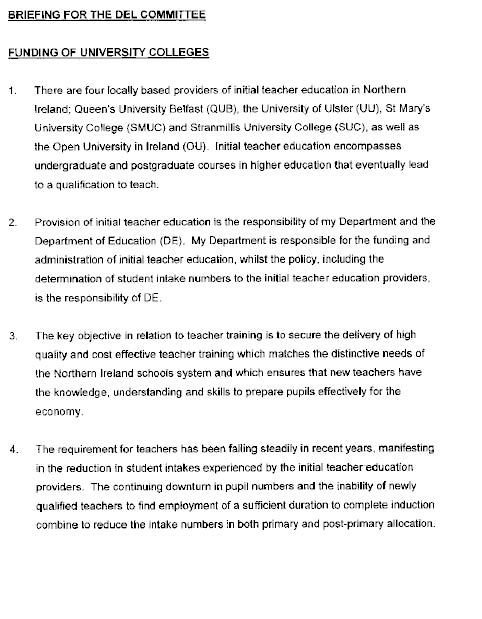

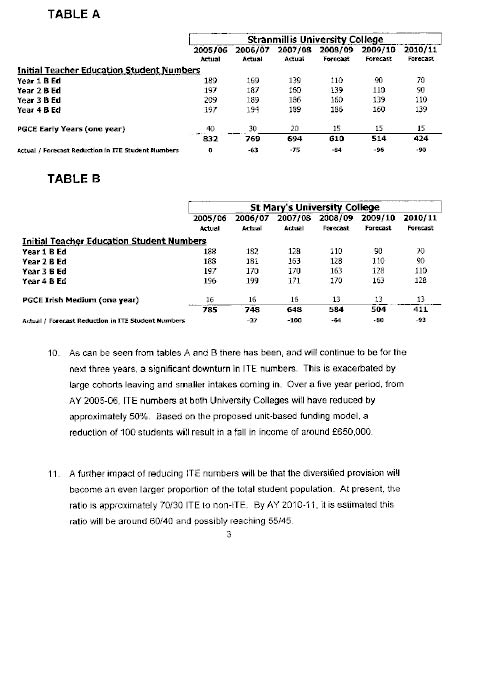
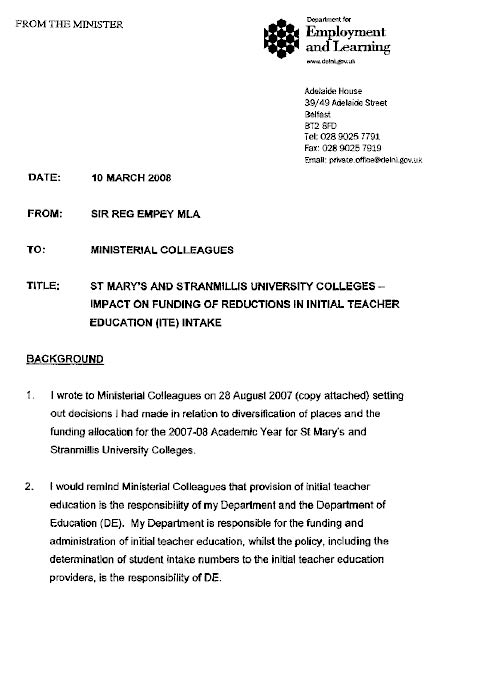
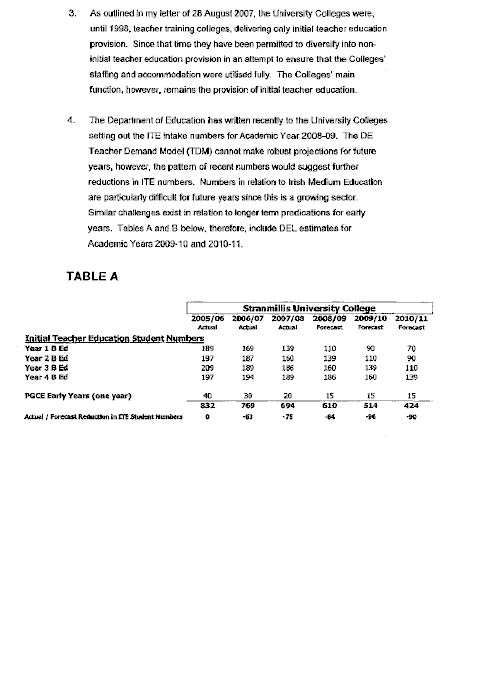
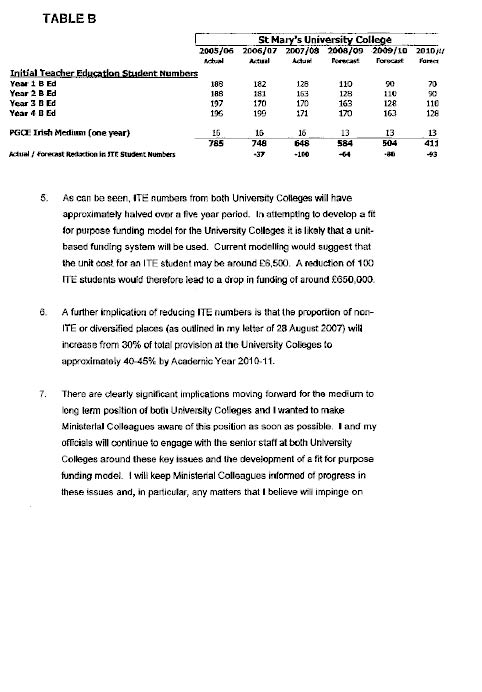

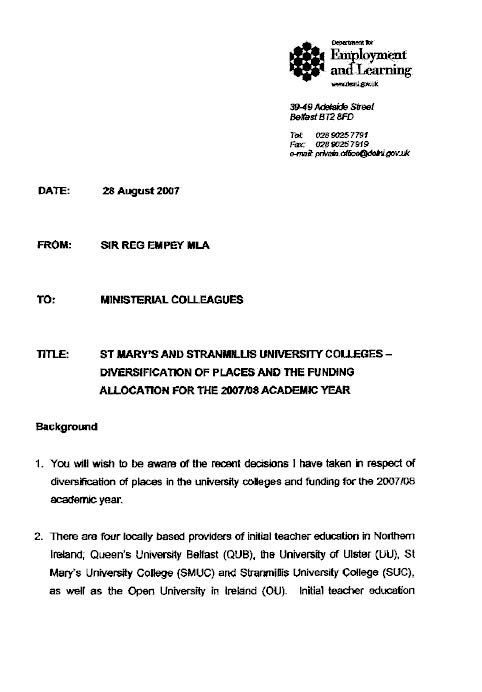
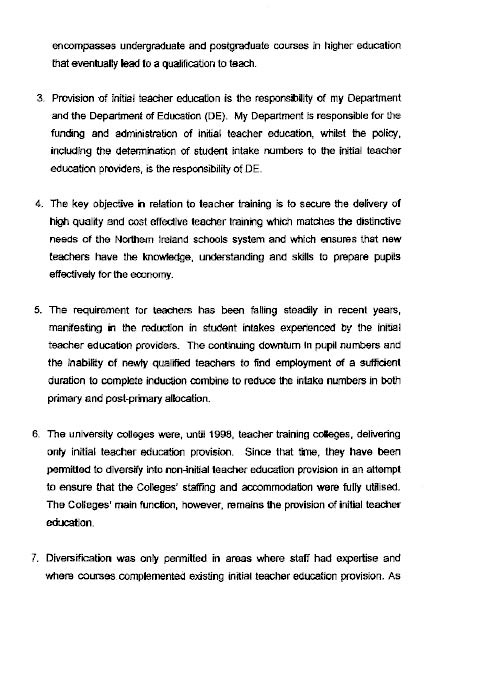

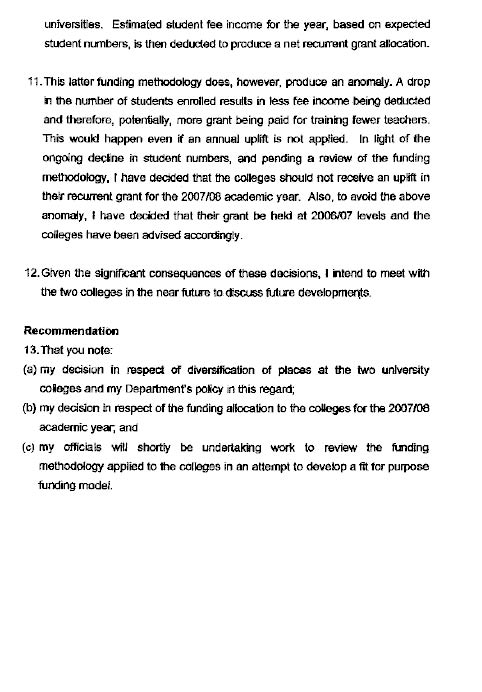

St. Mary’s University College Background paper
16th April 2008
1. Summary
1.1 The Problem
1.2 The Solution
2. The College
3. Academic Provision
4. Performance
5. Variable Fees and the Access Agreement
6. Cost Structure
7. Funding Mechanism
7.1 Current Funding Mechanism
7.2 Proposed Funding Mechanism
8. Liberal Arts Numbers (Diversified Provision)
9. Liberal Arts Business Case April 2007
10. Conclusion
1. Summary
1.1 The Problem
The Department for Employment and Learning is proposing to replace the current College funding mechanism with one based on student numbers. This is being done at a time:
- when initial teacher education numbers at the College are in decline;
- when the recent expansion of diversified places allocated by the Department has been capped; and
- when the Review of Teacher education has not concluded and therefore there is no long-term strategy agreed at Ministerial level, for teacher education in Northern Ireland.
The introduction of the proposed new funding mechanism at this time will seriously undermine the financial viability of St. Mary’s and thereby threaten the distinctive contribution that the College makes to teacher education in Northern Ireland.
1.2 The Solution
The proposed funding mechanism should be revised to take account of the unique circumstances of St. Mary’s University College and of the absence of a teacher education strategy for Northern Ireland.
St. Mary’s accepts the logic of a funding mechanism linked to student numbers but argues that funding should be based on a fixed element as well as a variable element.
The college also suggests that the Department accept the College’s business case to allow the annual intake to the Liberal Arts degree to rise to 130.
2. The College
St. Mary’s is an autonomous Catholic higher education institution founded in 1900. The College was established by charitable trust deed and it has a Scheme of Management setting out its governance arrangements. The College land and buildings are owned by the Trustees chaired by the Catholic Bishop of Down and Connor. The Board of Governors which has ultimate responsibility for the College is also chaired by the Bishop. The majority of the Board is appointed by the Trustees and the Northern Catholic Bishops. Four appointments are made by the Department for Employment and Learning.
The College’s statutory relationship with the Department of Education and the Department of Employment and Learning is set out in the Education and Libraries (Northern Ireland) Order 1986, the Education and Libraries (Northern Ireland) Order 1993 and the Colleges of Education (Northern Ireland) Order 2005. The funding and accountability arrangements between the College and the Department for Employment and Learning are set out in a Financial Memorandum.
Whilst St. Mary’s is legally and financially autonomous it is academically integrated with Queens University. This means that the College operates as a School of the University for academic purposes; St. Mary’s students are registered as students of the university; and the degrees offered by the College are validated by the University. St. Mary’s students are able to avail of the facilities of the University including the library, accommodation and IT suites. For these services the College pays the University approximately £220,000 per annum in validation fees.
The College has approximately 1,000 full-time equivalent students and 150 full-time equivalent staff, including academic and non-academic. The annual budget is approximately £7.8 million. Of this, approximately £5 million is provided by the Department in the form of a recurrent teaching grant. The remainder comes mostly from student fees.
3. Academic Provision
St. Marys offers five main programmes of study: the BEd Primary degree, the BEd Secondary degree, the Irish Medium PGCE, the MEd degree and the Liberal Arts degree (the diversified provision).
The College has a total of 987 full-time equivalent students; 632 in initial teacher education (ITE); 286 on the Liberal Arts degree; and 53 on the MEd degree. Students enrolled at St. Mary’s account for no more than 3% of the total undergraduates in Northern Ireland.
Undergraduate student numbers in ITE are controlled by the Department of Education, whilst the Department for Employment and Learning controls the numbers of Liberal Arts students.
Demand for places at the College continues to be high and no problems are envisaged in filling places allocated by the two Departments.
Over the last few years the number of ITE students has been progressively reduced by the Department of Education. The College strategy, in response to this, supported by the Department has been to replace these students with Liberal Arts students thereby keeping the total number of students at the College at around 1,000. This number of students provides financial stability.
Students come from all over Northern Ireland with a significant number from the Republic. A substantial proportion of students studying the Liberal Arts degree come from North and West Belfast. A high proportion of College students are from lower income households [52.4% in 2007] which makes this one of the distinguishing features of St. Mary’s.
St. Mary’s offers a unique student experience. The College differentiates itself from other providers primarily on its Catholic ethos. It is a small values driven institution. This means that St. Mary’s is student centred and focuses on teaching quality. At the same time St. Marys is academically integrated with Queens University. The College thereby offers a small friendly student centred college within the quality assurance regime of a Russell Group university. The value placed on this by our students is demonstrated by the results in the National Student Survey.
St Mary’s has argued for greater involvement in the Induction, Early Professional Development and Continuing Professional Development phases of teacher education. Coherence and integration of the phases of teacher education is a distinctive feature of the professional development of teachers in Northern Ireland and is central to the GTCNI policy on this. Therefore, St Mary’s believes it makes sense that those from Higher Education who have led in the initial phase take a fuller part in tracking new teachers’ progress and providing training expertise beyond the ITE stage. It should be noted that significant Higher Education involvement in this way is permitted in other UK jurisdictions and in the Republic. This has been a constant thread in the Review of Teacher Education and was highlighted in the Osler Report (2005) in particular. Decisions on these matters have not been made however in Northern Ireland most likely as a result of the decision to delay the implementation date of the Education and Skills Agency (ESA). In this context it is premature and short-sighted to significantly undermine the capacity of St Mary’s by introducing the proposed funding model at this time.
4. Performance
The performance of St. Mary’s is judged according to the same standards as all other higher education institutions. According to these measures St. Mary’s is a very successful college. A range of performance indicators are published annually by the Higher Education Statistics Agency (HESA). These indicators include Participation, Drop-out Rates and Employment.
With respect to Participation of students from lower income households, St. Mary’s achieved a rate of 43.9% for 2005/06 [the latest published data]. This places St. Marys at 14th from 168 institutions.
Indications are that the College will achieve a rate of 52.4% for 2006/07; this will probably make it one of the most successful institutions in the UK for participation.
In terms of drop-out rates, again St. Mary’s performs very well in comparison to other institutions. The drop-out rate for 2005/06 was 4.9%. This would place the College at 15th from the 168 UK institutions.
In the National Student Survey (NSS) of 2007 St. Mary’s performed superbly. According to an analysis of the NSS published by the Times Higher the College achieved an overall satisfaction level of 94% for Teacher Training and 98% for Social Studies. In terms of overall student satisfaction this would rank St. Mary’s 3rd in the UK for Teacher Training and 2nd in the UK for Social Studies.
By any standard of performance measurement St. Mary’s is a quality institution.
5. Variable Fees and the Access Agreement
St. Mary’s decided to charge the full £3,000 fee when variable fees were introduced in 2006. This is in line with the policy of over 90% of institutions in the UK and reflects the distinctive value that the College believes it is providing to students. The decision to charge the full fee was driven largely by the need to take advantage of a new source of revenue which can be used to invest the student experience.
As a condition of introducing variable fees institutions are required to put in place Access Agreements aimed at encouraging participation in higher education from under-represented groups; largely those from lower income households.
Relative to other institutions, the St. Mary’s Access Agreement allocates a very high proportion of the additional income from variable fees to improving participation (approximately 40%). The bursary payments made by the College are as good as any in the UK. We give £1,200 to students receiving the highest level of maintenance grant and £500 to all students receiving any amount of maintenance grant.
St. Mary’s record in delivering on participation is excellent. We believe that we will be amongst the best in the UK for participation in 2007/08.
6. Cost Structure
The Review of Teacher Education was launched at a conference in Limavady in April 2003 and five years later it has still not concluded. In its background paper for that conference the Department suggested that the cost of initial teacher education in Northern Ireland in general and in the colleges in particular was excessive.
This assertion was not and is not supported by the evidence.
The data published by the Higher Education Statistics Agency (HESA) suggest that the unit costs of St. Mary’s are in general lower than both the UK and the Northern Ireland averages.
For example the academic departmental unit cost of the Education cost centre for St. Mary’s for 2006/07 was £4,000 per student. The average unit cost for Education in the UK was £4,120. For Northern Ireland the average was £4,075.
The administrative costs per student at St. Mary’s were £1,448 for 2006/07. The UK average was £1,735 and the Northern Ireland Average was £1,459.
Similarly, the premises costs per student at St. Mary’s were £1,026 per student for 2006/07. The UK average for the same period was £1,402 and the Northern Ireland average was £1,233.
It is our contention that the published cost data together with the performance indicator data demonstrates that St. Mary’s consistently delivers value for money.
Furthermore, as part of the Review of Teacher Education the Department together with the Department of Education commissioned a report from David Taylor and Rod Usher. Taylor and Usher were asked to examine the cost of initial teacher education in Northern Ireland. Paragraph 45 of their report ’Aspects of Initial Teacher Education in Northern Ireland: November 2005’ states quite simply that ’the available data do not suggest that costs in Northern Ireland are significantly more expensive than in other parts of the UK’.
7. Funding Mechanism
7.1 Current Funding Mechanism.
The current funding mechanism dates back to the 1985 settlement which saw the distribution of teacher training students between the two universities and the two colleges. St. Mary’s is currently funded on a block grant basis. The College was allocated a grant in the past on the basis of an estimate of the cost of making the necessary provision for initial teacher education. Historically, the procedure was that the College submitted estimates of its expenditure for the forthcoming year and the Department of Education allocated funding accordingly. Effectively over the last number of years the College has been allocated the same level of gross funding as in the previous year with an increase for inflation. (Gross funding is total funding, comprising recurrent grant and tuition fees.)
The mechanism has suited the College well because it has taken into consideration its unique position in higher education. It would appear that an essentially political decision was taken to fund the College so as to ensure its viability. The decision was driven by the need to maintain a level capacity and the need to maintain financial stability. It also recognised the major fixed cost element in the College cost structure. That is, it recognised the fact that with such small numbers the College would not be in position to benefit from the returns to scale which higher numbers would allow.
The present mechanism also recognises the fact that a small college such as St. Mary’s does not have access to the additional income streams available to large institutions and therefore is unable to cross-subsidise teacher education in the way that is common in universities.
The current funding mechanism supports a level capacity strategy: it allows the College to maintain its capacity without reference to the inevitable fluctuations in teacher demand due to demographic trends. Obviously the provision of teacher training capacity is not something which can be turned on and off at will.
7.2 Proposed Funding Mechanism
It is the understanding of St. Mary’s that the decision to implement any new funding mechanism and the nature of that mechanism are policy decisions for the Department. There would appear to be no statutory requirement to fund the College or its ITE provision in any particular way. There is no requirement that the Department follow the HEFCE or TDA funding methodology. This must be the case since the proposed mechanism applies only to the university colleges and not to the universities where ITE is funded using a mechanism which is unique to Northern Ireland. It is for the Department to amend the funding mechanism as it sees fit.
The College believes that the proposed funding mechanism is inappropriate to the unique circumstances of St. Mary’s. At a fundamental level:
The mechanism fails to take into account the particular cost structure of the College; specifically it does not give sufficient recognition to the very substantial proportion of fixed costs faced by the College.
It does not provide any degree of financial stability either in the short or medium term.
It does not address the issue of maintaining the College’s capacity to cope with variations in demand for ITE students.
By not sufficiently taking into account the fixed cost element of the College cost structure the mechanism does not allow the College to maintain the minimum level of capacity required to provide teachers for the Catholic school sector. Whilst current demand might suggest a short-term reduction in the supply of trained teachers, it must be acknowledged that demographics would suggest that demand is likely to increase in the medium term. Historically, student numbers at St. Mary’s have varied significantly – this is likely to be the case in the future. To eliminate capacity in response to a short-term downward trend is not an effective approach particularly when the Review of Teacher Education has not yet concluded and there is in effect a policy vacuum.
The small and specialist premia suggested by the Department do not result in adequate funding to maintain capacity and cover the College’s fixed costs. The percentages suggested are too low. The additional funding allocated by HEFCE through similar premia is highly variable: some institutions receive up to 305% additional funding by this method. It would be wrong to suggest that it is not within the power of the Department to increase these allocations.
The method by which the additional premia are allocated is also problematic. The College suggests that the present proposal would result in the small and specialist allocations varying with student numbers. A much more effective method of providing recognition for the small and specialist nature of St. Mary’s would be to allocate a fixed premium which did not reduce as numbers declined. The College would contend that a costing exercise should be carried out immediately to estimate the fixed element of the College’s costs with a view to establishing an allocation which could be quantified and then increased annually by the GDP deflator.
The College also suggests that a maximum percentage reduction to the teaching grant be set in any one year. The purpose of this would be to prevent unmanageable fluctuations in funding and to allow for the managed reduction in short to medium-term capacity if this is necessary. The College suggests a minimum of 2.5%.
Also, to ensure that any reduction in funding is properly managed the College suggests that the new funding mechanism is not introduced until after the Review of Teacher Education has been completed or until the academic year 2009/10 at the earliest.
The proposed funding mechanism makes use of the Training and Development Agency (TDA) units of resource. Whilst the College recognises that these units of resource have a place in any funding mechanism for the College the particular way in which they have been incorporated is not consistent with the TDA methodology.
Unlike the HEFCE units of resource, the TDA unit of resource are gross units of funding, i.e. they are exclusive of standard tuition fees. Whereas the standard tuition fee is subtracted from the HEFCE units of resource this standard fee is not subtracted from the TDA units of resource. The Department’s mechanism uses the TDA unit but subtracts the standard fee as if it were the HEFCE unit. The result is that the College will receive less than the TDA unit of resource per student.
The college suggests that the gross TDA unit of resource is used.
The funding mechanism does not appear to take account of Rewarding and Developing Staff (RDS) funding. The College receives specific ring-fenced funding and mainstreamed funding for RDS which does not appear in the model proposed. The College understands that the proposed units of funding do not include any element related to RDS funding which is currently mainstreamed nor does it envisage mainstreaming that element of RDS which is currently ring-fenced. Total RDS funding should be maintained at its present level.
The Department have suggested that the proposed mechanism is consistent with the funding mechanism for institutions in England. Apart from the fact that we are not aware of any requirement for the Department to follow the English model, the proposed mechanism ignores one fundamental element of the English model: institutions in England may have unit funding but they are not restricted by the MASN cap, as are institutions in Northern Ireland. To impose a unit funding mechanism and at the same time restrict an institution’s ability to cope with it by expanding student numbers would appear to be perverse. St. Mary’s have repeatedly requested that the Department allow the College to increase its Liberal Arts intake to 130 per annum.
The mechanism also fails to take account of high cost subjects. Specifically, St. Mary’s offers a Technology and Design (T&D) course which is relatively more costly than other subjects. We would suggest that a higher unit of resource is allocated to T&D students.
There is no long term strategy agreed at Ministerial level for teacher education in Northern Ireland. The proposed funding model is therefore a short-term expediency which will have drastic consequences for the viability of St Mary’s.
8. Liberal Arts Numbers (Diversified Provision)
On the recommendation of the Northern Ireland Audit Office, St. Mary’s was encouraged to increase its total student numbers by diversifying its provision. This the College duly did. The Liberal Arts degree was introduced in 2000 with an original allocation by the Department of 200 places: an intake of 67 per year.
The diversification strategy was suggested so as to make use of surplus capacity and to reduce unit costs in the College. In these terms diversification has been a success. Total student numbers increased from 639 in 1996/97 to a high point of 1,033 in 2003/04.
Academically the Liberal Arts degree was also a success. All of the available data would indicate that the Liberal Arts degree is comparable to any similar degree offered in the UK. It has contributed significantly to the College’s high performance in participation and staff and students have benefited from the fact that St. Mary’s is no longer a monotechnic institution.
It has been suggested that diversification has the potential to damage the high quality of the College’s ITE provision. No evidence has been produced to substantiate this assertion. All of the available performance data for both ITE and the Liberal Arts would indicate otherwise. St. Mary’s is confident that no evidence can be produced to contradict this statement.
There are clearly examples from other countries, not least England and the Republic, where diversification has not only been specifically encouraged but has enabled small teacher training colleges to thrive. There is nothing inherently wrong with diversification. St Mary’s is not however seeking a transformation to an alternative provider of HE, it is merely seeking approval for an increase in diversified places to enable it to cope with fluctuations in the ITE numbers. What is needed is the political will to back the proposal set out in the business case.
In 2005/06 as a result of reductions in ITE numbers the Department allowed St. Mary’s to increase its Liberal Arts intake from 67 to 77 in order to maintain overall student numbers. This enabled the College to maintain its teaching capacity. In 2006/07 the intake for the Liberal Arts was increased by the Department from 77 to 102. Similarly in 2007/08, in response to continued reductions in the ITE intake and apparently in response to a business case submitted by the College in April 2007, the Department increased the Liberal Arts intake to 130.
In June 2007 the College was informed that the block grant had been frozen at its 2006-07 level and a review of the current funding mechanism was to be undertaken. Further, correspondence on the future of student numbers on diversified courses (in this case Liberal Arts) led St. Mary’s to understand that although no further approval would be given to increase diversified places, nevertheless the intake figure would be set at 130 students.
At a meeting between College management and Department officials in November 2007 it was confirmed that the intake for 2008/09 would be 130. This figure was also communicated by the same officials to representatives of the College academic trade union. The College strategy of off-setting reductions in ITE numbers with increases in Liberal Arts numbers allowed the College to maintain capacity and keep unit costs low. It also appeared to have the support of the Department.
However, in April 2008 the Department informed the College that the intake for the Liberal Arts degree in 2008/09 would not be 130 but that the total number on the degree would be capped at 260 giving an intake, by the Department’s calculations, of 33. In the light of the proposed funding mechanism, this decision will seriously threaten the financial viability of the College.
St. Mary’s continues to believe that the strategy of off-setting reductions in ITE student numbers with Liberal Arts students is a sound one.
As part of its response to the proposed funding mechanism St. Mary’s requests that the Department approve the proposal for the expansion of the Liberal Arts intake to 130 students.
9. Liberal Arts Business Case April 2007
The following is a summary of the business case presented by the College:
Reductions in St. Mary’s ITE numbers have the potential to create surplus capacity in the College. St. Mary’s proposes to use this surplus capacity to expand its Liberal Arts provision. This diversification strategy was first proposed by the Northern Ireland Audit Office in 1997 as a measure designed to ensure that unit costs in the then Colleges of Education would be comparable to those in other higher education institutions. The intake for 2006/07 to the Liberal Arts programme was 103 students: we propose to increase this to 130 students for the next three years i.e. 2007/08, 2008/09 and 2009/10.
Acceptance of this proposal would marginally increase the number of non-ITE students in Northern Ireland but would not result in any additional cost to the Department of Employment and Learning (DEL). It will ensure that existing resources are utilised effectively and efficiently. Also, by enabling the College to operate at full capacity it will help to ensure that St. Mary’s remains financially viable in the longer term.
The proposal is aligned with the strategic priorities of Government generally, and with those of DEL in particular. Acceptance would contribute to widening access and participation; St. Mary’s performs outstandingly well in attracting entrants from SEC groups 4 -7 and expansion of its Liberal Arts programme would ensure that this would continue. The Liberal Arts degree also helps to strengthen the skills base of the Northern Ireland economy. And, given that St. Mary’s is an integral part of the Greater West Belfast social and economic infrastructure, acceptance of the proposal would help combat economic inactivity in this particularly deprived area.
The quality of the Liberal Arts programme can be demonstrated by reference to published performance indicators. The College believes that these indicators demonstrate the quality of the existing Liberal Arts programme. Also, we believe that the same performance indicators demonstrate that the quality of the ITE programme has not suffered as a result of diversification.
This proposal is aligned with the current College strategy. The core business of the College is Initial Teacher Education. Acceptance of this proposal would not alter this. The College does not intend to expand the Liberal Arts degree programme to the extent that this would detract from its core mission. Whilst continuing to see itself as an academically mature University College, St Mary’s remains a small specialist college.
Potential reductions in ITE numbers could mean that the College would have surplus capacity which would result in an inefficient use of resources if no remedial action were taken. By increasing non-ITE student numbers in line with this proposal the College will continue to operate at near full capacity and continue to offer value for money by organising courses with unit costs significantly lower than both the Northern Ireland and UK averages.
10. Conclusion
In summary the College position is as follows:
The proposed funding mechanism should be revised to take account of the unique circumstances of St. Mary’s University College and of the absence of a teacher education strategy for Northern Ireland.
St. Mary’s accepts the logic of a funding mechanism linked to student numbers but argues that funding should be based on a fixed element as well as a variable element.
The college also suggests that the Department accept the College’s business case to allow the annual intake to the Liberal Arts degree to rise to 130.
Stranmillis University College
16 April 2008
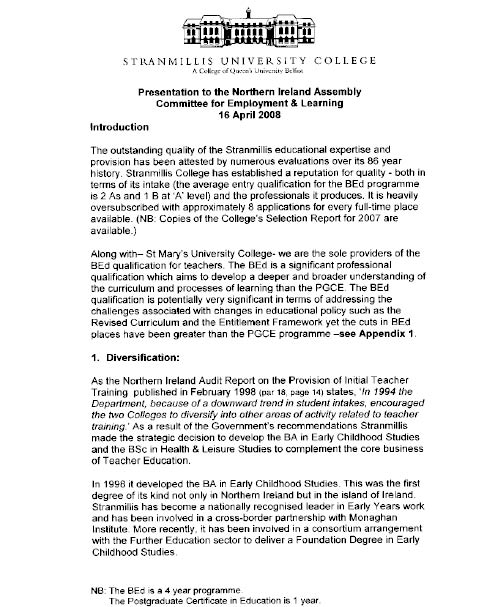
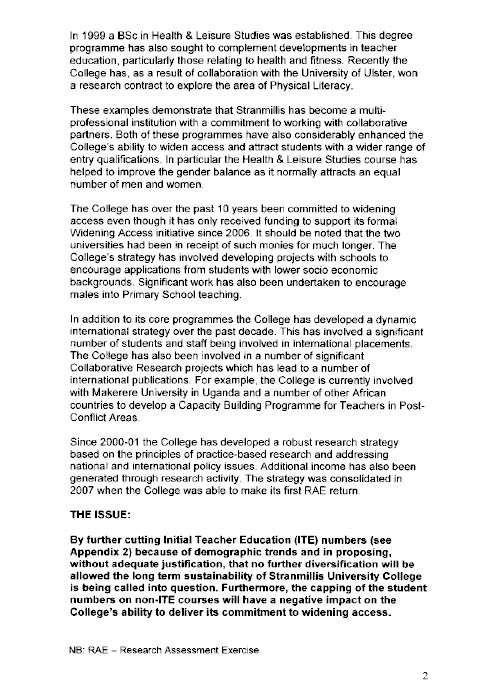
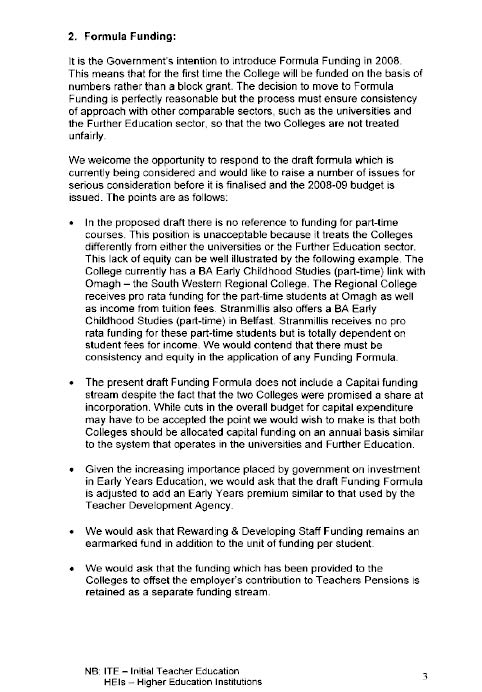
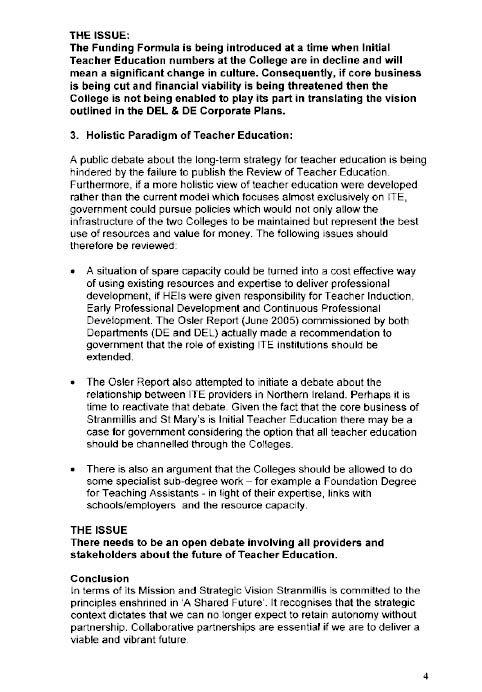
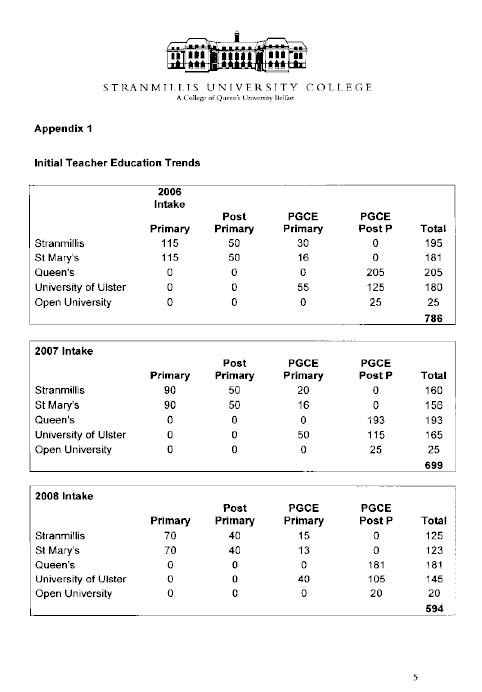
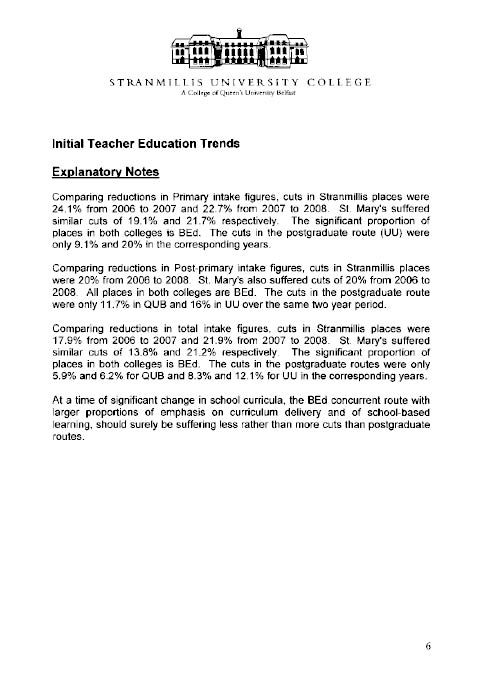

Department for Employment and Learning
7 May 2008
Meeting at Stranmillis Thursday 17 April 2008
- Thanks and welcome opportunity
- Want to set out current and proposed funding models
- ITE numbers – set by DE through Teacher Demand Model
- Diversified places
Funding
- current model not fit for purpose
- the less students that go to Stranmillis the more money Stranmillis receives from DEL
- Minister clear that this is not a fit for purpose model
- model should be responsive to student numbers, clear, transparent and easily understood by all
- working with Norman Halliday and Anne Heaslett to finalise the elements that make up the model
- model will be introduced in September 2008
- transitional arrangements
- under the proposed funding model, a drop in intake of 100 students will equate roughly to a drop in income of £1m.
ITE Numbers
- handout
- by 2010, ITE numbers will have halved over five years
- small numbers going in, large numbers going out
- increases % of diversified places.
Diversified places
- Early Childhood Studies and Health and Leisure
- Minister wrote to College last year to say that no further increase would be permitted
- any further expansion would increase significantly the percentage of diversified places – “mini-university” – and call into question the nature of the institution
- 30% moving to 40/45%
What happens next?
- funding model to be finalised and college informed of funding available for 2008-09
- examination of transitional arrangements
- work with College to explore options for future, eg EPD and CPD
- happy to take questions.
Additional info
- Decline of 13,000 by 2011 then steady until 2017
2004-11
- 4 – 10 ↓4.5%
- 11 – 15 ↓7.3%
- P/T provision does not always attract institutional funding.
|
2005/06 Actual |
2006/07 Actual |
2007/08 Actual |
2008/09 Forecast |
2009/10 Forecast |
2010/11 Forecast |
|---|---|---|---|---|---|---|
Initial Teacher Education |
|
|
|
|
|
|
Year 1 B Ed |
189 |
169 |
139 |
110 |
90 |
70 |
Year 2 B Ed |
197 |
187 |
160 |
139 |
110 |
90 |
Year 3 B Ed |
209 |
189 |
186 |
160 |
139 |
110 |
Year 4 B Ed |
197 |
194 |
189 |
186 |
160 |
139 |
PGCE Early Years (one year) |
40 |
30 |
20 |
15 |
15 |
15 |
|
832 |
769 |
694 |
610 |
514 |
424 |
Actual / Forecast Reduction in ITE Student Numbers |
0 |
-63 |
-75 |
-84 |
-96 |
-90 |
Queen’s University Belfast
25 June 2008


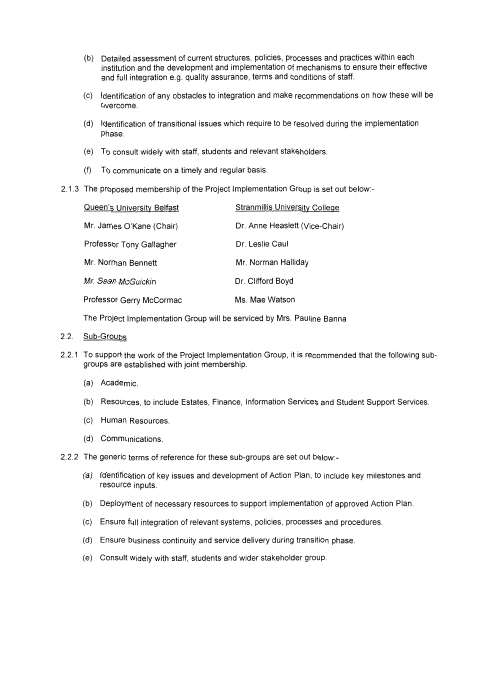
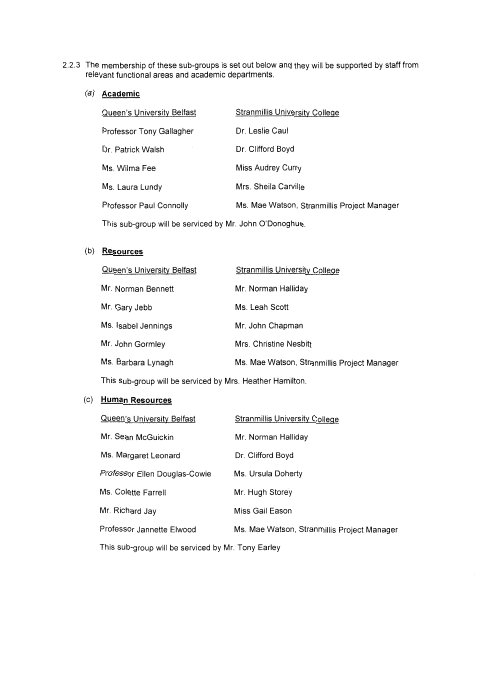
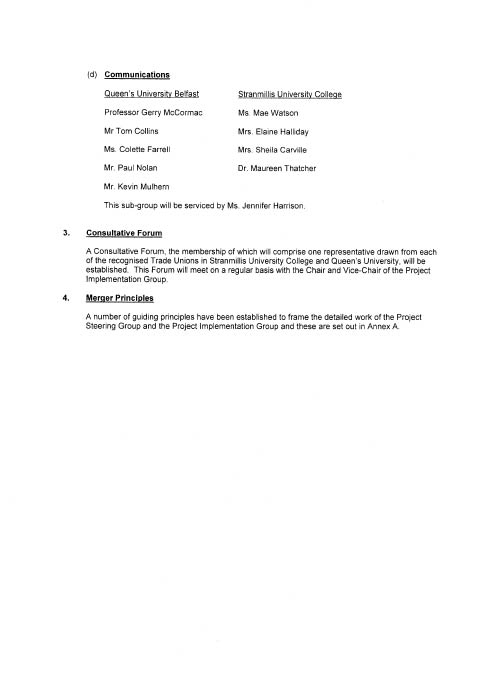
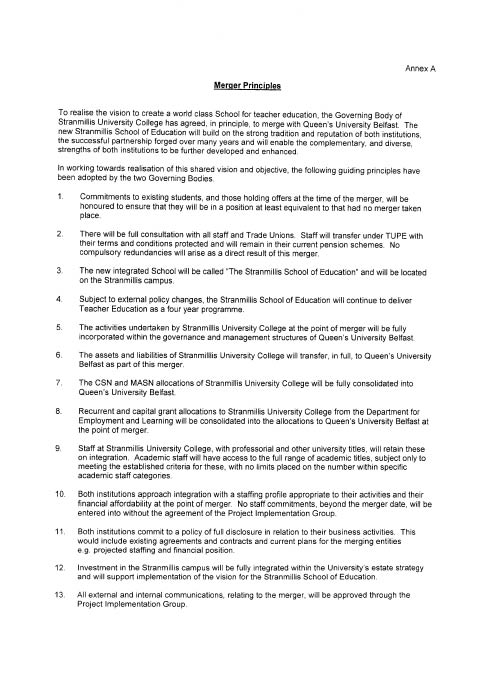
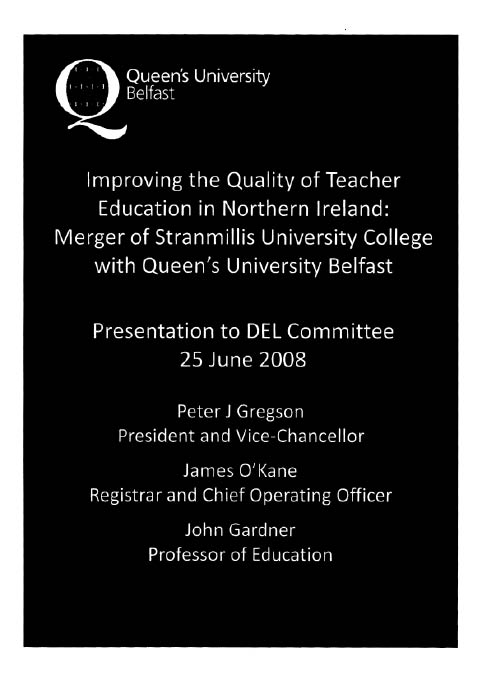
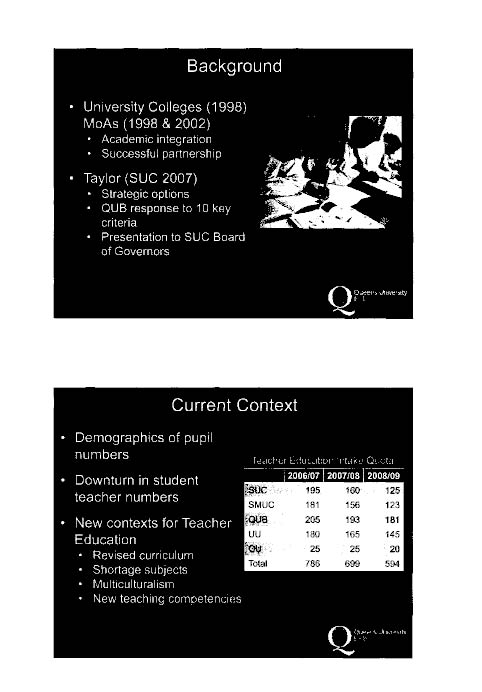

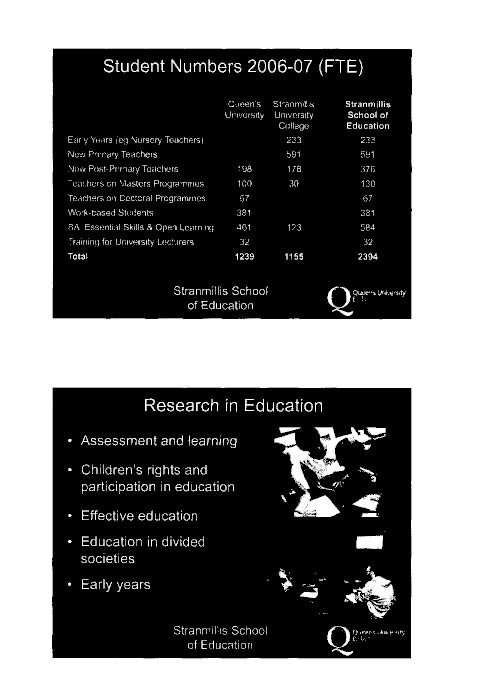
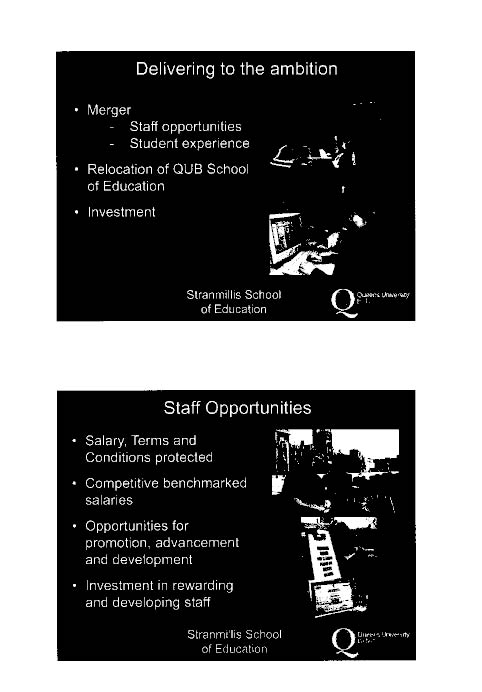
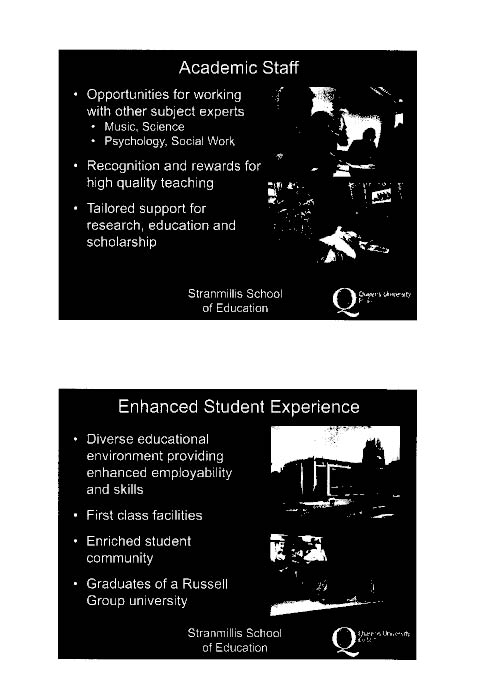

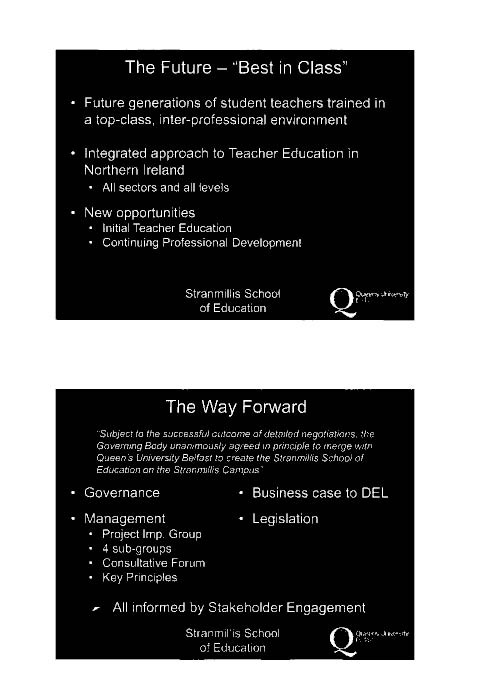
University of Ulster
3 September 2008
Education at the University of Ulster
1. Based in the School of Education which includes the UNESCO Centre with its focus on Education for Pluralism, Human Rights and Democracy.
2. Postgraduate programmes in Initial Teacher Education and Training span the 4 to 19 age range and include primary, post-primary and further education. The University is the sole provider of Initial Teacher Education for the further education sector in Northern Ireland.
3. Features of the PGCE programmes:
- Integrated programmes which prepare students for Catholic, Protestant and Integrated schools and the FE sector.
- A religious education certificate approved by all the main churches in Northern Ireland.
- A range of subsidiary subjects is available for all PGCE post-primary students including: Local and Global Citizenship; Personal, Social and Health Education; and Special Needs Education. In addition they have access to specialist provision to assist with teaching pupils who are speakers of other languages.
- Key themes from the UNESCO Centre which support Initial Teacher Education include: Civic and Citizenship Education; Education and Community Relations; Integrated Education in Northern Ireland; and Developmental Education.
4. Postgraduate Certificate in Further and Higher Education (PGCFHE).
Taken by lecturers new to lecturing in the FE sector and offered in partnership with the FE sector.
5. Other postgraduate programmes include:
- MA in TESOL (Teaching English to Speakers of Other Languages).
- MEd including a programme designed specifically for teachers at the induction and early professional development stage of their careers. Other MEd programmes include those focussed on: Pedagogical Expertise in ICT; Education Management; and Inclusive and Special Education.
- Postgraduate Diploma in Library and Information Management.
- PhDs, a vibrant cohort of students.
- EdD (professional doctorate), a revised programme to be introduced in 2009.
6. Other undergraduate activity:
- Education as a minor subject combined with a wide-range of major subjects.
- International Development as a minor subject combined with a wide-range of major subjects. The University of Ulster is one of only a handful of Universities to be funded by DfID for this and the only one in Northern Ireland.
7. Tutoring in Schools (Community Outreach).
8. Sparking the Imagination, a primary school initiative supporting the University’s widening access policy and inspiring pupils in socially disadvantaged areas to raise their aspirations (also involves parents of the pupils).
9. Research focuses on:
- Schooling and Teacher Education.
- The use of ICT in teaching.
- Inclusion and Education.
- Education, Conflict and International Development.
Thus, a modestly-sized, but vibrant School of Education offering much that is unique in Northern Ireland.
10. A review of teacher education in Northern Ireland has been underway -
since 2003, with a teacher education stakeholder group being
established to which the University of Ulster has contributed positively.
11. Throughout this process enhanced co-operation and collaboration
across all providers has been emphasised.
12. Meeting in January 2008 to which the heads of the five higher
education institutions (HEIs) providing teacher education in Northern
Ireland were invited. At the meeting they were provided in confidence
with a draft review document. Four of the heads of the HEIs attended
this meeting, not clear if, or how, the fifth was consulted.
13. University of Ulster discussions with Stranmillis University College in
two areas:
- Discussions with the new Director about the areas in which we might co-operate and collaborate (in line with the principles of the ongoing review).
- Approach from the Chairman of the Board of Governors of the College. Discussions with the Director in the light of these but around Christmas 2007 the Board of Governors appear to have decided that an option in which Stranmillis University College continued to operate independently but collaboratively with other providers was not to be pursued.
- Given Stranmillis’s decision, the University is not clear where this now leaves the review of teacher education with its emphasis on collaboration and co-operation.
- The need for a coherent probationer and early career professional development programme to complement Initial Teacher Education.
14. Funding issues.
15. The University of Ulster is committed to continuing to provide high quality teacher education and other high quality education programmes as set out above.
University of Ulster
August 2008
Stranmillis University College
10 September 2008
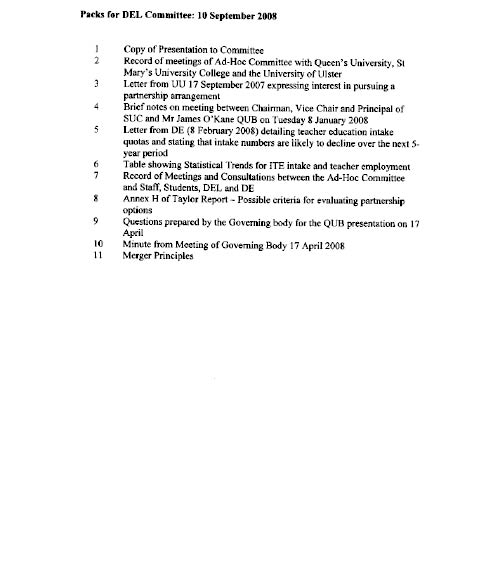
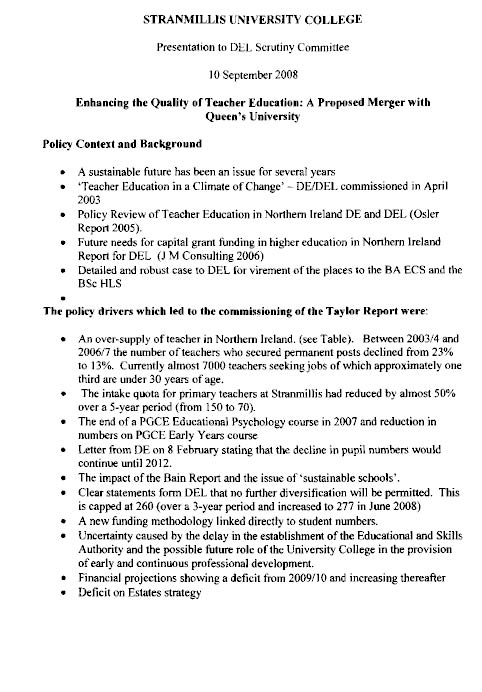
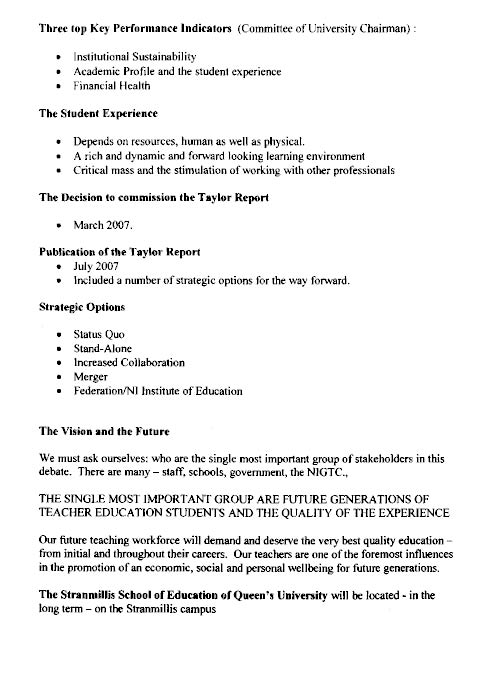
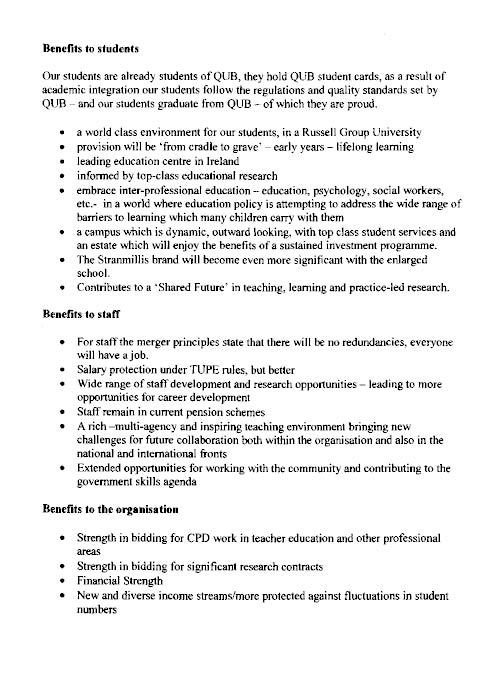

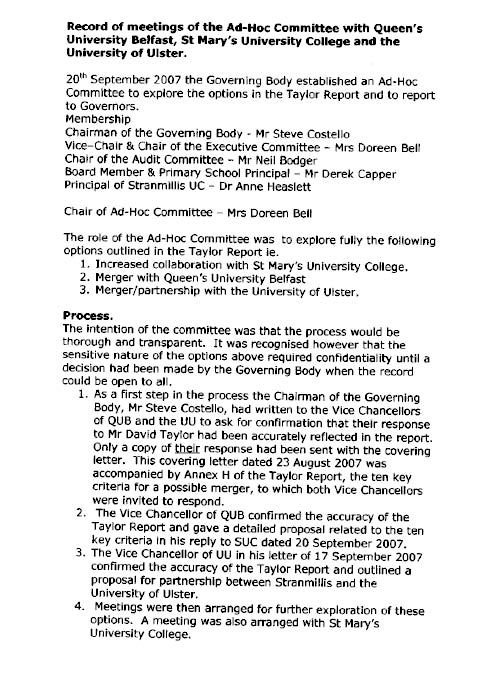
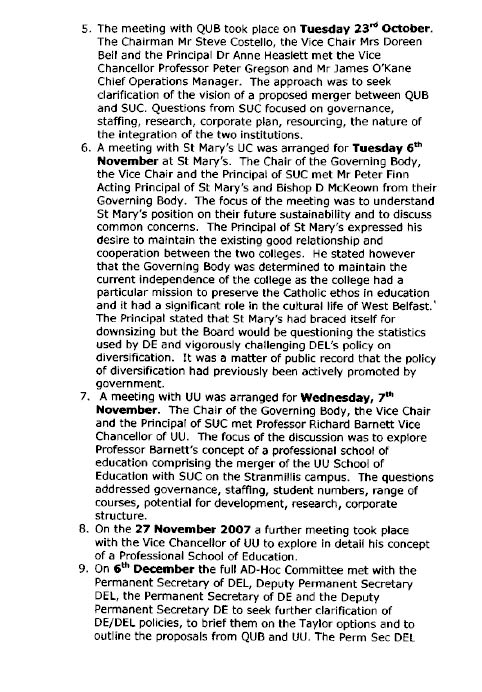

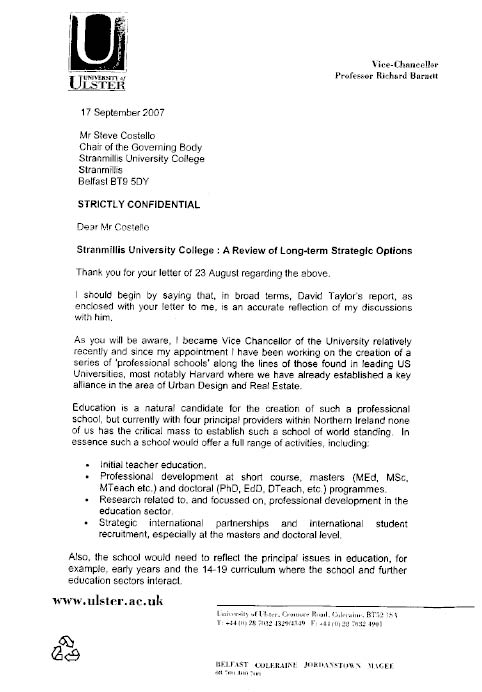

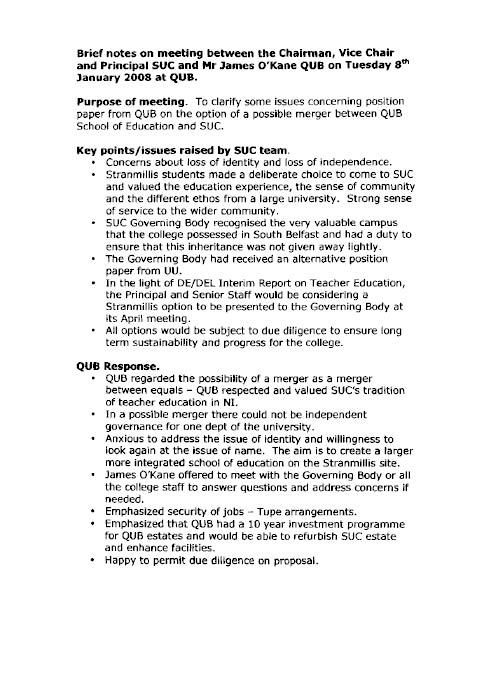


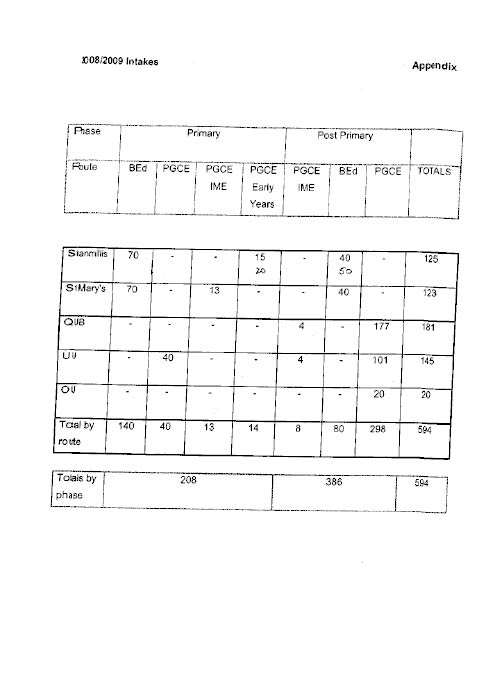

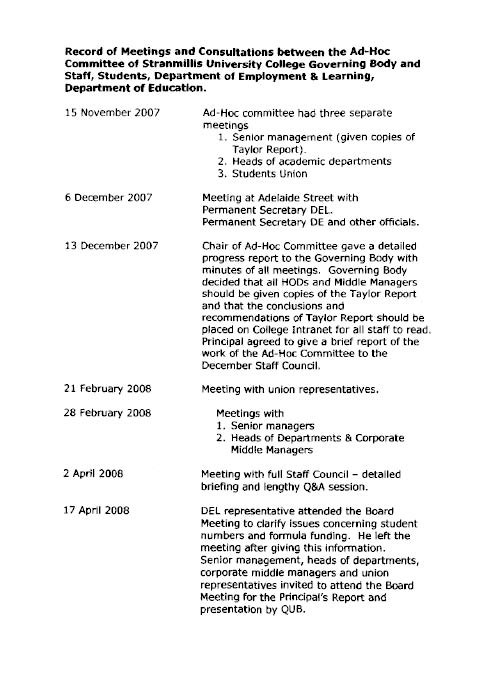
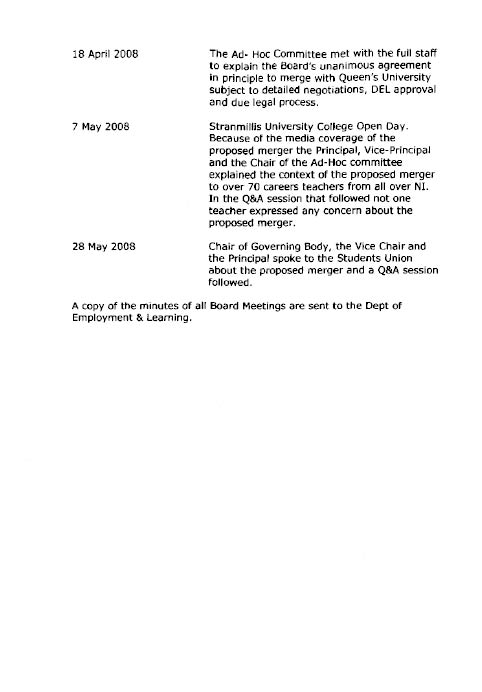
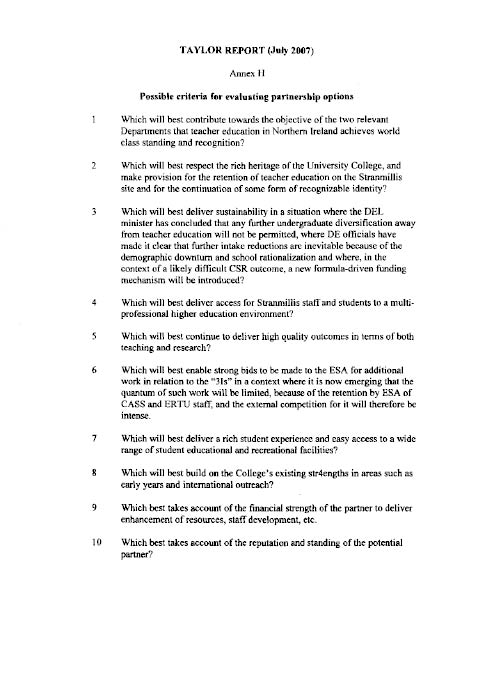

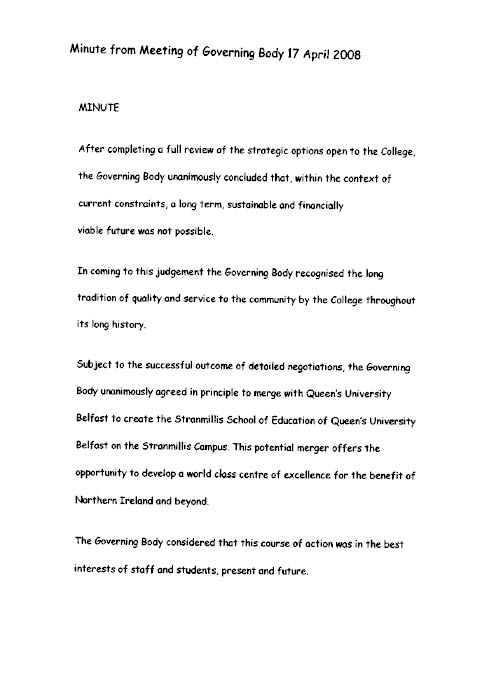

St. Mary’s University College
24 September 2008
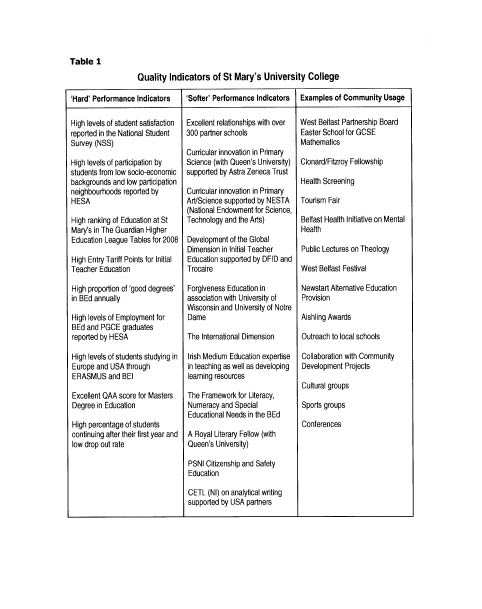
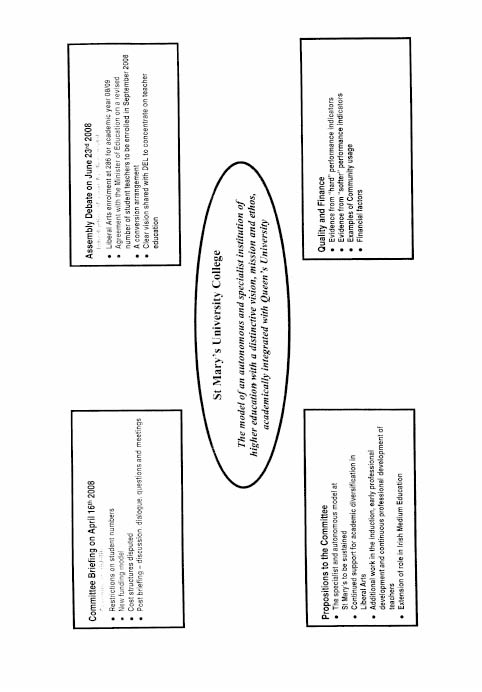
National Union of Students/
Union of Students in Ireland (NUS-USI)
1 October 2008

Student Position Paper
DEL Committee
1 October 2008
Index Page
Introduction
Proposed merger of Stranmillis University College with Queen’s University Belfast
Our Team
Introduction
The National Union of Students-Union of Students in Ireland (NUS-USI) was established in 1972 under a unique arrangement where both the British and Irish national student unions jointly organise in Northern Ireland to promote student unity across the sectarian divide.
NUS-USI represents the interests of over 200,000 students in Northern Ireland and campaigns on their behalf in many different fields such as student hardship, health, prejudice and accommodation. We also provide an infrastructure, which helps individual Students’ Unions in the North of Ireland to develop their own work through our research, training and development functions.
As a democratic organisation, students in colleges across Northern Ireland elect our regional officers and decide on policy and programme targets. Because we are run by students for students, we can ensure that our work meets the needs of our diverse membership. NUS-USI uses a variety of means to make sure that our representation of student issues is taken seriously. Supported by a professional staff complement, much of our work is divided in the following areas:
Representation
NUS-USI is represented on a wide spectrum of steering groups and advisory bodies and we meet regularly with Government Ministers, civil servants, educationalists and a host of NGOs in Northern Ireland. We also liaise closely with other student organisations in Britain, the Republic of Ireland and abroad. These include, for example, ESIB (the European Student Information Bureau), AMSU (the UK association for managers in students unions), BUSA (the British University Sports Association) and ASUA (the Association of Students Union Administrators in Ireland).
Development
NUS-USI provides direct advice and support to Students’ Unions to assist their development and make them more effective organisations. We assist Further Education colleges to start up local unions and to develop commercial services. We provide advice on, for example, Students’ Union constitutions, ultra vires, elections, clubs and societies and duty of care as well as employment and fund-raising issues.
Training
NUS-USI delivers high quality, experiential training courses for student officers and activists throughout the academic year. These accredited courses promote personal capacity building and cover everything from how to organise entertainment’s events to training the trainers’ courses. Some of these courses can be organised “in house” and can be tailored to meet specific Students’ Union needs. We also contribute training resources to both the British and Irish national student unions and a number of local youth, community and college training events.
Mental Health
In conjunction with Rethink NI, NUS-USI manages the five-year peer-led mental health project Open Your Mind, to address the need for positive mental health services for those who need it, and, in particular, the student population. This is a campaign run by students, for students, and promotes awareness of mental health issues among students aged 16-25 across Northern Ireland. The project aims to reduce risk factors related to mental health, and includes research to gauge the needs and attitudes of the student body on mental health and mental illness.
Adult Learner Finance
In partnership with the Educational Guidance Service for Adults (EGSA), NUS-USI delivers the Adult Learner Finance Project NI. The project has been funded by the Department for Employment and Learning, and encourages the participation and retention of adults in learning through specialist information on financial support available to adult learners and mature students. The project offers advice, money management, debt resolution, mentoring and casework services, and has produced a website and a number of information leaflets including a ‘Students and Benefits’ booklet. An accredited training course for student advisors has been developed, and the project has also raised policy issues with relevant bodies.
Education/Public Affairs
Through our Education/Public Affairs unit we can increase our lobbying and campaigning expertise to achieve priorities of our members. We monitor relevant government Departments, Committees and legislative procedures and assist in informing and training elected representatives in pursuit of press coverage and political activism. Such activities enable NUS-USI to more effectively engage politically, draft policy papers and conduct research, informing viable alternatives to policy as required by our members. Through regular membership briefings and policy papers, we can increase awareness among decision makers of issues most important to the student population. We also analyse policy of other devolved and national institutions, working closely with NUS-UK, ESIB and USI.
Lobbying
NUS-USI has regular contact with MPs, Assembly members, Directors and Principals, Vice-Chancellors, Government Departments and other key figures in the world of education. Lobbies of Stormont, the House of Commons and the Dail ensure that the student perspective is heard in national government and representations are also made to the European Commission and Parliament and other international agencies. A range of briefings and submissions are prepared in order to influence Government decisions with the aim of improving the quality of education for students and the community at large.
Policy File
The Regional Executive and Regional Council are mandated to work on the following issues for 2008/2009:
- Campaigns
- Community Relations, Human Rights and the Political Process
- FE SU Development
- Higher Education and Student Financial Support
- Internationalism and Europe
- NUS-USI – NI Region
- Sport
- Training and Student Development
- Welfare and Health
- Liberation Affairs
Further information on the work of the Regional Executive and Regional Council can be obtained by contacting Katie Morgan, President.
Proposed merger of Stranmillis University College with Queen’s University Belfast
Context
We welcome the opportunity to present evidence to the Committee for Employment and Learning on student perspectives on the proposed merger of Stranmillis University College with Queen’s University Belfast. NUS-USI has long enjoyed a highly-productive relationship with the Committee, and we are delighted to be able to advise on this matter.
In this paper, NUS-USI represents the views of students from Queen’s University Belfast (Queen’s) and St. Mary’s University College (St. Mary’s). Stranmillis University College (Stranmillis) is not an affiliated member of NUS-USI, and as a result we are not in a position to represent the views of Stranmillis students in this paper.
Our fundamental principle
We believe that a merger of Stranmillis with Queen’s will be beneficial for students of both institutions, increasing student numbers within Queen’s, enabling some 3500 Stranmillis students to access and share facilities, and providing an opportunity for students to form part of a future world-class centre of education.
It is important that there be meaningful student representation throughout the decision-making process. Queen’s students’ union (QUBSU) has already confirmed that there will be student representation in the decision-making process, as has been the case throughout the previous stages of the merger consultation. We encourage the institutions to ensure this continues. There has been Union representation on the project implementation group, and we feel that this should also continue. A guarantee has also been issued for all Stranmillis students entering the institution under the current system that the merger will have no effect on their degree. We feel it is important to ensure that this be carried through.
Views of Queen’s University Belfast Students’ Union
QUBSU are supportive of a merger, and feel it would be beneficial to both QUB and Stranmillis students. As Queen’s works towards a world-class centre of education, the student experience for Stranmillis students will be improved as a result.
QUBSU are keen that the merger happens in the time-frame agreed by both Queen’s and Stranmillis. This time-frame will give both students and staff the confidence they need moving forward and will remove uncertainty which currently exists.
Specific changes for the students’ unions
It is hoped that there will be a satellite site on the Stranmillis campus to be known as QUBSU at Stranmillis and a Stranmillis representative plus staff support will work as a specific sabbatical officer dedicated to the students at the Stranmillis site and to all students in the School of Education. The sabbatical officer will be a full member of the QUBSU Executive. Facilities at Stranmillis SU will benefit from merging with the state of the art students’ union at Queen’s.
Views of St. Mary’s Students’ Union
St. Mary’s SU are supportive of a merger of Stranmillis with Queen’s, provided that St. Mary’s remains unaffected directly by it. St. Mary’s strongly opposes the idea of any merger between St. Mary’s and Queen’s, and given the non-denominational charter within Queen’s, such a merger between St. Mary’s and Queen’s would not be in keeping with current institutional ethics.
Conclusion
While urging the Committee to ensure that assurances already given be carried through - in relation to current Stranmillis students’ degrees, student representation in decision-making and Union representation on all levels of the decision-making and consultation process - we believe a merger of Stranmillis with Queen’s will benefit students from both institutions and create positive opportunities for the future.
Our Team
Katie Morgan President
Marie McLoone Deputy President
Matthew Collins Education & Welfare Officer
David Cassidy Further Education Development Officer
Chris Geddis LGBT Officer
Vacant Women’s Officer
Vacant Environmental Officer
Jay Downs Student Volunteering Officer
Stephen McShane Disabilities Officer
Anne Pauli Equality Officer
Daniel O’Boyle & Gavin McMurray Officers without portfolio
Gail Ferguson Director
John Caldwell Adult Learner Finance Project
Benjamin Ewan Training and Development Diversity Programme
Elaine Kelly Open Your Mind Co-ordinator
Sarah Maitland Education/Public Affairs
Laura Stobo Administration and Finance
Stranmillis Students Union
1 October 2008


Council for the Advancement of Communication with Deaf People (CACDP)
15 October 2008
Who we are
CACDP is a Professional Registration Body and recognised UK Awarding Body. We reach more than 30,000 candidates every year and today more than 600 professional British Sign Language Interpreters, Lipspeakers, Speech-to-text-reporters and Deafblind Manual interpreters choose CACDP as their registration body.
Northern Ireland
In Northern Ireland there are approximately 35 deaf tutors who are teaching BSL and ISL courses at various levels at about 30 approved Centres. Whilst some of our provision is delivered through schools, organisations or voluntary or community groups, the majority of our provision is delivered through Further Education Colleges. The majority of our tutors are self employed, or employed part time and work an average of 12 hours a week. There is a great variation in Northern Ireland with some tutors teaching pretty much full time with a variety of classes and private tution, and others tutoring on one session (2 hours) a week.
In September 2007, a survey of all CACDP tutors in the UK indicated that only 45% of BSL tutors had a formal teaching qualification, usually a City and Guilds qualification for teaching in FE. No deaf tutor in Northern Ireland has the current qualification (the City and Guilds 7303) though some older tutors have qualifications achieved in England back in the 1980s
Why is this
This is because Deaf tutors have been unable in Northern Ireland to access courses in BSL that would allow them to get a formal teaching qualification to teach in FE, whether they wish to teach BSL / ISL or to teach another subject.
Why does it matter
DEL announced in June this year that it would provide £1.3 million over the 09/10 and 10/11 financial year to increase the number of registered Interpreters and the number of tutors teaching at that level in Northern Ireland. If this to be realised, tutors need to be given the opportunity to access a formal teaching qualification which will put them on an equal and professional footing with other FE tutors. This would allow more Deaf people to consider teaching as a full time career, and have the associated benefits in terms of pay and conditions. It would create a perhaps smaller, but full time professional tutors who can train future interpreters, who in turn will provide a service that will improve the access of Deaf people
For further information contact
Pam Tilson
Communications Manager Northern Ireland
CACDP
Wilton House
5 College Square North
Belfast, BT1 6AR
Phone 028 9043 8161
Email pamt@cacdp.org.uk
Transferors Representatives’ Council
22 October 2008
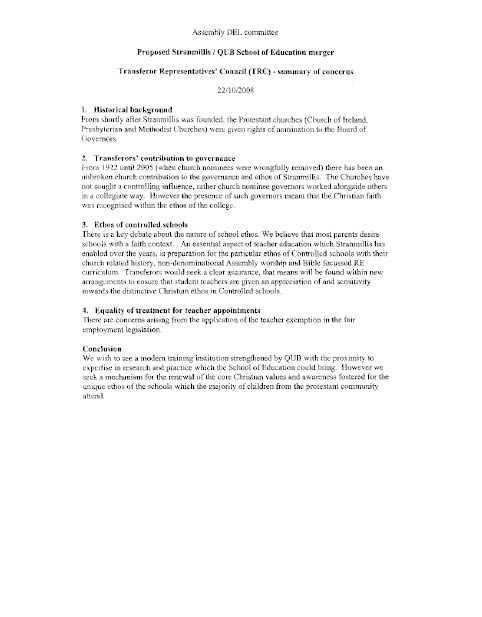
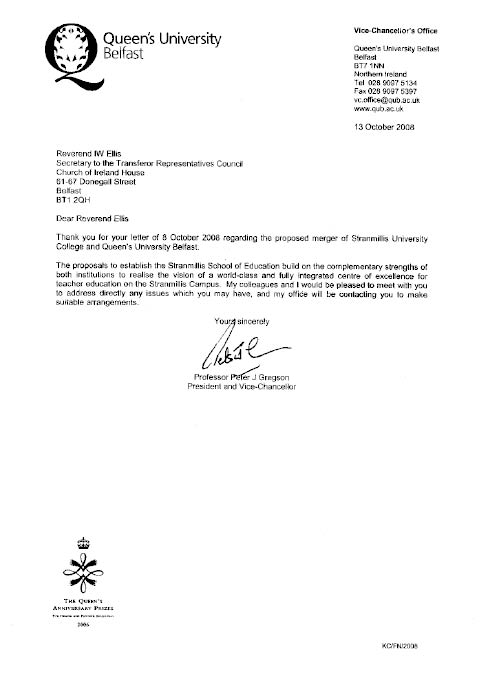
Department of Education
26 November 2008
Paper for Employment & Learning Committee on Setting of Annual Intakes for Initial Teacher Education
Introduction
1. The role of the Department of Education (DE) in relation to teacher education is twofold. Firstly, DE determines student intakes to Initial Teacher Education (ITE), and secondly, it ensures that the quality of provision and the associated curriculum are fit for purpose and based on DE’s policy imperatives.
2. The Department of Education determines the annual intakes to ITE under Article 67(1) of the Education and Libraries (NI) Order 1986, as amended, which states:
“The Department shall make such arrangements as it considers expedient for the determination of the numbers to be admitted to the initial and further training of teachers”
3. As part of the process of determining intakes to ITE, Statistics and Research Branch within the Department undertake, on an annual basis, the Teacher Demand Model (TDM) exercise (see paragraphs 4 to 7 below). The information from the TDM exercise is then passed to Teacher Education Branch. The out-workings from the TDM together with a range of other policy based considerations and other information sources are then used to inform the final annual intakes to ITE (these considerations are discussed in paragraphs 8 to 11 below). The Minister for Education, Caitríona Ruane, determines the intakes to ITE. The Department for Employment and Learning is responsible for funding ITE.
Teacher Demand Model
4. The Teacher Demand Model is a statistical model which provides both a projection of teacher vacancies arising in primary and secondary schools in future years and the potential consequent requirements for intakes into teacher training needed to satisfy this projected demand. The model takes account of projected pupil enrolments in the various sectors, likely teacher wastage rates, pupil-teacher ratios (PTRs) and potential wastage rates from teacher training courses (both in-course and end-course wastages). Primary and secondary sectors are modelled separately throughout the exercise. The pupil population figures used in the model reflect the latest available population projections supplied by the Northern Ireland Statistics and Research Agency (NISRA). Adjustments are made to take account of teachers re-entering the workforce, possible inward migration from Britain and the number of students already enrolled on ITE courses.
5. Much of the data used in the model is estimated and a number of assumptions are made in order to arrive at projected vacancies and consequent intake figures. Every effort is taken to ensure that these estimates and assumptions are as reliable as possible. The model itself does not determine intakes to ITE but informs decisions on the level of intakes. Such decisions must additionally take into account policy considerations and other relevant statistical information that is not taken account of in the statistical modelling exercise.
6. The model was first used in 1985 and has been subject to a number of revisions and refinements over the years designed to improve its predictions. The Model was last reviewed in May 2004 by Human Resource Consultancy Services (HRCS), a branch of NISRA. Overall, the Model was deemed to be internally consistent in its operation and the outputs were found to be robust. The review highlighted a number of minor issues to be considered for amendment and most of these have been incorporated into the current model.
7. The TDM is currently being reviewed again by the Department’s Statistics Branch and key elements of the scope of the review are attached at Annex 1.
Annual Intakes
8. Following receipt of the outworkings of the TDM and prior to the setting of the annual intakes, consideration is given to the impact of current and future policy proposals; and also to a range of other statistical information available to the Department but not taken into account in the TDM statistical modelling exercise. The final step in the process is consideration of the proposed intakes and final approval by Caitríona Ruane.
9. The policy considerations that need to be taken into account vary from year to year, as does the statistical information available to the Department. For example, in 2008/09, current and future policy proposals and additional statistical data available in February 2008 considered included:
- the Age Composition of the Teaching Profession - Of the 26,985 teachers registered with GTCNI some 19% (or 5,099) are under age 30; and, just over 17% (or 4,630) are 55 years of age or over. Information provided by the teacher’s payroll system showed that a three year average of those leaving the profession, for whatever reason, is around 1,000 per annum. However, it was anticipated that the change in rules, from 1 April 2008, with regard to Premature Retirement would result in more teachers aged 50 and over remaining in employment.
- Northern Ireland Substitute Teacher Register (NISTR) data - Of the 6,777 teachers on the NISTR list last year 32% were under age 30; and, 32% were over 55 years of age or over.
- Teacher Vacancy Return - An analysis of the data received for the 2007/08 academic year for classroom teachers showed that:
- the number of full-time permanent posts, full-time temporary posts of one year or more in duration, and full-time temporary posts of two-terms or more already filled were 461, 254 and 40 respectively. Of these posts only 85, 59 and 16 respectively had been filled by NQTs;
- the number of full-time permanent posts, full-time temporary posts of one year or more in duration, and full-time temporary posts of two-terms or more still to be filled were 81, 20 and 10 respectively. Of these posts 54, 14 and 3 were available to be filled by NQTs;
- the number of part-time permanent posts, part-time temporary posts of one year or more in duration, and part-time temporary posts of two-terms or more already filled were 41, 99 and 22 respectively. Of these posts 3, 19 and 5 respectively have been filled by NQTs; and,
- the number of part-time permanent posts, part-time temporary posts of one year or more in duration, and part-time temporary posts of two-terms or more still to be filled were 16, 12 and 8 respectively. Of these posts 10, 5 and 8 were available to be filled by NQTs.
- Department of Enterprise Trade and Investment (DETI) data - figures for December 2007 obtained from DETI showed that 220 job seeker allowance claimants specified teaching as their profession and 43 of these claimants were under the age of 30.
- Funding for Principal Release Time - additional resources were made available to provide principals who teach to be released from teaching duties for an additional day.
- Sector Shortages and Post-Primary subject considerations - the needs of the growing Irish-medium education sector were considered as was the shortage, in society, of those suitably qualified in science, technology and mathematics.
10. The following table provides a summary of the overall outworkings of the TDM and the approved intakes across the period 2004/05 to 2008/09
Academic Year |
Overall TDM Figures |
Overall Approved ITE Intakes |
|---|---|---|
2004/2005 |
926 |
880 |
2005/2006 |
984 |
846 |
2006/2007 |
984 |
786 |
2007/2008 |
799 |
699 |
2008/2009 |
594 |
643 |
11. You will note that the final approved intakes have, across the period 2004/05 to 2007/08, been lower than the figures produced by the TDM model. These reductions reflect the policy-based considerations and other information which was taken into account in each year when setting the overall approved ITE intakes. A key consideration in these reductions was the information on the growing number of young newly qualified teachers who were unable to obtain a permanent teaching post in the first year following graduation, together with other evidence of over-supply, for example:
- the Chief Inspector’s Report 2002-2004 drew attention to the significant number of beginning teachers on short-term contracts, working part-time as substitute teachers, or not in employment;
- the creation of the new NISTR also provided additional information on the number of young teachers seeking employment. As set out in paragraph 8 above of the 6,777 teachers on the NISTR list last year 32% were under age 30.
- information provided by the General Teaching Council for Northern Ireland (GTCNI) in 2007 on the number of graduates registered by them in permanent employment or temporary employment of a significant nature indicated that just over 27% of students who graduated in 2006 were so employed.
Annex 1
Review of the Teacher Demand Model
Scope of the Review
The key elements of the review are as follows:
- a thorough review of the base data going into the model;
- a sensitivity analysis of the susceptibility of the model to changes in the various estimates contained within it; and,
- an overall assessment of the effectiveness of the model from a statistical perspective.
Each of these aspects is discussed in more detail below.
Review of base data going into the model
It was beyond the scope of the previous review undertaken by HRCS to include an analysis of the base data going into the model, such as the stock numbers, the leaver numbers, the new entrant numbers and the pupil numbers. The aim is to systematically review the data to ensure that the model is using the best possible estimates available.
The previous HRCS review recommended that the Department should evaluate the trends in non-Full Time working to assess if this should be built into the model, and if so, to determine the best way of converting the model to a Full Time equivalent basis. It is intended that this issue be taken forward under the review.
A number of other data issues have also been identified as requiring particular attention:
- the data and methodology used to produce estimates of the proportion of teachers re-entering the workforce;
- the data and methodology used to produce estimates of the rate of inward migration into the teaching profession in the north of Ireland and how this is used in the model; and,
- an analysis of the DETI unemployed teacher database will be taken forward as part of the review (revised DETI data on unemployed teachers is being used to inform final intake numbers but not used in the model itself).
Sensitivity Analysis
The review will include a sensitivity analysis of the susceptibility of the model to changes in a number of variables (For example: pupil:teacher ratios (PTRs); Re-entrant rates; Wastage rates; and, Inward migration rates).
Assessment of the effectiveness of the model
The previous HRCS review compared the Department’s model (deterministic method) with a model using an alternative mathematical approach (stochastic simulation techniques), and found consistency in the model outputs. This review will mainly examine the complexity of the model and the relationships between the variables used within the model.
Appendix 4
Research Papers
Research and Library Services
_fmt.jpeg)
26th August 2008
A case study of the
Moray House School of
Education integration into
the University of Edinburgh
Research Paper for Employment & Learning Committee
Yan Liu
This research paper provides a brief review of teacher education in Northern Ireland and a general overview of the Teaching Colleges in the Republic of Ireland. A case study of the Moray House School of Education integration into the University of Edinburgh is also presented as an example of good practice.
Library Research Papers are compiled for the benefit of Members of The Assembly and their personal staff. Authors are available to discuss the contents of these papers with Members and their staff but cannot advise members of the general public.
Introduction
The information outlined in this research paper concerns best practice for Teacher Education Institutions in Northern Ireland. It includes the following:
- Review of teacher education in Northern Ireland
- Overview the Teaching Colleges in Republic of Ireland
- Case study on The Moray House School of Education integration into The University of Edinburgh
Review of Teacher Education in Northern Ireland
A review of teacher education in Northern Ireland has been underway since 2003. As key to the review, the areas of the cost of training new teachers, the use made of the initial teacher education estate and the effects on initial teacher education of the diversification of courses were identified for further study by the Department for Employment and Learning (DEL) and Department of Education (DE).
The Taylor Report (2004)
A study was carried out by David Taylor and Rod Usher as independent consultants to DEL in 2004. The “Aspects of initial teacher education in Northern Ireland” [1] report (The Taylor Report) was set out under the four interlinked strands of Diversification, Demography, Cost and Use of Estate. It analysed the issues raised by the evidence made available through field visits, documents from the providers of Initial Teacher Education (ITE) in Northern Ireland and the range of other sources consulted, including Government Departments and agencies. The report then offered a series of options for the consideration of those responsible for managing and providing ITE.
The findings of the Taylor Report in relation to the four strands may be summarised as follows:
- Diversification: The Colleges have done what they were encouraged by government to do; it has brought clear benefits in reducing costs and developing the institutions into places which are no longer monotechnics and have acquired a more diverse population.
- Demography and Teacher Supply: Numbers of pupils will fall significantly over the period, as indeed they are already falling. As a consequence the numbers of teachers will need to fall, and the throughput of new teachers from ITE cannot be immune. The report also points out that in a sense Northern Ireland is a victim of its own success. Because its teachers are so highly qualified and well motivated the province does not experience the high drop-out rate from the profession commonly experienced elsewhere in the UK.
- Cost: Cost data remain extremely hard to interpret and even to establish in a consistent manner. Some of the questions posed by DEL are extremely difficult to answer with any precision or certainty of comparability. Benchmarked financial data alone do not give a particularly strong steer to policy.
- The Use of the Estate: much constructive thought has been given to ways of sharing premises and resources more widely, but there is undoubtedly more that can be done, with a mixture of imagination and good will.
In taking forward the analysis of provision offered in the Taylor report, it was suggested that strategic options might be classified into four categories of response, as follows:
1. Do nothing
2. Small-scale change, building on existing partnerships
3. A more developed planning and implementation structure for all ITE
4. A fully integrated or federated structure, with overarching responsibility
for all of the providers offering ITE
The Douglas Osler report (2005)
The “Policy Review of Teacher Education in Northern Ireland” report was carried out by Douglas Osler, former Chief Inspector of Schools in Scotland in 2005. It was commissioned by both DE and DEL to review the studies and other relevant documentation, including Information and Communication Technology in the context of the Review of Public Administration. His brief was to identify common treads, themes, gaps, areas for development and take an informed outsider’s view of the system and bring forward recommendations to the two Departments from which they could develop policy propositions. The main recommendations from the Douglas Osler report are [2] :
1. The Career Entry Profile, appropriately re-named, should be used as a career-long record, perhaps called the Teacher Career Profile.
2. In order to ensure that schools and new teachers receive the professional support needed, the contributions of Higher Education Institution (HEI) staff, other teachers, Education and Library Boards and others should be coordinated more effectively.
3. In order to convince ITE institutions, the profession and other stakeholders of the need for change, an analysis of expected demographic changes should be undertaken. This should include an improved model for predicting teacher shortage in particular specialisms.
4. Provision of ITE in 4 centres (excluding the Open University) should be reviewed. Alternatives should be accompanied by a full risk assessment.
5. This report’s preferred recommendation that the role of existing ITE institutions be extended should be examined. Existing and future staff of ITEs should be contracted to undertake parallel teaching experience, and some initial training and Continuing Professional Development (CPD) should be delivered by selected serving teachers.
6. All entrants to ITE should have evidence of ICT skills to an agreed level or should acquire these within one term.
7. The teaching of modern languages in primary schools should be treated in ITE as a specialist choice.
8. The curricular area covered by Citizenship should be an additional qualifying course.
9. Consideration should be given to joint primary/secondary training of teachers and to stage-specific qualifications for primary teachers.
10. The move to greater discretion for teachers in the assessment of pupils’ learning will require specific pre- and in-service training.
11. Prospective teachers taking the one-year Postgraduate Certificate in Education (PGCE) may be less well prepared due to the duration of their course. This should be corrected by an extension of 4 weeks to the ITE course and should influence their induction.
12. The Induction year should be seen as an extension of ITE.
13. General Teaching Council for Northern Ireland (GTCNI) should be responsible for recording the training taken by teachers including ensuring completion of induction.
14. A promoted postholder in schools should be responsible for all aspects of teacher training from Induction to CPD.
15. The GTCNI competence model should be the basis for all aspects of teacher training. The model should be updated regularly and be the foundation of the renamed Career Entry Profile.
16. The role of the teacher-tutor should be further developed.
17. The GTCNI report offers a means of coordinating provision for all stages of teacher education in Northern Ireland and should be adopted and its role enhanced in relation to the new single employing authority.
18. The contribution of employers to teacher training should be encouraged.
Overview of Teaching Colleges in the Republic Of Ireland
There are seven Colleges of Education located throughout Ireland [3] . Two of these Colleges offer degree courses leading to a qualification as teachers of specialised subjects at secondary school level: Mater Dei Institute of Education and St. Angela’s College of Education. The five remaining Colleges of Education provide approved degree courses which lead to qualification as a primary teacher: The Church of Ireland College of Education, Froebel College of Education, Mary Immaculate College of Education, St. Patrick’s College of Education and Coláiste Mhuire, Marino [4] . These five primary teacher training colleges are privately managed but largely funded by the State.
The Education Departments in the universities each offer a one-year postgraduate diploma course in education. The award - Higher Diploma in Education - is recognised as a teaching qualification at second-level.
Mater Dei Institute of Education
Mater Dei Institute of Education was established in 1966 as a third-level Catholic College of Education specialising in the academic and professional formation of teachers, especially in the area of Religious Education. The Institute located in Dublin. In 1999, the institute became a College of Dublin City University and runs undergraduate and postgraduate courses in a range of disciplines whilst keeping a focus on the theme of its strategic plan - “teaching and learning in a changing Ireland”.
St Angela’s College
St. Angela’s College was founded as a Training College for Teachers for Home Economics. Under a formal Agreement between the College and the National University of Ireland (NUI) on 1st January 2006, St Angela’s College, Sligo became a college of NUI Galway. This was the first occasion on which an independent educational institution has become a College of a Constituent University of the NUI [5] .
The Agreement, which is aimed at expanding the provision of University education and research in the North-West, will ensure a much closer strategic and working relationship between the College and the University, while ensuring an appropriate degree of autonomy for the College and preserving its independent and separate legal status and its traditional ethos.
Today St Angela’s College provides a range of academic programmes in Education, Food, Textiles, Fashion and Design, Nursing and Economic and Social Studies. Students of St Angela’s College are also registered as students of NUI Galway, and their degrees and other qualifications are awarded by NUI Galway.
The Church of Ireland College of Education
The Church of Ireland College of Education was founded in 1811 as a primary teacher training college (the original name was The Kildare Place Training Institution) by the Society for Promoting Education of the Poor in Ireland. In the 1850’s The Kildare Place Training Institution was taken over by the Church Education Society for the purpose of training Anglican teachers for church schools. This College was taken over in 1878 by the General Synod of the Church of Ireland and six years later became a recognised denominational college with the Archbishop of Dublin as ex-officio manager and Chairman of the Board of Governors. In the 1970’s a Bachelor of Education degree was introduced and since then has been taught jointly by Trinity College, University of Dublin [6] .
The Main function for The Church of Ireland College of Education is to provide a supply of teachers for primary schools under the management of the Church of Ireland and other Protestant denominations. Today the College offers three main courses: a Postgraduate Diploma in Learning Support, Special Educational Needs for qualified teachers and a Certificate for Special Needs Assistants. All the qualifications are validated and awarded by Trinity College, University of Dublin.
Froebel College of Education [7]
Froebel College of Education takes its name from the 19th century German educator, and founder of Kindergarten, Friedrich Froebel (1782 - 1852). It was established by the Dominican Congregation and associated with progressive child-centred education. It seeks to foster quality teaching and learning, creativity, integration and sound practical classroom management in whatever situations teachers work with children.
Mary Immaculate College
Mary Immaculate College is an autonomous third level College, linked academically to the University of Limerick which offers undergraduate and postgraduate degrees in Education, Education and Psychology, the Arts and Early Childhood Care and Education.
The College was established in 1898 by Bishop O’Dwyer and the Sisters of Mercy for the professional education of Catholic primary school teachers. The College promotes a sense of identity enriched by an awareness of its Catholic tradition, the cultures, languages and traditions of Ireland, and its special commitment to the Irish language.
St Patrick’s College of Education
St Patrick’s College was established in 1875 to meet the teacher training needs of a denominational primary school system. Bachelor of Education Degree for teachers was introduced in 1974 and the College became a recognised College of the NUI. In 1993, under an agreement for Institutional Linkage, St Patrick’s College became a College of Dublin City University. This was followed by the inauguration of an Academic Council.
The Marino Institute of Education
Coláiste Mhuire is primarily focused on providing pre-service primary education and run by the Congregation of Christian Brothers. Most Courses in The Marino Institute of Education are provided in association with the Church of Ireland College of Education, the Froebel College and Trinity College. Degrees and diplomas are awarded by Trinity College.
Irish Teacher Training System
The Irish teacher training system differs between primary and second level school teachers. Second level teachers usually complete a primary degree at University and then follow up with a Higher Diploma in education at the University as well. Primary school teachers complete a three-year program, leading to a Bachelor of Education Degree (BEd) at a teacher training college. One criterion for primary school teacher training in Ireland is proficiency in Irish [8] .
Demography and Teacher Supply in Ireland
Resent statistics from the Department of Education and Science shows the numbers of pupils at first level education (including Special Schools) has been increasing steadily (Table 1 below) as well as Teachers at first level education (Table 2). On January 2008, the Minister for Education and Science Mary Hanafin announced an extra 210 post graduate teacher training places available in 2008. This brings the total number of post graduate students in the four colleges who are studying to become primary teachers to 490. “The Programme for Government contains a commitment to provide 4,000 extra primary teachers between 2007 and 2012 [9] ”.
Table 1: Number of Pupils at First and Second Levels of Education by Year [10]
|
Pupils at First Level Education~ |
Pupils at Second Level Education (Number) |
|---|---|---|
2000 |
444,310.0 |
353,860.0 |
2001 |
439,560.0 |
345,384.0 |
2002 |
441,065.0 |
340,078.0 |
2003 |
443,720.0 |
339,231.0 |
2004 |
446,029.0 |
337,851.0 |
2005 |
449,298.0 |
335,162.0 |
2006 |
457,889.0 |
332,407.0 |
Table 2: Number of Teachers at First and Second Levels of Education by Year [11]
|
Teachers at First Level |
Full-time Teachers at Second Level Education (Number) |
Full-time Equivalent of |
|---|---|---|---|
2000 |
21,850.0 |
21,101.0 |
2,865.0 |
2001 |
22,850.0 |
21,435.0 |
3,176.0 |
2002 |
23,935.0 |
21,519.0 |
3,668.0 |
2003 |
24,700.0 |
22,062.0 |
3,630.0 |
2004 |
26,039.0 |
21,414.0 |
3,397.0 |
2005 |
26,282.0 |
21,034.0 |
3,956.0 |
2006 |
27,515.0 |
21,411.0 |
3,976.0 |
Case Study: The Moray House Institute of Education Integration into the University Of Edinburgh
Moray House Institute of Education was founded in 1835 and merged with the University of Edinburgh in August 1998. The Institute incorporates two major national centres of excellence: the Scottish Centre for Physical Education, Movement and Leisure Studies created in 1987 and the Scottish Centre for International Education. Today, the Institute offers a wide range of pre-service and in-service courses for the professions of teaching, social work, community education and recreation and leisure.
Moray House Institute of Education has a long association with Edinburgh University. When the Normal School was first established, it was wholly separate from the University. But university graduates were superior to the products of the ‘hot house system’ of the Normal Schools. So in 1873 the Scotch Education Department agreed that Moray House students would attend Edinburgh University classes during the winter sessions. Many continued with their studies and went on to obtain a university MA or BSc.
In 1993, the Scottish Higher Education Funding Council (SHEFC) was established. This organisation was responsible for the allocation of student places for all Scottish higher education institutions, along with the associated disbursement of grants. The Funding Council indicated that it would support closer institutional links and mergers where appropriate [12] . Whilst the Moray House and Heriot Watt linkage was the first of its type in Scotland, the first full merger between a former college of education and a university was that between Jordanhill College and Strathclyde University, both in Glasgow. These moves were the beginning of the major consolidation to follow in Scottish higher education [13] .
The increasing difficulties over the relationship between Moray House and Heriot Watt University came to a head in 1995 and as a consequence an informal approach was made to the University of Edinburgh about the possibility of an institutional merger. Professor Sir Stewart Sutherland and Professor Gordon Kirk issued a joint statement in October 1996 outlining the principles upon which subsequent discussions should be based [14] . Following extensive local and national consultations the terms of a merger were initially agreed by the two institutions and then formally by the Secretary of State. On 1st August 1998 Moray House Institute of Education became the Faculty of Education of the University of Edinburgh.
Post-merger Evaluation [15]
In 2001 the Scottish Higher Education Funding Council was required by the Minister for Enterprise and Lifelong Learning to carry out a post-merger evaluation of the merger between the University of Edinburgh and Moray House Institute of Education on behalf of the Scottish Executive. Both Institutions were required to submit a self-assessment of the merger within three months of the end of the second year of the merger. The University of Edinburgh submitted their self-assessment in November 2000 and this was considered by the Council’s Mergers Committee who also visited the University and met with senior staff and a small group of academic staff and students. The Council’s evaluations of the above merger are:
- Progress to date: From the evidence of the self-assessment document and the meetings that the Mergers Committee has held at the University, the Council considered that this was a successful merger.
- Academic issues: The University had a commitment to taking advantage of the integration of teacher education into a multi-faculty university in order to create more flexible entrance and exit points for teacher education programmes. The General Teaching Council has written approvingly of the merger saying that both staff and students have clearly benefited from the merger.
- Links with Schools: The General Teaching Council for Scotland stated that it had seen no weakening in links with schools. However, the University recognised that the University’s staff terms and conditions were less attractive to practising teachers than those that had existed in Moray House which had been far closer to teachers’ conditions of service. The Mergers Committee heard concerns from staff that the increased salaries for teachers as part of the McCrone settlement may further exacerbate this issue.
- Supply of teachers of Physical Education: The merger had been very positive as shown by the growth in the number of Physical Education academic staff. Before the merger there were 24 teaching staff and 5 research staff; after the merger there were 32 teaching staff and 11 research staff. The student intake had grown from 60 per annum to 100.
- Estates: The merger was underpinned, in financial and physical terms, by the sale of both Newington and Cramond campuses of Moray House and the re-investment of part of the proceeds in the University’s city centre campuses. Following the merger approval the Council’s Estates Branch undertook ongoing monitoring of developments in relation to estate issues. At its meeting on 8 September 2000 the Council restated that it would reserve its right to consider its position regarding the sales proceeds of the Exchequer-funded assets involved in the merger, once these are known.
- Staffing issues: From figures supplied in the self-assessment it appeared that over one third of the academic staff who formerly worked at Moray House have opted to retain their Moray House terms and conditions, largely, it seems, because of the greater holiday entitlement.
Conclusion
From the evidence in the post-merger evaluation report, the Council considered the merger between the University of Edinburgh and the Moray House Institute of Education has brought academic benefits and achieved the agreed broad objectives of the merger. They concluded that was a successful merger.
[ 1 ] Department for Employment and Learning, “Aspects of Initial Teacher Education in Northern Ireland”, David Taylor and Rod Usher, November 2004.
http://www.delni.gov.uk/study_of_teacher_education_in_northern_ireland_final-2.pdf
[ 2 ] Department for Employment and Learning, “Policy Review of Teacher Education in Northern Ireland” Douglas Osler, 2005
http://www.deni.gov.uk/teacher_education_review_-_context_and_underpinning_principles_paper.pdf
[ 3 ] St.Catherine’s College of Education for Home Economics was closed in September 2007. http://www.stcatherinespsu.com/index.htm
[ 4 ] Higher Education Authority in the Republic of Ireland, General Description of the Structure of Higher Education. http://extranet.hea.ie/index.cfm/page/sub/id/497
[ 5 ] St Angela’s College, Sligo http://www.stangelas.com/primary_links/news_detail.php?id=96
[ 6 ] The Church of Ireland College of Education http://www.cice.ie/
[ 7 ] http://www.froebel.ie/
[ 8 ] World Education Encyclopaedia, a survey of educational systems worldwide second edition. Volume 2 I-R, Rebecca Marlow-Ferguson, Editor.
[ 9 ] Department of Education and Science, Press Release “31 January, 2008 - Major increase in places for post graduate training as primary teachers for 2008 -’Number of men now applying for primary school teaching on the increase’ - Minister Hanafin” http://www.education.ie/home/home.jsp?maincat=&pcategory=10861&ecategory=10876§ionpage=12251&language=EN&link=link001&page=1&doc=39365
[ 10 ] Department of Education and Science http://www.cso.ie/px/des/Dialog/Saveshow.asp
[ 11 ] Based on data collected by the Department of Education and Science on the last school day of September http://www.cso.ie/px/des/Dialog/Saveshow.asp
[ 12 ] A History of Professional Training at Moray House, Part 9: Moray House and the Universities
http://www.education.ed.ac.uk/aboutus/morayhouse/history/Part9/index.html
[ 13 ] Scottish Higher Education Funding Council, Eighty-fourth meeting May 2001.
[ 14 ] A History of Professional Training at Moray House, Part 9: Moray House and the Universities
http://www.education.ed.ac.uk/aboutus/morayhouse/history/Part9/index.html
[ 15 ] Scottish Higher Education Funding Council “Post-merger evaluation of the merger between the University of Edinburgh and Moray House Institute of Education” 5th June 2001
Appendix 5
Correspondence
Correspondence regarding the Strategic Direction of Stranmillis University College
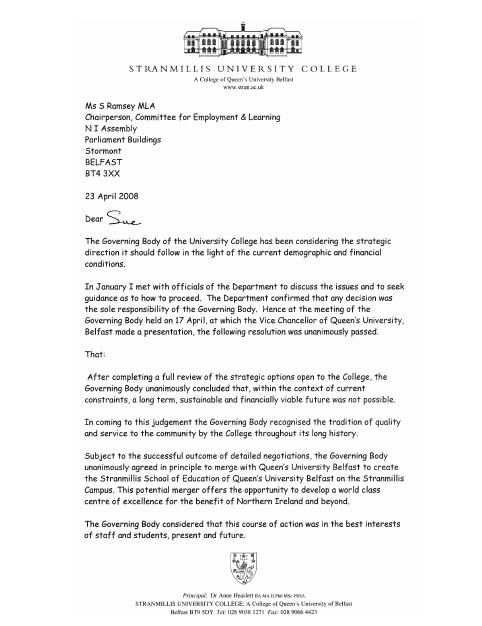
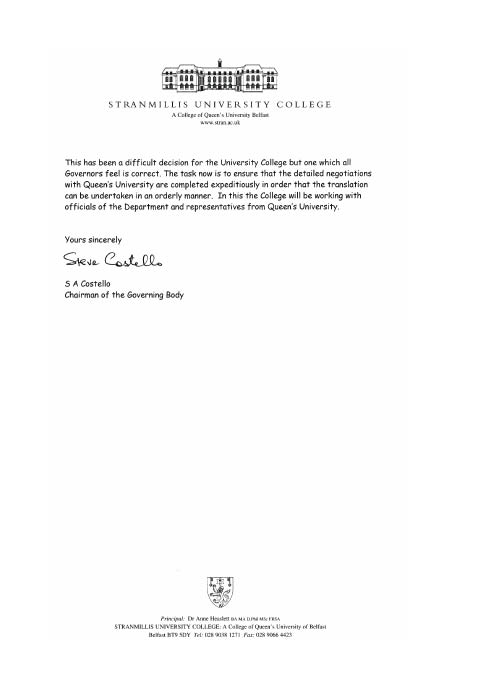
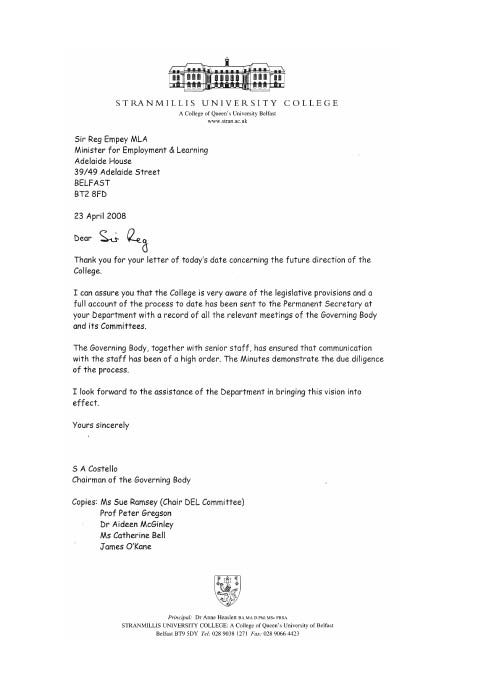
Correspondence regarding Teacher Training at St. Mary’s and Stranmillis University Colleges
Sir Reg Empey MLA
Minister for Employment and Learning
Adelaide House
39/49 Adelaide Street
Belfast
BT2 8FD
23rd April 2008
Dear Minister,
RE: Teacher Training at St. Mary’s and Stranmillis University Colleges
Following on from your briefing to the Committee on the 12th March on potential changes to teacher training provision, you will be aware that the Committee took evidence from both St. Mary’s and Stranmillis University Colleges at its meeting on the 16th April.
The purpose of this correspondence is to provide you with some initial views and opinions from Members of the Committee. Members have expressed a number of concerns at this early stage. Given the importance of this issue and the high level of early concern, it is my intention to prioritise this issue within the Committee’s work programme going forward.
Of overriding concern, all Members of the Committee have expressed significant unease that the current position was at a more advanced stage than had been indicated on the 12th March. In particular, Stranmillis College’s liaison and negotiation with Queen’s University was a total surprise to Members. The Committee’s understanding was clear. The understanding was that the Department’s only definite policy proposal related to the introduction of a revised funding model. The Committee understood that the process leading on from the revised model would include a range of options being considered. Clearly, the merger option has either been the sole model being considered, or, at least, has had significant primacy much earlier in the process than was indicated. It is fair to say that Members are extremely angry that due process has not been followed and that the role of a Statutory Committee of the Assembly has been seriously undermined.
The following specific points were made by Members during the evidence sessions.
- While accepting that there may be issues of confidentiality and sensitivity, concern was raised that there may not have been substantive and meaningful consultation between management and staff with respect to the current position at Stranmillis in its dealings with Queen’s University.
- Both colleges have a key role to play in terms of community access and participation, particularly with respect to the diversified courses being offered.
- St. Mary’s University College argued that many of the economic costing statistics presented by the Department were fundamentally flawed. As you will be aware, both colleges have attained extremely high levels of quality across key higher education indicators. These include relatively high participation rates by students from socially disadvantaged backgrounds and relatively low drop-out rates. I am sure you will agree that both colleges deliver only the highest quality trained teachers and are central to our local general educational infrastructure.
- Linked to the above issue, the colleges were challenged by the Committee with respect to the perceived decline in demand for teachers. Again, issues relating to the data being used in the demand model were questioned. Whatever the accuracies or inaccuracies of demand modelling, concern was expressed that the long-term strategic nature of delivering teacher education must be recognised. Any reduction or change in the short – term could be extremely difficult and resource intensive to rectify should there be a shift in demographic trends.
- The NIAO’s 1998 report (“Department of Education NI: Provision of Initial Teacher Training”) encouraged the teacher training colleges to diversify and develop their course base in order to improve viability and value for money. This position is now being questioned and the colleges appear to be being penalised for successfully implementing an important recommendation. It is widely recognised that the diversification courses undertaken by both colleges have had highly successful outcomes.
- The issue of the unique position of the two colleges with regard to MaSN cap restriction was highlighted. This is an issue not faced by similar colleges in Britain and therefore places restrictive parameters on the colleges with respect to growth and development.
- The issue of the possible increase in demand for Irish medium teachers and early-years provision was raised as offering potential development opportunities for the colleges in the future. Similarly, increasing the workload of colleges via, for example, utilising their capacity for teachers’ Continuous Professional Development and particular specialisms such as autism should be given serious consideration.
- Concern was expressed that the impact of the new funding model proposed was leading to confusion with prospective students for the next academic year, particularly in respect of the non-teaching courses offered. While the long - term viability of the colleges is clearly the key issue, the current position is not satisfactory in allowing the colleges to plan appropriately for the short – term.
- The Committee will be following up, via the Education Committee, to assess the progress and likely time-scales relating to the Review of Teacher Education, commissioned in 2003. In particular, policy analysis relating to the Bachelor of Education versus primary degree plus Post - Graduate Certificate in Education will be an important factor in shaping future teacher education.
These points are only designed to give a flavour of the discussion with the colleges. It is important to stress that Members also challenged the colleges and stressed the need for them to work within the ‘demand – led’ strategies currently in place and within the current stringent public sector economic conditions. All Members support the need for value for money to be achieved in this sector.
I would also like to make a final point on the process issue. Following the Stranmillis presentation, the Committee understood that the proposal from Queen’s scheduled for the 17th April was designed to be the opening of discussions and negotiations. To learn on the evening of the 17th April that a deal had already been struck between the two institutions was astonishing. The Committee will be further considering this issue. I personally believe the manner in which this has been handled to be a breach of good practice in consultation and communication procedures.
This is a complex issue and I intend to commission specialist advice and further stakeholder views as this issue moves forward. In the immediate term however, I would like to formally request that you, or appropriate officials, meets with the Committee at the earliest opportunity to discuss and clarify key early issues emerging.
Yours sincerely
![]()
Sue Ramsey MLA
Chairperson

Correspondence from the Transferor Representatives’ Council
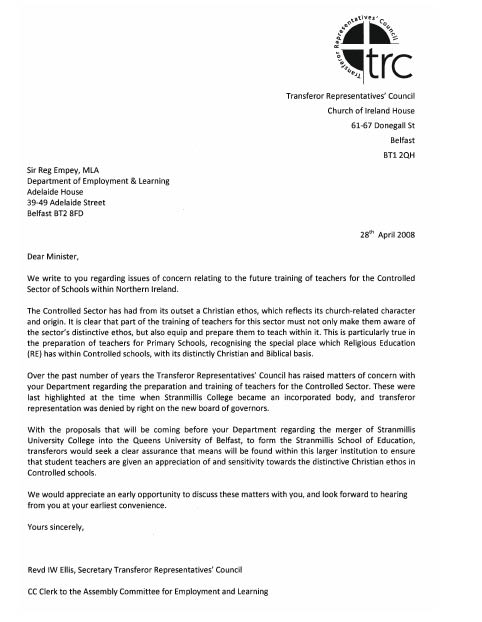

Correspondence with Department regarding Teacher Training following Committee Meeting on 7 May 2008
Sir Reg Empey MLA
Minister for Employment and Learning
Adelaide House
39/49 Adelaide Street
Belfast
BT2 8FD
16th May 2008
Dear Minister,
RE: Teacher Training
Following your appearance at the Committee on the 7th May, you will be aware that Members still have significant concerns around this topic.
When you appeared at the Committee in closed session on the 12th March, you highlighted the need for change to the teacher education funding model. You also indicated at that time that you considered the topic to be a ‘joint issue’ and one that you would welcome advice from, and partnership with, the Committee. I am sure you will agree that since that date events have worked against such a partnership arrangement. The Committee recognises that some of these events have been beyond your direct control, in particular the apparent unilateral decision taken by Stranmillis University College to merge with Queen’s University. As you know the Committee considers that the processes to date have been unsatisfactory and have worked against good consultation and procedural practice.
The Committee wishes to work with you to contribute positively to this debate. The Committee considers that the two colleges, while now facing different situations, have a range of serious issues that require airing and discussion. However, the Committee is extremely concerned that the timing is now working against appropriate scrutiny of this critical issue.
I am writing to formally ask you if you will consider creating the necessary time and space to allow for stakeholder views and opinions to be fully articulated. This could be via a delay in the introduction of the proposed new funding model or by some form of compromise or intervention that will lead to time being afforded for consideration of the issues. I look forward to discussing such a proposal with you.
I would also like to take this opportunity to request the following information and documentation to allow the Committee to be as fully informed as possible on the issues:
- The number and nature of meetings between all of the stakeholders (QUB, Stranmillis, St. Mary’s, University of Ulster and the Department) that have taken place since September 2007;
- Queen’s University’s formal proposal to Stranmillis;
- Information on any meetings that have taken place between the Strategic Investment Board, the Department, QUB and Stranmillis; and
- Appropriate briefing papers that fully describe and explain the Department’s proposed changes to the funding model.
I look forward to hearing from you.
Yours sincerely
![]()
Sue Ramsey MLA
Chairperson
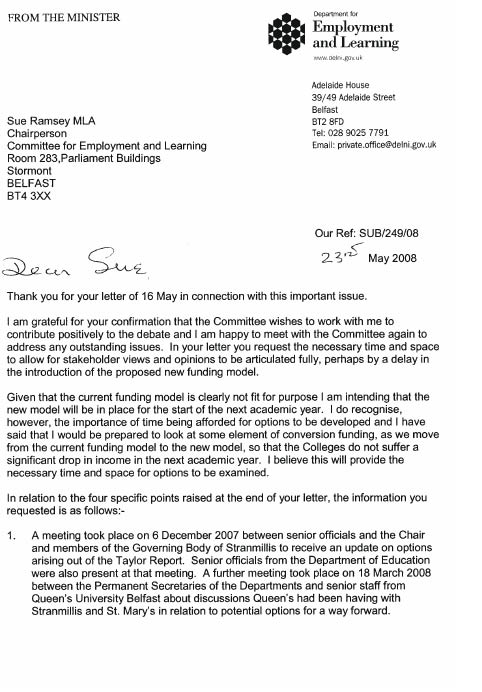
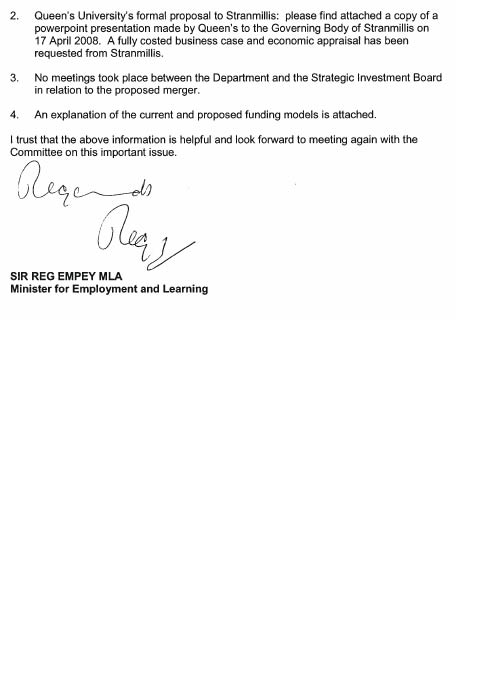



Sir Reg Empey MLA
Minister for Employment and Learning
Adelaide House
39/49 Adelaide Street
Belfast
BT2 8FD
29th May 2008
Dear Minister,
RE: Teacher Training
Thank you for your correspondence of the 23rd May on this important issue. The correspondence was considered by the Committee at its meeting on the 28th May.
Members noted that you welcome the offer of the Committee to work positively with you on this issue. The Committee also noted that you are prepared to consider some degree of ‘conversion funding’ as the Department moves to the new funding model within which time that work could be undertaken. However, given that you intend to introduce the new funding model in the next academic year, Members are unclear as to how other options can be legitimately considered. This is a key issue which I wish to discuss and clarify with you when you come to the Committee meeting on the 4th June.
At our meeting on the 28th May, on the assumption that there is appropriate time available to assess arguments and options, Members agreed to conduct a ‘stakeholder review’ with the following objective:
“To collate and consider the opinions and views of those involved in, and affected by, proposed changes to teacher education and to produce a report of recommendations to the Minister for Employment and Learning.”
The Committee’s initial approach is to call for oral and written evidence from the following stakeholders:
- Queen’s University;
- Stranmillis University College;
- St. Mary’s University College;
- University and College Union;
- University of Ulster;
- Transferor Representatives’ Council; and
- National Union of Students / Union of Students in Ireland.
The Committee will also wish to schedule a session with the Department of Education and further sessions with DEL. It is my intention to initiate this review before summer recess. Work will then continue into the new parliamentary year and I would hope to be reporting to you by the end of October 2008.
I look forward to meeting with you on the 4th June.
Yours sincerely
![]()
Sue Ramsey MLA
Chairperson
Correspondence with Department regarding Assembly Debate on Teacher Education
Sir Reg Empey MLA
Minister for Employment and Learning
Adelaide House
39/49 Adelaide Street
Belfast
BT2 8FD
13th June 2008
Dear Minister,
Teacher Education
At its meeting on the 11th June, the Committee agreed that I write to you with respect to the Committee motion on this matter. You will be aware that the Committee motion, calling on you to delay the introduction of the new funding model for the two university colleges, has now been scheduled for Assembly debate on the 23rd June 2008. This follows acceptance of the motion by the Assembly’s Business Committee at its meeting on the 10th June.
When you appeared at the Committee on the 4th of June, you stated that you would be writing to your Executive colleagues on the matter of teacher education funding. I am writing to ask if you have already submitted correspondence on this matter to the Executive. If communication has not already issued to the Executive, I am writing to ask if you would consider postponing any submission until the outcome of the debate on the 23rd June is known.
I look forward to hearing from you.
Yours sincerely
Robin Newton MLA
Deputy Chairperson
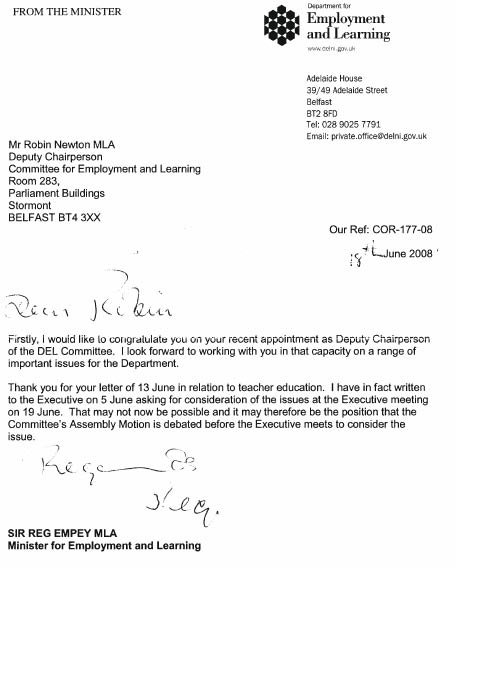
Correspondence from the Department following the Committee meeting on 4 June 2008
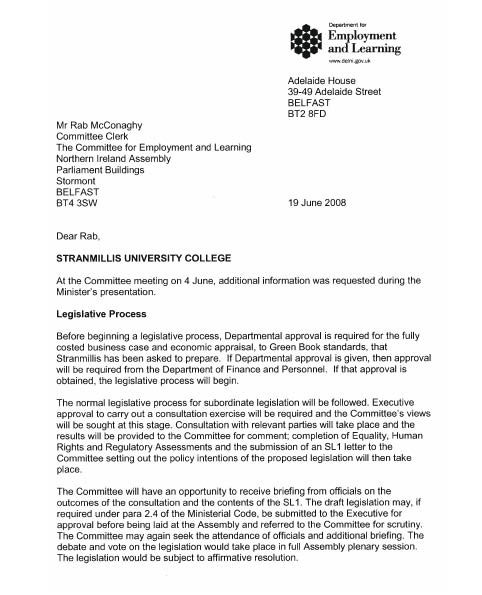
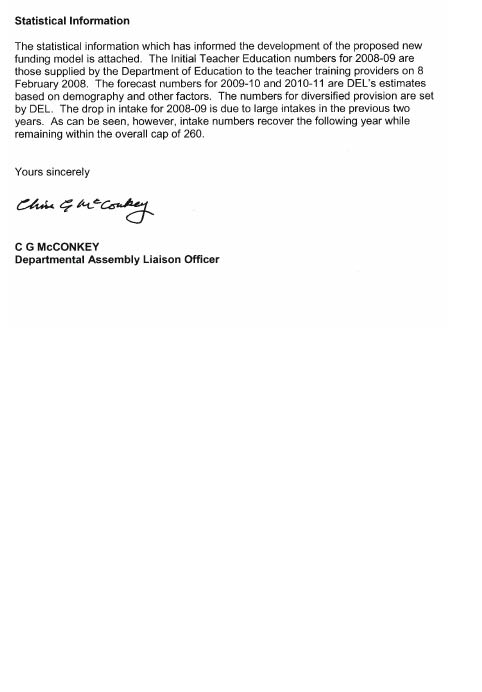
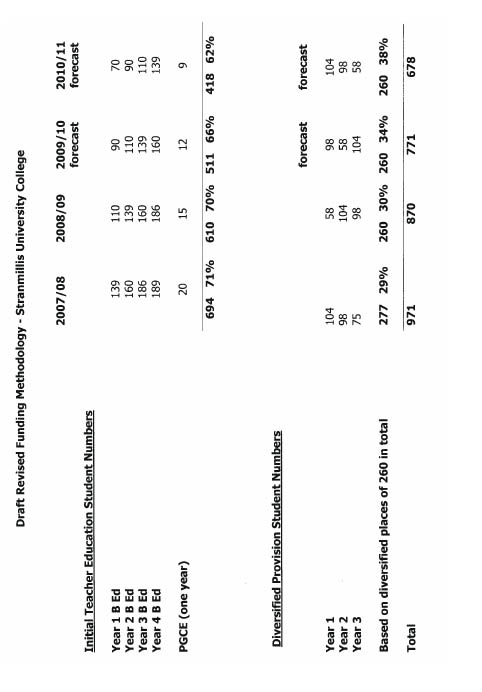
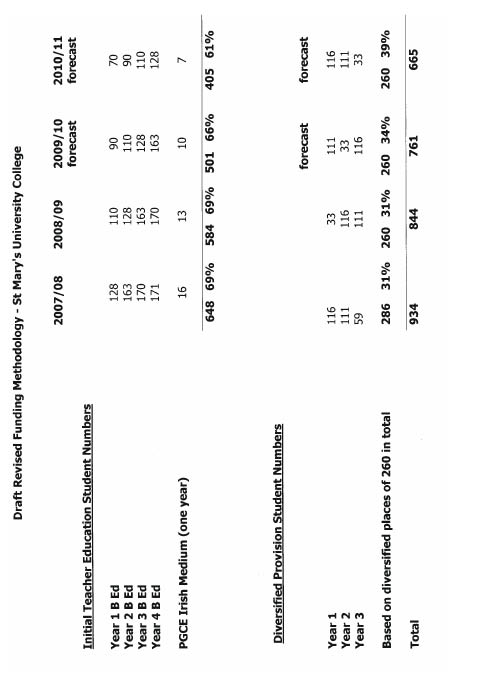
Correspondence from the Minister – 23 June 2008
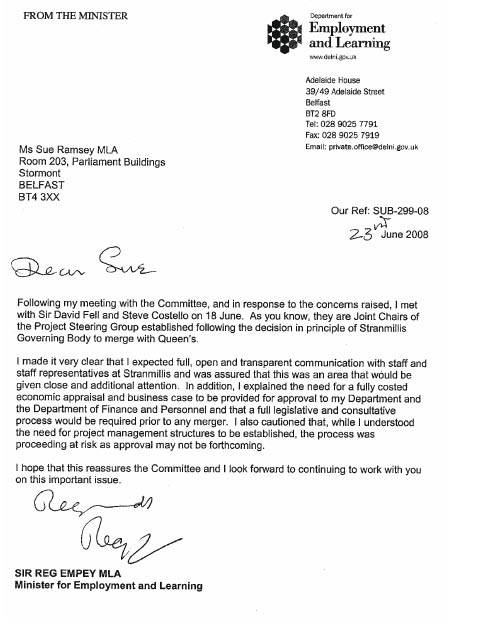
Correspondence regarding the New Funding Model for St. Mary’s and Stranmillis University Colleges
Sir Reg Empey MLA
Minister for Employment and Learning
Adelaide House
39/49 Adelaide Street
Belfast
BT2 8FD
29th September 2008
Dear Minister,
Re: New funding model for Stranmillis University College and St. Mary’s University College.
As you are aware, the Employment and Learning Committee held its meeting of 24th September at St. Mary’s University College. At the meeting the Committee heard evidence from St. Mary’s as part of our Inquiry into Teacher Education and this was followed by a tour of the College. The Committee decided that I should write to you as a form of follow-up to the Assembly debate of 23rd June on the Committee’s motion that the new funding model be delayed and also to raise some issues that the Committee became aware of through the evidence given by St. Mary’s.
I believe I am justified in saying that all the Members who participated in the debate of 23rd June found it to be very constructive, allowing me to feel that sufficient progress had been made to withdraw the motion. During the debate you generously acknowledged that because both of the Colleges will be subject to considerable change, as a result of the new funding model, that you will provide a “conversion arrangement” to allow the Colleges breathing room to adjust to the new system that would cover the academic years 2008-09 and 2009-10. You also indicated that you had had discussions with the Minister of Education with regard to the early development and continuous professional development of teachers and I will return to this later.
If I can first deal with the “conversion arrangement” that you announced for the Colleges during the debate. During their evidence to the Committee, Peter Finn (Principal) and Brain McFall (Finance Director) indicated that for the academic year 2008-09, St. Mary’s faces a shortfall of approximately £400,000, based on what the College would have received under the original funding model and what it will receive under the new model. The College confirmed that £50,000 has been received from your department, representing the conversion funding. The College has had to suppress posts and make some redundancies to further make up the shortfall. The Committee is keen to know if you regard the conversion funding in this case as sufficient and whether further conversion funding will be made available either this academic year, or next? As I said above, your offer of conversion funding made during the debate is generous, but the Committee may have believed that the level of the conversion funding would be higher. We would appreciate your view on this.
Peter and Brian stressed during their evidence that the College has had very constructive engagement with your department over the months since the new funding model was announced. The Committee heard that the College expects this dialogue to be an honest and open exchange of ideas regarding a way forward for St. Mary’s. Peter indicated at the outset of his briefing that the College feels significantly more positive than when he came before the Committee in April. The Committee is extremely supportive of the dialogue between the College and department and we hope that it continues as a two-way process.
Stranmillis University College did not comment about the conversion funding during their evidence session on 10th September, so I am not in a position to make any comment on this in relation to the College.
During the debate you indicated that you had asked the Minister of Education to consider the issues of early development and continuous professional development (CDP) for teachers and the possibility of such work being allocated to Stranmillis and St. Mary’s. The Education Minister had undertaken to look at these issues urgently. Can you tell the Committee if further discussions on these issues have taken place between you and the Education Minister and if any progress has been made? It has become clear to the Committee during our evidence sessions that taking on early development and CPD would make a significant contribution towards both Colleges being able to map out a more secure future. The Committee would encourage discussion involving all relevant parties to be carried forward urgently with regard to these issues.
Finally, during the 23rd June debate you indicated that any proposed merger between Stranmillis and the Queen’s University of Belfast, would require your approval of a business case and then be subject to legislation proceeding successfully through the Assembly. Do you consider that sufficient time remains for this process to be completed before the beginning of the 2009-10 academic year as Stranmillis and Queen’s intend? As you know, the Committee has voiced some reservations about the speed with which the two institutions propose to achieve the merger.
The Committee looks forward to your candid response.
Yours sincerely,
![]()
Sue Ramsey MLA
Chairperson
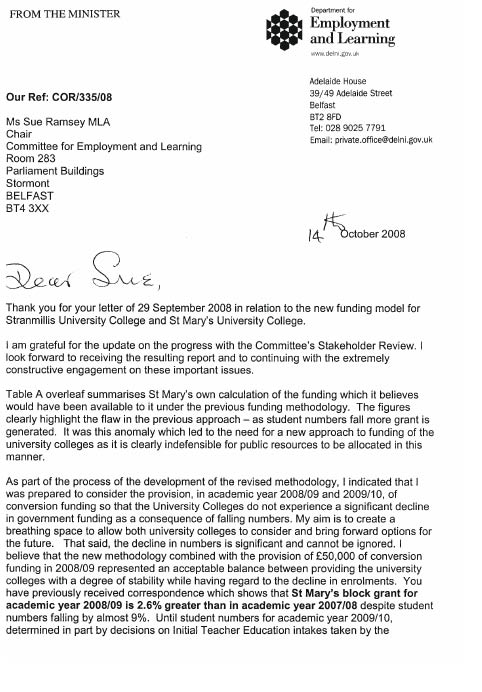
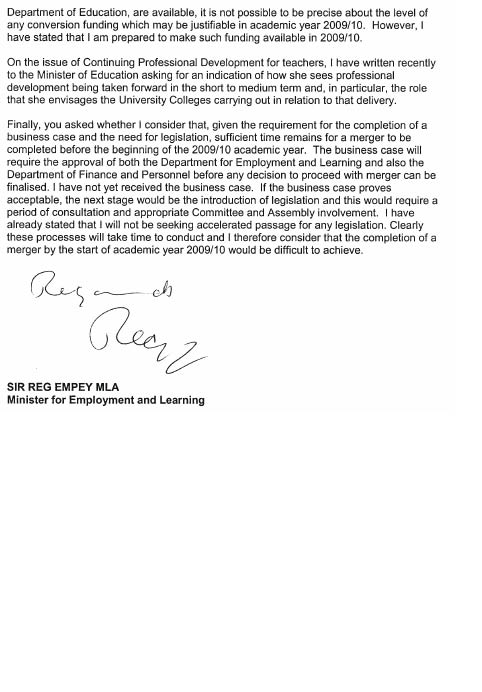

Correspondence with Queen’s University following Evidence Session with Student Unions
Professor Peter Gregson
Vice-Chancellor
ueen’s University of Belfast
University Road
Belfast
BT7 1NN
2nd October 2008
Dear Professor Gregson,
As you are aware, the Committee for Employment and Learning has heard evidence from a number of key stakeholders as part of our Inquiry into teacher education. Since we saw you and your colleagues in June, we have taken evidence from both Stranmillis and St. Mary’s University Colleges and the University of Ulster. We have also had sessions with representatives from the National Union of Students-Union of Students in Ireland and the Stranmillis Students’ Union. We will hear from the University and College Union later this month. After our sessions with the student representatives on Wednesday, the Committee agreed that I write to you to seek clarification on a number of issues that have raised concerns.
I have heard a great deal about the distinctive ethos of Stranmillis, indeed this was referred to a number of times by the Stranmillis student representatives on Wednesday. I would like to ask you about the concrete steps that Queen’s plans to take, if the merger goes ahead, to preserve the unique ethos of Stranmillis. I would be grateful if you could outline the measures that you see as necessary to ensure that Stranmillis retains more than just its name under the proposed merger.
Committee Members were very surprised to hear on Wednesday that no consultation has taken place to seek the views of Stranmillis students on the proposed merger. Are you concerned by this? If those students are consulted and reject the merger, is there a mechanism to address their concerns, or even rethink the merger?
Finally, can you indicate if you have plans for any efficiency savings at the Stranmillis campus, post-merger? I am thinking particularly of areas where services or facilities etc. are duplicated, i.e. Stranmillis has facilities which are also available at Queen’s. The Committee’s overarching concern is that the best interests of the students at Stranmillis and Queen’s should be central to any decision about the merger. I appreciate that you share that sentiment, so you will understand the Committee’s need for reassurance on the points raised above. I have also written to the Chairman of the Stranmillis Governing Body seeking clarification on these and other issues.
I look forward to receiving a response at your earliest convenience.
Yours sincerely,
![]()
Sue Ramsey MLA
Chairperson
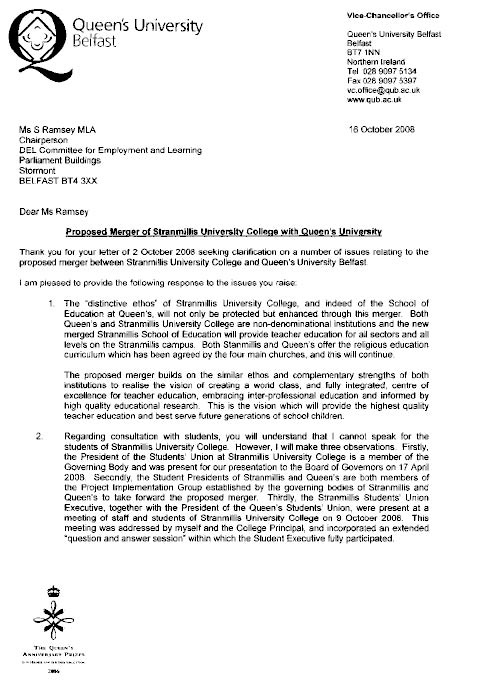
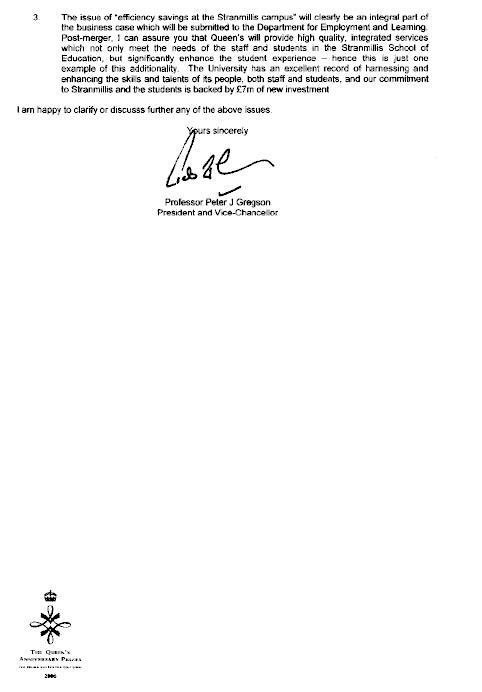
Correspondence with Stranmillis University College following Evidence Session with Student Unions
Mr Steve Costello
Chairman of the Governing Body
Stranmillis University College
Belfast
BT9 5DY
2nd October 2008
Dear Mr Costello,
Since you and your colleagues appeared before the Committee we have had further evidence sessions as our Inquiry into aspects of teacher education continues. We have now also taken evidence from St. Mary’s University College, representatives of the National Union of Students-Union of Students in Ireland and members of the Stranmillis University College Student Union Executive, including its President, Andrew Currie. These further sessions have raised new issues for the Committee and they have asked me to write to you to clarify certain matters.
Much has been said about the Stranmillis ethos and identity, indeed the student representatives from Stranmillis who gave evidence on Wednesday, referred to it a number of times and indicated the enormous value that is placed on its preservation. St. Mary’s University College representatives have cited the preservation of their distinct institutional ethos as being one of the key reasons why the College would not consider a merger with another institution. Can you elaborate further on how the particular ethos of Stranmillis, which has defined the College, will be preserved in any merger with Queen’s University? I realise this has been touched on previously, but I would like to get greater feeling for the concrete measures that will be put in place beyond the retention of the Stranmillis name.
I and fellow Members were surprised on Wednesday to learn that the student body at Stranmillis has not been consulted in any form about the merger. It was made quite clear on Wednesday, that the evidence session with the Committee was the first time that their view on the proposed merger has been formally sought. A number of the Committee Members voiced their considerable concern with regard to that situation. I advised the Student Union representatives that they should undertake a formal survey of the views of the student body at Stranmillis on the proposed merger as a matter of urgency. The fact remains that the Committee had been under the impression that the students at the College had been consulted about the merger, largely as a result of reassurances given by you and your colleagues in your evidence session with the Committee. This is a source of disquiet for the Committee and further adds to the impression that the proposed merger is hasty and has not benefited from full consultation.
As a result of this I need to ask how the College’s Governing Body will react if the student body, subject to a proper survey, rejects the merger. Would weight be given to the students’ views? Would the merger be put on hold? These are issues that must be considered as the wishes of the students must surely be at the heart of any process of change.
I would also like to clarify if the Governing Body has fully explored whether a merger with Queen’s will require Stranmillis to make efficiency savings? Have you ascertained whether or not Queen’s will seek to make savings with regard to duplication of services/assets etc.? Will services offered on the Stranmillis campus, particularly those for students and the local community/stakeholders be discontinued at Stranmillis if something similar is offered by Queen’s? Again, there appears to be a feeling amongst Stranmillis students that they will lose tailored and dedicated services if an alternative is offered by Queen’s.
You will appreciate that the Committee wants to ensure that any change embarked on by Stranmillis has the best interests of the students at its core. I am sure that you feel the same and I would be grateful if you could respond to the points above at your earliest convenience.
I will also be writing to Professor Gregson to raise some of these issues. I am also copying this letter to Dr Heaslett for her information.
Yours sincerely,
![]()
Sue Ramsey MLA
Chairperson
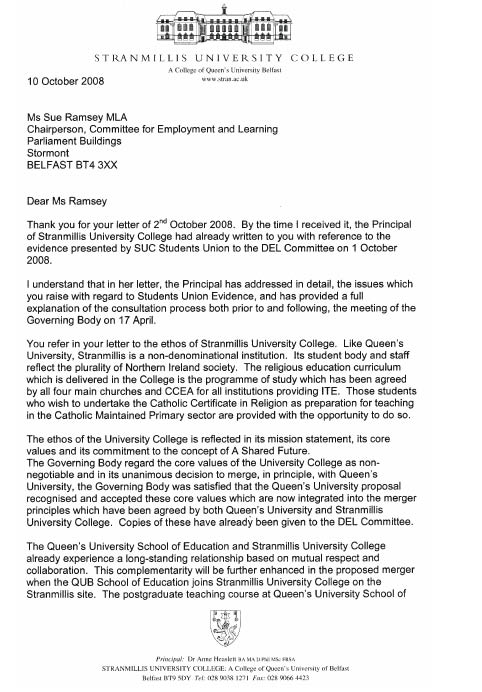
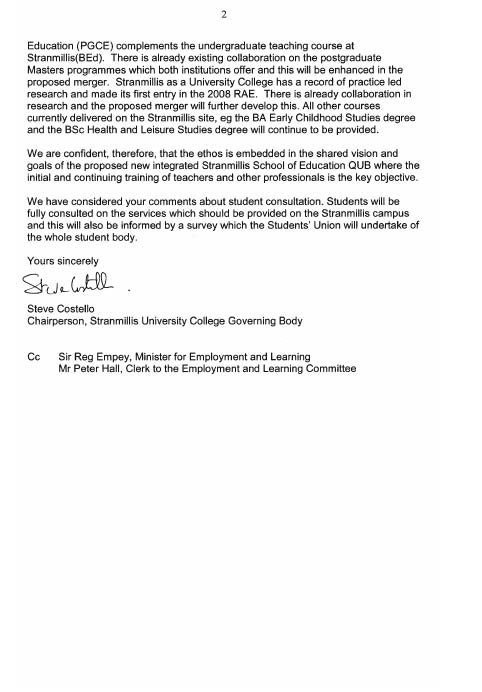
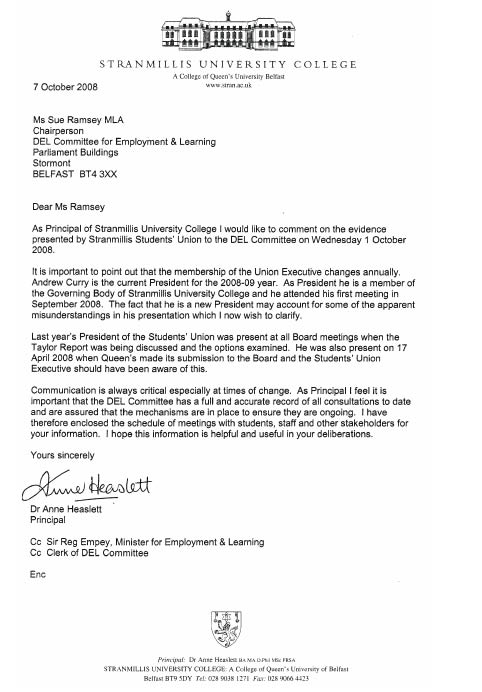





Mr Steve Costello
Chairman of the Governing Body
Stranmillis University College
Belfast
BT9 5DY
20th October 2008
Dear Mr Costello,
Thank you for your letter of 10th October and Dr Heaslett’s letter of 7th October in response to my letter of 2nd October setting out some of the Committee’s concerns about the proposed merger between Stranmillis and Queen’s.
As you will no doubt be aware, representatives of the University and College Union, Northern Ireland Public Service Alliance, Northern Ireland Committee of the Irish Congress of Trades Unions and UNITE gave evidence to the Committee with regard to our Review of teacher education on 15th October. These representatives made it clear to the Committee that they consider that there has been no meaningful consultation with them, either prior to the announcement of the proposed merger or after. They are aware of Dr Heaslett’s schedule and regard most of the meetings as information sessions, not really purposeful consultation sessions. It was also pointed out that many of the meetings were scheduled after the proposed merger had been announced and that representation on the Implementation Group misses the point that is the merger on which consultation was sought by the unions, rather than how it should be implemented.
The Committee agreed that I should write to you stressing that union representatives still do not feel that they are being engaged with and that their members are still fearful of what the proposed merger might bring. I appreciate that Dr Heaslett’s schedule of meetings was intended to indicate that discussions had taken place. However, the message that the Committee is still hearing is that the staff and student body of Stranmillis do not feel that they have been fully involved in this process. It was presented to the Committee that staff have genuine concerns surrounding their future employment and their professional status in any new School of Education. It is imperative that these concerns be addressed as soon as possible.
You will understand that the Committee is seen as an obvious forum for these concerns to be raised and it would be negligent if we did not pass them on. As has been stated previously, the Committee is not opposed to the proposed merger per se. However, we have concerns as to how the decision was arrived at and the speed at which it was arrived at. It has also been suggested to us that there are serious deficiencies with regard to the Governing Body’s engagement with staff and students.
I have written to the Minister seeking his view of the timescale for the proposed merger and he has indicated that he believes that completion of all necessary steps in the process would be difficult to achieve by the start of the 2009/10 academic year. I am copying this letter to Dr Heaslett, the Minister and also to Professor Gregson for their information.
Yours sincerely,
![]()
Sue Ramsey MLA
Chairperson
Cc: Sir Reg Empey, Minister for Employment and Learning
Dr Anne Heazlett, Principal of Stranmillis University College
Professor Peter Gregson, Vice-Chancellor, The Queen’s University of Belfast
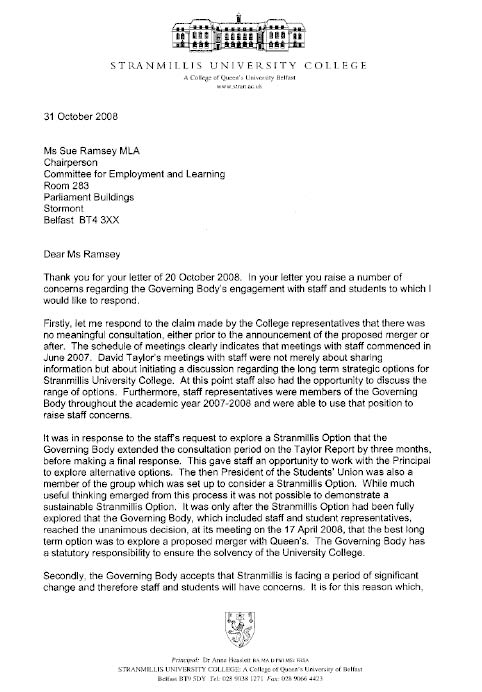
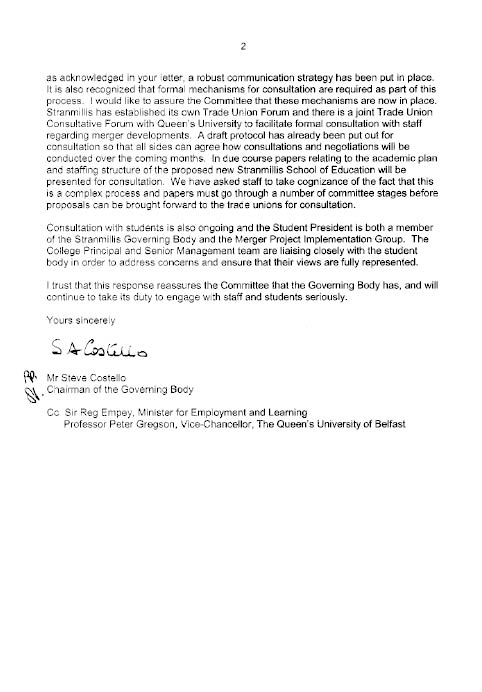
Correspondence regarding the University of Ulster’s Links with Stranmillis University College
Professor Richard Barnett
Vice-Chancellor
Vice-Chancellor’s Office
University of Ulster
Cromore Road
Coleraine
BT52 1SA
2nd October 2008
Dear Professor Barnett,
As you know we have received evidence from a number of key stakeholders in the last number of months with regard to the Committee’s Inquiry into teacher education. Representatives from Stranmillis University College gave evidence to the Committee the week after your appearance. The Committee asked about the options that the College had considered prior to deciding that the merger with Queen’s University was the best way forward. As we were already aware, one of those options was the development of closer links with the University of Ulster. Stranmillis indicated that they considered this option and, while they felt there were issues to sort out with you, they suggested that the option was still a live one as far as they were concerned when they asked you to present a proposal to them in April of this year.
During your evidence session with the Committee, you gave the impression that discussion between the University of Ulster and Stranmillis about possible closer links had become irrelevant long before April 2008. Stranmillis indicated that you declined to make a proposal to the College when asked to do so in April. The feeling that the Committee was left with was that you had become aware of something that made you feel that Stranmillis was no longer serious about exploring links with your university.
Throughout our Inquiry, the Committee has gained the impression that we have not been made aware of the full timeline of events and the Committee has agreed that I should write to you to ask for any further clarification you might be in a position to offer of the University of Ulster’s withdrawal from discussions with Stranmillis.
I would be grateful if you could share your reasons in more detail as to why you felt that it was no longer useful for the University of Ulster to continue to discuss potentially deeper links with Stranmillis. The College has indicated that right until April, when they received the Queen’s University proposal, they regarded closer links with the University of Ulster as a viable option.
I look forward to your response.
Yours sincerely,
![]()
Sue Ramsey MLA
Chairperson


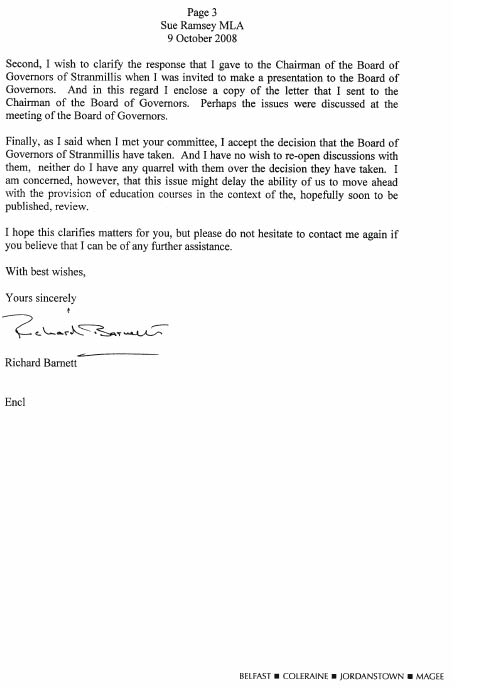

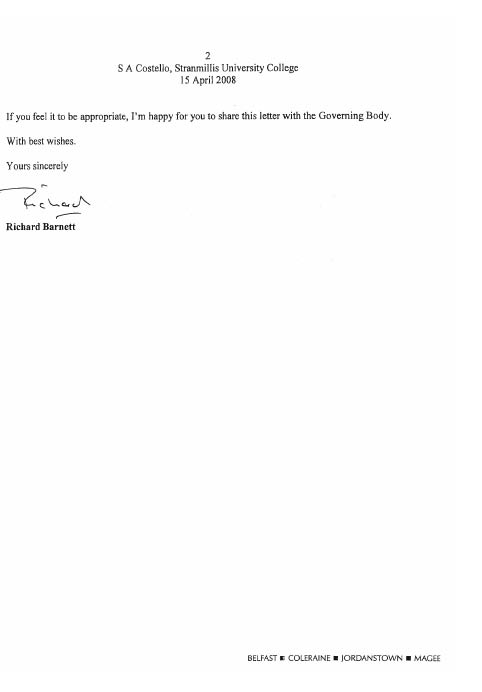

Correspondence from the Transferor Representatives’ Council
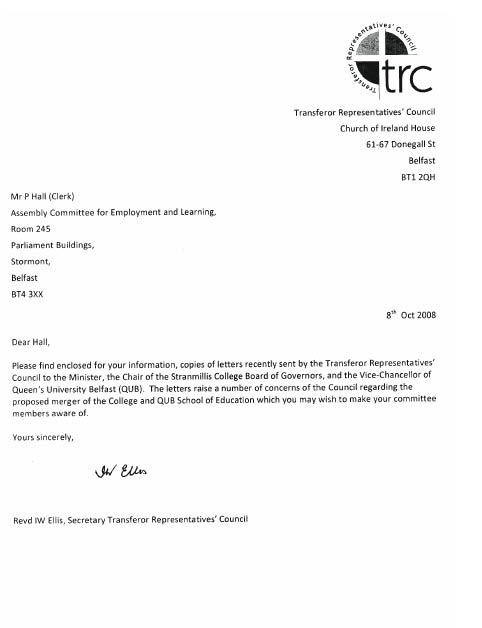




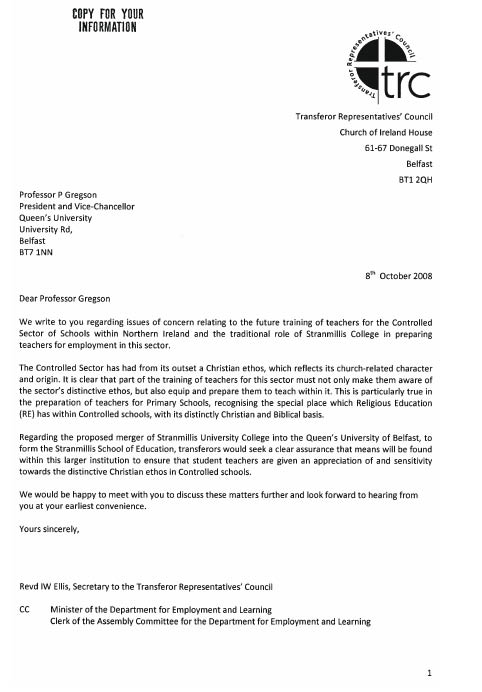

Various Items of Correspondence received from the University and College Union (UCU)

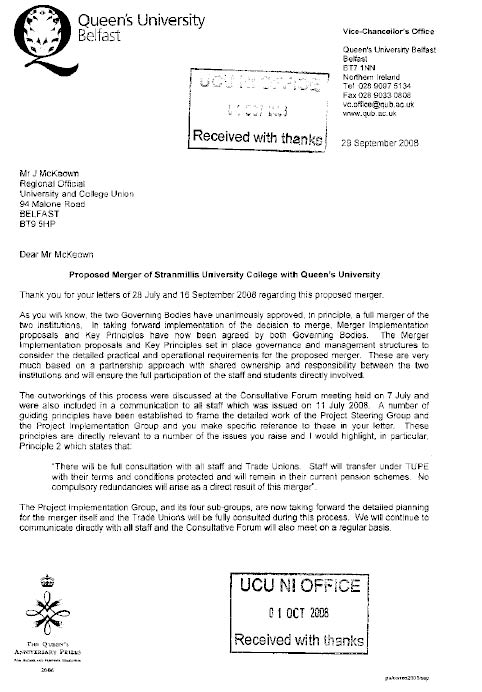

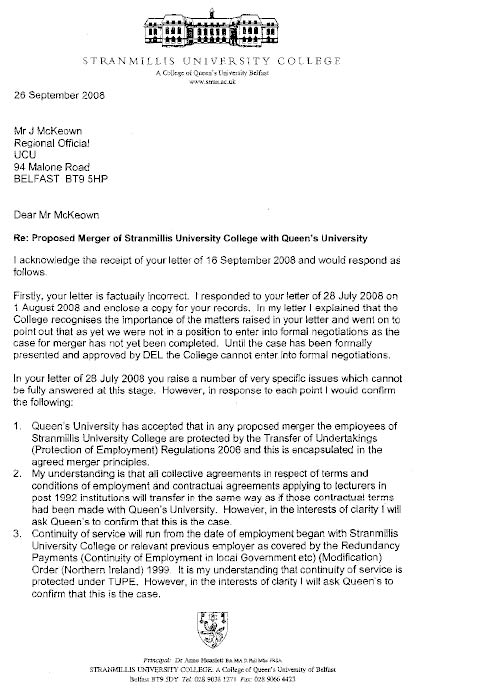
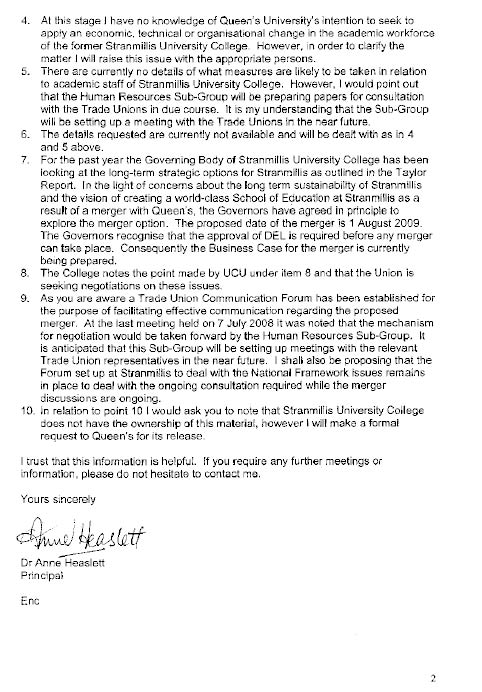

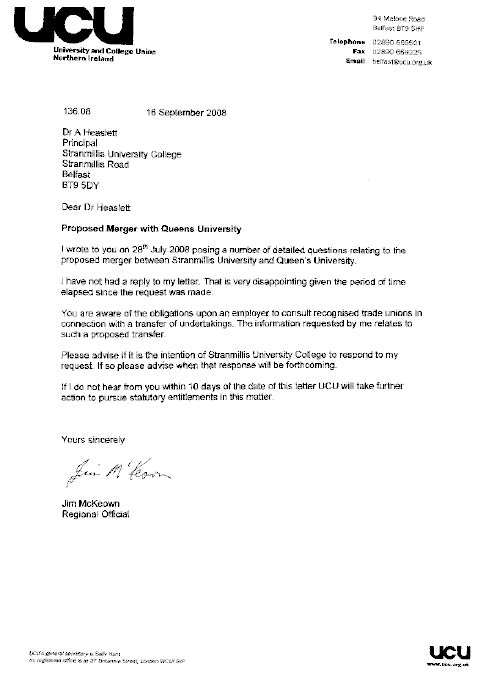

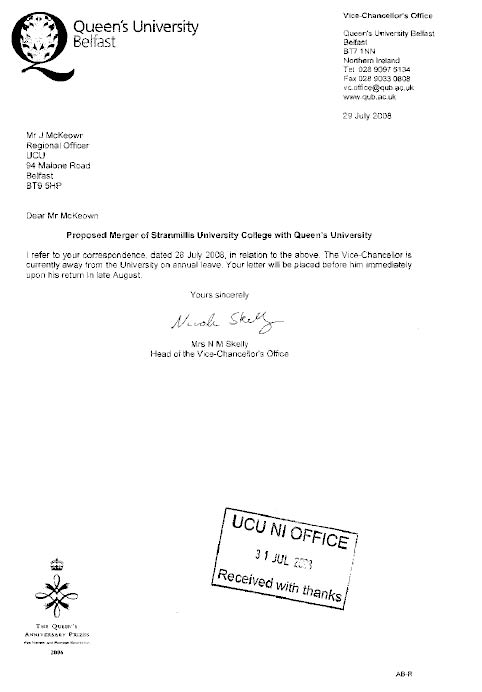
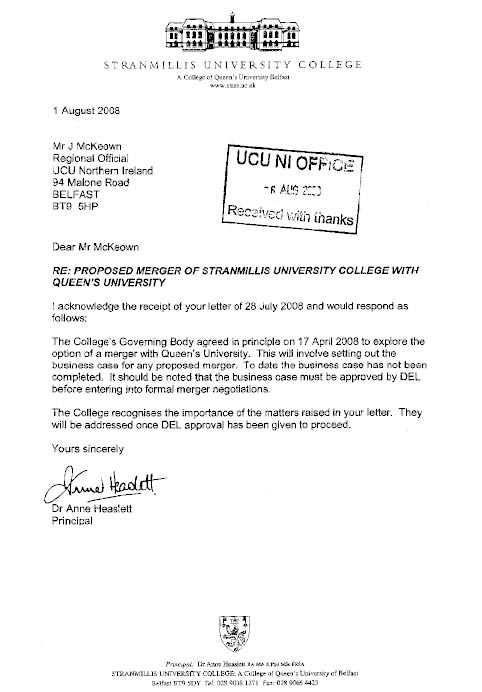
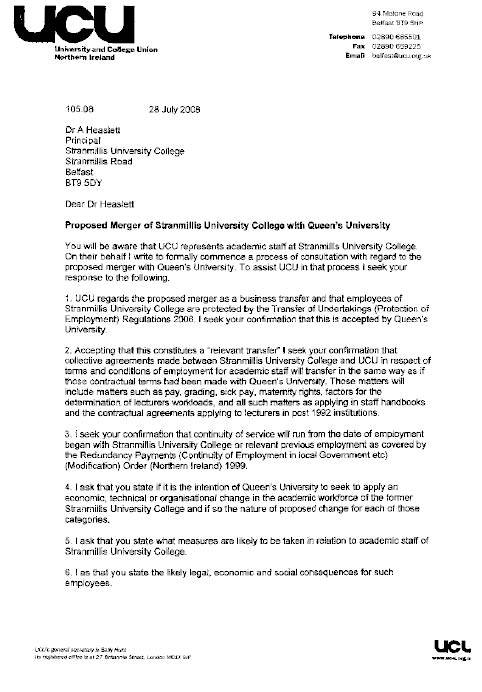

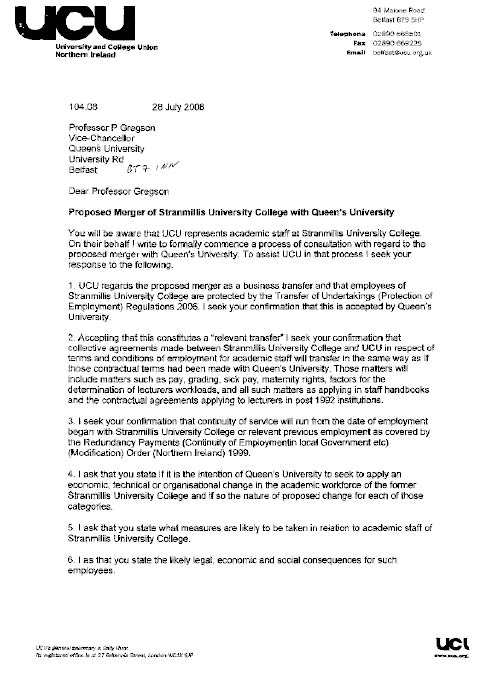
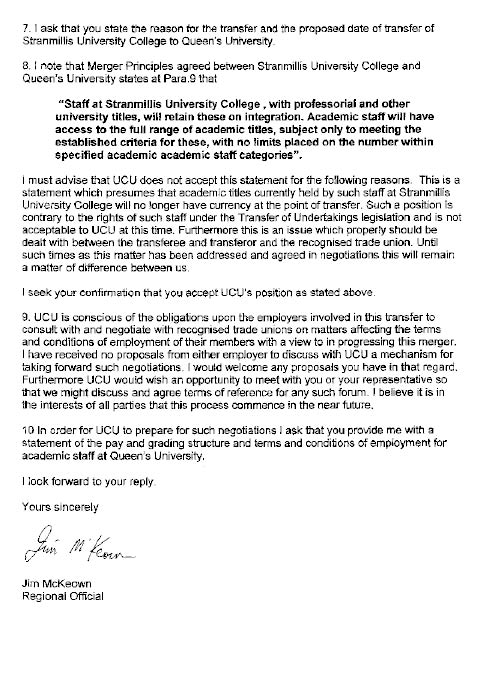
Correspondence with the Minister following evidence from the Council for the Advancement of Communication with Deaf People (CACDP)
Sir Reg Empey MLA
Minister for Employment and Learning
Adelaide House
39/49 Adelaide Street
Belfast
BT2 8FD
20th October 2008
Dear Minister,
Re: Council for the Advancement of Communication with Deaf People (CACDP)
As you will be aware, the Committee had a presentation from CACDP at its meeting on 15th October 2008. CACDP had asked to present evidence to the Committee as part of its Review of teacher education. The organisation specifically wanted to highlight the lack of provision of teaching qualifications taught in British Sign Language (BSL) to enable deaf people to qualify as lecturers and to be able to teach in FE colleges. CACDP is keen that Deaf Tutors should be able to access such a teaching qualification to put them on an equal footing with other FE lecturers. CACDP has indicated that this is currently not the case, leading to Deaf Tutors not being paid the same rate as other FE lecturers.
The Committee agreed that I should write to you with regard to this issue as your department issued a press release on 11th October entitled: ‘Minister praises efforts of local deaf community’. The release talked about your attendance at the CACDP annual Communications Fair and went on to mention your announcement in June 2008 that your department will provide £1.3m to improve access to training courses for interpreting students. The release went on to say: ‘Deaf tutors who teach the language will also benefit from a programme of training in the higher levels of the language and relevant teaching qualifications and support’. This reference to teaching qualifications was indicated to CACDP following the presentation of their evidence to the Committee; however, they did not believe that teaching/lecturing qualifications taught in BSL would be available as part of the £1.3m funding.
The Committee applauds the £1.3m that you have made available to stakeholders in this sector. However, it would be useful if you could clarify the use of the phrase ‘teaching qualifications’ in the press release. This would allow the Committee a much clearer picture of what the £1.3m will be spent on.
Again, the Committee supports your announcement of the money to be spent on provision for the deaf community. However, we need to clarify if the money is being spent where CACDP has indicated to the Committee it is most required.
I look forward to hearing from you in the near future.
Yours sincerely,
![]()
Chairperson

Correspondence regarding Teacher Training Places
Mr Steve Costello
Chairman of the Governing Body
Stranmillis University College
Belfast
BT9 5DY
23rd October 2008
Dear Steve,
As part of its continuing Review of teacher education, the Committee has been looking at the numbers of teacher training places available at the various provider institutions and the demand for these places.
The Committee has agreed that I should write to each of the providers of teacher education courses to ascertain the number of places that you have for teacher education (and related) courses and the approximate number of applications for those places in each of the years since 2004 (inclusive).
The Committee hopes to receive a briefing from Department of Education officials with regard to their determination of the number of teacher education places that will be made available annually. It would be useful for us to have the figures requested above to use in conjunction with the officials’ briefing. I would be grateful if the figures could be with the Committee as soon as possible.
Yours sincerely,
![]()
Sue Ramsey MLA
Chairperson
Cc. Dr Anne Heaslett, Principal, SUC
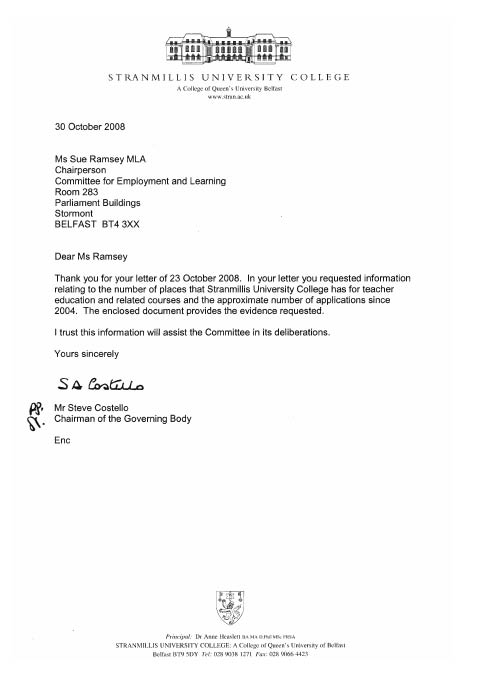

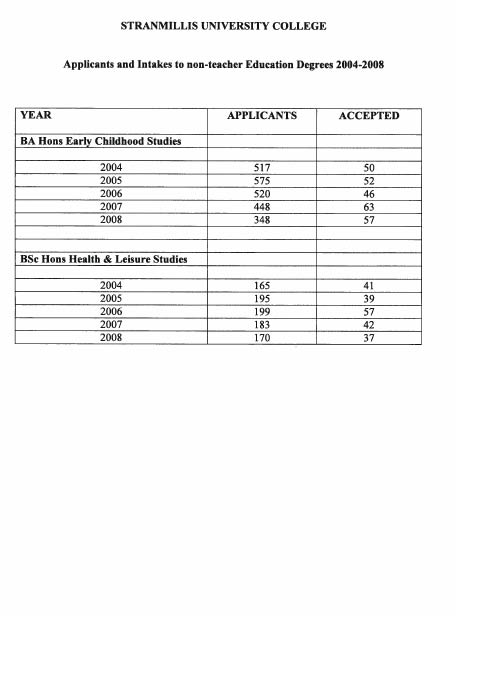
Prof. Peter Finn
Principal
St. Mary’s University College
191 Falls Road
Belfast
N. Ireland
BT12 6FE
23rd October 2008
Dear Peter,
As part of its continuing Review of teacher education, the Committee has been looking at the numbers of teacher training places available at the various provider institutions and the demand for these places.
The Committee has agreed that I should write to each of the providers of teacher education courses to ascertain the number of places that you have for teacher education (and related) courses and the approximate number of applications for those places in each of the years since 2004 (inclusive).
The Committee hopes to receive a briefing from Department of Education officials with regard to their determination of the number of teacher education places that will be made available annually. It would be useful for us to have the figures requested above to use in conjunction with the officials’ briefing. I would be grateful if the figures could be with the Committee as soon as possible.
Yours sincerely,
![]()
Sue Ramsey MLA
Chairperson
[Extract of email from Brian McFall, Director of Finance and Administration, St Mary’s University College]
From: Brian McFall [mailto:b.mcfall@stmarys-belfast.ac.uk]
Sent: 18 November 2008 11:55
To: Hall, Peter
Subject: Applications
Peter,
Sue had requested details of applications to our degree programmes in a letter to Peter Finn. I have attached the relevant information.
Regards
Brian.
Year |
BEd Allocation |
Applications |
PGCE |
Applications |
|---|---|---|---|---|
Entry in Sept 04 |
190 |
2394 |
20 |
68 |
Entry in Sept 05 |
180 |
2028 |
16 |
49 |
Entry in Sept 06 |
165 |
1917 |
16 |
59 |
Entry in Sept 07 |
140 |
1775 |
16 |
51 |
Entry in Sept 08 |
130 |
1446 |
22 |
50 |
Professor Richard Barnett
Vice-Chancellor
Vice-Chancellor’s Office
University of Ulster
Cromore Road
Coleraine
BT52 1SA
23rd October 2008
Dear Richard,
As part of its continuing Review of teacher education, the Committee has been looking at the numbers of teacher training places available at the various provider institutions and the demand for these places.
The Committee has agreed that I should write to each of the providers of teacher education courses to ascertain the number of places that you have for teacher education (and related) courses and the approximate number of applications for those places in each of the years since 2004 (inclusive).
The Committee hopes to receive a briefing from Department of Education officials with regard to their determination of the number of teacher education places that will be made available annually. It would be useful for us to have the figures requested above to use in conjunction with the officials’ briefing. I would be grateful if the figures could be with the Committee as soon as possible.
Yours sincerely,
![]()
Sue Ramsey MLA
Chairperson
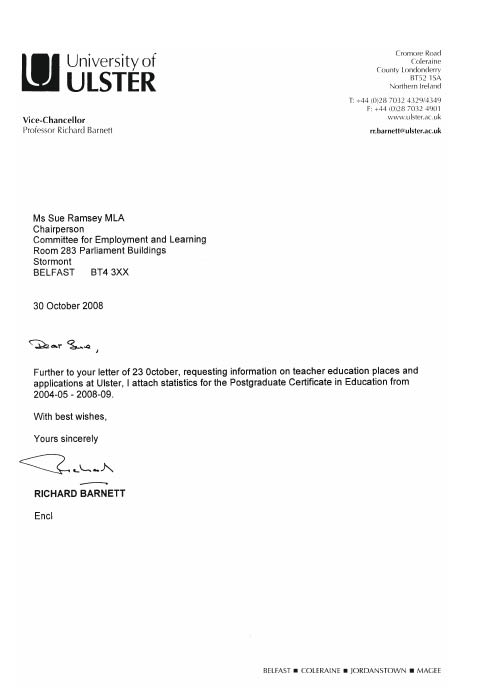

Professor Peter Gregson
Vice-Chancellor
Queen’s University of Belfast
University Road
Belfast
BT7 1NN
23rd October 2008
Dear Peter,
As part of its continuing Review of teacher education, the Committee has been looking at the numbers of teacher training places available at the various provider institutions and the demand for these places.
The Committee has agreed that I should write to each of the providers of teacher education courses to ascertain the number of places that you have for teacher education (and related) courses and the approximate number of applications for those places in each of the years since 2004 (inclusive).
The Committee hopes to receive a briefing from Department of Education officials with regard to their determination of the number of teacher education places that will be made available annually. It would be useful for us to have the figures requested above to use in conjunction with the officials’ briefing. I would be grateful if the figures could be with the Committee as soon as possible.
Yours sincerely,
![]()
Sue Ramsey MLA
Chairperson

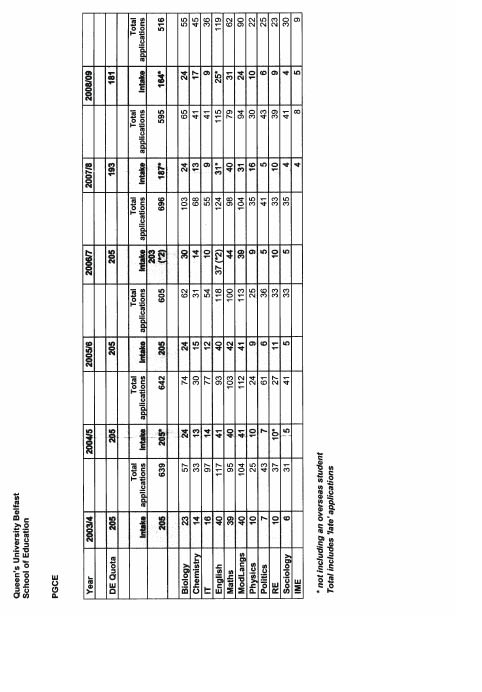
Dr Rosemary Hamilton
Regional Director
The Open University in Ireland
40 University Road
Belfast
BT7 1SU
23rd October 2008
Dear Dr Hamilton,
As part of its continuing Review of teacher education, the Committee has been looking at the numbers of teacher training places available at the various provider institutions and the demand for these places.
The Committee has agreed that I should write to each of the providers of teacher education courses to ascertain the number of places that you have for teacher education (and related) courses and the approximate number of applications for those places in each of the years since 2004 (inclusive).
The Committee hopes to receive a briefing from Department of Education officials with regard to their determination of the number of teacher education places that will be made available annually. It would be useful for us to have the figures requested above to use in conjunction with the officials’ briefing. I would be grateful if the Committee could have the figures as soon as possible.
Yours sincerely,
![]()
Sue Ramsey MLA
Chairperson
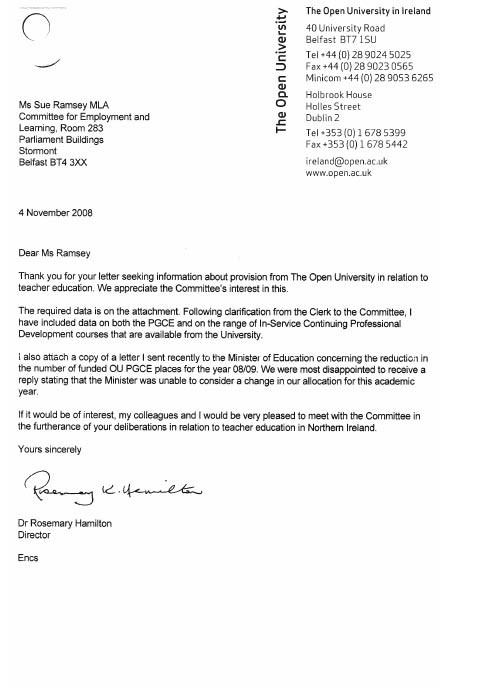

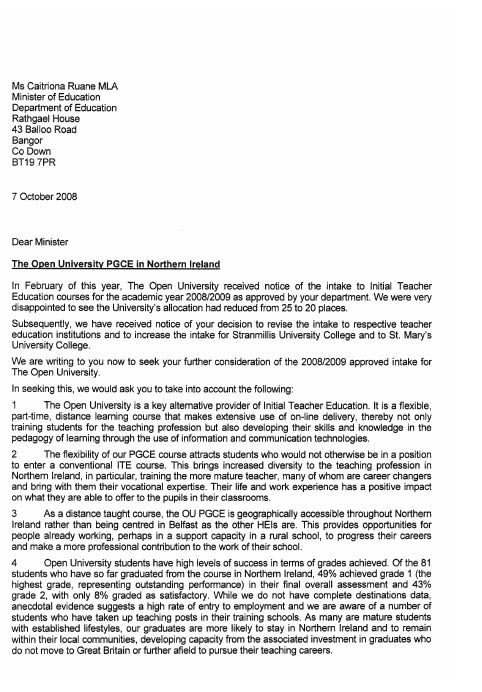

Correspondence regarding the Business Case for a Proposed Merger of Queen’s University with Stranmillis University College
Mr Steve Costello
Chairman of the Governing Body
Stranmillis University College
Belfast
BT9 5DY
6th November 2008
Dear Steve,
The Committee has been made aware that Stranmillis University College’s draft business case proposing a merger with Queen’s University has now been received by the Department for Employment and Learning (DEL). The Committee has also been made aware that the assessment of a business case is a detailed and lengthy process. We understand that once DEL’s economists have made their assessment, the business case then moves to the Department of Finance and Personnel (DFP), where it will be further assessed by specialist economists. Obviously during this part of the process there will be considerable dialogue between DEL, DFP, Stranmillis and Queen’s. Following this, if the business case is deemed fit, it will go to the Employment and Learning Minister, Sir Reg Empey, for his consideration and he will seek the Committee’s view.
Beyond these processes, if the merger is to proceed, there will be a further requirement to go through the stages of framing legislation that will involve the Committee’s scrutiny. Ultimately, any legislation must come before the Assembly, where it will be debated and judged by members on its merits.
The Minister for Employment and Learning has gone on record more than once to say that he does not consider that there is enough time to complete the process, even assuming that the Assembly endorses a merger, in time for September 2009.
Under the circumstances, the Committee has asked me to write to you to ask, in light of the above, if you will consider that is it not possible to complete a merger by September 2009. Throughout its review of teacher education the Committee has stressed that the case for a merger requires more time for consideration and consultation. The Minister has introduced a conversion arrangement to allow the two University Colleges to reflect on their options, so the imperative for Stranmillis to commit itself to an option is not as great as was originally thought. It is the Committee’s view that a merger cannot be completed by September 2009 and if Stranmillis and Queen’s will consider this, then it gives some breathing space for Stranmillis to take up the Minister’s offer of time to reflect.
I hope you will respond positively to the Committee and I will be writing to Peter Gregson in similar terms.
Yours sincerely,
![]()
Chairperson
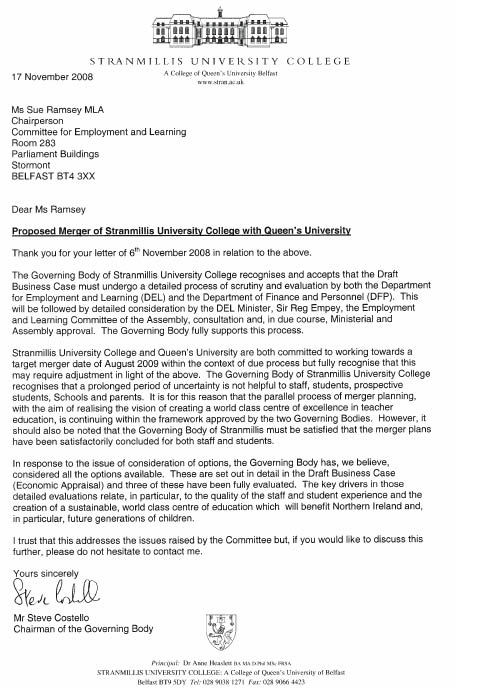
Professor Peter Gregson
Vice-Chancellor
Queen’s University of Belfast
University Road
Belfast
BT7 1NN
6th November 2008
Dear Peter,
The Committee has been made aware that Stranmillis University College’s draft business case proposing a merger with Queen’s University has now been received by the Department for Employment and Learning (DEL). The Committee has also been made aware that the assessment of a business case is a detailed and lengthy process. We understand that once DEL’s economists have made their assessment, the business case then moves to the Department of Finance and Personnel (DFP), where it will be further assessed by specialist economists. Obviously during this part of the process there will be considerable dialogue between DEL, DFP, Stranmillis and Queen’s. Following this, if the business case is deemed fit, it will go to the Employment and Learning Minister, Sir Reg Empey, for his consideration and he will seek the Committee’s view.
Beyond these processes, if the merger is to proceed, there will be a further requirement to go through the stages of framing legislation that will involve the Committee’s scrutiny. Ultimately, any legislation must come before the Assembly, where it will be debated and judged by members on its merits.
The Minister for Employment and Learning has gone on record more than once to say that he does not consider that there is enough time to complete the process, even assuming that the Assembly endorses a merger, in time for September 2009.
Under the circumstances, the Committee has asked me to write to you to ask, in light of the above, if you will consider that is it not possible to complete a merger by September 2009. Throughout its review of teacher education the Committee has stressed that the case for a merger requires more time for consideration and consultation. The Minister has introduced a conversion arrangement to allow the two University Colleges to reflect on their options, so the imperative for Stranmillis to commit itself to an option is not as great as was originally thought. It is the Committee’s view that a merger cannot be completed by September 2009 and if Stranmillis and Queen’s will consider this, then it gives some breathing space for Stranmillis to take up the Minister’s offer of time to reflect.
I hope you will respond positively to the Committee and I will be writing to Steve Costello in similar terms.
Yours sincerely,
![]()
Sue Ramsey MLA
Chairperson

Appendix 6
Additional Papers
Official Report – 23 June 2008
Committee Business
Stranmillis and St Mary’s University Colleges
Mr Speaker: The Business Committee has agreed to allow up to one hour and 30 minutes for this debate. The proposer of the motion will have 10 minutes to propose and 10 minutes to make a winding-up speech. All other Members who wish to speak will have five minutes.
The Chairperson of the Committee for Employment and Learning (Ms S Ramsey): I beg to move
That this Assembly calls on the Minister for Employment and Learning to delay the introduction of a new funding model for Stranmillis and St Mary’s University Colleges to allow sufficient time for the consideration of the future funding and educational options for the two institutions, in view of the Committee for Employment and Learning’s stakeholder review of teacher training.
Go raibh maith agat. At the outset, it is important to state that the Committee agreed to table the motion at its meeting on 4 June. However, it was divided. Eight Committee members were present, six of whom voted yes and two of whom voted no.
It is also important to state that the Committee’s problems and issues with the way in which the Department for Employment and Learning (DEL) is reforming teacher education are entirely to do with the process, or rather the lack of process that has been followed to date. I am sure that all Committee members will have different views on the best way in which to structure teacher education.
(Mr Deputy Speaker [Mr Molloy] in the Chair)
The problem is that the Committee has not had the opportunity to hear the range of arguments and information on the matter from key stakeholders. I venture that the Executive Committee have not heard the full range of issues and arguments either. That is why my Committee has formally launched a stakeholders’ review of teacher education, the objective of which is:
“To collate and consider the options and views of those involved in, and affected by, proposed changes to teacher education and to produce a report of recommendations to the Minister of Employment and Learning.”
The Committee will take its first formal evidence in that review when it hears from representatives of Queen’s University on Wednesday.
The review will not make any judgements on what the Minister should, or should not, do about future funding. The Committee simply asks for time to listen to and consider evidence from stakeholders. Today, we will hear many statistics about teachers’ difficulties in finding work. The fact is that many statistics on the issue exist, and they have not been fully aired and challenged. The Committee’s review will allow that process to happen. Statistics on teacher employment comprise only one element of the issue. We are talking about the future of two of our highest-quality third-level teaching institutions.
It is important that I outline the sequence of events that led the Committee to table the motion. The Minister asked for the opportunity to brief the Committee in closed session on his proposal to introduce a new funding model for the teacher-education colleges.
That meeting took place on 12 March 2008. The critical aspect of it was the Minister’s statement that, although a new method of funding for teacher-training colleges is needed, he is open-minded about future options. Importantly, the Minister also asked that the Committee be involved and that it assist in processing policy options. The Committee is now striving to do that.
The Committee took evidence from representatives of both Stranmillis and St Mary’s University Colleges on 16 April 2008. During that meeting, the Committee learned how far the proposals for changes to the structures of funding had advanced. The proposed merger of Stranmillis University College with Queen’s University was also raised at that meeting. Members of the Committee were told that there would be sufficient time for full consideration of the relevant options. However, the chairman of the board of governors of Stranmillis University College appeared on news bulletins the next evening stating that the merger was effectively a done deal.
Rarely have I encountered such anger in a Statutory Committee of the Assembly as I did regarding the manner in which the process has been handled. The Committee learned that not even the Minister had been made aware of the detailed level of negotiations that had taken place between the two institutions. Indeed, the Minister forwarded to the Committee a copy of his correspondence with the chairman of the board of governors of Stranmillis University College. In that correspondence, the Minister reminded the chairman that due process must be followed if the merger is to be successful. There has even been confusion about the precise nature of the legislative vehicle that the Department will have to introduce to facilitate that merger. Surely the fact that the Minister was kept in the dark proves that the reform process has moved too quickly without due process being followed and without recognition of the democratic structures and political institutions.
Teacher education has been on the policy agenda for many years. Importantly, although policy work was conducted and options were considered during direct rule, no direct rule Minister made any difficult decisions. The mechanisms that allow for full consideration and local accountability are now in place. However, the pace of reform is not allowing for adequate consultation and scrutiny.
It is important to note some of the issues that were raised in the key policy reviews that have been conducted in the past few years. The Taylor and Usher Report of 2004, ‘Aspects of Initial Teacher Education in Northern Ireland’, examined issues such as diversification, population projections, and costs. Colleges were encouraged to diversify, and, indeed, Stranmillis University College, with its early childhood studies, and St Mary’s University College, with its liberal arts degree, have both developed successful courses in that regard. Those two courses fit perfectly with tackling social disadvantage, as outlined in the Programme for Government. However, it appears that both colleges are being penalised for diversifying.
Taylor and Usher also discussed improving the ratios of teachers to pupils and the potential for specialised educational delivery, such as improving the provision of education for children with autism. The Osler Report of 2005 also assessed the potential for teacher growth areas in subjects such as citizenship and modern languages. Indeed, the Minister has indicated that he wishes to explore building the capacity of the colleges in areas such as continuous professional development.
Since devolution, the Committee has worked with a range of stakeholders from the field of education and training. Committee members have made it clear that they want local proven capacity and capability to be protected. The Committee does not want capacity to be reduced, only to be required at a later date. There is evidence of such a situation having arisen in Dublin, when a decision was made some time ago to close and sell off a college. It is very difficult — if not impossible — to rebuild quality capacity after it has been removed.
The motion aims to allow the necessary time to be given for the full consideration of those topics and to allow the Committee to assist the Minister with reform. Taylor and Usher also recognised the difficulties of producing comparative costs for each teacher. That is the reason that further time must be allowed for a full analysis of the financial statistics that are often quoted in this policy debate.
As I mentioned, the Committee does not have hard-and-fast views on what constitutes the best teacher-education model for the future. I stress that the Committee wants value for money to be delivered in this policy area. Given the failure under direct rule to deal with teacher education, the Committee asks simply for due process to be facilitated in the democratic institutions.
A delay in the funding model will not increase public expenditure. Rather, it will allow both institutions to operate as they have been in recent years; that is, as distinctive, high-quality institutions that produce excellent teachers for our education system and that add significantly to the local communities in which they operate.
I look forward to the Minister’s response to the debate because I know that he has been involved in intensive negotiations on the matter. Go raibh maith agat, a LeasCheann Comhairle.
Mr Newton: This is an important motion. I am a member of the Committee for Employment and Learning, and, as the Chairperson said, the future funding and educational options for Stranmillis and St Mary’s have come before the Committee and caused concern across the political make-up of the Committee.
Northern Ireland is approaching a time when extensive discussions on the matter are required and when decisions must be made in the best interests of the children, the provision and professionalism of teacher education and the economy. I am sure that all Members are concerned that we achieve the highest standard of education for all children and young people, and that the education and levels of motivation to achieve their full potential and ensure a bright future are the foundation stones on which educational provision will be built.
Everyone knows about the demographic trends and the influence that those trends will have on the future provision of teacher education. The population of school-age children will decline rapidly in the coming years. In that context, we have to implement a demand-led strategy at the same time as ensuring that the available provision is of the highest quality and one that will produce teachers with excellent qualifications, good teaching practice experience and bright career prospects.
So often, we have encouraged intelligent and well-qualified A-level students who have gone into the teaching profession, yet the potential for them to secure a career is diminished by the over-provision from the teacher-training colleges, which are not aligned to the demographic trends.
The projected need for teacher numbers will fall. That is becoming increasingly evident, and it will impact on the primary sector and lead into the second-tier provision. Under the circumstances, it is difficult to argue for the full retention of the status quo. In determining future policy, synergy must be identified between the need for a professionally equipped teacher supply and a need to address the scale and costs of future provisions.
The Assembly’s thinking should be driven by the efficient and effective use of the public’s money. It is not an option to merely do nothing on the matter, and the Committee for Employment and Learning has already received evidence from Stranmillis and St Mary’s. In both cases, their concern was evident, although Committee members have been concerned about the process entered into between Stranmillis and Queen’s University regarding a potential merger. That has already been mentioned by the Committee Chairperson. A few eyebrows were raised on that issue — especially since the Minister was unaware of the merger dinner that was held to commemorate the done deal and the fact that senior civil servants were not involved in the process. That is a totally unacceptable position.
The Department of Education and the Department for Employment and Learning are carrying out a review of teacher education. In a reply to a question for written answer — AQW 6038/08 — from my colleague Mr Ross on the review of education, the Minister of Education said that the review was almost complete and that she and Sir Reg Empey, the Minister for Employment and Learning, will consider carefully the way forward on all aspects of teacher education in the coming months. They will consider matters such as the introduction of a bursary scheme to support teachers continuing professional development and the way forward on all phases of teacher education — initial teacher education; induction, early and continuing professional development, and so on.
There is a need to look at the oversupply of teachers and to ensure that teacher education is of the highest quality and can be benchmarked favourably against the standards of excellence anywhere in the world and that any future system will enjoy the confidence of the teaching profession throughout Northern Ireland.
12.45 pm
Mr B McCrea: I oppose the motion, mindful of the good intentions of my colleagues on the Committee for Employment and Learning. The motion fails to recognise the urgent need for a new funding model for Stranmillis and St Mary’s University Colleges, and it fails to recognise the imperative need for the Minister for Employment and Learning to act now to provide a sustainable funding arrangement for teacher education in Northern Ireland.
Year on year, the Minister of Education has repeatedly reduced the number of teachers required. The cumulative effect of that has obvious implications for our teacher training colleges. The Minister for Employment and Learning must respond to the demand figures produced by the Department of Education. That reduced demand has revealed a further problem — the funding formula appears to give more money to colleges for producing fewer teachers. That unsustainable position must be addressed. Some people feared that the new funding formula would result in the closure of one, or both, of those university colleges; some felt that that was a long-term ambition of the establishment. To my knowledge, that is not the intention of the Department.
There are prolonged and ongoing difficulties in resolving the education debate, and I can understand why some Members might be concerned that we now enter a similar situation. However, those Members need not be concerned. I hope that the Minister for Employment and Learning will take a somewhat different approach to that taken by the Education Minister, seeking to engage, inform and build consensus on a cross-cutting and important issue.
Almost every week, we hear from the Minister of Education that we must accept change. The UUP accepts the need for change — change is all around us and we are all the better for it. However, change does not take place in a vacuum, it seldom goes unchallenged, and it usually has unforeseen side effects. Those who are being asked to make changes can be sure of one thing: it will not be easy. Those involved are not sure whether those changes will be of any benefit to them. It is important that we explain to those affected why change is necessary. We must sell the benefits of change and we must take time to understand and address the concerns of everyone who might be affected.
Through discussions with stakeholders, I have sought to understand the situation as best I can. I was pleased to discuss matters with St Mary’s about its liberal arts course — and I confess that that was, beforehand, something of a mystery to me. I was pleased to learn about the important work that colleges do in encouraging participation, and I have been made aware of those colleges’ fears regarding the funding formula. However, I understand — and the Committee Chair did mention it — that the Minister, the colleges and the Departments have had positive and constructive discussions and perhaps the Minister will be in a position to tell us more.
It is worth mentioning for the record that the Minister of Education is responsible for policy in this matter. It is she who sets the pupil:teacher ratios, the curriculum, and the rationalisation of the school estates. Furthermore, over recent years, she has forecast a reduction in the number of teachers required. We must address that and the 50,000 empty desks.
Although there are shortages in STEM-based subjects — and perhaps even in some languages — which will allow a modest increase in initial teacher education, the overriding concern is the need to develop some form of activity that will maintain the status of university colleges as teacher-training colleges. Although diversification subjects are useful as part of the solution, they do have limitations. One could anticipate the use of professional development courses, but that is in the gift of the Department of Education.
When it comes to a situation of this sensitivity, I can think of no better person than the Minister for Employment and Learning to handle it. I believe that he will find a way forward for the betterment of all concerned.
The UUP has heard the change of beat in the education debate and looks forward to playing its constructive part in a four-party mandatory coalition.
Mr Attwood: I acknowledge that the issue has been very healthy for the Committee. It is a good example — if not one of the best examples since the Assembly was set up — of a Committee punching at its weight and fulfilling its statutory responsibilities of oversight and calling a Minister to account. The Assembly can learn something, generally, by looking at how the Committee has handled the matter, even though it has created some tensions, as one can hear in the background.
I look forward to hearing what the Minister has to say because I want to hear that there has been some change in student numbers and in funding for Stranmillis University College and St Mary’s University College. However, although there may or may not be adjustments in those two matters, I want to hear the Minister addressing some of the four fundamentals that lie behind the motion and the issue.
The first fundamental is the future of teacher training. It is not a full argument for Basil McCrea to say that numbers of students in teacher training are reducing, and that the Department of Education has been responsible for that. The full picture is that for the past five years, the Department for Employment and Learning and the Department of Education have been conducting a review of the future of teacher training, and that review has not concluded.
Is it fair to teacher training in the North, and to Stranmillis University College and St Mary’s University College in particular, that five years after a review commenced, it has not concluded? Earlier this year, when one of the colleges involved sent a submission to the Department, that submission was not even acknowledged. Is it appropriate, or fair, for the Minister to announce a change in the student funding formula earlier this year when there had not been any announcements about the overall review of teacher training? That is the key issue. Those colleges have a big role to play in the future of teacher training, especially if their responsibilities are to include addressing all the needs of students and pupils in the North. That is a fundamental issue that must be addressed by the motion.
Secondly, St Mary’s University College is one of the most successful teacher training and liberal arts institutions in Northern Ireland. That is not just speculation from a Member for the West Belfast constituency; it is hard fact. Why is it that a college such as St Mary’s University College, which is second in attracting students from the lowest economic backgrounds in Northern Ireland and Britain, has had questions raised about its viability? Why is it that a college for which students need more points for entry than are required for the University of Ulster, and which is not far behind the level of points required for entry to Queen’s University, is not being promoted, protected and valued?
Why is a college that has a 91% student satisfaction rate — the highest in the North — having any issue raised about its future? The truth is that St Mary’s University College is a model that should be protected and enhanced in the future — not have questions asked about its viability now and in coming years. That is the second fundamental issue that the Minister must address. A college with that profile and success should be protected in the future, rather than have further question marks over it.
Thirdly, there is the West Belfast issue. The Minister knows from his previous ministerial experience, when he received the West Belfast Task Force report, how important a college like St Mary’s University College is to the economic community and for providing access to education for people in that constituency. In the future review, both by the Department and by the Committee, I want that to be centre stage. How does one protect such a college, given its importance to the constituency of West Belfast?
My final point is this: senior people who are involved in the issue told me that the original proposals from the Department were intended to provoke a situation and that the Department did not want to have a half-baked mini-university on the Falls Road. That is not a good attitude to St Mary’s University College or teacher training or Stranmillis. That has to change.
Ms Lo: We are all waiting for the Department of Education and DEL’s review of education. It is frustrating that it has taken so long for that review to be published. The Taylor report of 2004 and the Osler review of 2005 identified the challenges facing initial teacher education (ITE): demographic changes are leading to declining demand for, and overprovision of, teachers. Every Member has heard complaints from constituents that newly qualified teachers are unable to secure teaching jobs and that some are unemployed and forced to apply for jobseeker’s allowance. It is very demoralising for a young person who has been through three or four years of higher education to be unable to get a job.
The new funding model has obviously put a lot of pressure on the two colleges. It is bound to have had some impact on the decision by Stranmillis University College to rush to agree to the proposed merger. Senior teaching staff in Stranmillis, who are my South Belfast constituents, told me that they heard all the rumours about the proposed merger, but no one told them officially and they first heard the decision announced on the radio. There was a lack of consultation with staff, the Department and the Committee.
The Alliance Party wants to see a wider debate and an examination of overall provision of ITE in Northern Ireland. At present, five institutions provide 590 student places — that is only the size of a primary school. There must be duplication of resources in that arrangement, and it is unsustainable. There are many changes —
Mr B McCrea: Does the Member suggest a merger of the two colleges?
Ms Lo: The Taylor report provides for a fourth option: a fully integrated or federated structure, with overarching responsibility for all the providers of ITE.
We are going through many changes. There is widespread political consensus in Northern Ireland that there must be change, and change in the transfer procedure is proceeding. We need to take a wider view. We have the opportunity to go further and include in the debate all the institutions, together with the Departments, and bring together all the bodies to provide a single structure so that there is more efficiency and integrated education.
However, as the Taylor report suggests, we must be determined to break down barriers and prejudices in Northern Ireland, so that we can all work together, teach our children together and embrace a better and shared future.
Mr Ross: I consider that the Committee’s approach is sensible. It will ensure that a comprehensive review of teacher-training models will be conducted, and how that will impact on St Mary’s and Stranmillis.
As my colleague Mr Newton stated, decisions must be taken. It is a shame that the review is taking so long.
1.00 pm
There is little doubt that teacher training in Northern Ireland must be reformed. According to a written answer to me from the Minister of Education, in the region of 7,000 young teachers cannot find a job in Northern Ireland. Each year, we train young people — at a significant cost — to be teachers. However, if those young people want to follow a career in that profession, they must travel to England, Scotland or Wales to find positions.
There is an article in today’s ‘Irish News’ about the crisis facing newly qualified teachers. The article states:
“Fewer than 40 of 800 graduate teachers got jobs in Catholic schools last year … Figures show that a relatively small number of graduates secured employment in the Catholic sector and most were only awarded temporary contracts.”
It goes on to state:
“Just 38 of these gained employment in Catholic schools — 18 securing full-time posts and 20 being called in to cover maternity leave or secondments.”
The article continues:
“Of the 229 new jobs in primary schools last year only 12 were given to newly qualified staff.”
Despite those figures, the Minister of Education insists that there is no requirement to decrease the number of teachers who are trained at St Mary’s. In fact, she recently said that additional teacher-training places were required there. Furthermore, the Minister is unwilling to introduce an induction year, which would allow these young teachers to gain experience in a teaching post before applying for full-time positions.
We cannot continue to train so many young people for a profession in which they have no prospect of getting a job. Therefore, reform of teacher training is necessary. However, there are concerns about the manner in which that process of reform is being conducted — in particular the way in which the Stranmillis and Queen’s University merger has come about.
As the Chairperson of the Committee for Employment and Learning said in proposing the motion, both Stranmillis and St Mary’s are widely recognised as first-class teacher-training institutions. Both institutions are very important to the areas in which they are situated, and both have a distinctive ethos. Although a merger of Queen’s University and Stranmillis may be in the best interest of the long-term future of Stranmillis University College, all members of the Committee have raised questions and concerns about how the merger process was conducted.
The Minister briefed the Committee in closed session on the future of teacher training in Northern Ireland on 12 March. At that stage, the Committee was asked to become involved in the process. On 16 April, representatives from Stranmillis and St Mary’s presented evidence to the Committee.
During that evidence session, the Committee learned of the impact of proposed changes, in particular the advanced nature of a possible merger of Queen’s University and Stranmillis. After questioning from my colleague Mr Spratt and, I believe, Mr Attwood, the chairman of Stranmillis University College’s board of governors — Mr Steven Costello — left the Committee in little doubt that the decision to merge had already been taken at a high level by the two institutions. Indeed, that was confirmed the following evening when Mr Costello announced that the merger was to proceed.
A significant step such as that requires detailed discussion, not least on the legal framework in which the merger would be conducted under the Colleges of Education Order ( Northern Ireland) 2005. However, the Minister for Employment and Learning stated that he was unaware of the merger, reiterating that such a merger would require legislation in this House, and that there was no done deal.
However, that was not the impression given by Mr Costello, who is either certain that the merger will go ahead or naive in not recognising the legislative process required before such a merger could proceed. Indeed, not only had meetings taken place between officials from the Department and the institutions — meetings between the two institutions had been taking place for some time — but, as Mr Newton said, a dinner took place on 26 May to celebrate the merger.
I have already stated that a merger may be the best option. However, there are genuine concerns over the impact on the ethos of Stranmillis University College, given the secular ethos of Queen’s University. There are also concerns about assets and staffing issues. Moreover, the Department, the Minister and the Committee have yet to see the business case for the merger, and they have received no assurance that the ethos of Stranmillis University College will be protected — a point that I have raised with the Minister before in the House.
Mr Attwood raised issues that concern St Mary’s, such as projected student numbers, required teachers and the impact that a revised funding model will have on that institution. Those concerns must also be addressed.
The Committee has therefore decided that it should review the merger and discuss options with stakeholders and student bodies. That is a good approach to take. Ultimately, the Minister’s decision may prove to be the correct one. However, we must ensure that the process adopted is the right one and that we achieve the right outcome for children, teachers and students, and for educational training in Northern Ireland.
Mrs McGill: Go raibh maith agat, a LeasCheann Comhairle. I declare an interest as a former resident of the parishes surrounding St Mary’s and Stranmillis.
Therefore, I have a keen interest in the motion. I am a member of the Committee and I commend the other members, and the Chairperson and Deputy Chairperson, for proposing this motion.
All joking aside, and thinking particularly of St Mary’s, where I spent more time than at Stranmillis, the quality of teacher training at both institutions has been repeatedly mentioned in Committee and in the House. Members have been granted power over the future, and it would be unacceptable for us to lose St Mary’s, which, as its mission statement makes clear, is dedicated to Catholic teacher training.
Mr Ross has mentioned the ethos of Stranmillis, and the threat faced by that college. I do not want either college to lose its ethos. I welcome the fact that discussions are ongoing but, to repeat what has been said earlier, there are difficulties with that process.
When I first heard about the proposals I was concerned that there was a done deal, and I was worried about what would happen to St Mary’s. There is a lot of talk about the number of teachers needed to meet the requirements of the pupil population. Nobody wants graduates to be unemployed. However, it is possible to address that issue.
In my time in both colleges, I had uniquely valuable, college-specific experiences. Therefore, the ethos of each college is tied into its role, whether the institution is Catholic, non-denominational or controlled. We must protect the particular culture, ethos and good quality training that they provide.
I am open to correction on the figure, but ‘The Irish News’ has been referred to, and I see that Stranmillis is funding £400 of the £440 it costs for distance learning at the University of Glasgow in the certificate in religious education that St Mary’s provides. The religious education certificate enables Stranmillis graduates to teach in Catholic schools.
It is important that Members consider all the issues. The Minister for Employment and Learning recently attended a meeting of the Committee, during which the Chairperson questioned him about the delay in the funding model. I welcome the fact that the Minister appeared to have his ears open, and I think that he will be reasonable. The debate, therefore, is welcome. I hope that all the issues can be satisfactorily resolved. Go raibh maith agat.
Mr McClarty: The five teacher-training providers in Northern Ireland offer an outstanding service, which produces particularly high-quality teachers of whom we should all be proud. In comparison to other parts of the United Kingdom, we generate teachers who are extremely well-respected and who are crucial to our society and to our economy.
Our main priority should be to ensure that the high standards in all our teacher-training facilities are maintained and, indeed, built on. Having worked with my colleagues on the Committee for Employment and Learning and with the Minister, I know that, although some differences exist, our shared aim is to ensure the maintenance of those high standards.
As has been mentioned already, initial teacher training is the responsibility of the Department for Employment and Learning and the Department of Education. DEL is responsible for the funding and administration of teacher-training institutions, and the Department of Education is responsible for the determination of student-intake numbers. Although high standards are being produced, an anomaly currently exists in the way in which teacher training in our two university colleges — St Mary’s and Stranmillis — is funded.
The current funding model is based on a block-grant allocation, which is uplifted annually for inflation, with a deduction for student fees then applied to it. However, that model results in a situation whereby a reduction in student intake can result in an institution being allocated more of the block grant. The fewer the students, the more central funds are made available to an institution. That is, surely, not a defensible practice at a time when we are so concerned about increasing efficiency. Although I recognise the concerns of my colleagues on the Committee, the Ulster Unionist Party cannot support the motion.
In light of that anomaly, the Minister and his departmental officials have developed a revised teacher-demand-based funding methodology, which is based on the practice in similar institutions in England. The desirability of change is exemplified by the reducing intake numbers and the number of trained teachers currently seeking employment. As we have already heard, the number of teachers on the Northern Ireland substitute-teacher register is in the region of 7,000. The 2006 school census confirms that the school population is set to decline by 13,109 pupils by the academic year 2011-12, and there are 50,000 empty school desks. Those are compelling reasons why change is necessary.
If we do not change the funding model and respond to the need to reduce student numbers, we will be failing the taxpayer as well as new teachers, who will not be able to find a job. Failing to change could cost the Department for Employment and Learning millions of pounds every year and add to the already saturated teaching sector.
Diversification in the colleges has been discussed today. That policy served a valuable purpose when it was introduced in 1997, and it still does today. However, it would fundamentally change the character and ethos of both Stranmillis and St Mary’s if we continue to allow them to increase their allocation of diversified places by the number of initial teacher-education places that are cut. Questions would be asked about the duplication of opportunities that are available elsewhere in higher education in Northern Ireland, and the specialised nature and high standards of the colleges could be jeopardised.
Changes to the funding and diversification models should guarantee the colleges’ futures rather than jeopardise them. The Minister seeks to introduce a fit-for-purpose model that is transparent, open, and understood by all, and that guarantees the best use of public money while respecting both institutions’ ethos.
Although it is correct to scrutinise the Minister on this crucial issue, we should also recognise that the Minister has informed the Committee, his Executive colleagues, and the university colleges of his plans throughout the entire process. I am sure that he will continue to work with the Committee and to respect its input and any report that it produces. However, passing the motion would hurt the colleges. Change is needed — we cannot, and should not, shy away from that necessity. I oppose the motion.
Mr K Robinson: I declare an interest as a former student of Stranmillis University College, many years ago.
I was also involved in initial teacher interviews. I agree with my colleagues who spoke about the quality of students who entered the college and their standing — once they have completed their course — as being among the best prepared teachers in the United Kingdom.
1.15 pm
Although I recognise Members’ concerns, the funding model for Stranmillis and St Mary’s is neither sustainable nor defensible. Rather than being based on student numbers, the recurrent grant allocation of the colleges is calculated by uplifting the previous year’s gross estimated requirement by the same percentage as that used for the universities with the student income fee deducted. Therefore, when there are fewer students, less fee income is deducted and the Department provides more central funds to the colleges — the fewer the students, the more the Department and the taxpayer are forced to pay, which is an indefensible position.
As several Members have mentioned, there is an over-provision of teachers — more than 7,000 teachers are seeking employment through the Northern Ireland substitute-teacher register, 30% of whom are under 30. No profession is sustainable in the long run without new blood, so that must be challenged. Therefore, the Department of Education is expected to reduce the student intake numbers incrementally over the next five years.
Continuing with the current funding model under those circumstances would potentially cost the Department for Employment and Learning millions of pounds. At a time when we have a Budget that somewhat relies on efficiency savings for feasibility, it could be considered negligent not to make a change. Equally, not reducing teacher numbers would be detrimental to those teachers who cannot find jobs, and to any students who enter the system. That could also add to the recognised problem of the brain drain from Northern Ireland.
It is part of the Minister for Employment and Learning’s role to fit together the higher-education sector, the employment sector and the economy. In this instance, the Minister of Education, in her role of setting intake levels, must recognise those departmental and Executive goals.
Much has been made of diversification. Since 2005, it has become the practice for both colleges to seek approval to increase their allocation of diversified places by the number of initial teacher-education places that have been cut. With a speculated reduction in the number of initial teacher-education places, there could be a fundamental transformation of teacher-training colleges in Northern Ireland.
It is of paramount importance that teacher training be the main priority of colleges and that their expertise in those areas, which has been built up over generations, be maintained. Therefore, the Minister for Employment and Learning was correct to suggest a cap on the number of diversified places.
Some of the Members who spoke in the debate referred to the ethos of the two colleges, which is central to the role of both. Much understanding has gone into the fact that diversification would help colleges to address problems that they were suffering from at that level. However, we must look towards the future. If diversification continues, it must be strictly controlled or we shall risk tipping the balance in a direction that none of us wants.
Change is required — the new funding model will make the colleges sustainable in the long term, which is vital for our whole society. The new model will be open and transparent. Further diversification of the colleges would undermine their expert role as teacher-training colleges, and will raise questions about duplication in other areas of higher education, which should not escape scrutiny. Such scrutiny should not be focused on only the two colleges, because there are other institutions that also deal with teacher training.
The Minister respects, and will try to guarantee, the ethos of both colleges — it is important to say “both colleges”. Any amalgamation between Stranmillis and Queen’s University will require legislation, which will have to be scrutinised by the Committee for Employment and Learning and the Assembly. Therefore, in its present form, the motion should be opposed.
The Chairperson of the Committee for Education (Mr Storey): As the Chairperson of the Committee for Education, I wish to raise an important issue that relates to the debate, but not directly to the issue of the new funding model. As part of the Committee’s scrutiny of the draft Budget proposals, the Committee examined the cost of employing newly qualified teachers to cover part of the planning, preparation and assessment time of teaching principals, and of introducing a guaranteed induction year for newly qualified teachers, as is the case in Scotland.
At that time, the Committee heard about the numbers of qualified teachers who were not employed in the teaching profession, as has already been mentioned. I note that an article in today’s ‘Irish News’ highlights the fact that fewer than 40 of 800 graduate teachers secured jobs in maintained schools last year, which the newspaper describes as “the crisis facing young teachers”.
The Committee specifically recommended to the Minister of Education that active consideration should be given to using newly qualified teachers — at a cost of approximately £24,500 — as opposed to using experienced teachers as substitutes, at an approximate cost of £42,000.
The Committee welcomed the allocation of some £12 million in the current Budget period to specifically help primary-school teaching principals, but very much regrets that measures suggested to address the employment of newly qualified teachers have not, to date, been prioritised in the Education budget, and have not been progressed.
I assure Members that, as part of its scrutiny role, the Committee for Education will continue to raise this issue with the Minister.
Mr Beggs: To do nothing about the current teacher-training situation is not an option. Over recent years, there has been an oversupply of teachers in comparison to the vacancies that exist. Thousands of newly qualified teachers are seeking employment in the teaching profession. The current system is not good for students who wish to become teachers and it is wasteful of our limited resources.
Changes have occurred, and there has been a gradual reduction in the number of teacher vacancies at our colleges. However, I recently learned of a situation in which there were 55 applications for one teacher vacancy. That is a reality that does not seem to have been addressed. Indeed, the Department and the colleges are lagging behind the job opportunities, because there is still a significant oversupply of teachers. Therefore, changes are required.
I understand that there are likely to be even fewer teaching vacancies in future because it is less likely that existing teachers will be granted early retirement packages. I draw Members’ attention to an answer to a recent question that was posed to the Minister of Education in which she acknowledged that 440 teachers who took early retirement packages are currently being re-employed in primary schools as substitute teachers. That means that those teachers were effectively being paid twice from public funds: they received a retirement package, and were then paid a second time. That also means that there are fewer job opportunities for young teachers who are seeking to get on a career path.
The motion calls for a delay in the introduction of a new funding model. Sometimes, a delay is used as a mechanism to stop change. If that is the aim of the motion, I oppose it, because change is required.
As other Members indicated, the current funding arrangement is not viable. It is ridiculous that more public money should go into teacher colleges for producing fewer teachers. What part of the private sector, or, for that matter, what other part of the public sector would agree to such funding arrangements? There is huge pressure on the public purse, and we must ensure that we get value for money from our limited funds. Therefore, it is right that changes to the funding package occur.
An intermediate stage to allow the colleges to readjust to the package should be considered. However, fundamental changes to the outdated and outmoded funding arrangements must occur.
Other Members have drawn attention to the article on the front page of today’s ‘Irish News’ about the fact that fewer than 40 of the 800 graduate teachers produced last year have secured employment in the maintained sector. In fact, only 18 graduates gained full-time employment; a further 20 were employed to cover leave. That is a drastic situation, which must be addressed.
Should such a teaching mechanism be in place? Speaking in a personal capacity: why must trainee teachers be taught separately? Why can there not be an arrangement whereby trainee teachers are taught together, but are provided with the options and modules that are required by their particular educational sectors. Why can trainees who require a certificate of religious education not be provided with that option? It is good practice for all teachers to be taught together under one system. Ultimately, if we want children to be taught, to live, to play, and to work together, teachers should also be taught under one system.
There are sound economic reasons for opposing the motion. In the long term, to continue with this outmoded system is not in the best interests of the public purse, students, and the colleges. I oppose the motion.
The Minister for Employment and Learning (Sir Reg Empey): In the time that is available, I will do my best to address the many issues that have been raised.
I welcome the opportunity to address the motion, and I thank the Members who contributed to the debate. I also thank the Committee for Employment and Learning for its constructive approach to this important issue.
During his contribution, Mr Attwood said that he felt that the Committee was punching above its weight, and that it was doing its job in holding me to account. I strongly support that. I remind him that, during the 1998 negotiations, I was involved in designing the Committee system, which I support fully. I strongly believe in the Committee system. Indeed, had my party had its way, there would have been no Ministers — only Committees and Chairpersons. However, during the negotiations, it was clear that Mr Attwood’s party was keen to appoint Ministers. He may not be particularly keen on the fact that his party has ended up with only one Minister, but that is the way the negotiations worked out.
I want to be clear: my first and fundamental priority is to ensure that initial teacher education in Northern Ireland continues to be of the highest quality. That is where everything starts, and we should remain focused on that. The calibre of our teaching workforce is well known and it makes an immense contribution to society and to the economy. Nevertheless, we are faced with a situation whereby supply outstrips demand, and many highly committed newly qualified teachers are unable to find employment in their chosen career. Throughout the debate, we heard numerous Members draw our attention to that.
Results from the ‘Destination of Leavers from Higher Education’ survey show that 79% of students qualifying in teacher education in 2005-06 were employed in the teaching profession six months after qualifying. However, of that 79%, only 20% held a permanent contract. Members made reference to the number of empty desks and substitute teachers in schools. The Chairperson of the Education Committee commented on that matter. There is an issue about who takes those posts, and the Department is cognisant of that. The Assembly can certainly work on that issue, which will help. We, as an Assembly, must pursue that.
The new pension arrangements, to which reference has been made on numerous occasions, could result in up to approximately 400 fewer places per annum being available. That is big issue, which we must address.
There are five providers of initial teacher education: the colleges, the two universities, and the Open University, which provides a small number of flexible places. Members are aware of the breakdown of numbers between the Department of Education and my Department on that matter. The Department of Education has consistently reduced those numbers, and we know that that is anticipated to continue for the next number of years.
1.30 pm
I recently met representatives of the senior management of both colleges, and those meetings went extremely well. I am pleased to tell the House that I had discussions with the Education Minister and that we reached agreement on the number of initial teacher-education students for the forthcoming year. That is a policy decision taken by the Minister of Education — my task is to provide the funding and administration — to improve the situation in which we find ourselves. Nevertheless, based on enrolment figures supplied by the colleges, and intake figures supplied by the Department, initial teacher-education student numbers for the forthcoming academic year will decrease marginally compared with the 2007-08 figures.
While diversification by the university colleges into other areas of provision may appear to provide a simple solution, that is not always the case. In 1998, following a report by the Northern Ireland Audit Office (NIAO), the colleges were allowed to diversify, to a controlled extent, into non-teacher-education provision. Each college was given an allocation of 200 places, which were filled between 1999 and 2001. The diversification provided an opportunity to reduce costs; it was driven by trying to keep the cost base down. However, the audit report recommended that diversification should take place only in areas related to teacher education. Currently, colleges are operating at diversification levels of just over 30%.
Over recent years, reducing teacher-education intakes also highlighted the fundamental deficiency in the historic approach that was used to fund the colleges. Members have clearly articulated the difficulties that we face. The model seems to indicate that the fewer students there are, the more money the Department will provide. With the best will in the world, that is a model that no one in this House could defend and the general public would find hard to understand.
I listened very carefully, however, to members of the Committee who are concerned about “viability” — a word used by Committee members and a number of other Members. That is a matter for the Committee, but it is my view that postponing or delaying the introduction of a new funding model will add to the uncertainties, which will continue. People will wonder what will happen next year, and they will wonder when the new model will be introduced. However, I believe that we have a solution that will provide stability for the period ahead and still meet the Department’s ambitions to move to a new funding model.
Because there will be a period of change, I believe that we can justify a conversion arrangement in which resources are made available to the colleges to help them bridge the gap. Initially, I anticipated that that would be available to the colleges in 2008-09. However, after representations and discussions with the colleges, I believe that it is more appropriate to extend that into 2009-2010, in order to provide a two-year period for the colleges to work with us and the Minister of Education, and to deal with the options that are open to them.
For the next two years, that arrangement — combined with other matters that I will mention with regard to numbers — will provide the colleges with a stable platform to work out a way forward. I hear the Committee’s anger about the announcement by Stranmillis University College, but the danger is that two issues are being confused. I have to wait and see what the business case is for Stranmillis before the Department can sign off on it. It has then to go through the legislative process.
A number of Members talked about the celebratory dinner. Last week, I met Sir David Fell — the chairman of the senate at Queen’s University Belfast — and Mr Costello in my office. I asked specific questions about that matter, and I received all of the paperwork. Previously, I had been furnished with some of it, as were other Members, but the initial letter was not presented until then. I was assured that the dinner was not a celebratory event; rather it was an event that brought together all those who would be involved in the arrangements and discussions for reviewing how the proposed merger might work.
I reiterated, ad nauseam, the concern that had been expressed and the issues about staffing. They have agreed to set up a communication network with the Department, and I have also urged them to engage significantly with the staff to ensure that anxieties are allayed. Nevertheless, in order to give the colleges space, I have proposed that conversion funding be made available for the next two years.
I had a good meeting with representatives from St Mary’s University College last week. The colleges and the Department now have a clear vision of the way forward, which will be to concentrate on teacher education. We have asked, and the Minister of Education has agreed, to consider the issue of early development, and continuous professional development, and find out whether it is possible for that workload to be allocated to those colleges in order to bring in additional work that is related to teaching. The Minister of Education has agreed to consider that issue urgently and, if that can be achieved, we would be moving in the right direction. St Mary’s University College made it clear that it is keen to pursue such additional work, and that also goes for Stranmillis.
As regards a dispute over the number of diversified students, the Department set a target of 260 in a letter to the colleges in March. The colleges argued that that was misleading, because if they go by the correspondence from last summer, they should have been able to recruit more diversified students in the coming year. I did not want to get into an argy-bargy over letters and who said what. I decided that, in order to move matters forward and to give the colleges the breathing space that they need, the current number of diversified students — which I believe is 286 — will apply for next year as well as this year. The net effect will be that the colleges will have extra time and space to enable them to work with the Department over the next year to settle the matter and find a clear way forward. The colleges have accepted that, and they recognise that their concerns, and the concerns expressed by the Committee on several occasions, are being met.
Mr Attwood referred to the significance of the college to West Belfast. He does not need to tell me about that, because I accept the situation fully. However, I was concerned when Mrs McGill spoke about losing the college. I want to make it absolutely clear that I have no intention of closing either of the colleges as venues for initial teacher education; that is not required. Northern Ireland is not about to become an ethos-free zone. Parental choice is an issue, and that cannot be ignored.
I cannot tell what the future may bring, but I understand fully that there was an unfortunate interface between higher and further education in the West Belfast constituency that has left a sour taste. St Mary’s University College has enormous potential. However, if both colleges cease to become primarily initial teacher-education institutions, as some of my colleagues have suggested, the focus inevitably shifts, and that brings uncertainty into the picture. Other universities may expand their campuses in the Belfast area, and that may bring a suite of courses within walking distance of north and west Belfast, especially if the University of Ulster were to expand its site at York Street. That will put a college that depends on one humanities degree at great risk.
The future for those colleges is clear; they will continue to do what they do best by educating teachers. Research must be carried out to determine how to introduce continuous professional development, and conversion funding should be extended for a second year to achieve that. This year, in accordance with the agreement I reached with the Minister of Education and the understandings we reached on diversified places, the colleges should be given the breathing space that the Committee members are keen to provide and for which I accept that there is a requirement.
That will allow the Department to get on with solving the problems that have been mentioned, such as the oversupply of teachers. However, we must also bear in mind that, because of the new economic circumstances, we must improve the continuous professional development of teachers. Additional work is required to achieve that. It is not a matter simply of shifting the existing workload but of expanding continuous professional development and introducing early development. The issue of induction, to which the Chairperson of the Committee for Education referred, is critical.
I say to the Committee that a requirement to retain the existing funding model would be a constraint and would increase uncertainty. My Department and the Department of Education have gone as far as they reasonably can to meet the genuine concerns that the Committee expressed.
The Chairperson of the Committee for Employment and Learning: Go raibh maith agat, a LeasCheann Comhairle. I thank all those who stayed to listen and take part in the debate. Members who do not sit on the Committee for Employment and Learning contributed also, which demonstrates the wider interest in the issue and makes the debate worthwhile. I thank the Committee staff for their work over the past couple of weeks: it is appreciated. They have been working flat out to ensure that the stakeholder review will be arranged before the summer recess.
Every Member who spoke in the debate mentioned the positive work of Stranmillis University College and St Mary’s University College, and I agree with their comments. Most, if not all, Members mentioned the need for reform that I stressed in my opening remarks. I went as far as saying that the Committee may reach the same conclusion as the Minister, but that members wanted a review because of the many other issues involved, not least the proposed merger of Stranmillis University College and Queen’s University. The Committee, and I, as its Chairperson, simply tried to obtain as much information as possible to enable us reach a collective decision.
In the course of the debate, it struck me that there are two main themes, one of which is policy; and the Committee argues that the policy must be reformed. Notwithstanding the proposed merger of Queen’s University and Stranmillis University College, the process caused the Committee members the greatest concern.
I agree with the Deputy Chairperson of the Committee who said that children and the economy must come first, and that that ties in with the Programme for Government. I highlighted the fact that in Dublin a decision to close a teacher-training college was taken based on population trends, but that there is now a realisation that the college is needed. It is important for the Committee’s review to continue and that we talk to all relevant stakeholders.
Alex Attwood said that St Mary’s University College had a good record of achieving participation by lower socio-economic groups, and, based on evidence from the West Belfast Task Force, I agree with him. However, I must stress that Stranmillis University College has a good record also.
Anna Lo expressed her frustration that the review is taking so long and at the lack of consultation with staff from both colleges. I cannot argue with that, and it is important that people working on the ground in the community and voluntary sector and in the colleges are aware that the Committee is being proactive.
Alastair Ross mentioned the need for reform and, given that that was the reason that the Committee tabled the motion, I agree with him. In fairness, the debate has reached this stage only because the Committee was able to press for the debate. We will continue to carry out a review of stakeholders. The Committee will probably work closely with the Minister, and we may reach the same conclusions and possibly make his job of introducing some of the proposed changes a bit easier.
Claire McGill mentioned the quality and ethos of both Stranmillis and St Mary’s. Those are important issues and were mentioned by a lot of Members. That is why the Committee is inviting submissions from everybody; the Committee is open to anyone who wishes to discuss the matter.
Ken Robinson, David McClarty, Basil McCrea and Roy Beggs all mentioned the quality issue, the funding model, and efficiency savings — I think they must all be subject to a 10-line whip, because their speeches referred to the same issues. However, I could not argue with any of that. As Chairperson of the Committee, I am not just concerned with a single issue, and I know that the former Deputy Chairperson shares that view. Rather, we are concerned with a number of issues, and wished to open those issues to discussion.
1.45 pm
A number of Members, including the Minister and the Chairperson of the Education Committee, mentioned statistics, and in my opening remarks I said that in the debate we would hear a number of statistics regarding the difficulties faced by teachers seeking work. The fact is that there is a range of statistics on the issue, and that has not been fully aired and challenged. St Mary’s is actually challenging some of the statistics provided by the Department, and the Committee’s review will allow those challenges to be heard. We are trying to get through all of those issues.
I welcome the commitment of the Minister and his officials in trying to come to a conclusion on the issue. The Minister is highlighting and outlining the process. I know that he has been working up until the eleventh hour, and I commend him for his commitment. The priority is to maintain the quality of those two institutions, and the fact that the conversion funding arrangements have been extended from one year to two years is to be welcomed. I agree with the Minister that that provides a stable platform to allow us all collectively to come together to try to propose a way ahead.
Having heard what the Minister and other Members have said, I am not going to push the motion to a vote. I beg leave to withdraw the motion. Go raibh maith agat.
Motion, by leave, withdrawn.
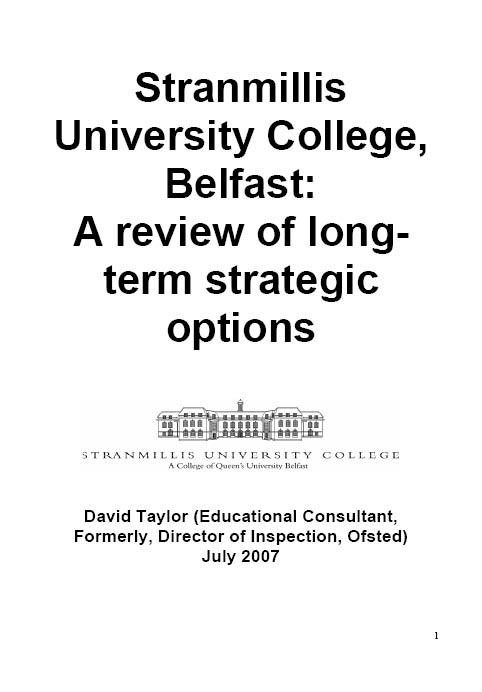


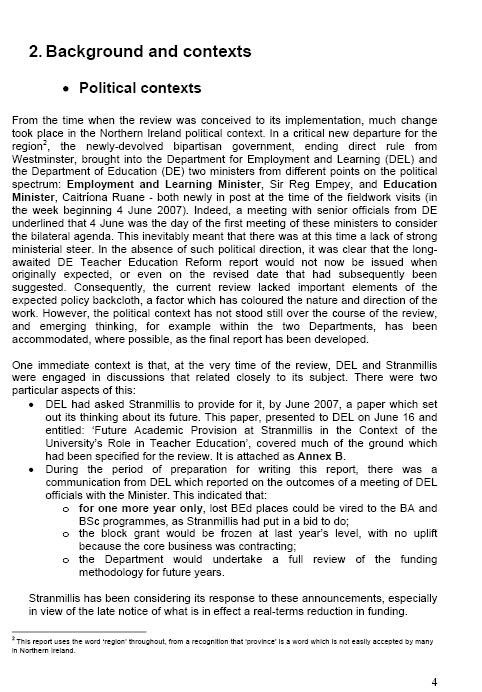



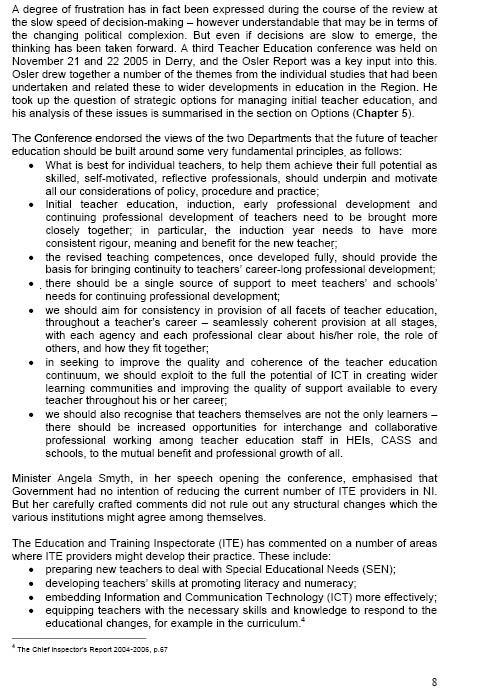

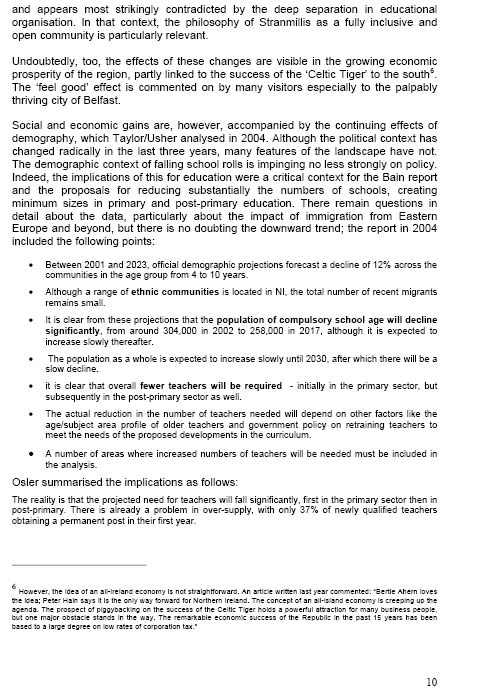
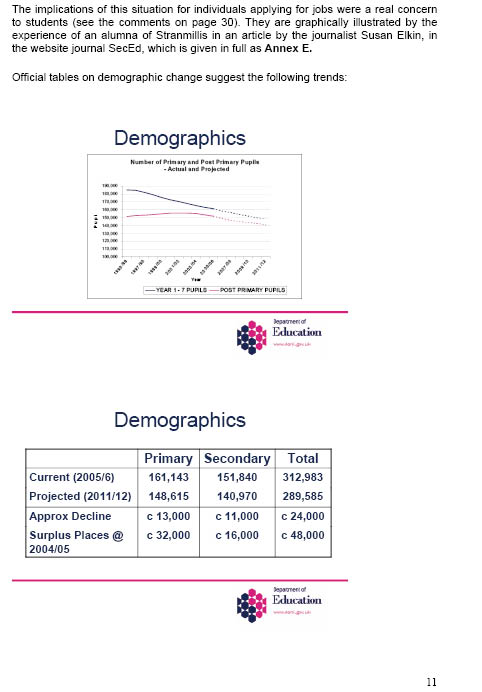
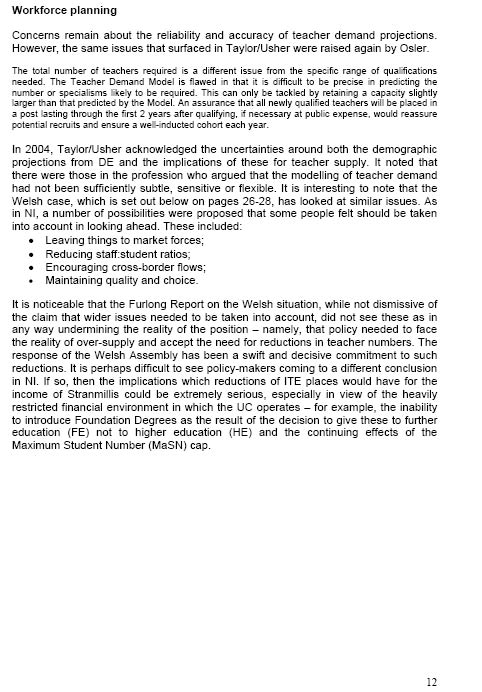


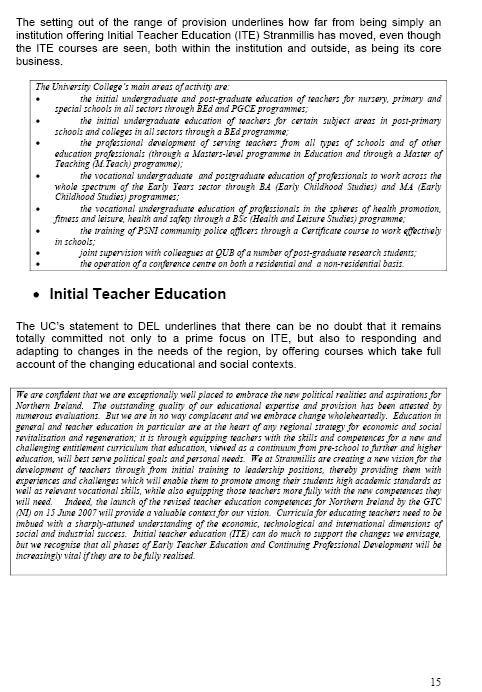
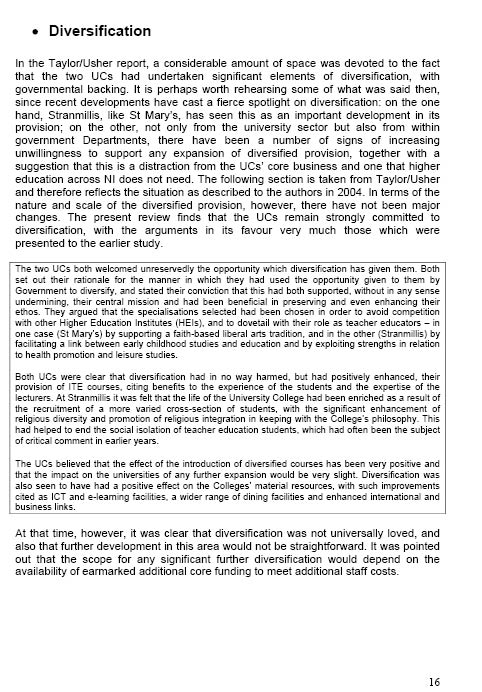
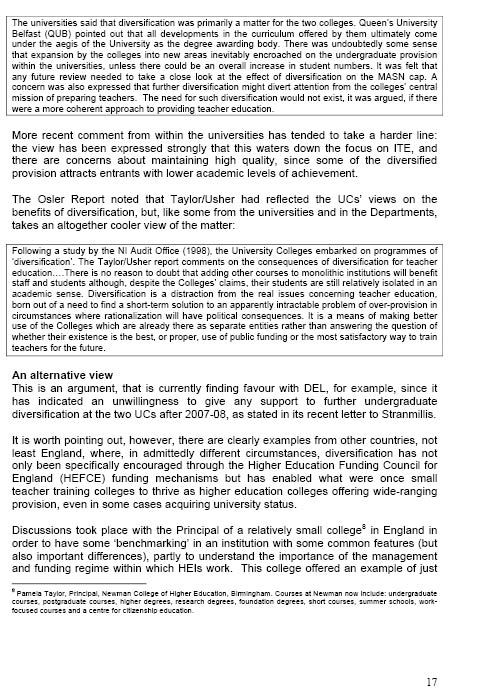
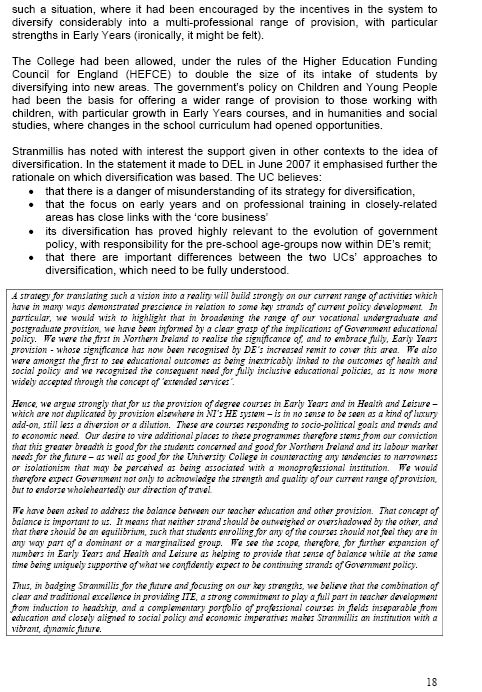
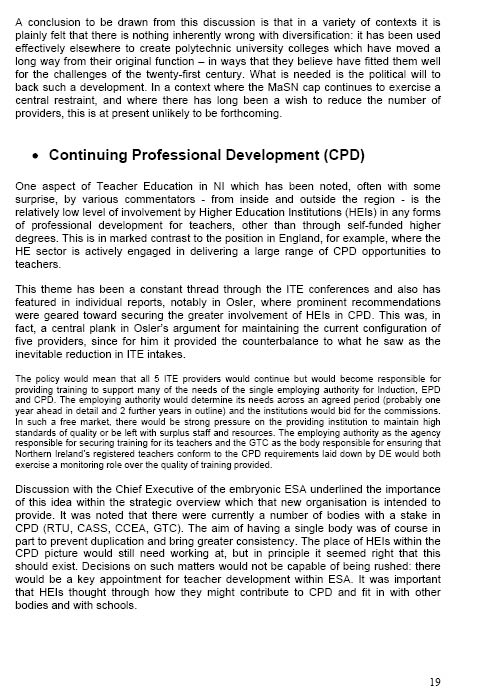
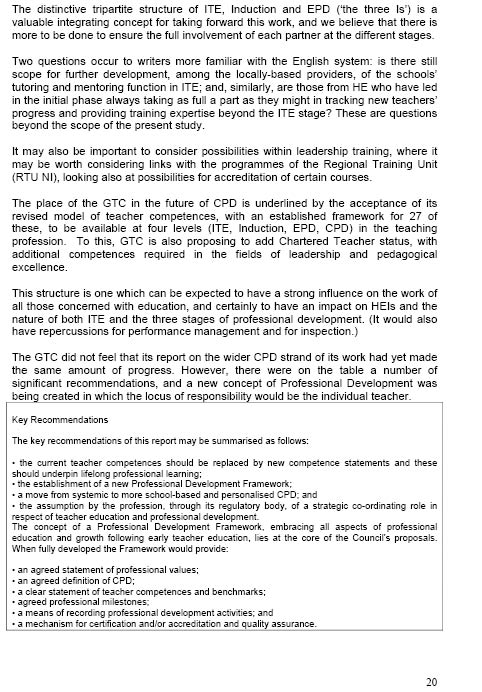
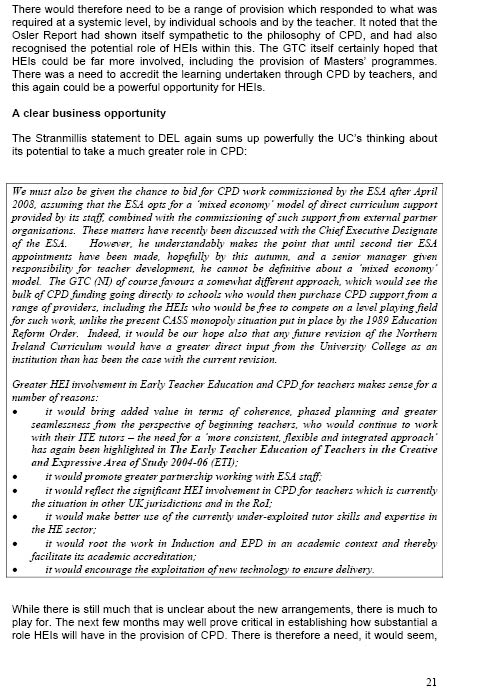
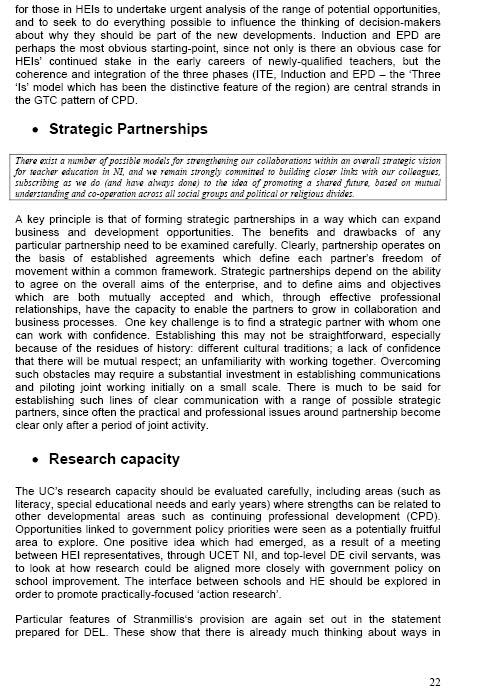
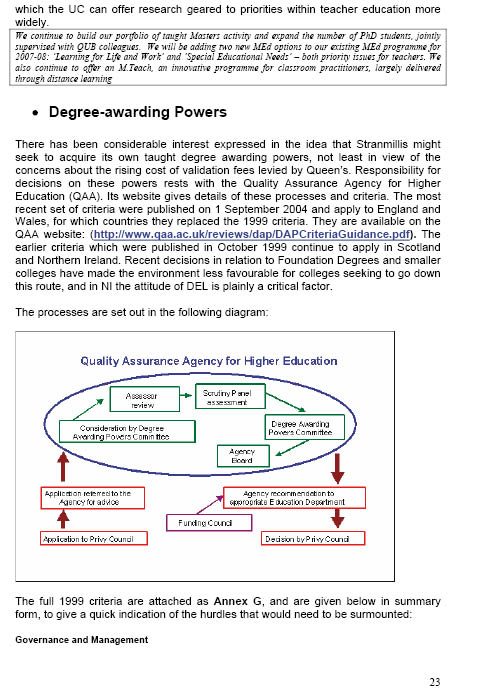



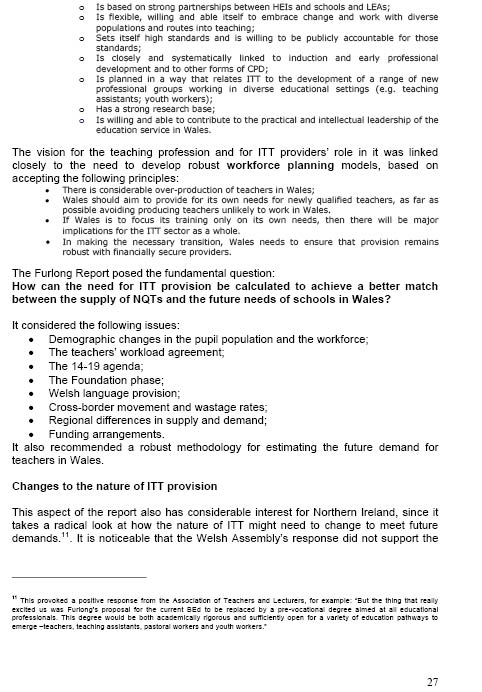


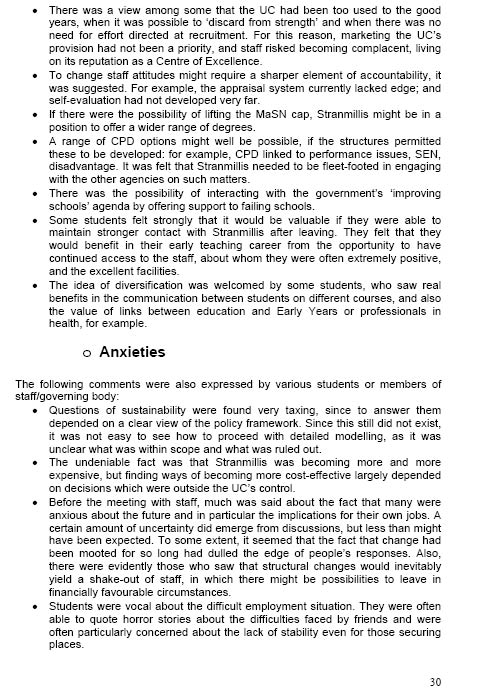
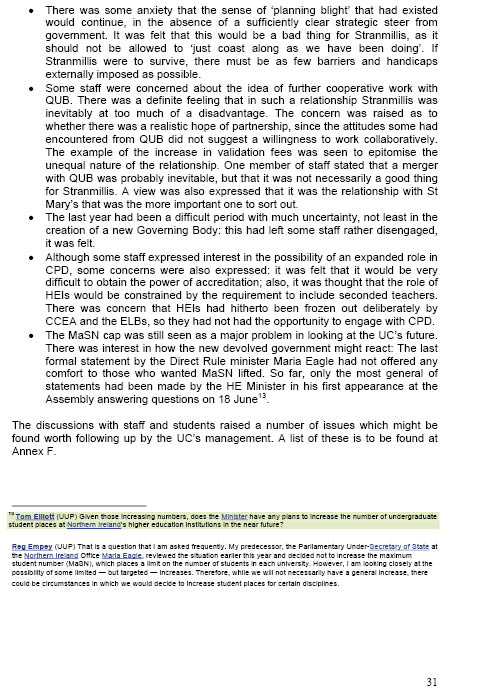

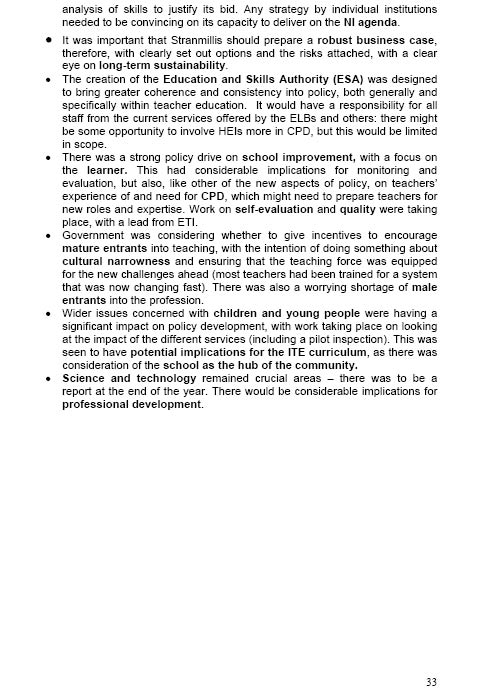

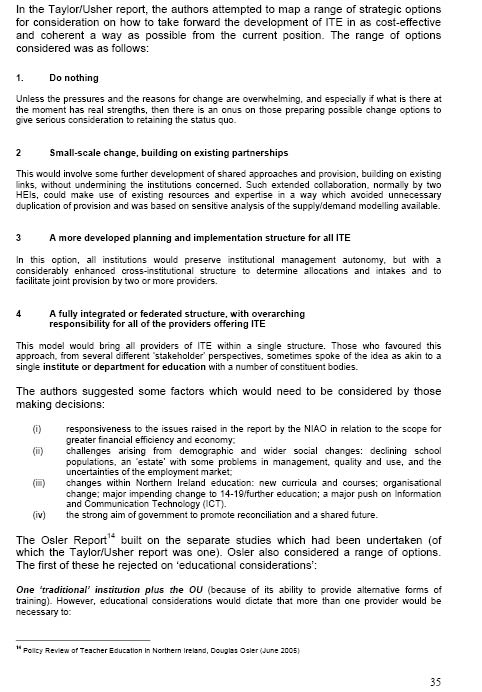
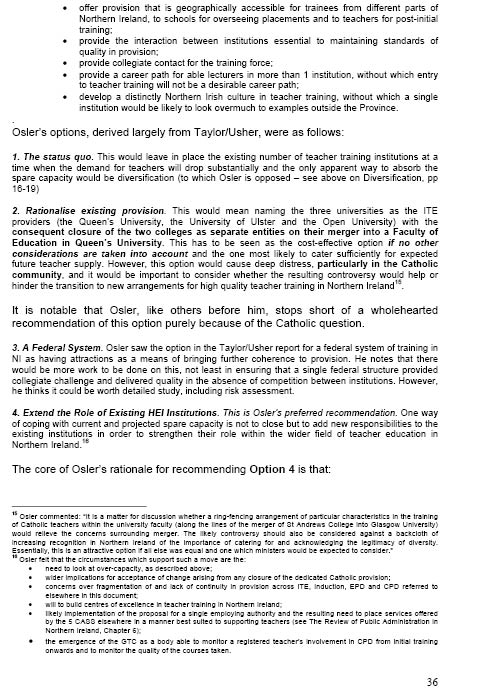
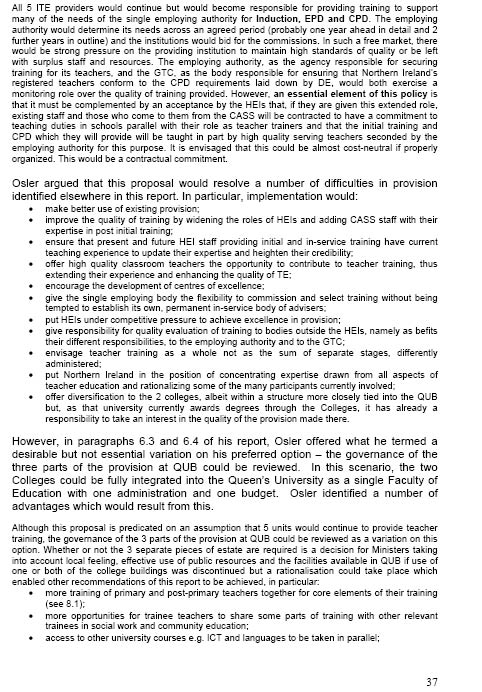
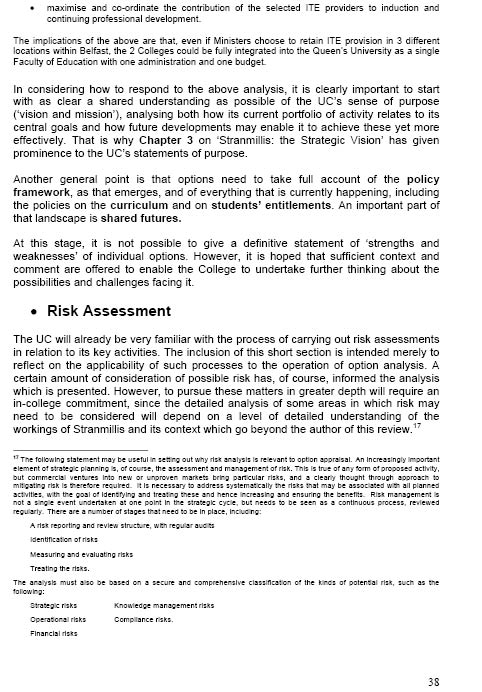
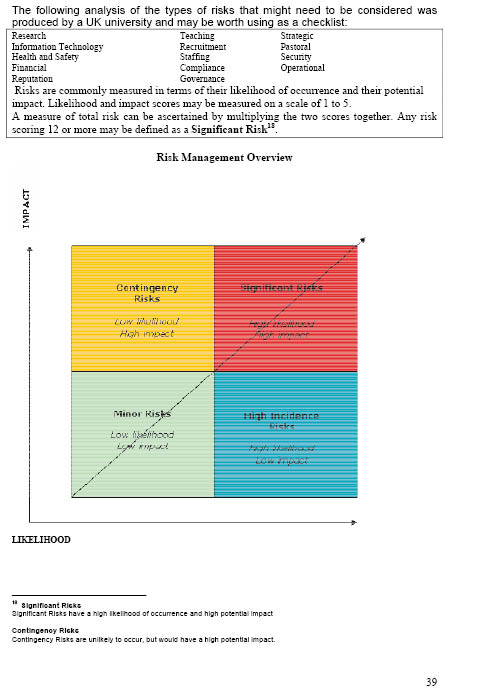

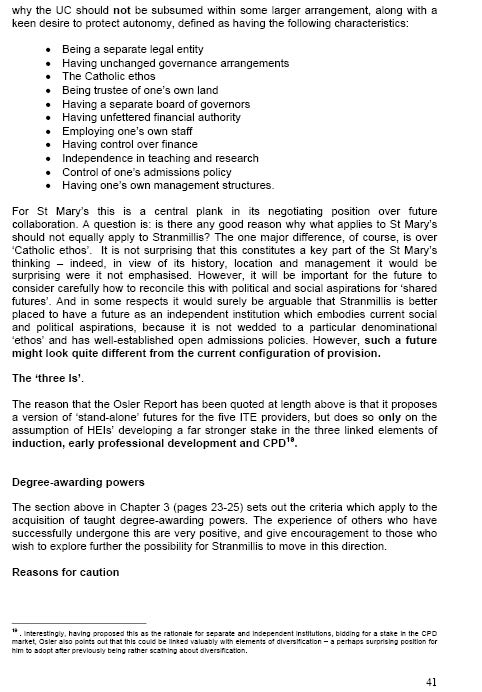
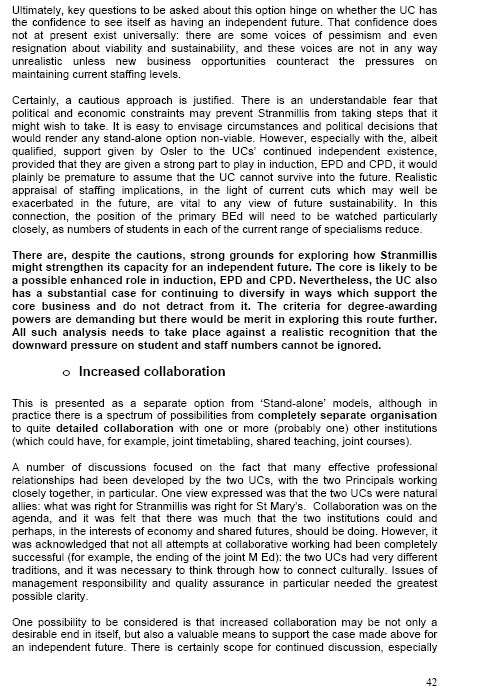
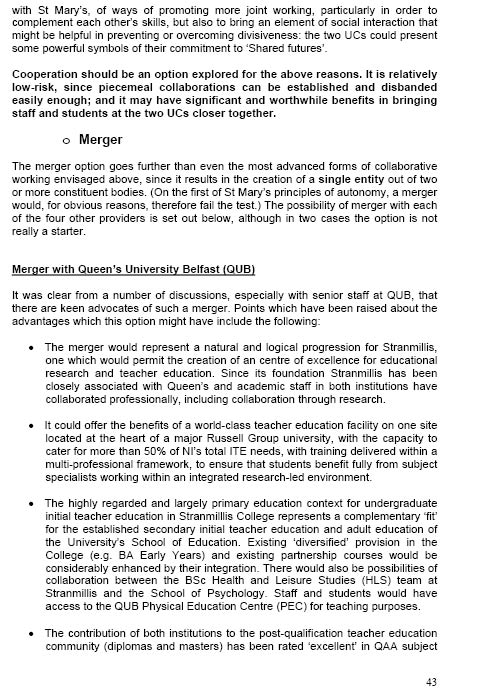
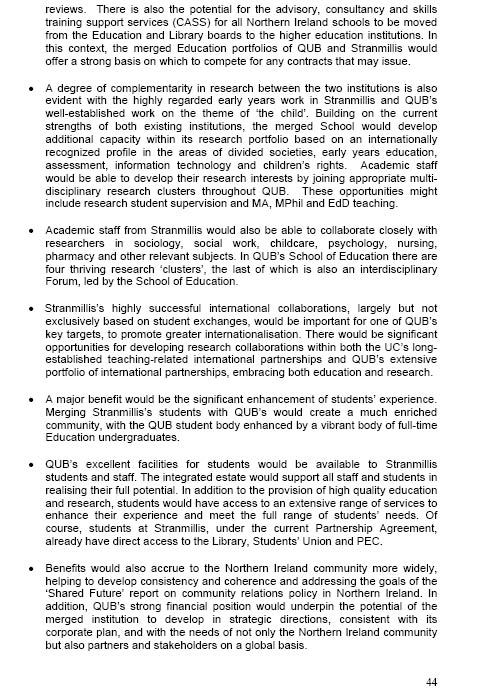
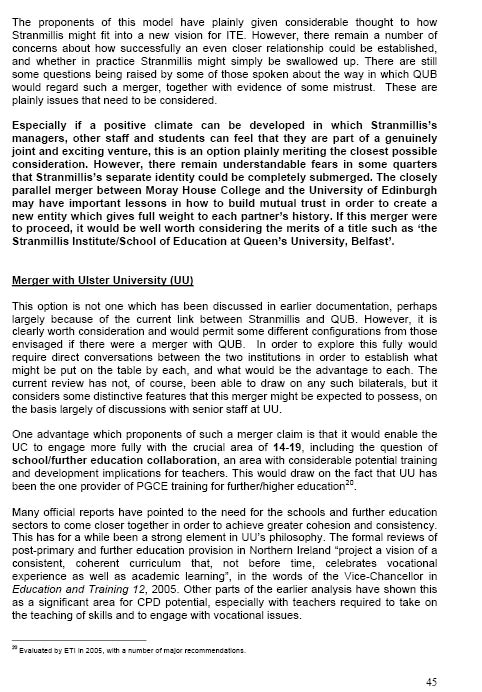
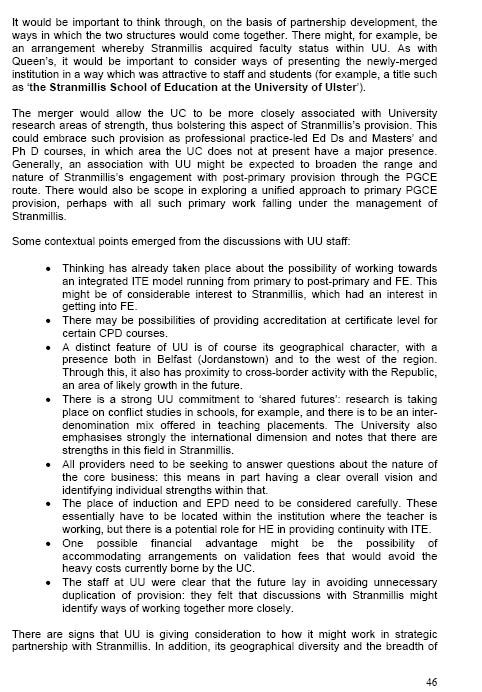




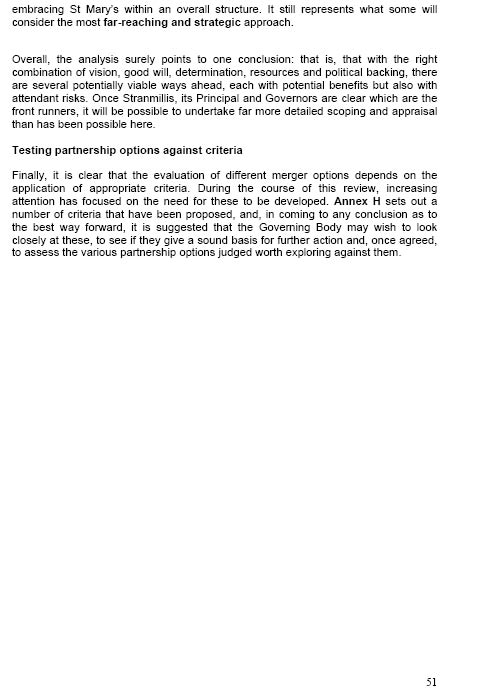
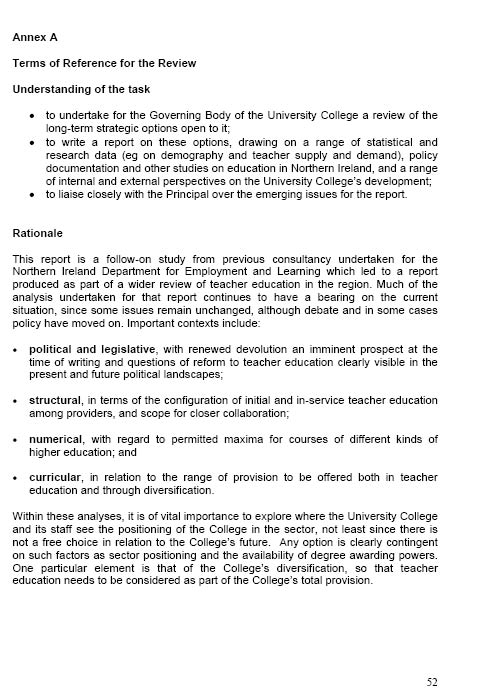
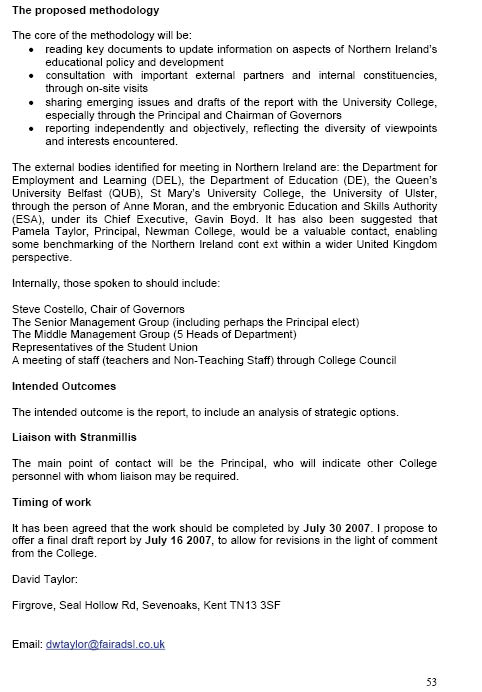
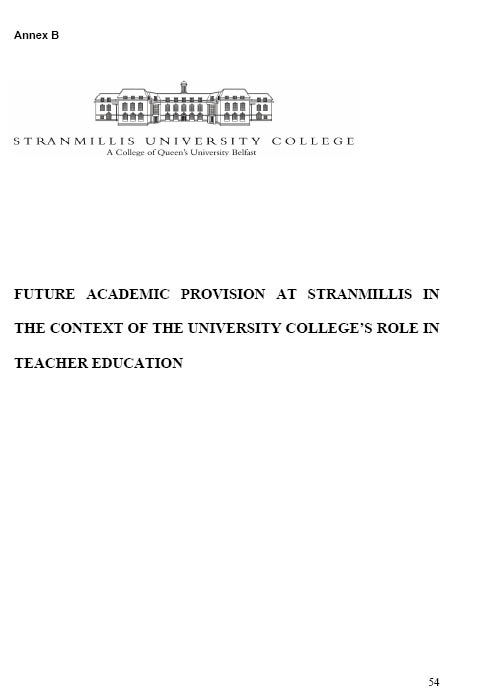
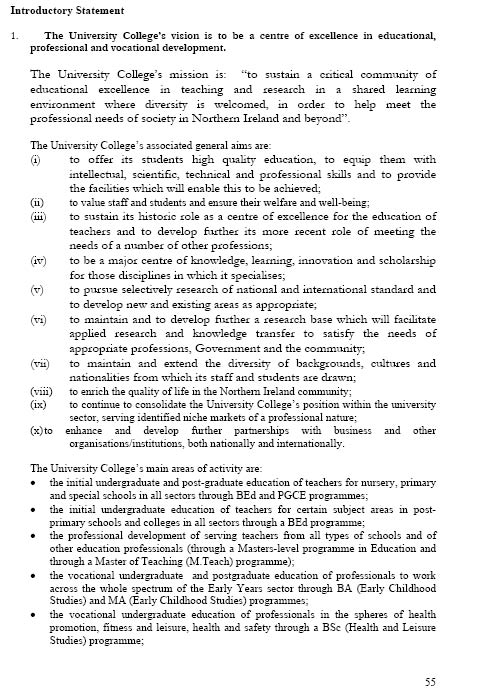


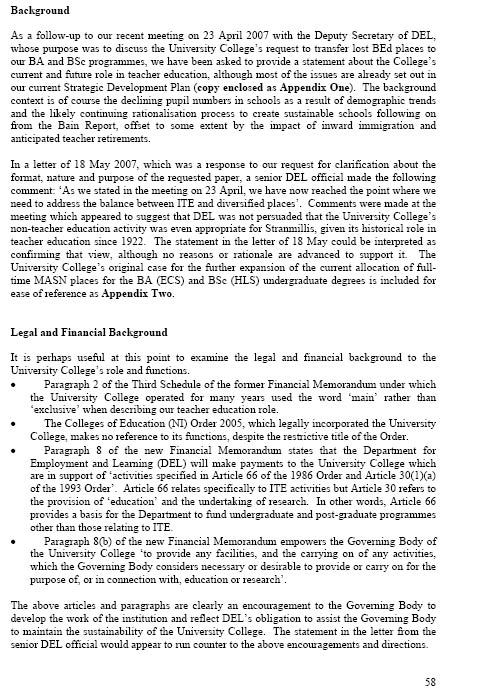

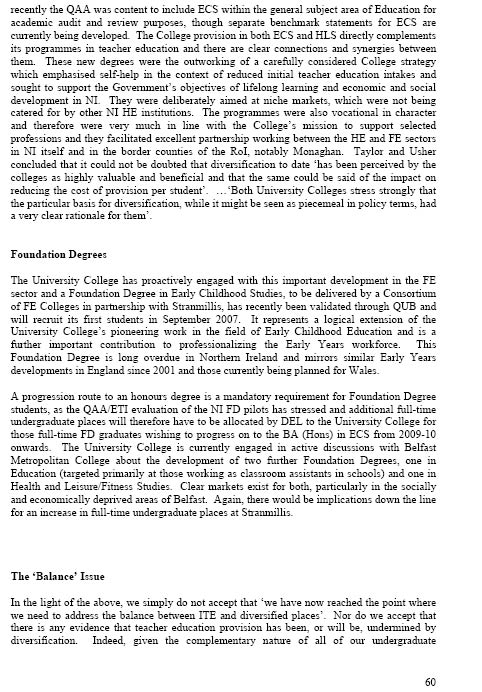
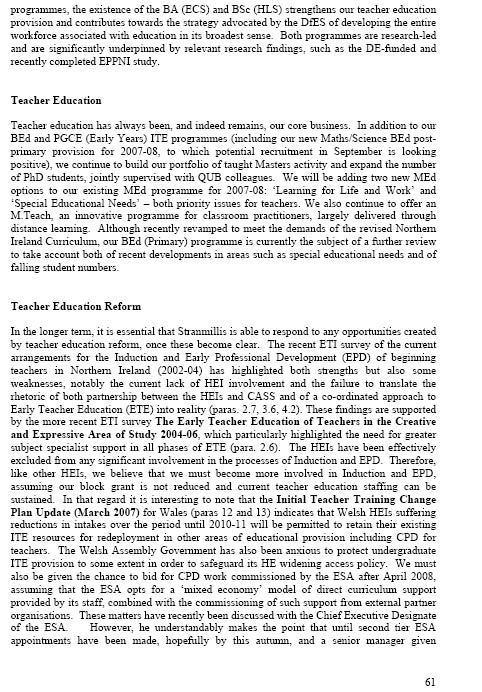
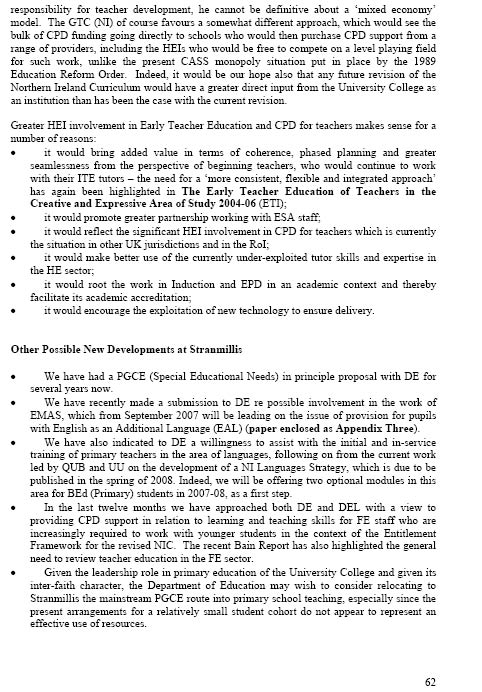
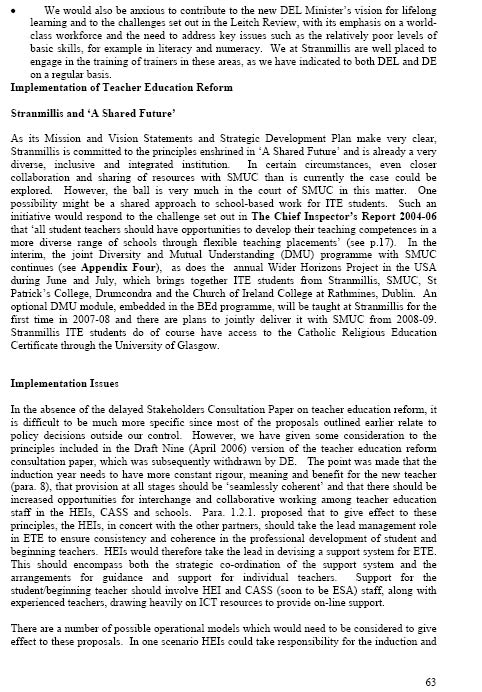
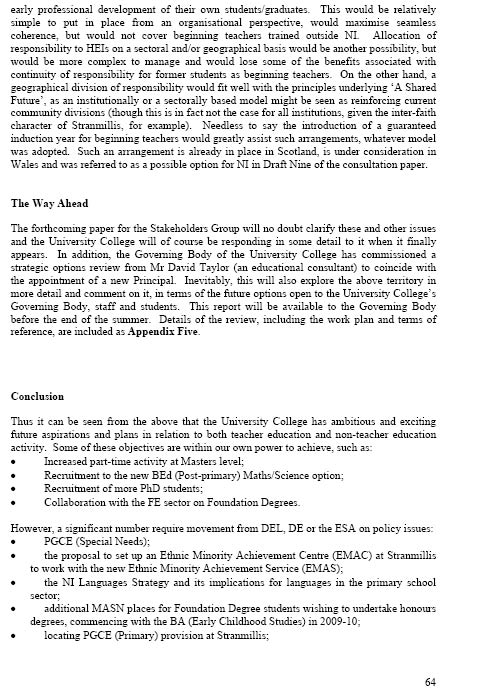

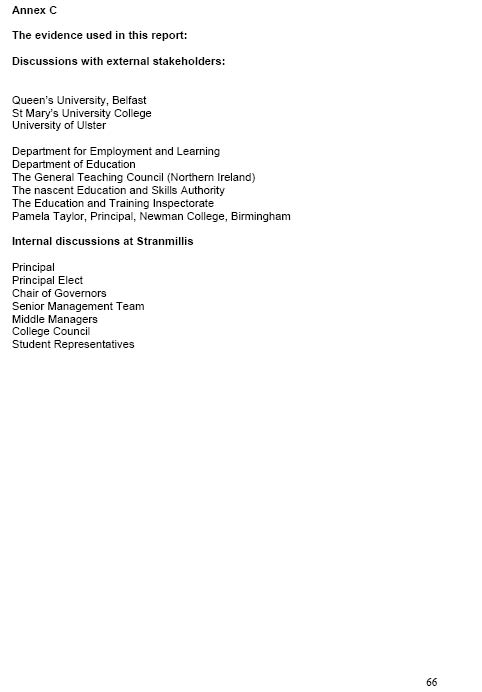


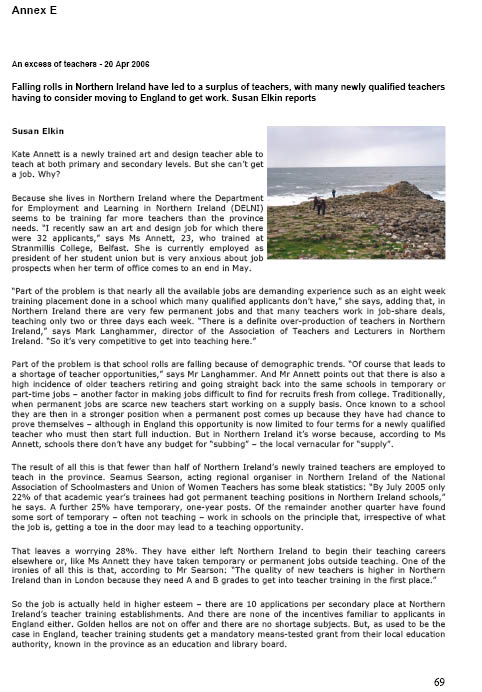
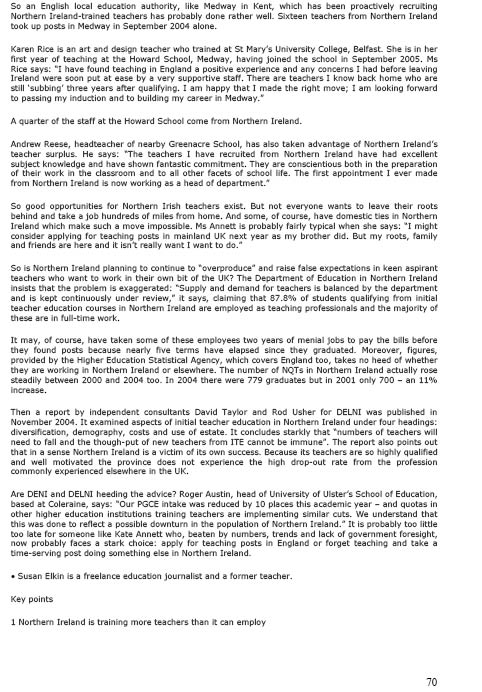



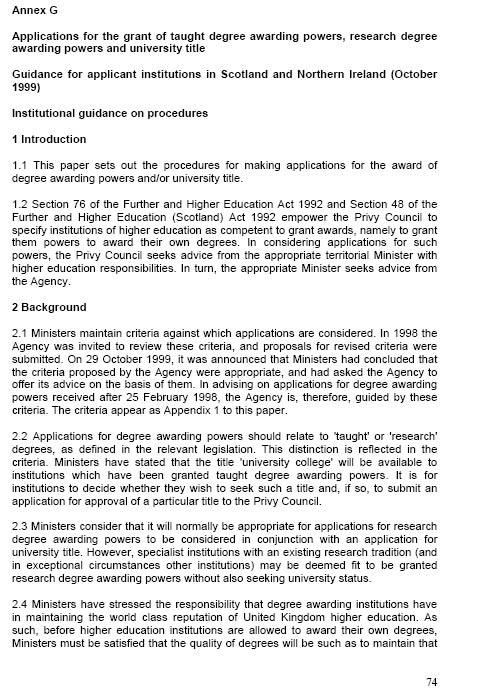
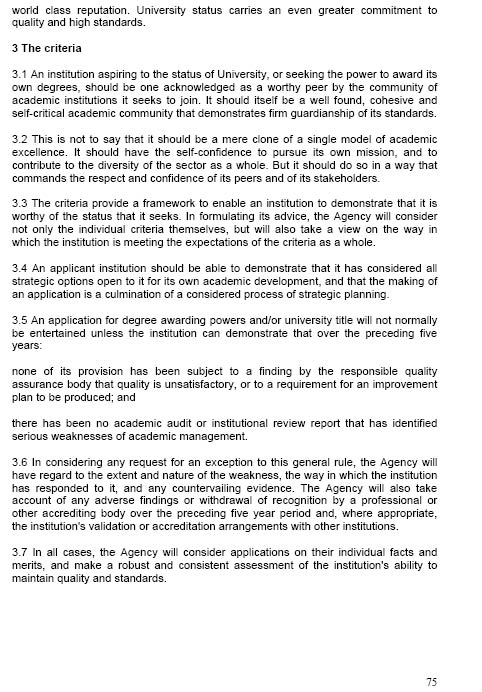
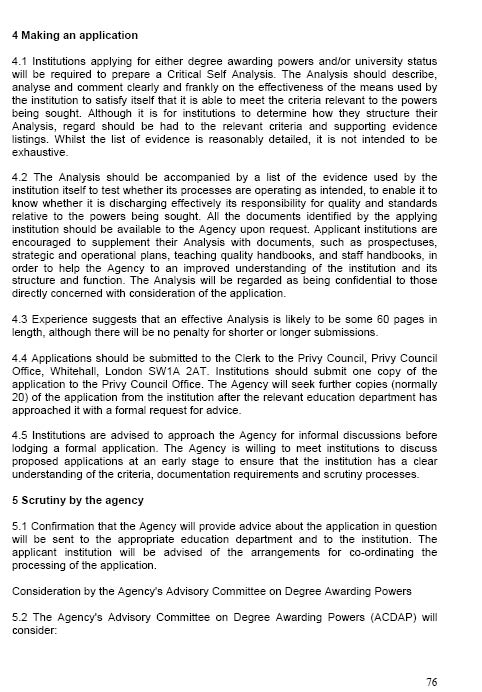

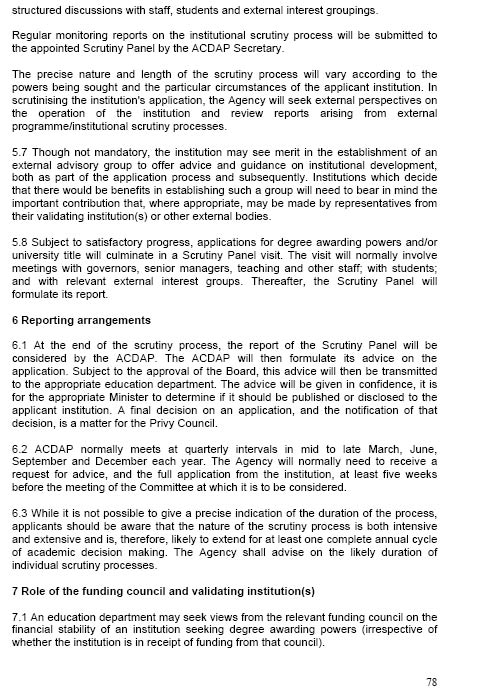


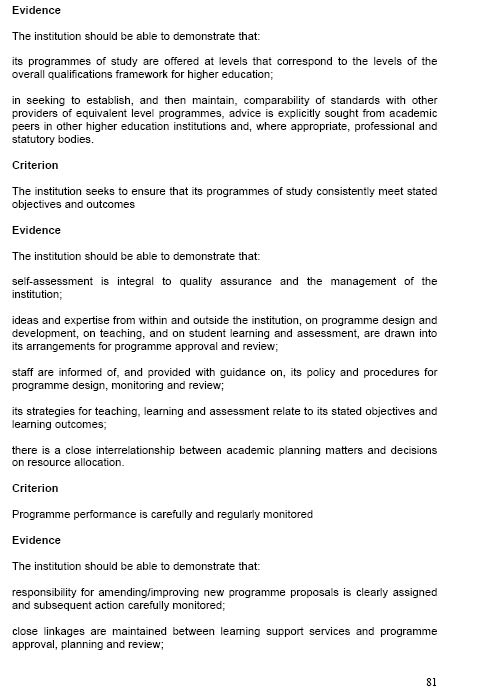

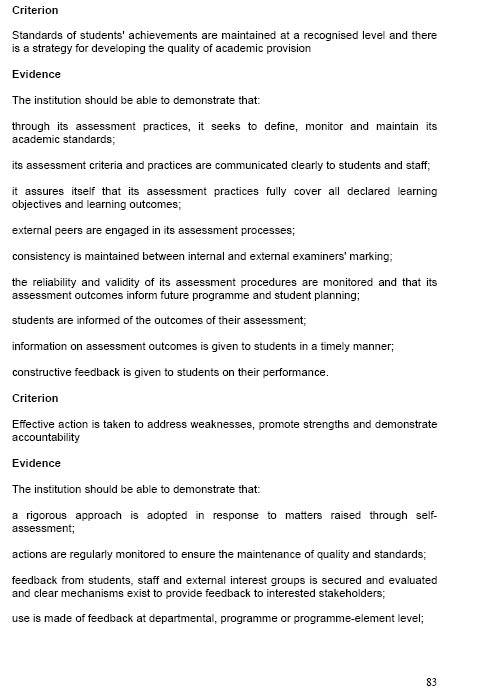
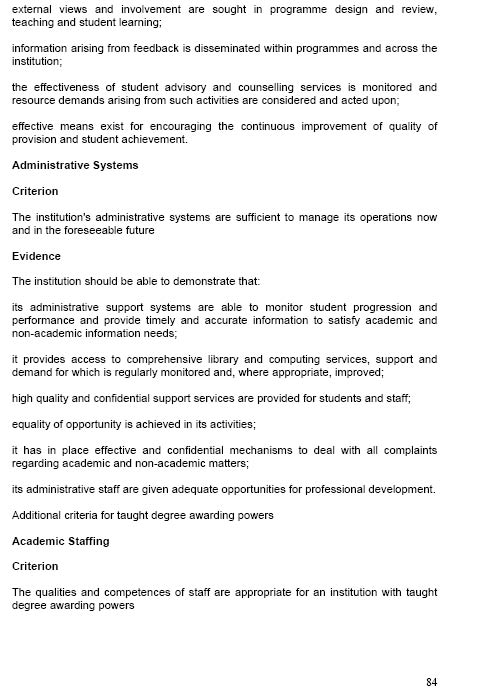
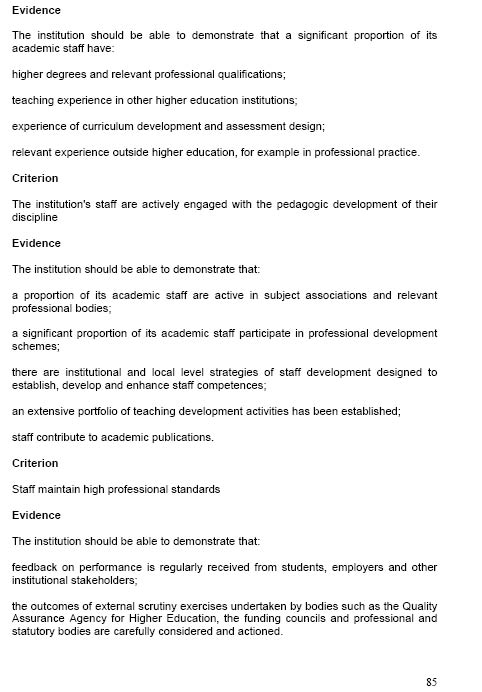
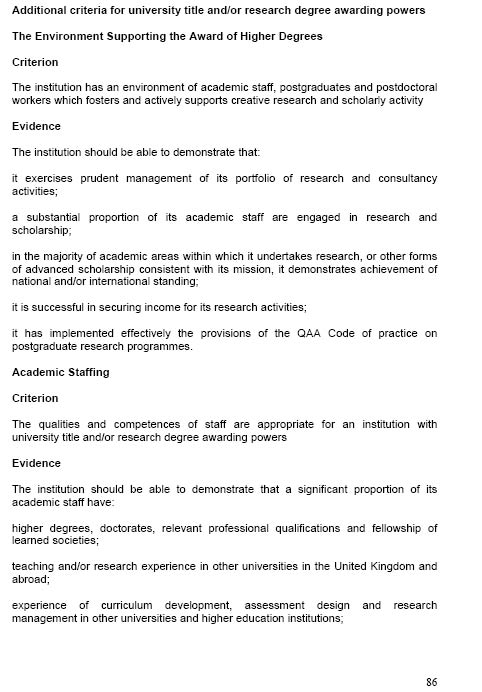

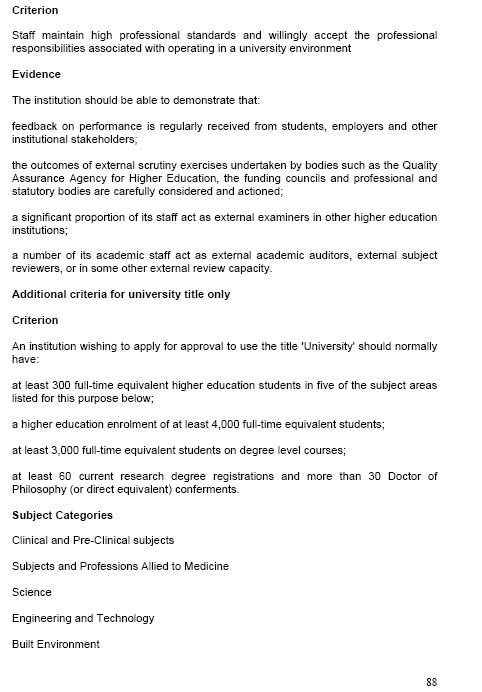

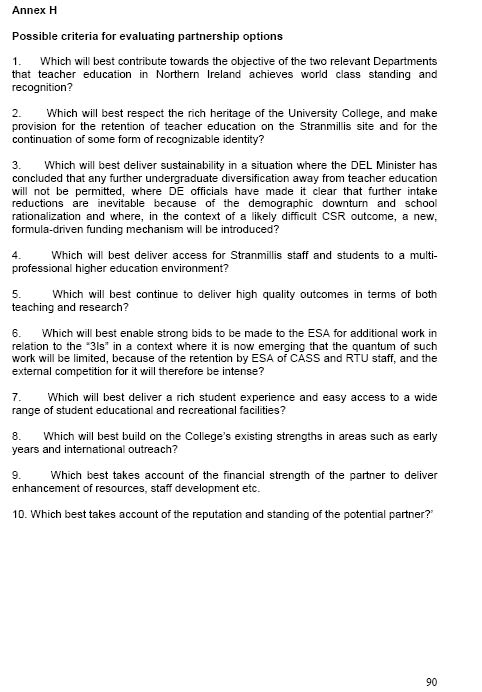
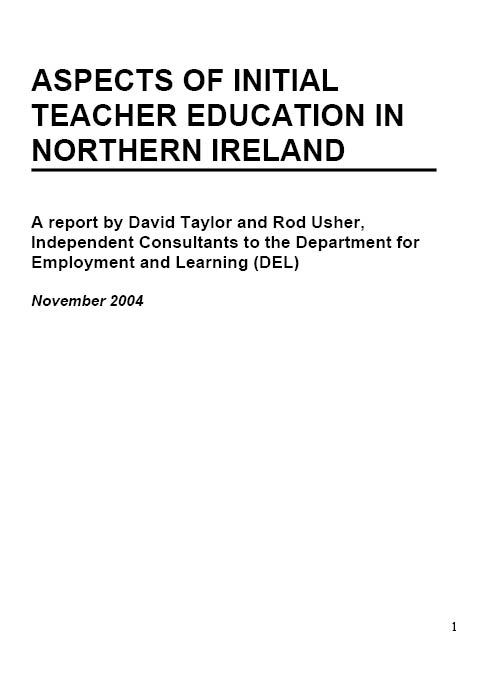
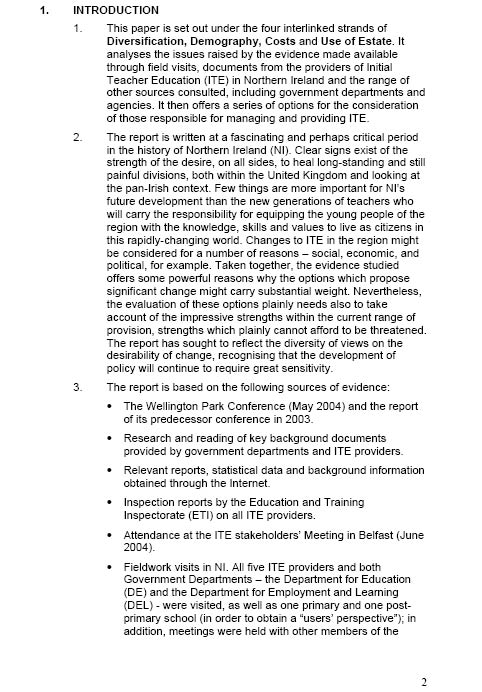


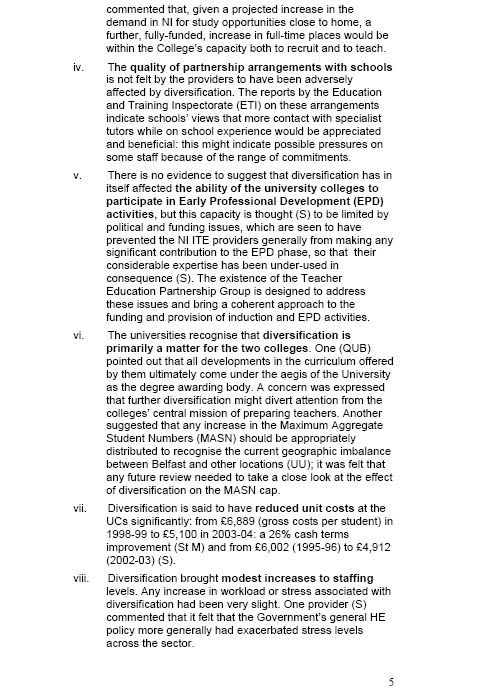
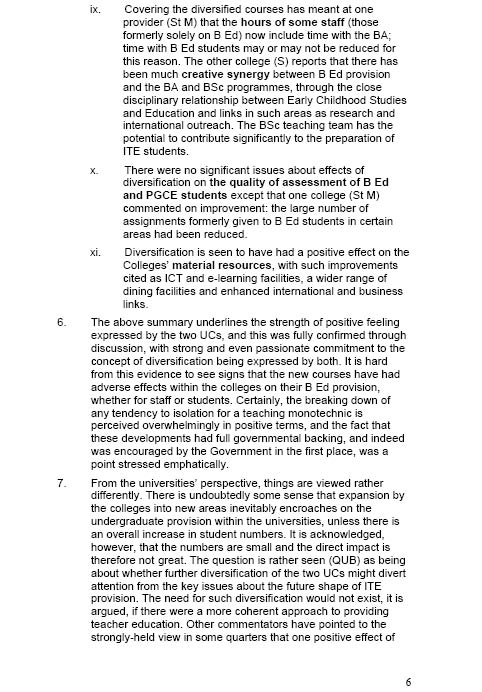
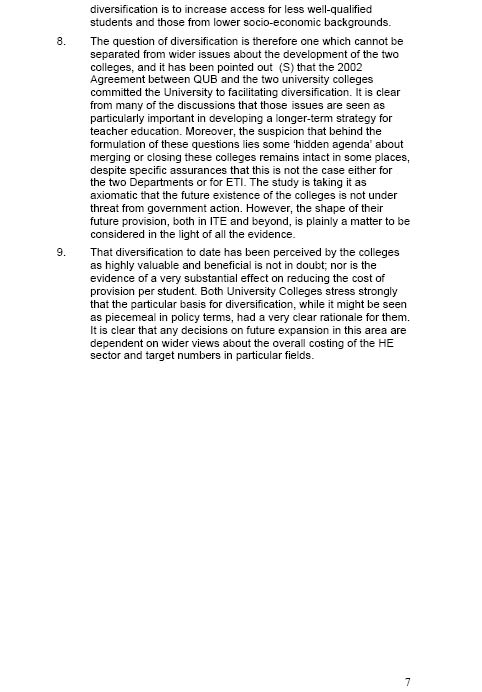
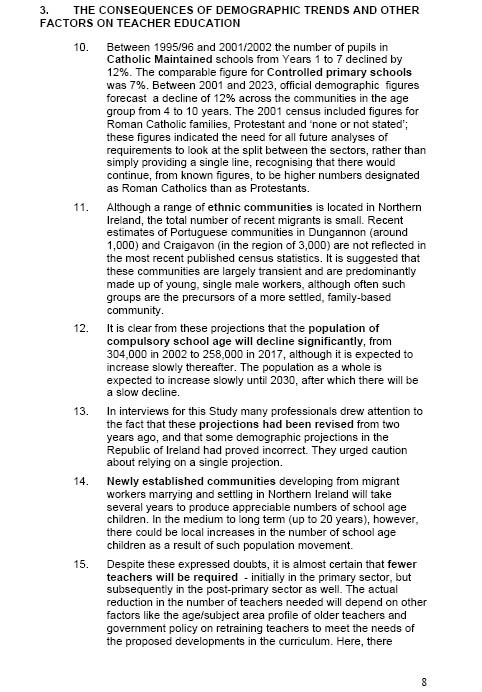

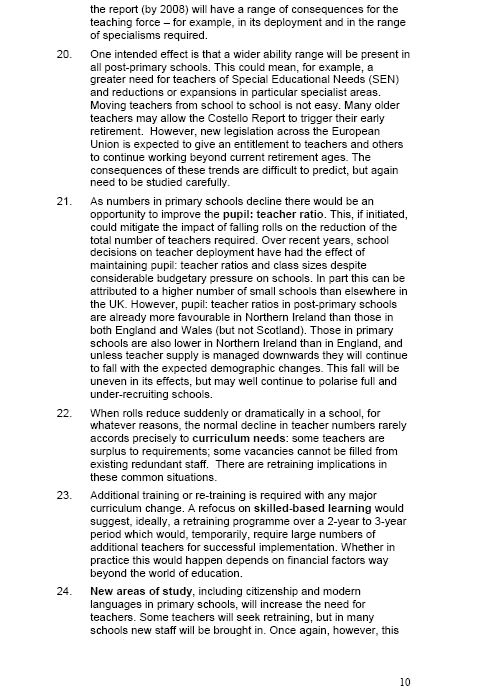
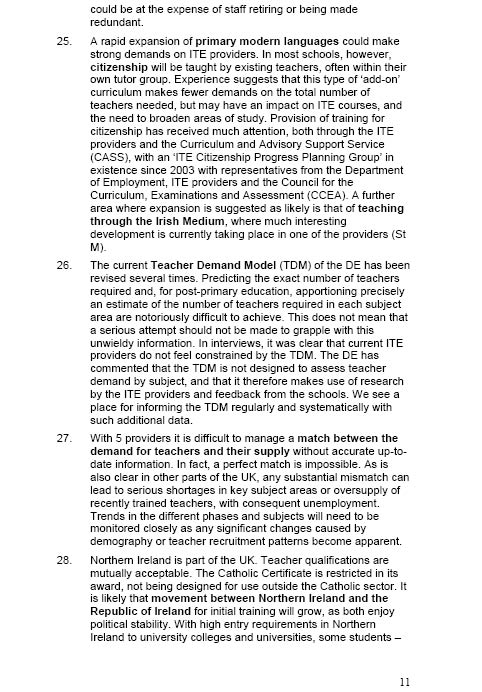
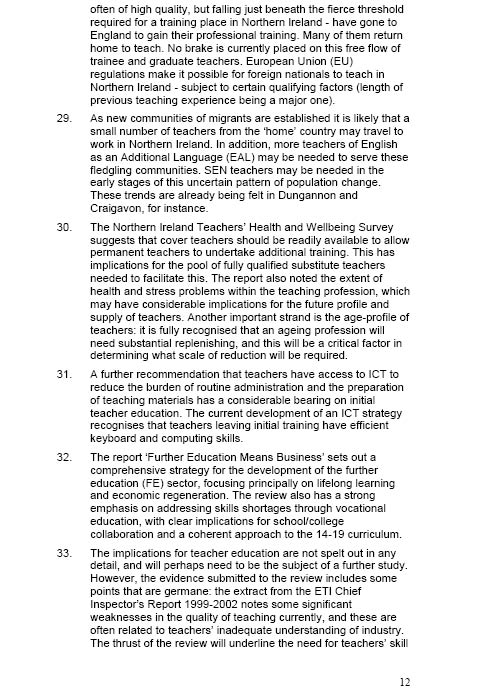


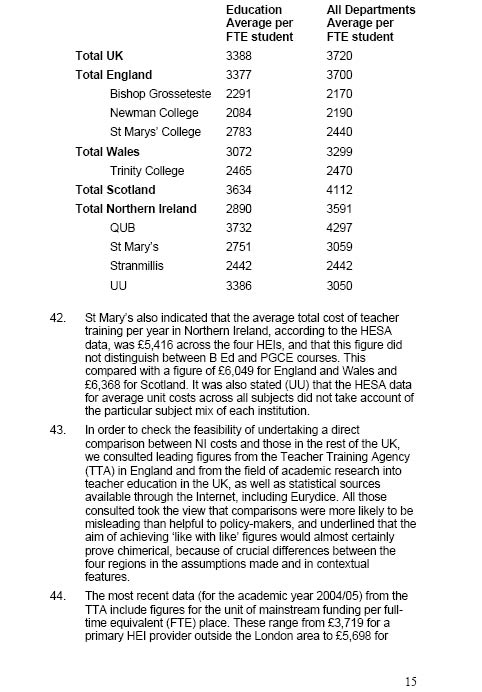
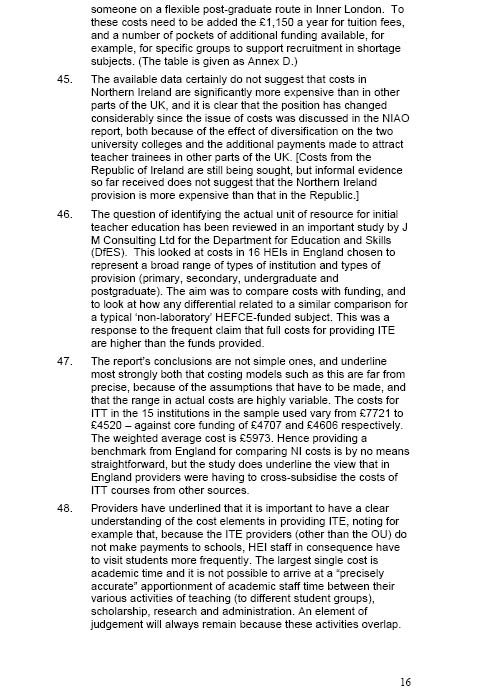
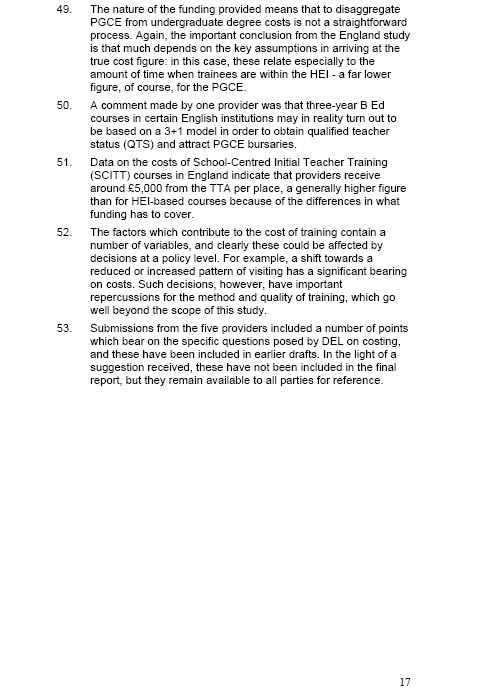
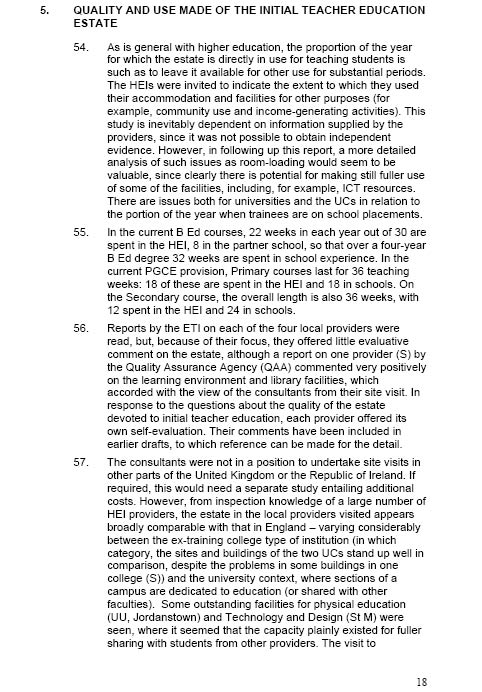
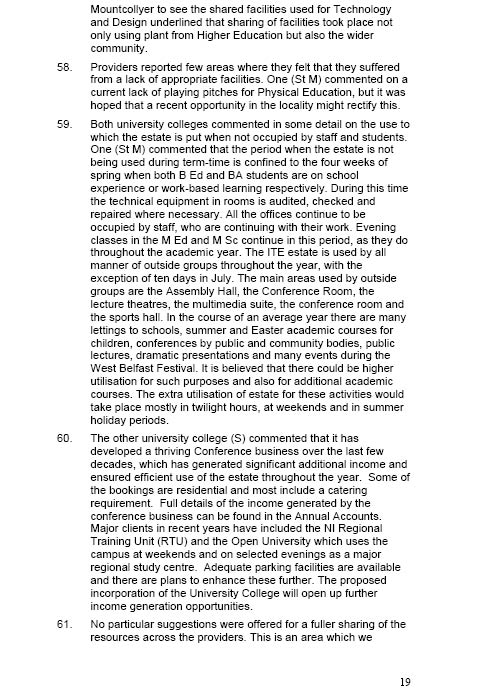


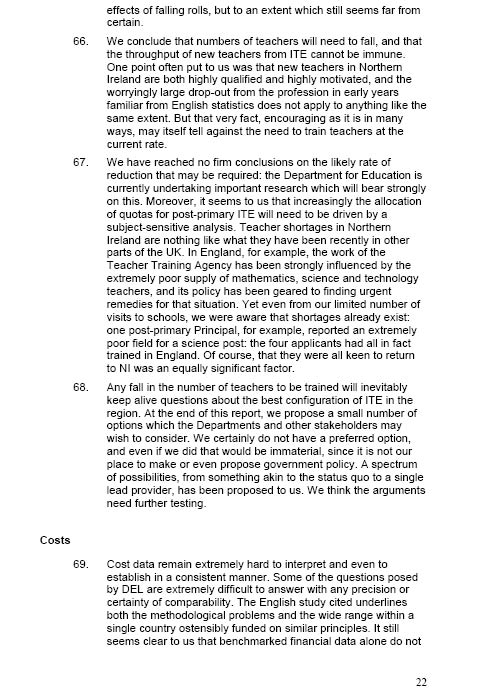
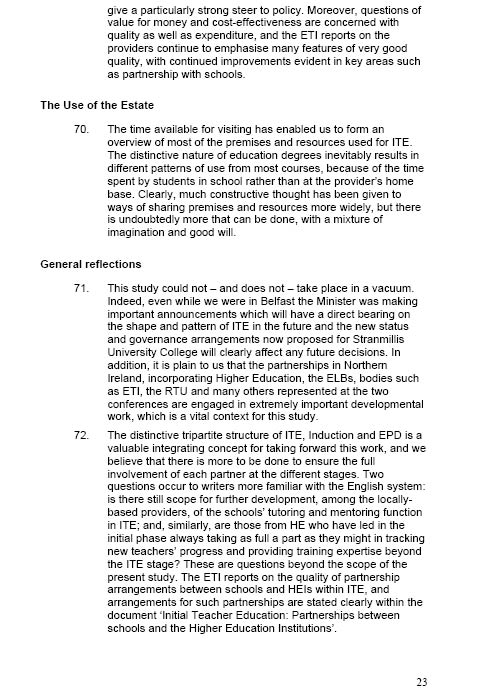

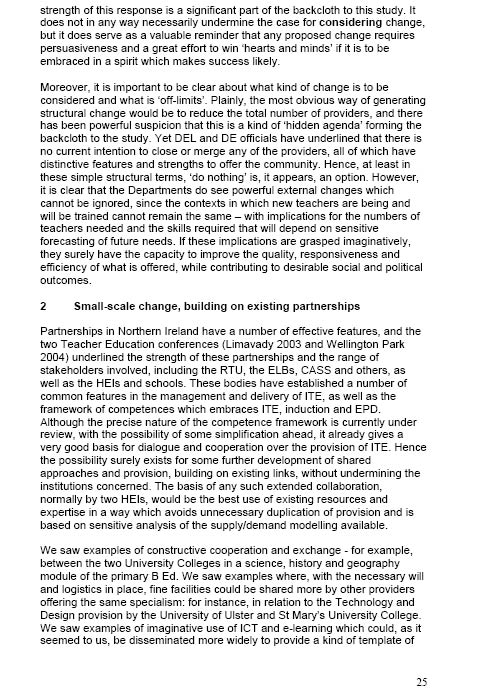

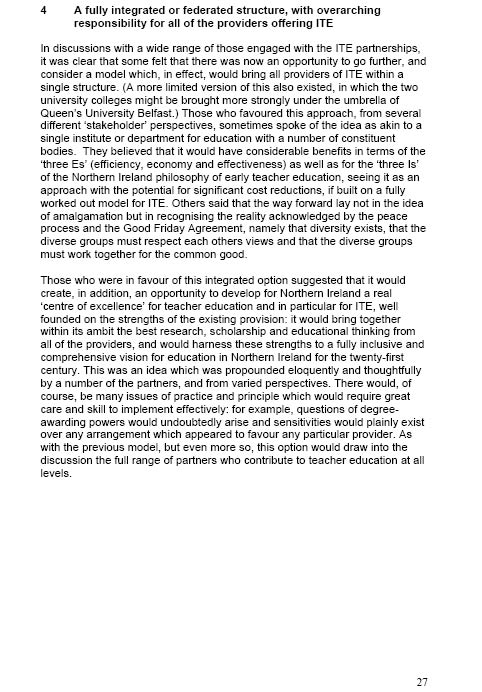
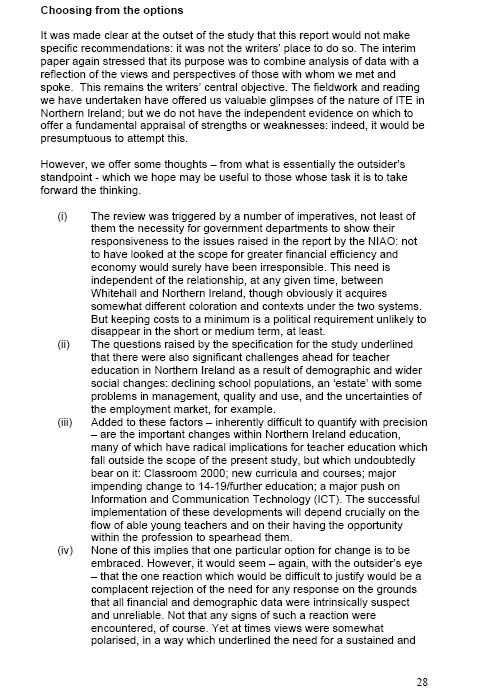


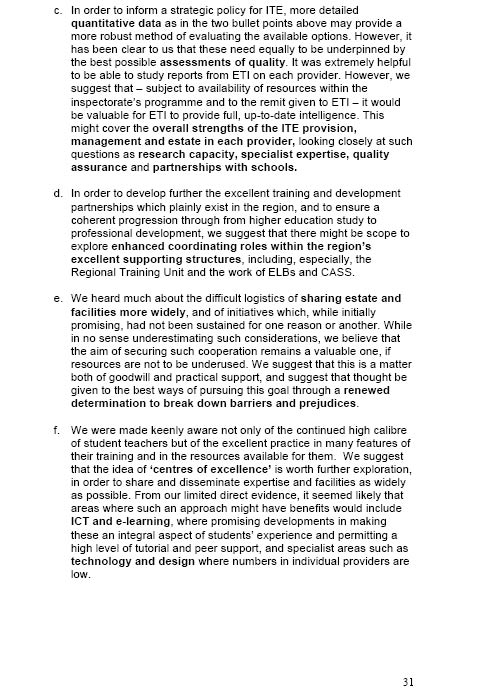
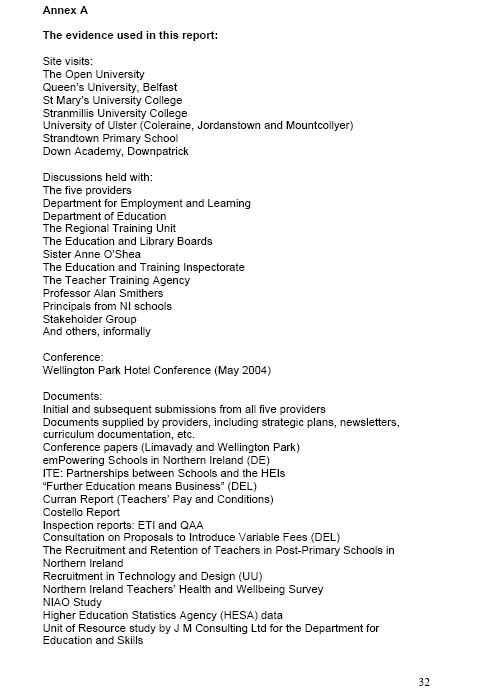
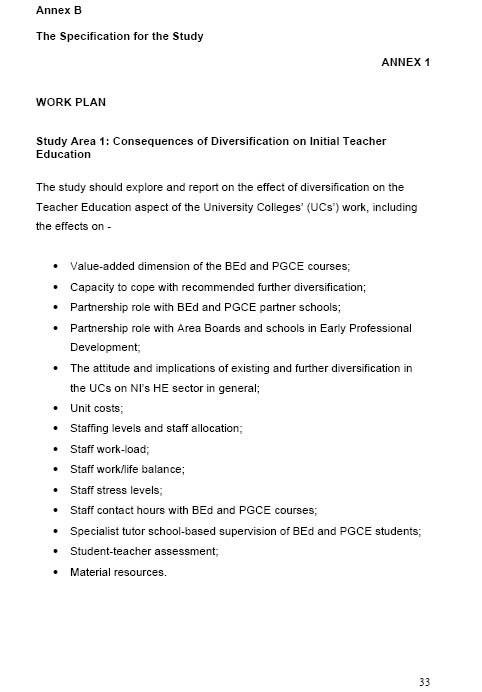
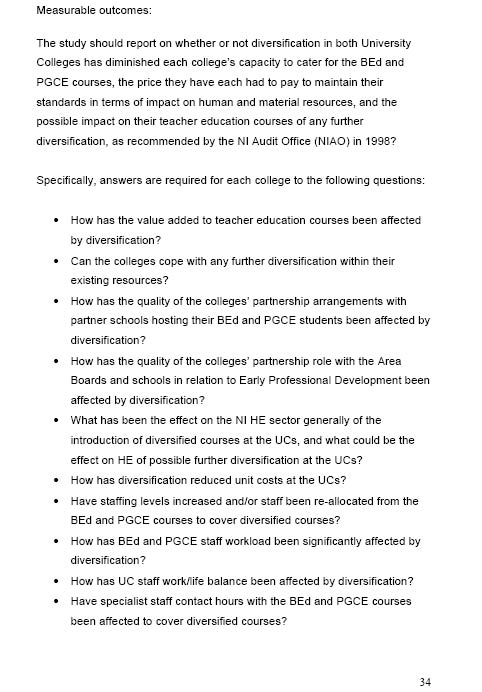
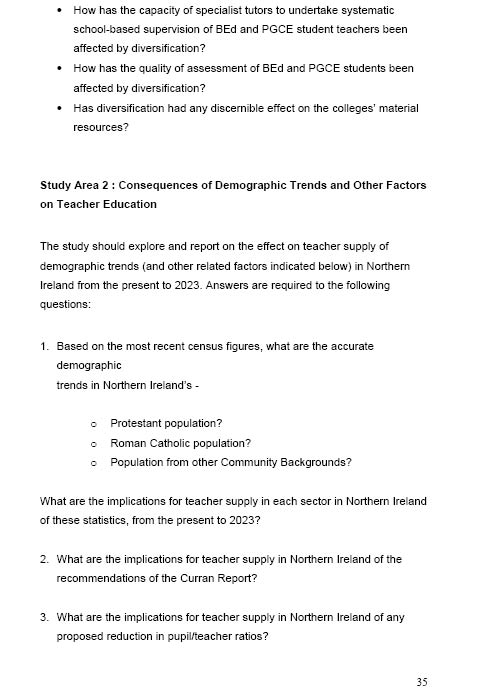

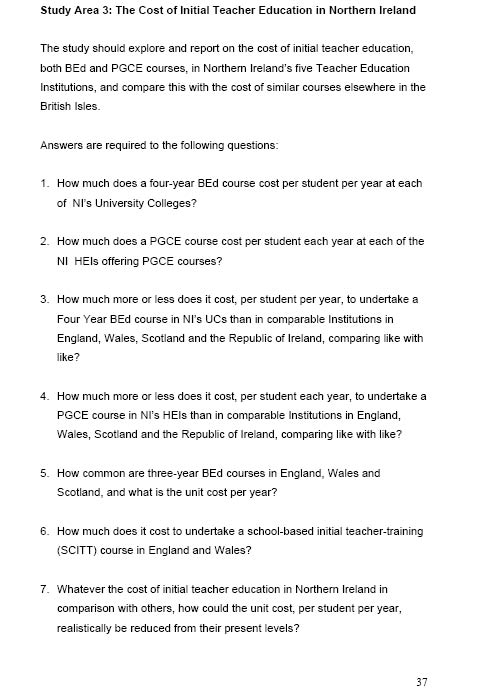
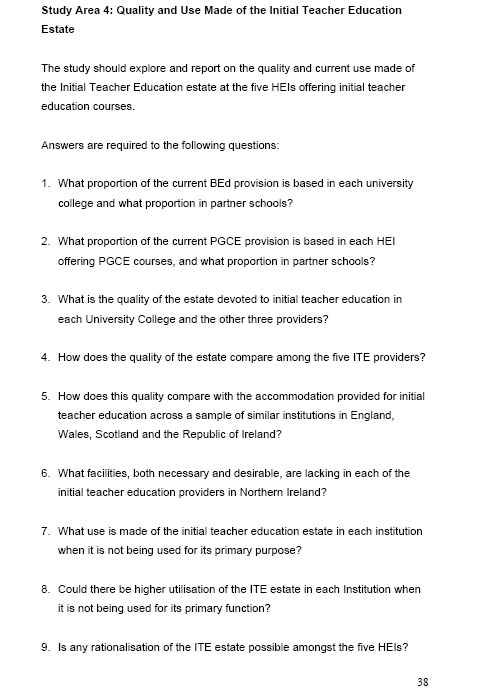


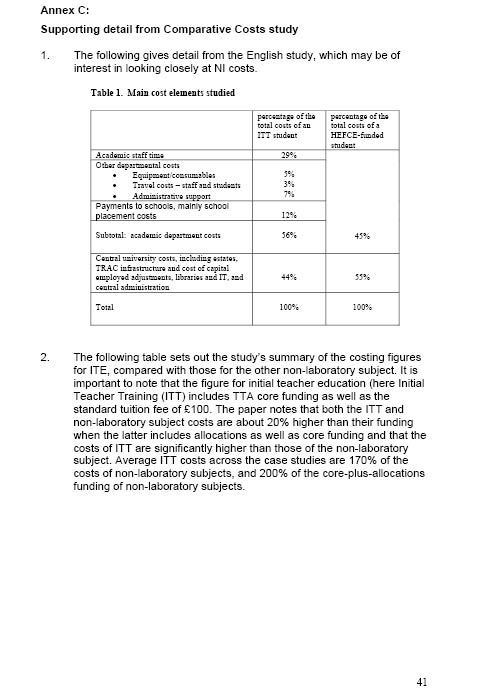
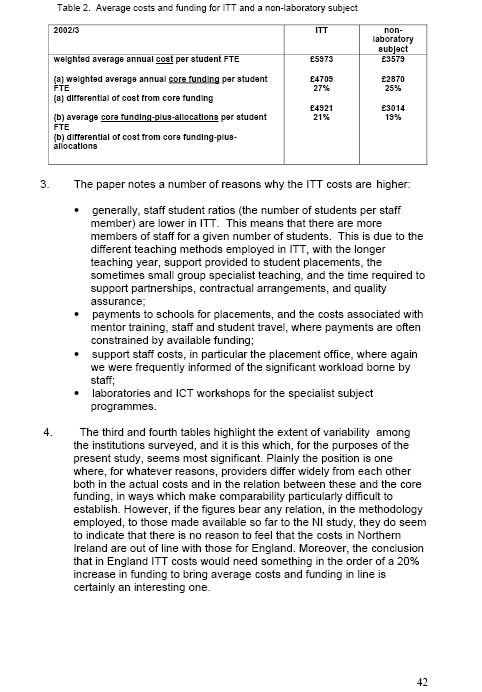
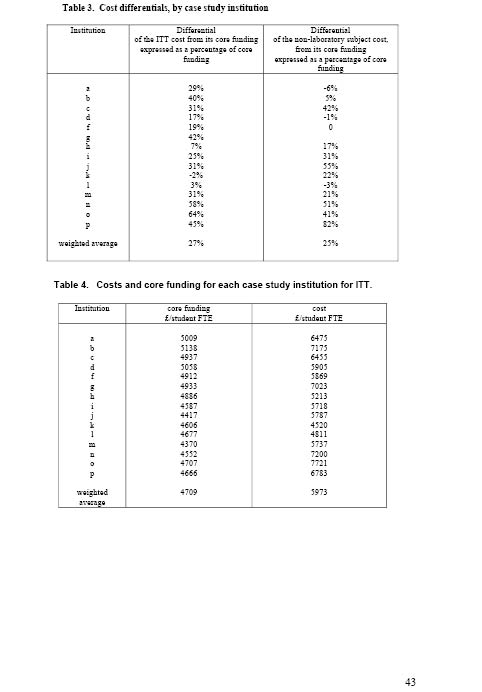
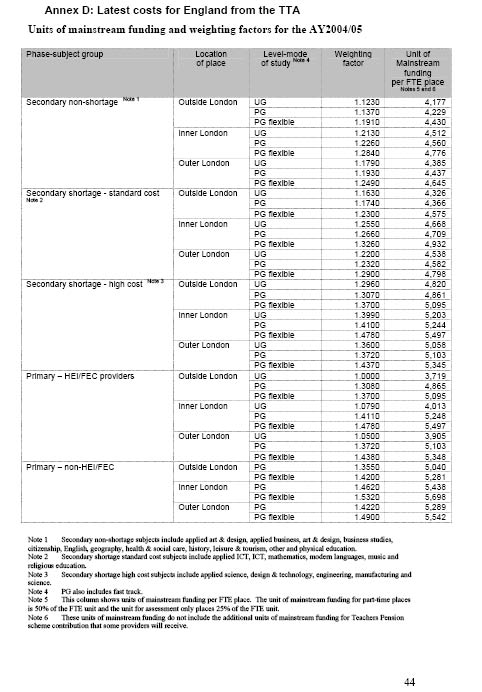


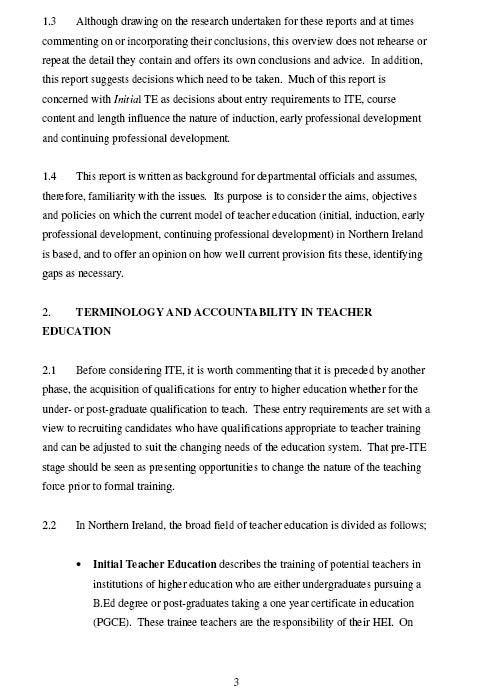



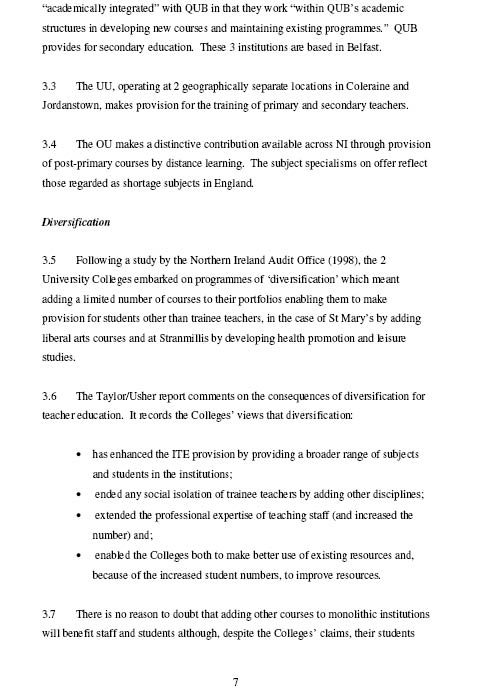
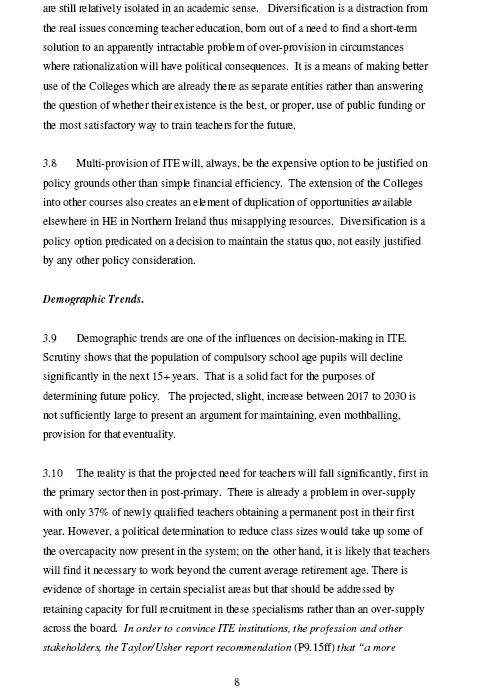


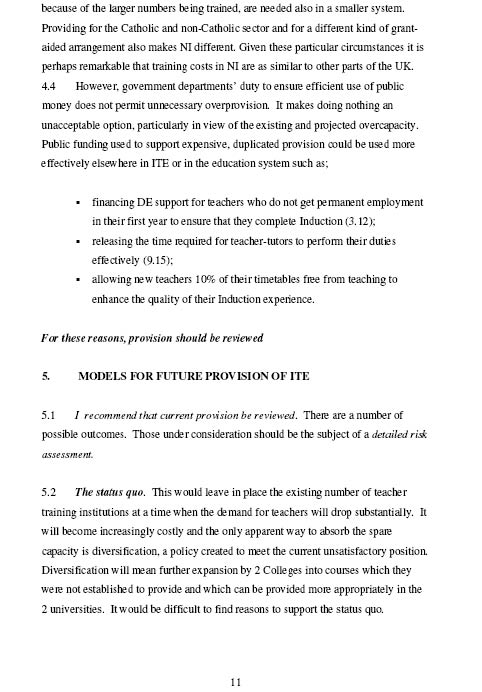



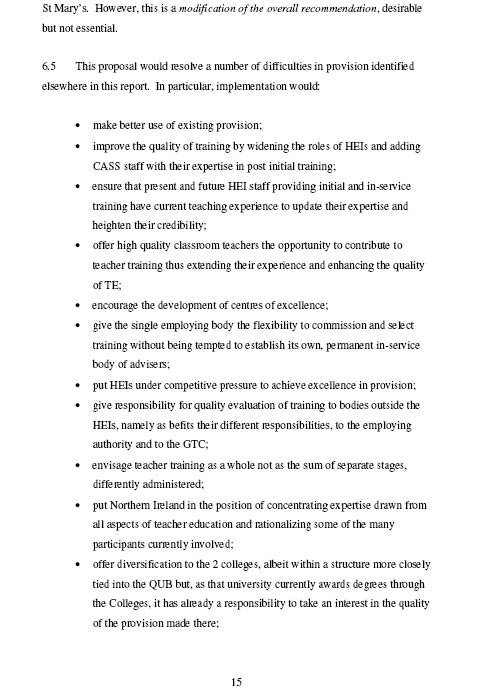
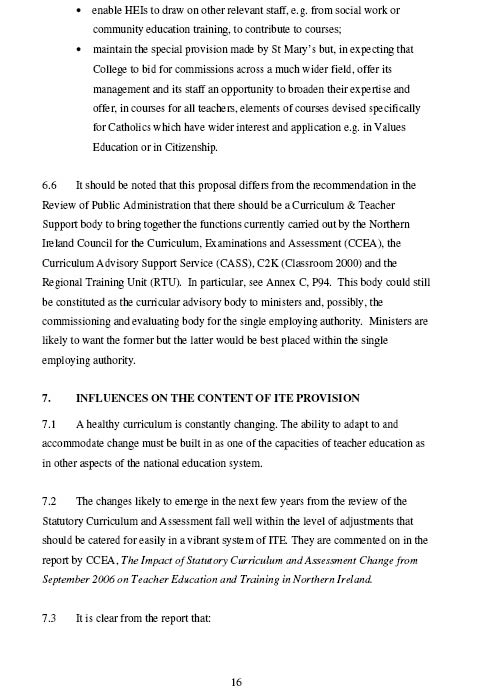
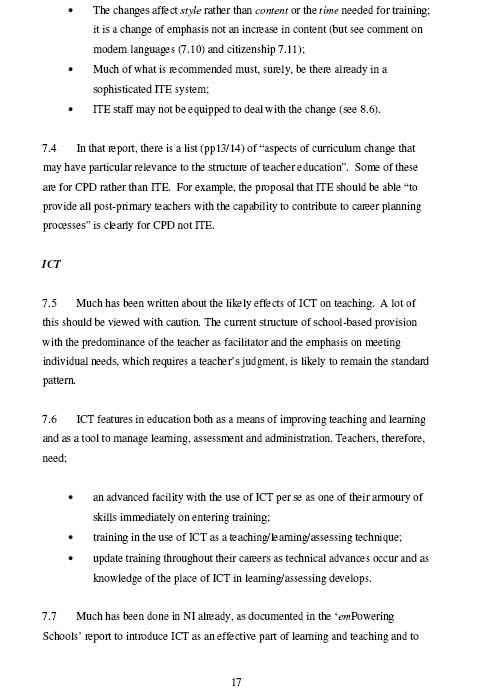
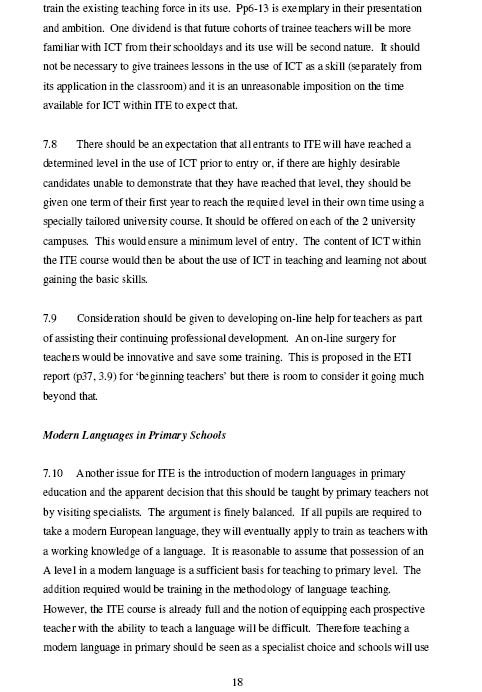


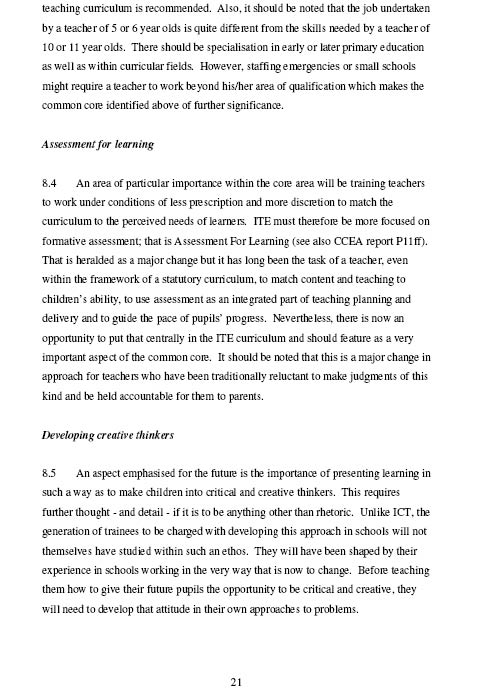

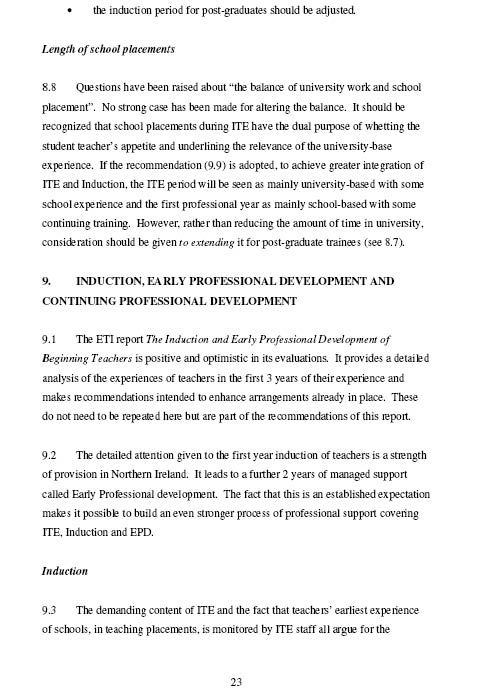


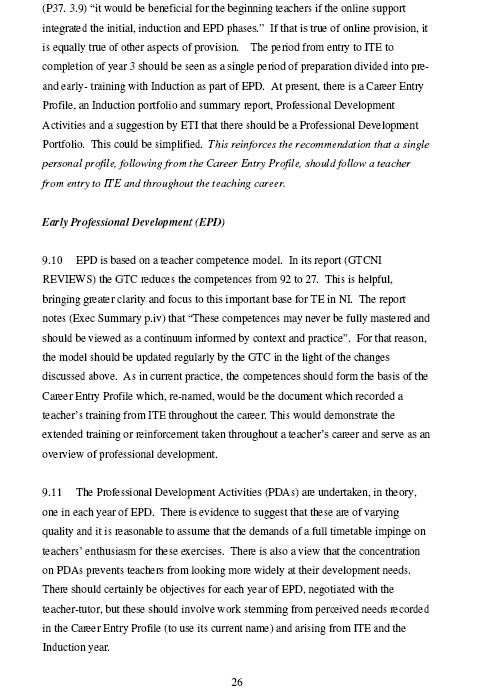
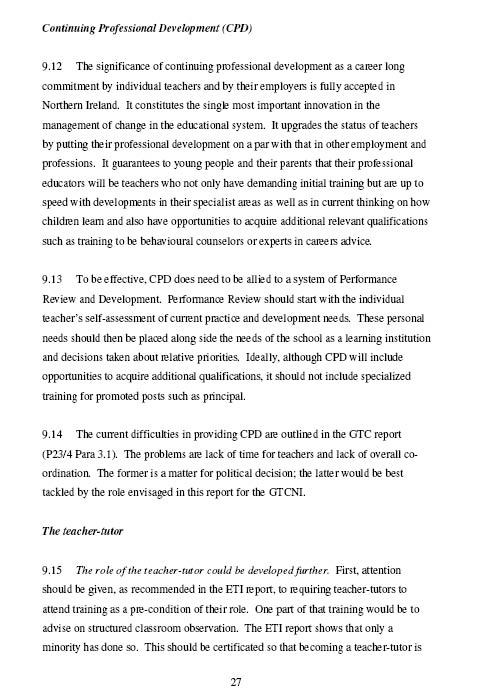
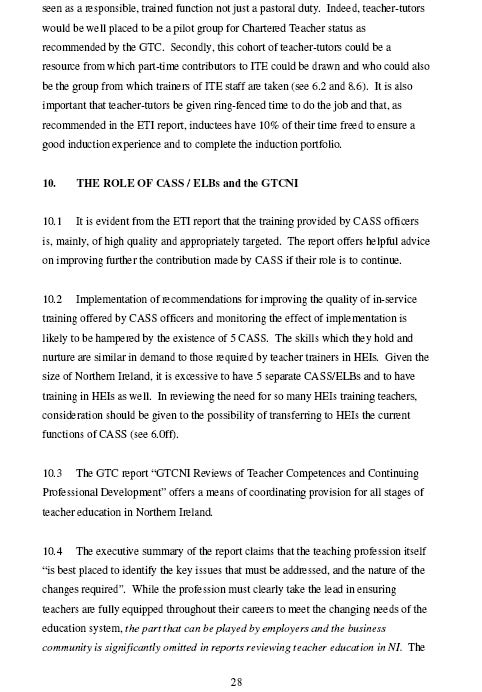
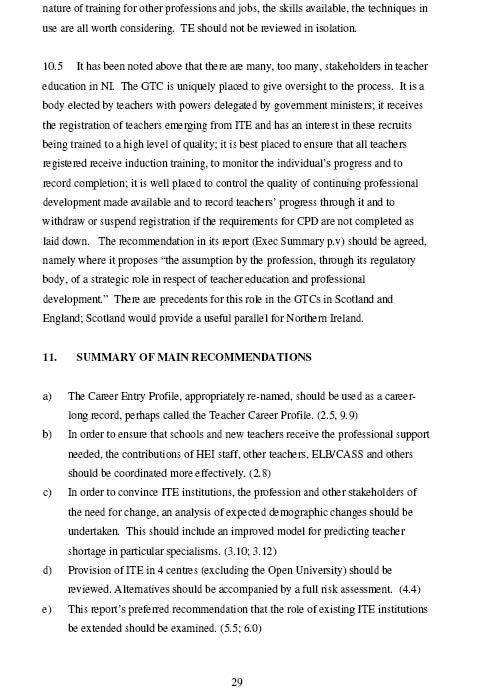
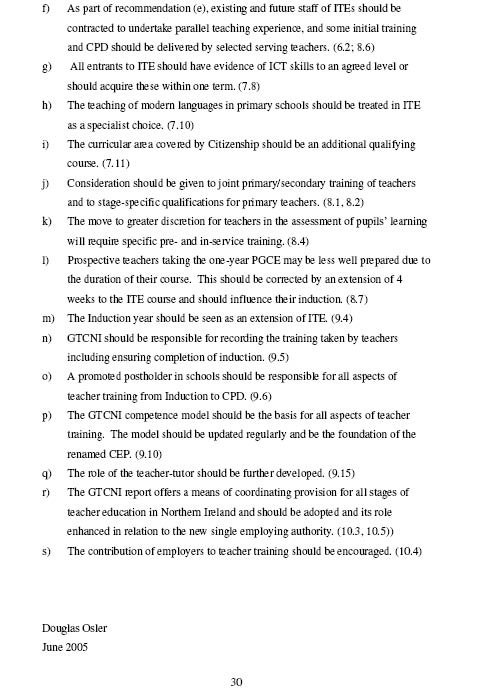
Note of meeting with Stranmillis University College - 6 December 2007


Departmental Solicitors’ Office advice on membership of the Stranmillis Board of Governors
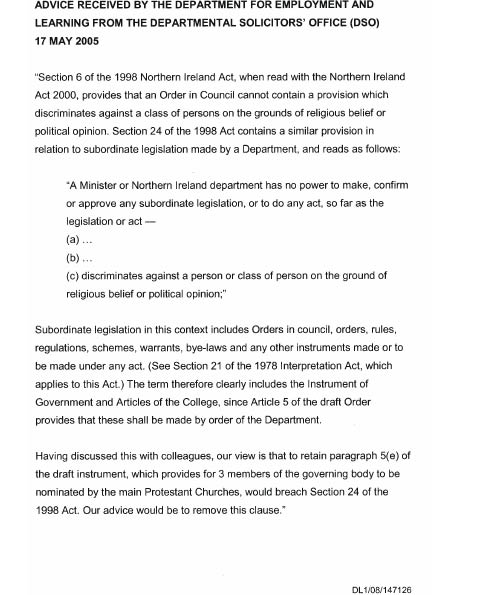
Departmental file note on discussions with Stranmillis College – 18 March 2008

Note of Department for Employment
and Learning meeting with
Stranmillis University College and
Queen’s University – 24 April 2008
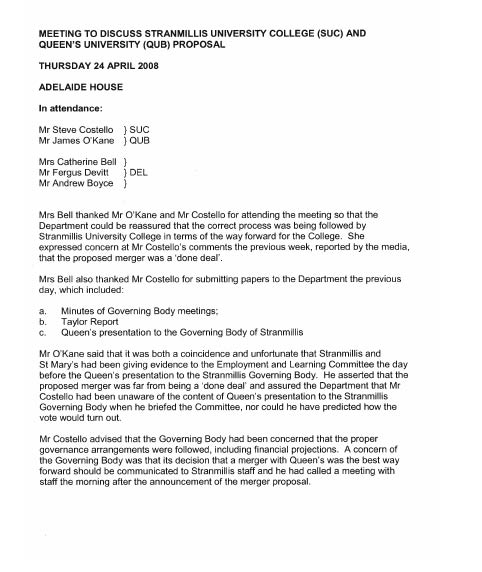

Correspondence from Department to Chair of Governing Body of Stranmillis University College – 12 May 2008

Initial Teacher Education (ITE) intake allocations – 2004/05 to 2008/09

Additional Information from the Department of Education
Tel No: (028) 9127 9523
Fax No: (028) 9127 9100
E-mail: rose.morrow@deni.gov.uk
Trevor Allen
Clerk to the Committee
Employment and Learning Committee
Room 283
Parliament Buildings
Stormont
BELFAST
BT4 3XX
11 December 2008
Dear Trevor
I refer to your e-mail of 26 November.
Breakdown of Figures Contained Paragraph 10
Mr Attwood asked for a breakdown of the figures contained in the table in paragraph 10 of the briefing paper provided to the Committee under cover of my letter to you of 25 November 2008. He asked for this information to be broken down by each of the ITT providers. Table 10 of the paper is attached for convenience at Annex 1.
The Teacher Demand Model (TDM) does not estimate numbers for each provider. However, it does provide figures by phase broken down by Bachelor of Education (BEd) and Post Graduate Certificate in Education (PGCE) routes. Annex 2 provides details of this breakdown for the academic years 2004/05 to 2008/09.
Details of the approved annual intakes for each of the five Initial Teacher Education (ITE) providers across the years 2004/05 to 2008/09 is attached at Annex 3. The information is broken down by phase and by route. Overall figures are also provided at Annex 3.
Northern Ireland Substitute Teacher Register (Multiple Entries)
Mr Attwood also asked about the possibility of a teacher having multiple entries on the Northern Ireland Substitute Teacher Register (NISTR). I advised that I considered it to be unlikely that there would be more than one entry per teacher. I did point out that a teacher when registering could advise that they could teach in more than one phase of education or indeed in more than one subject at post-primary level. For example, a teacher when entering their details on the register could advise that they could teach mathematics and physics at post-primary level.
I have checked the position re “multiple entries” with the Belfast Education & Library Board, who run NISTR on behalf of all the Education & Library Boards, and have been advised that in April 2007 they undertook a check of the NISTR system for duplicates and discovered about twelve entries (out of a total, at that stage, of around 5,500 teachers) that were duplicates. These duplicates were identified at the point in time when the interface between the Teachers’ Payroll system and NISTR was being set up and they were removed immediately. A further check is now being carried out to ensure that there are no further duplicates within the NISTR system.
For information, I attach at Annex 4 a breakdown by age of the number of teachers on the NISTR “live” pool at September 2008.
Northern Ireland Substitute Teacher Register & Interface with the Teachers’ Payroll System
At the recent evidence session I also referred to the fact that where a school books a teacher through NISTR then an automatic payment can be made for the days actually worked by the teacher through the interface with the Teachers’ Payroll system. This new link means that a school does not have to manually complete a form to pay the teacher for the period worked and send it to the Teachers’ Pay and Pensions Branch. They simply have to access the NISTR system and confirm the actual number of days worked by the teacher. At an appropriate point each month, a payment file is automatically generated by the NISTR system with details of all those teachers booked through the system, together with details of the days they have actually worked.
The Teachers’ Payroll system would reject any “duplicate payments” for an individual teacher. I have been advised that 82.89% of the substitute days paid In November 2008 were processed through the link with the NISTR system.
TDM Review Report
You also asked for an indication of the timescale of when the Committee would be able to get a copy of the TDM Review Report. It is hoped that the TDM Review Report will be made available to the Minister of Education for her consideration in February 2008. It would be hoped that a copy of the report could be made available to the DEL Committee in late March 2008.
Yours sincerely
Rose M Morrow (Mrs)
Annex 1
Table as set out in paragraph 10 of the briefing paper provided to the Committee under cover of Rose Morrow’s letter of 25 November 2008:
Academic Year |
Overall TDM Figures |
Overall Approved ITE Intakes |
|---|---|---|
2004/2005 |
926 |
880 |
2005/2006 |
984 |
846 |
2006/2007 |
984 |
786 |
2007/2008 |
799 |
699 |
2008/2009 |
594 |
643 |
Annex 2
Teacher Demand Model Outworkings from 2004/05 to 2008/09
Phase |
Primary |
Post Primary |
Overall |
||||||
|---|---|---|---|---|---|---|---|---|---|
Route |
BEd |
PGCE |
sub-total Primary |
BEd |
PGCE |
sub-total Post-Primary |
Total BEd |
Total PGCE |
Total BEd + PGCE |
All Institutes by route |
|
|
|
|
|
|
|
|
|
2004/05 |
287 |
74 |
361 |
121 |
444 |
565 |
408 |
518 |
926 |
2005/06 |
293 |
87 |
380 |
138 |
466 |
604 |
431 |
553 |
984 |
2006/07 |
309 |
78 |
387 |
138 |
459 |
597 |
447 |
537 |
984 |
2007/08 |
272 |
52 |
324 |
101 |
374 |
475 |
373 |
426 |
799 |
2008/09 |
247 |
6 |
253 |
71 |
270 |
341 |
318 |
276 |
594 |
All Institutes by phase |
Primary |
Post-Primary |
Overall |
||||||
2004/05 |
361 |
565 |
926 |
||||||
2005/06 |
380 |
604 |
984 |
||||||
2006/07 |
387 |
597 |
984 |
||||||
2007/08 |
324 |
475 |
799 |
||||||
2008/09 |
253 |
341 |
594 |
||||||
Annex 3
Approved Initial Teacher Education Intakes from 2004/05 to 2008/09 - Overall Figures
Phase |
Primary |
Other |
Post Primary |
|
||||||
|---|---|---|---|---|---|---|---|---|---|---|
Route |
BEd |
PGCE |
PGCE IME |
PGCE Early Years |
sub-total Primary |
PGCE Psychology |
BEd |
PGCE |
sub-total Post-Primary |
Totals |
All Institutes by route |
|
|
|
|
|
|
|
|
|
|
2004/05 |
290 |
70 |
20 |
20 |
400 |
20 |
100 |
360 |
460 |
880 |
2005/06 |
270 |
60 |
16 |
20 |
366 |
20 |
100 |
360 |
460 |
846 |
2006/07 |
230 |
55 |
16 |
20 |
321 |
10 |
100 |
355 |
455 |
786 |
2007/08 |
180 |
50 |
16 |
20 |
266 |
- |
100 |
333 |
433 |
699 |
2008/09 |
160 |
40 |
22 |
15 |
237 |
- |
100 |
306 |
406 |
643 |
All Institutes by phase |
|
|
|
|
|
|
|
|
|
|
2004/05 |
400 |
|
|
|
|
20 |
460 |
|
|
880 |
2005/06 |
366 |
|
|
|
|
20 |
460 |
|
|
846 |
2006/07 |
321 |
|
|
|
|
10 |
455 |
|
|
786 |
2007/08 |
266 |
|
|
|
|
0 |
433 |
|
|
699 |
2008/09 |
237 |
|
|
|
|
0 |
406 |
|
|
643 |
Approved Initial Teacher Education Intakes from 2004/05 to 2008/09 - By Institute
Phase |
Primary |
Other |
Post Primary |
|
||||||
|---|---|---|---|---|---|---|---|---|---|---|
Route |
BEd |
PGCE |
PGCE |
PGCE |
sub-total Primary |
PGCE Psychology |
BEd |
PGCE |
sub-total Post-Primary |
Totals |
Stranmillis |
||||||||||
2004/05 |
150 |
- |
- |
20 |
170 |
20 |
50 |
- |
50 |
240 |
2005/06 |
140 |
- |
- |
20 |
160 |
20 |
50 |
- |
50 |
230 |
2006/07 |
115 |
- |
- |
20 |
135 |
10 |
50 |
- |
50 |
195 |
2007/08 |
90 |
- |
- |
20 |
110 |
- |
50 |
- |
50 |
160 |
2008/09 |
80 |
- |
- |
15 |
95 |
- |
50 |
- |
50 |
145 |
St Mary’s |
||||||||||
2004/05 |
140 |
- |
20 |
- |
160 |
- |
50 |
- |
50 |
210 |
2005/06 |
130 |
- |
16 |
- |
146 |
- |
50 |
- |
50 |
196 |
2006/07 |
115 |
- |
16 |
- |
131 |
- |
50 |
- |
50 |
181 |
2007/08 |
90 |
- |
16 |
- |
106 |
- |
50 |
- |
50 |
156 |
2008/09 |
80 |
- |
22 |
- |
102 |
- |
50 |
- |
50 |
152 |
QUB |
||||||||||
2004/05 |
- |
- |
- |
- |
- |
- |
- |
205 |
205 |
205 |
2005/06 |
- |
- |
- |
- |
- |
- |
- |
205 |
205 |
205 |
QUB |
||||||||||
2006/07 |
- |
- |
- |
- |
- |
- |
- |
205 |
205 |
205 |
2007/08 |
- |
- |
- |
- |
- |
- |
- |
193 |
193 |
193 |
2008/09 |
- |
- |
- |
- |
- |
- |
- |
181 |
181 |
181 |
Approved Initial Teacher Education Intakes from 2004/05 to 2008/09 - By Institute
Phase |
Primary |
Other |
Post Primary |
|
||||||
|---|---|---|---|---|---|---|---|---|---|---|
Route |
BEd |
PGCE |
PGCE |
PGCE |
sub-total Primary |
PGCE Psychology |
BEd |
PGCE |
sub-total Post-Primary |
Totals |
UU |
|
|
|
|
|
|
|
|
|
|
2004/05 |
- |
70 |
- |
- |
70 |
- |
- |
125 |
125 |
195 |
2005/06 |
- |
60 |
- |
- |
60 |
- |
- |
125 |
125 |
185 |
2006/07 |
- |
55 |
- |
- |
55 |
- |
- |
125 |
125 |
180 |
2007/08 |
- |
50 |
- |
- |
50 |
- |
- |
115 |
115 |
165 |
2008/09 |
- |
40 |
- |
- |
40 |
- |
- |
105 |
105 |
145 |
OU |
|
|
|
|
|
|
|
|
|
|
2004/05 |
- |
- |
- |
- |
- |
- |
- |
30 |
30 |
30 |
2005/06 |
- |
- |
- |
- |
- |
- |
- |
30 |
30 |
30 |
2006/07 |
- |
- |
- |
- |
- |
- |
- |
25 |
25 |
25 |
2007/08 |
- |
- |
- |
- |
- |
- |
- |
25 |
25 |
25 |
2008/09 |
- |
- |
- |
- |
- |
- |
- |
20 |
20 |
20 |
Annex 4
Northern Ireland Substitute Teacher Register - “LIVE POOL” - Quarterly Report at September 2008
Total Numbers in Live Pool by Age |
|
|---|---|
Age Band |
Total |
Under 25 |
872 |
25-29 |
1,859 |
30-34 |
854 |
35-39 |
546 |
40-44 |
427 |
45-49 |
381 |
50-54 |
649 |
55-59 |
1,232 |
60+ |
1,143 |
Total |
7,963 |
Appendix 7
Press Releases
_fmt1.jpeg)
Press Release
Committee for Employment and Learning
Review of Teacher Training Changes Announced
29th May 2008 E&L 02/08
A review of teacher training provision has been launched by the Committee for Employment and Learning. This follows the Minister’s announcement of changes to the funding of the two teacher training colleges at Stranmillis and St. Mary’s University College.
Changes that have been announced include the proposed merger of Stranmillis with Queen’s University Belfast.
Commenting on the review, the Committee’s Chairperson Sue Ramsey MLA said, “In March the Committee was made aware of planned changes to the way in which our local teacher training colleges are funded. Since that time, the Committee has been concerned that the process has moved very rapidly with no opportunity to consider important issues. We believe that there should be an opportunity for a wide range of stakeholders to give their views and for a full consideration of the issues to be made.
“This ‘stakeholder review’ will enable all interested parties to express their views and concerns on this process and we will be taking evidence from across the spectrum.”
Deputy Chairperson Jimmy Spratt added, “The Committee, of course, wishes to see value for money delivered in the field of teacher education. However, we consider that the process to date has not afforded a full, open and transparent discussion on the key issues. The Committee review will allow for the full range of views to be heard.”
The Committee proposes to provide a report with recommendations to the Minister for Employment and Learning by the end of October 2008.
ENDS
Notes to Editor:
Membership of the Employment and Learning Committee is as follows:
Chairperson: Sue Ramsey
Deputy Chairperson: Jimmy Spratt
Committee Members: Alex Attwood
Paul Butler
Anna Lo
Nelson McCausland
David McClarty
Basil McCrea
Claire McGill
Robin Newton
Alastair Ross
Enquiries about the work of the Committee for Employment and Learning should be directed to the Clerk to the Committee, Room 283, Parliament Buildings, Stormont, Belfast BT4 3XX, Tel: 028 9052 1653 or email: cel@niassembly.gov.uk
Media enquiries regarding the work of Committees should be directed to:
Debra Savage, Northern Ireland Assembly Information Office, Room B2, Parliament Buildings, Belfast, BT4 3XX; Telephone 028 9052 1405; mobile 07920 864221. Website: archive.niassembly.gov.uk; E-mail: info.office@niassembly.gov.uk.
